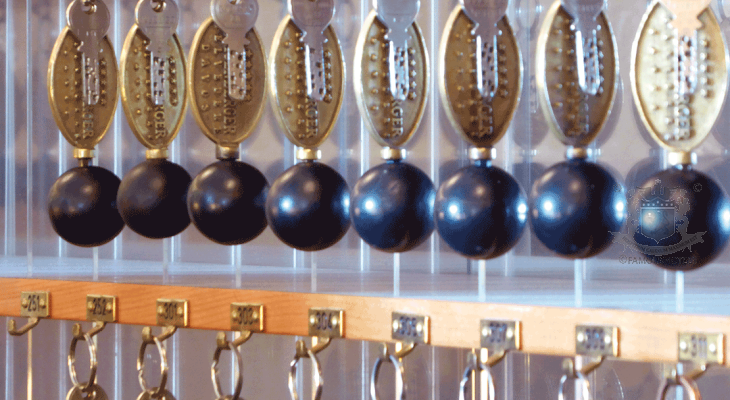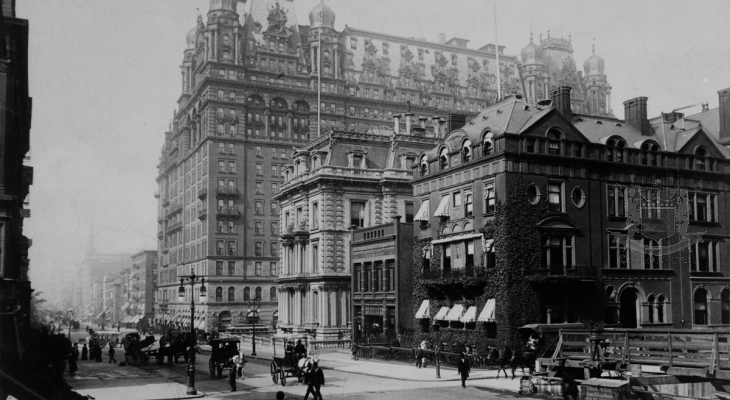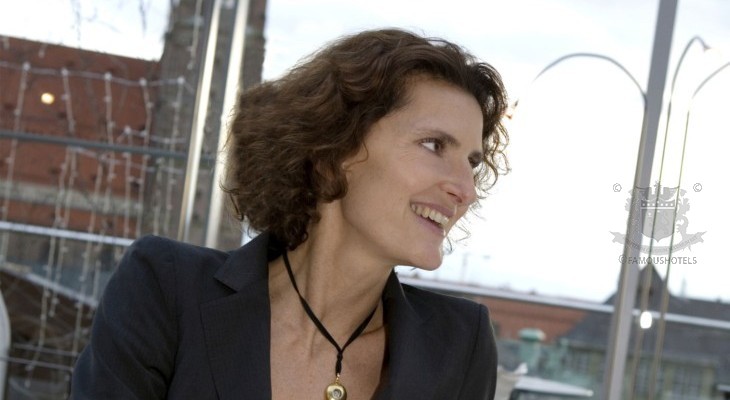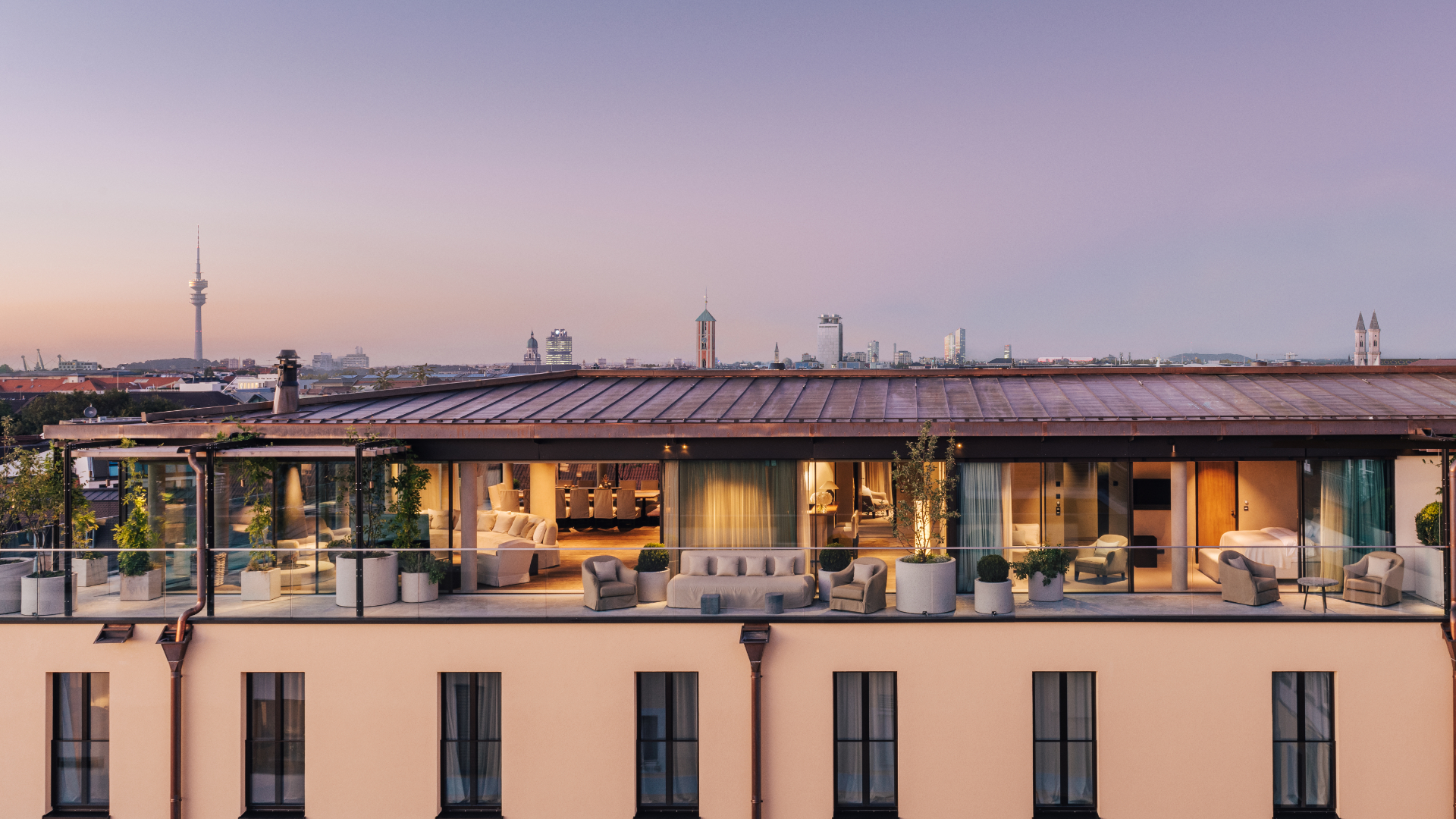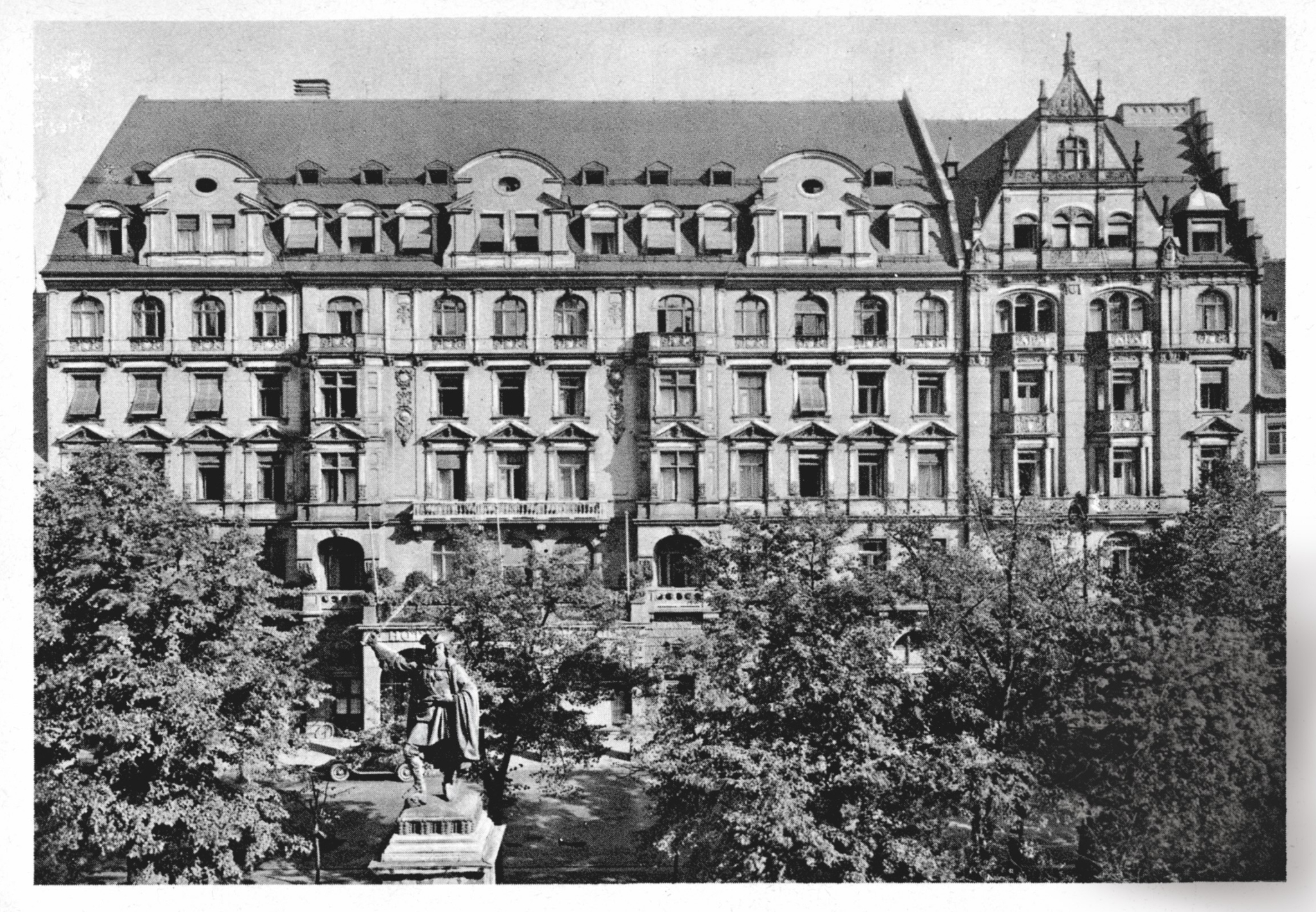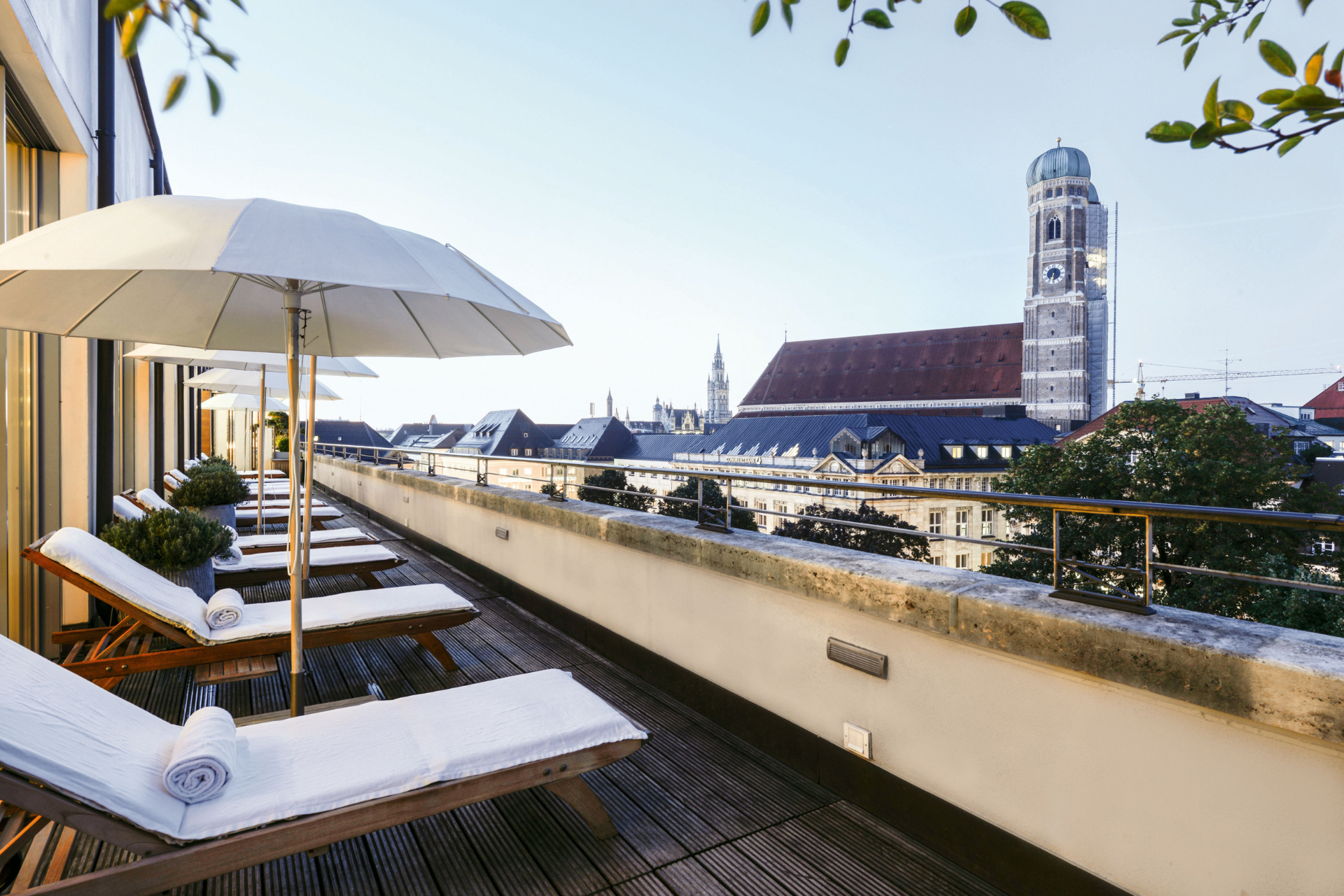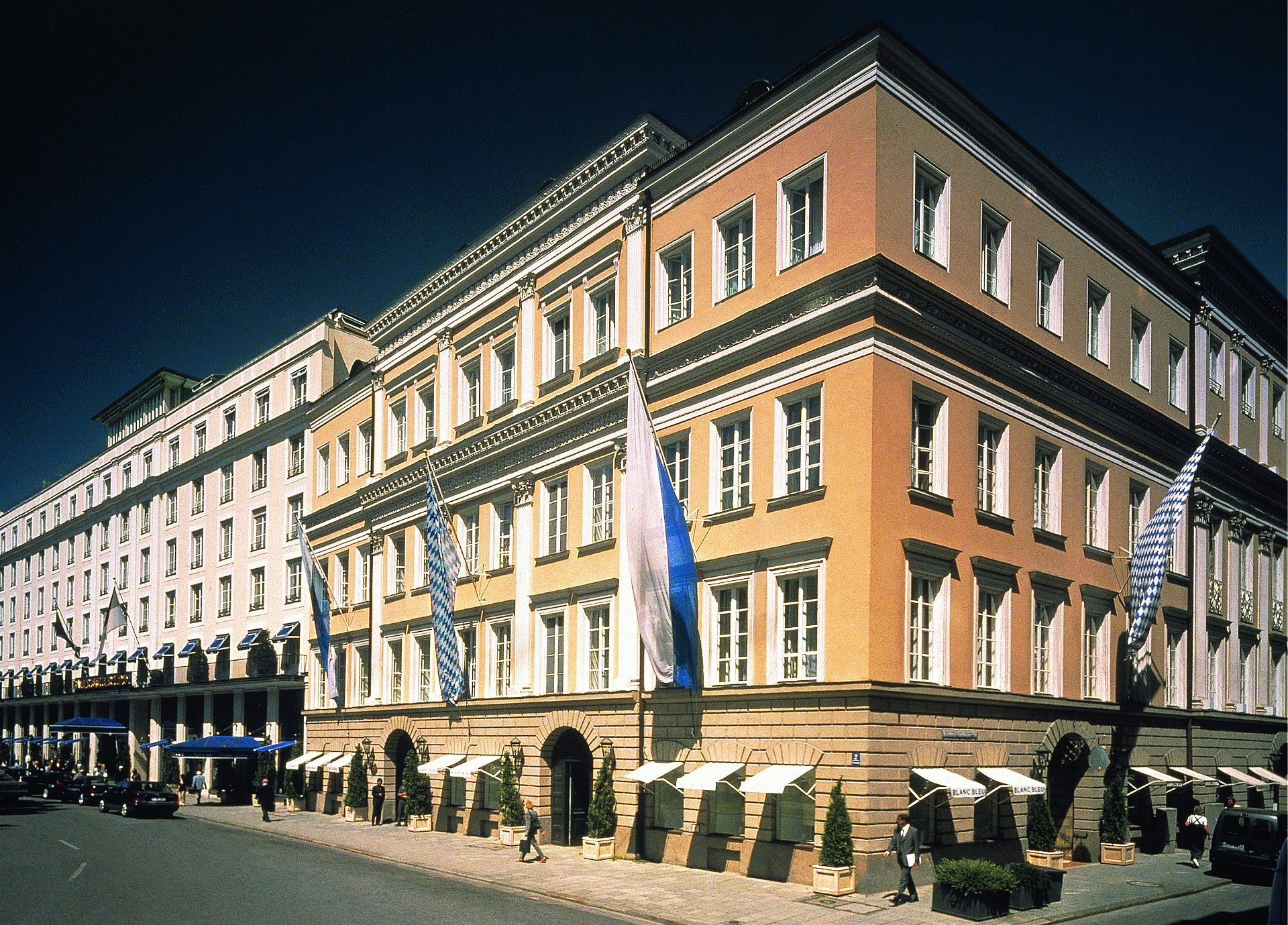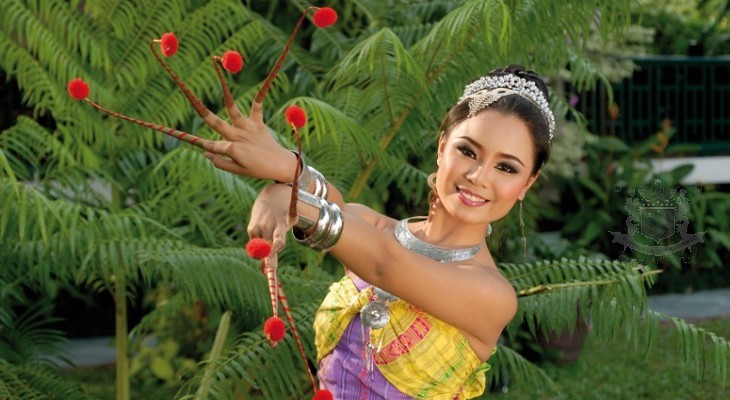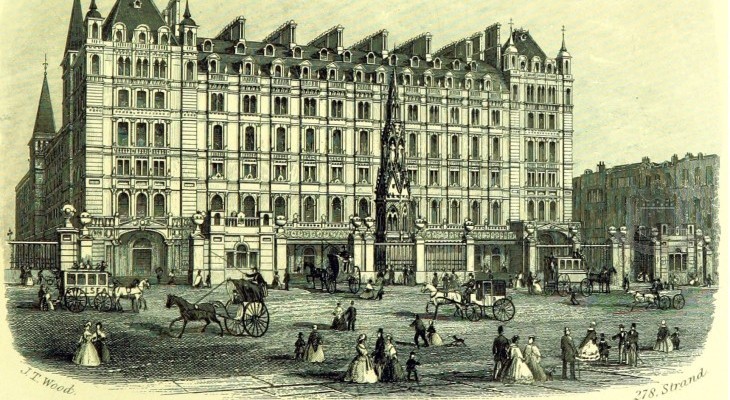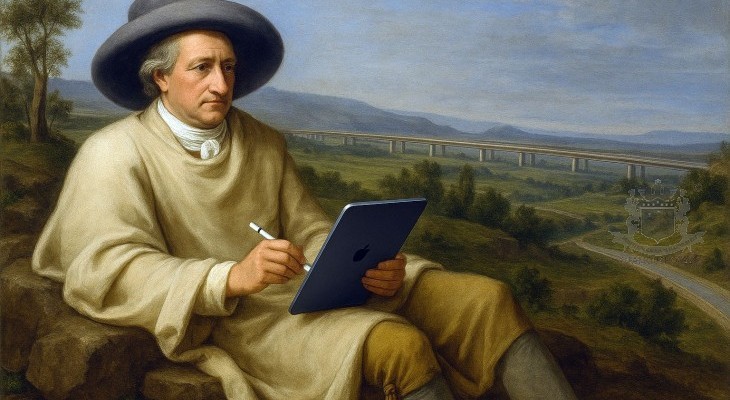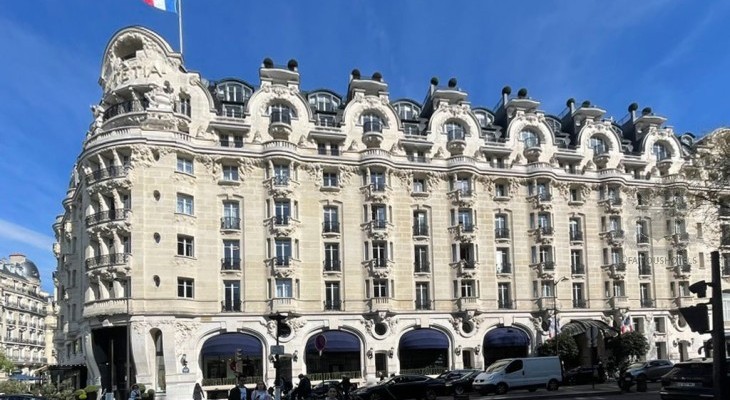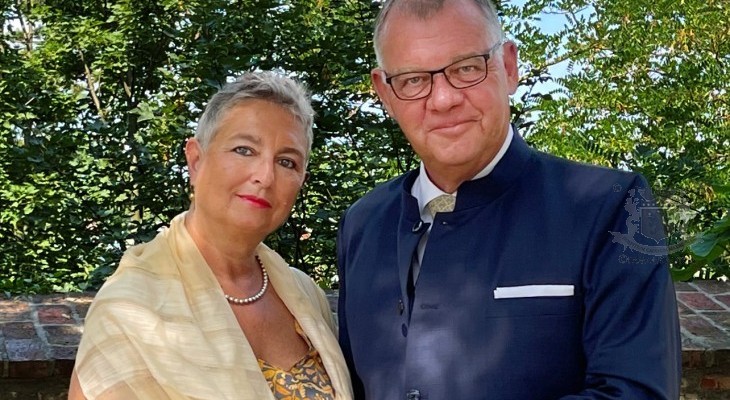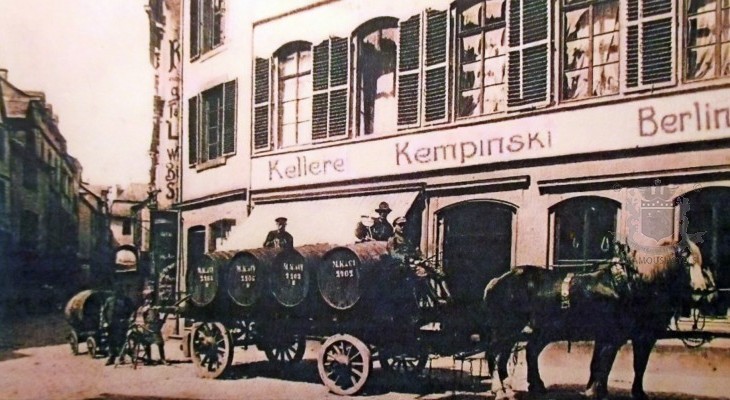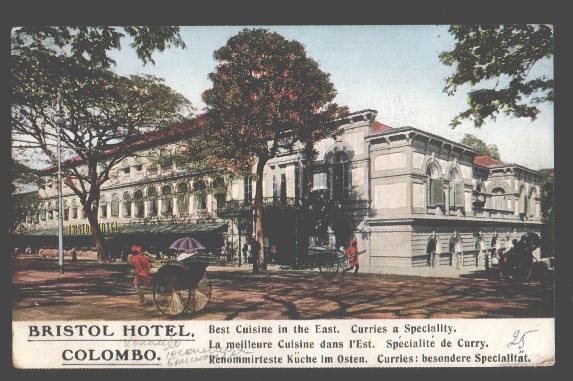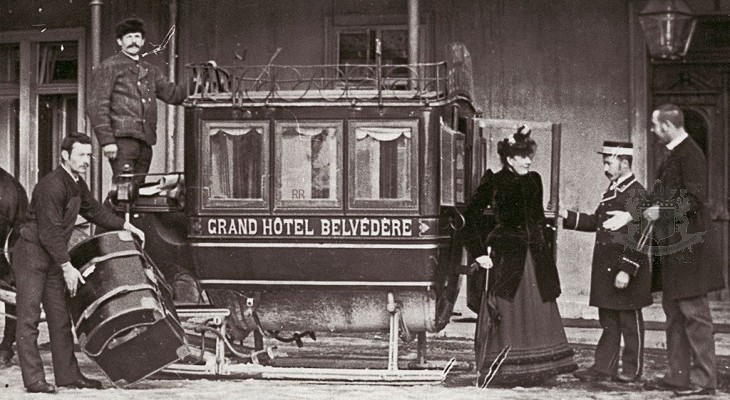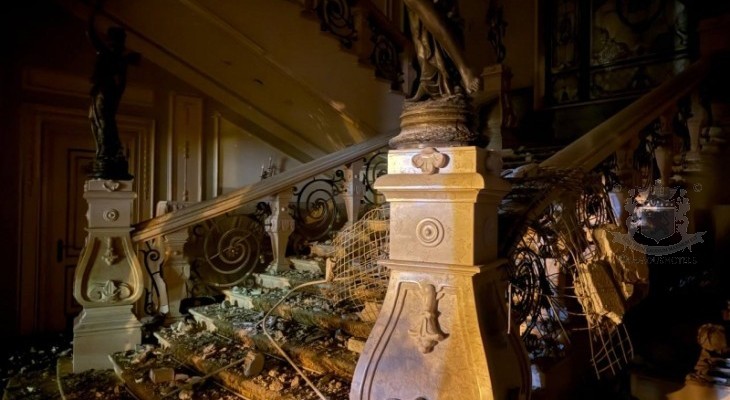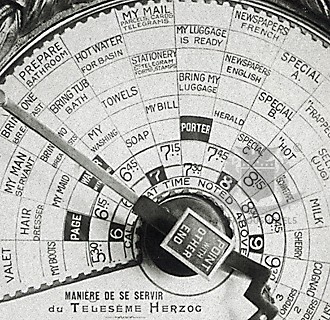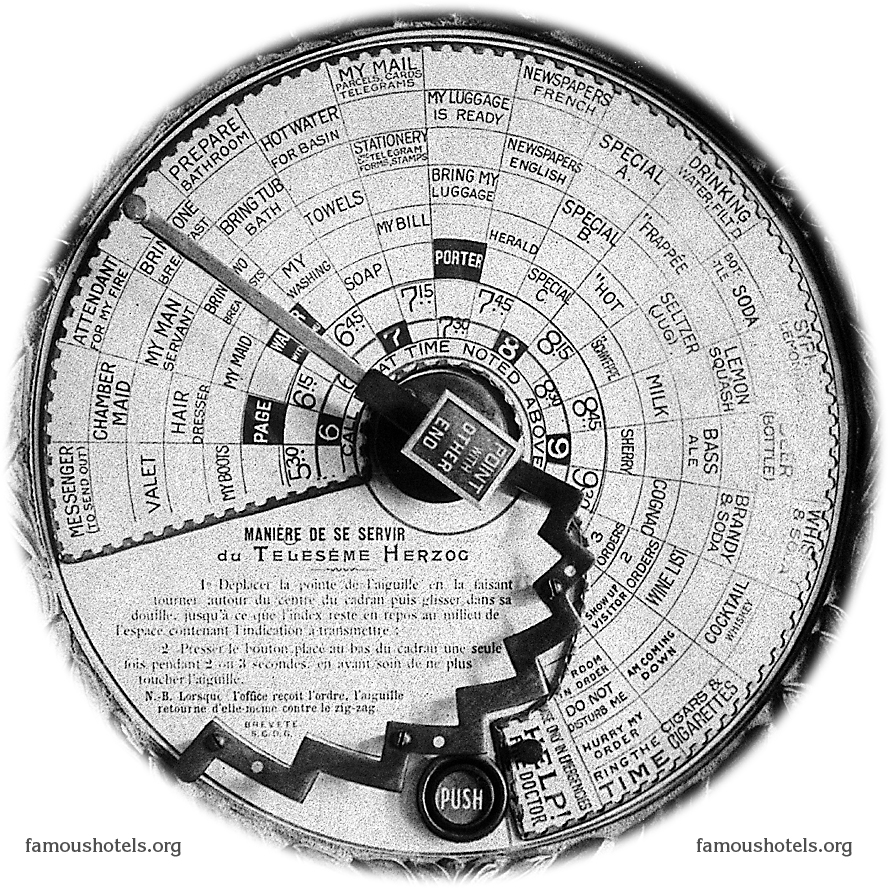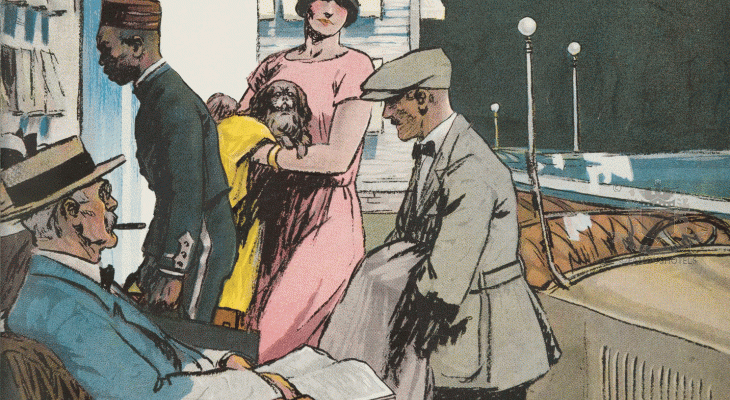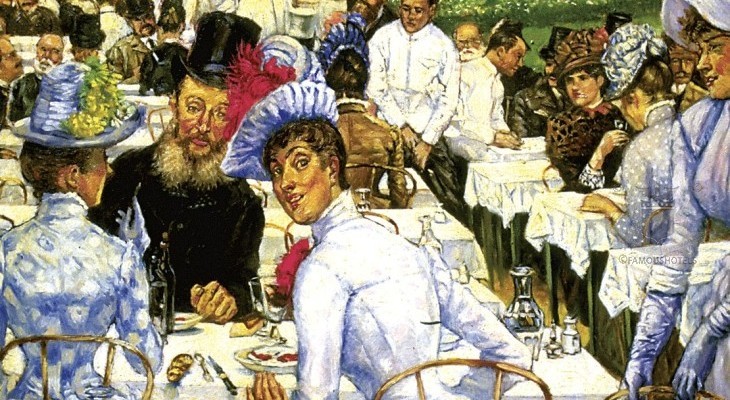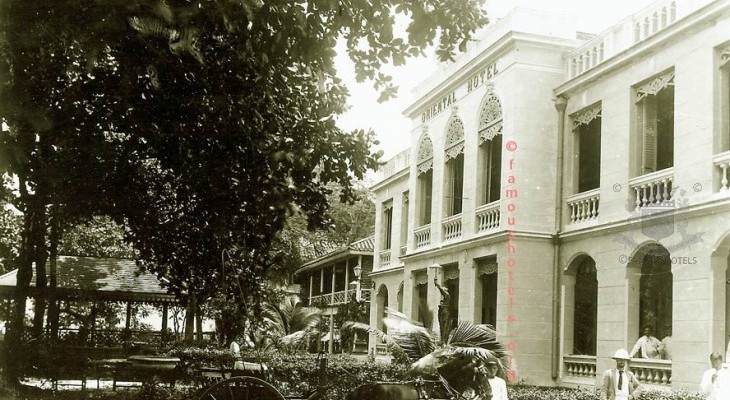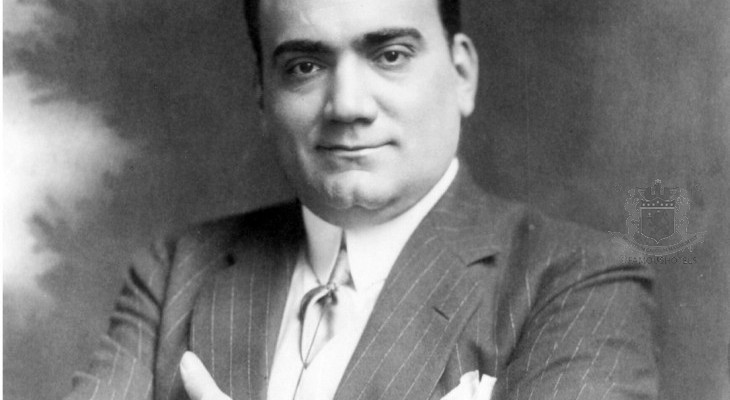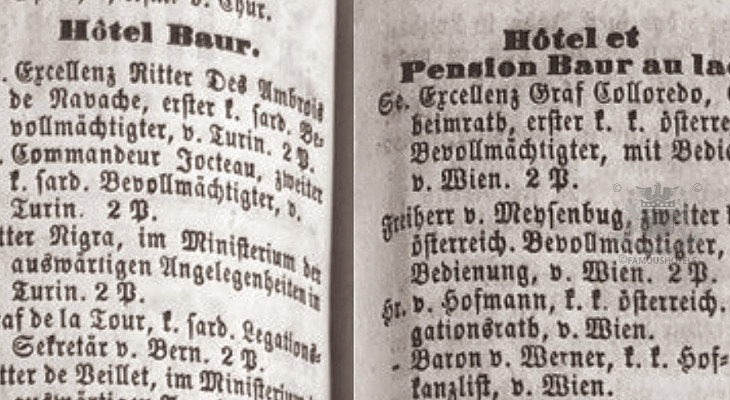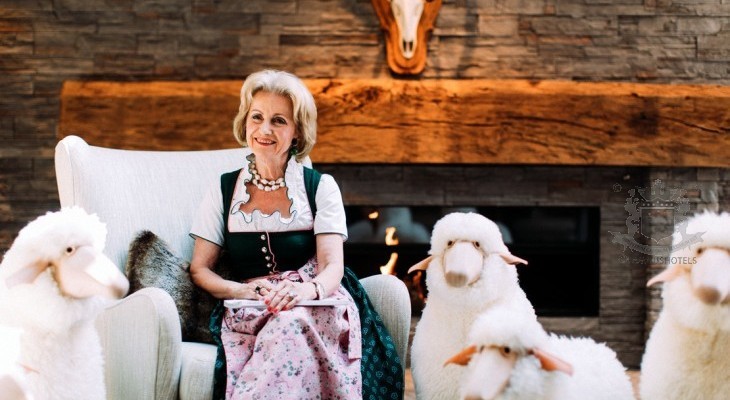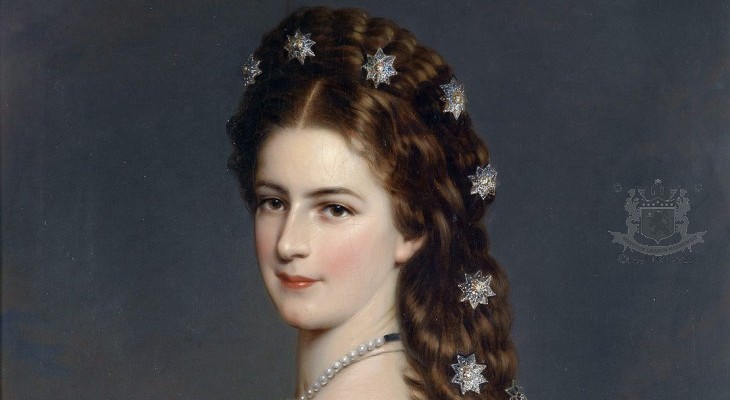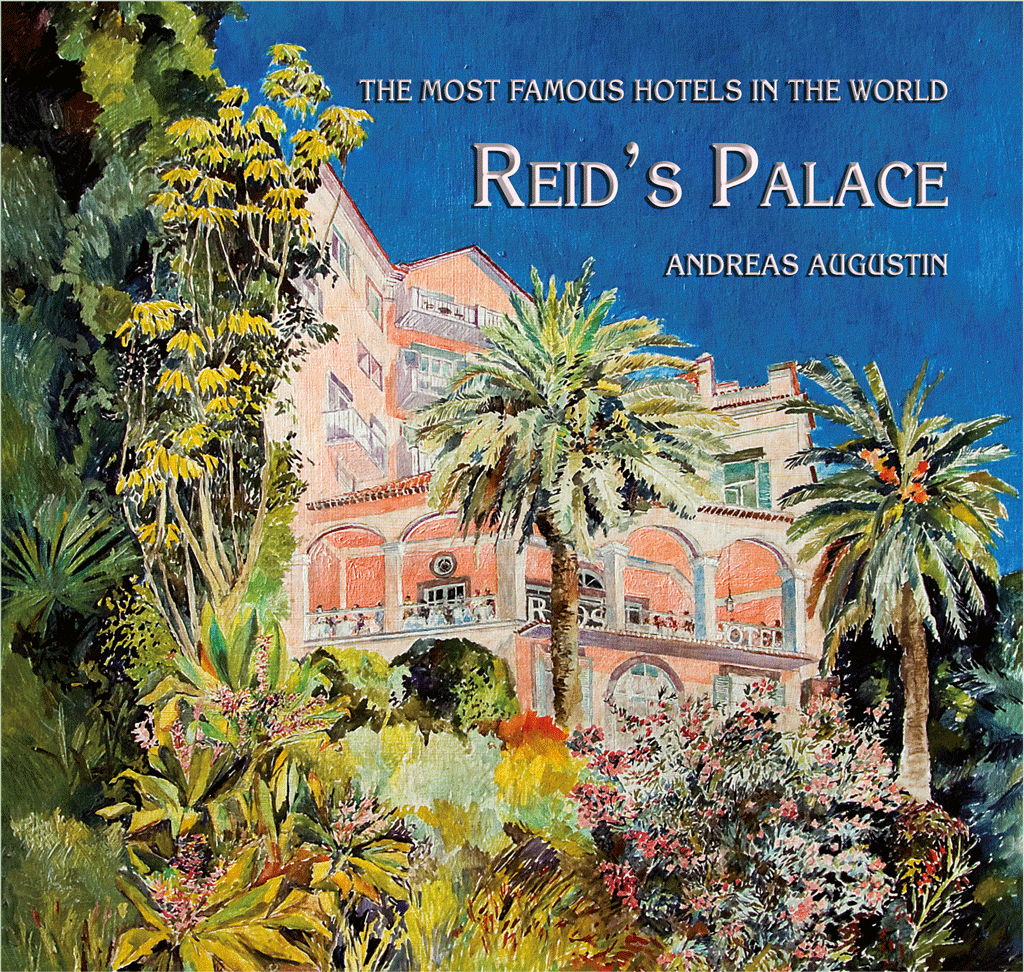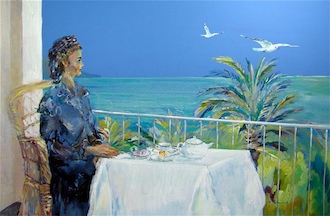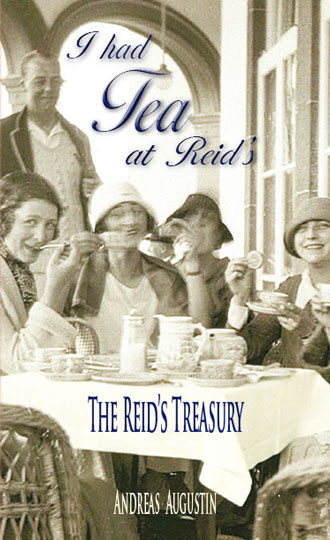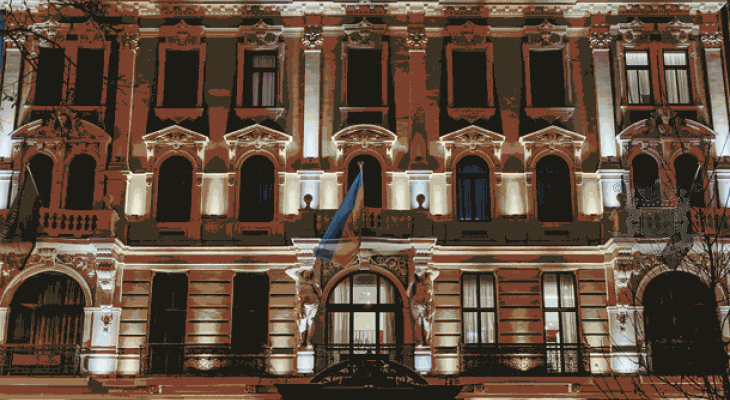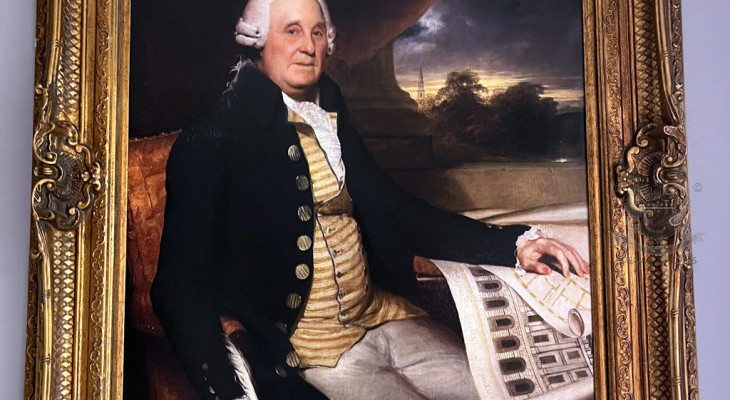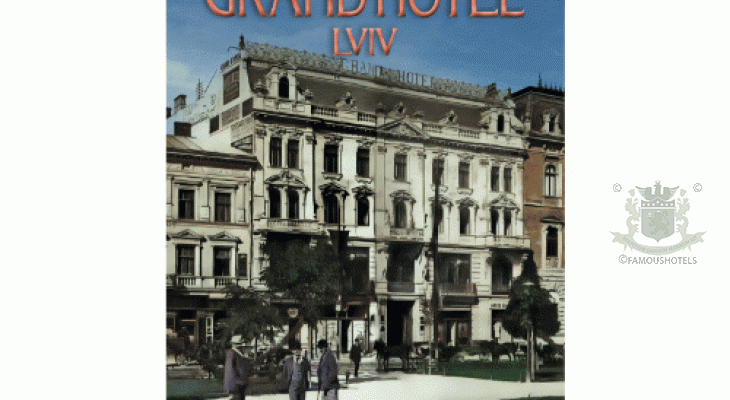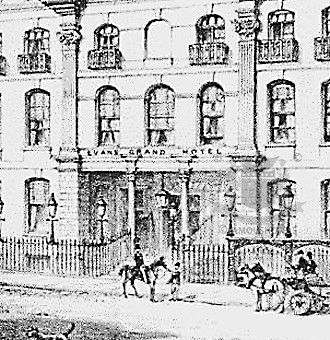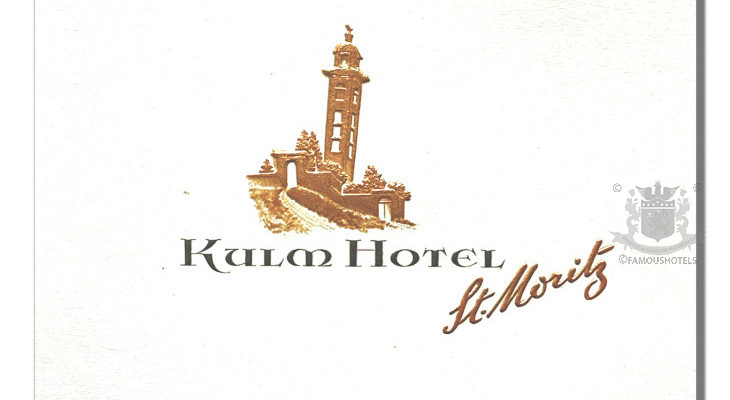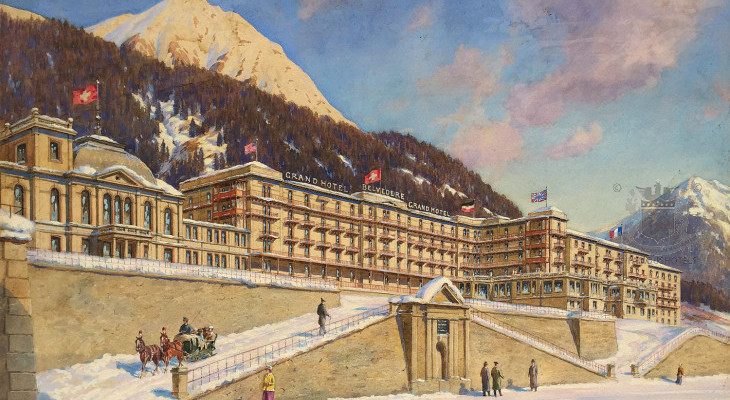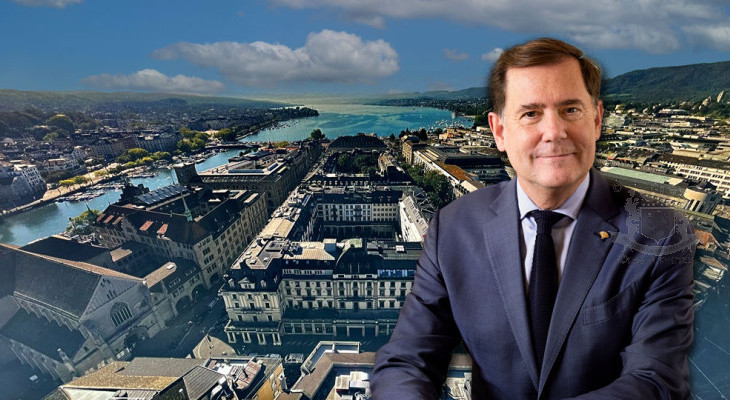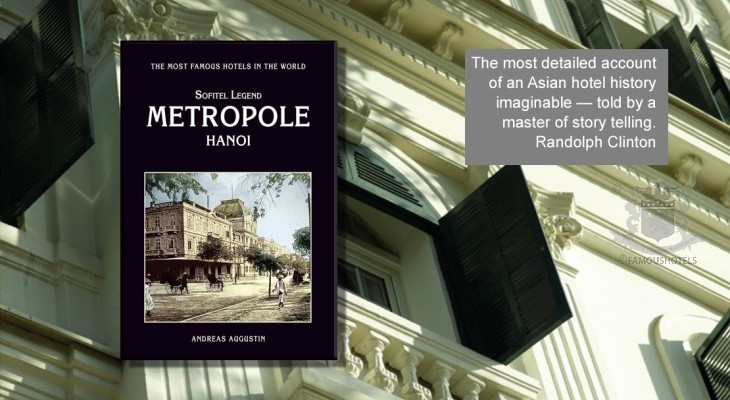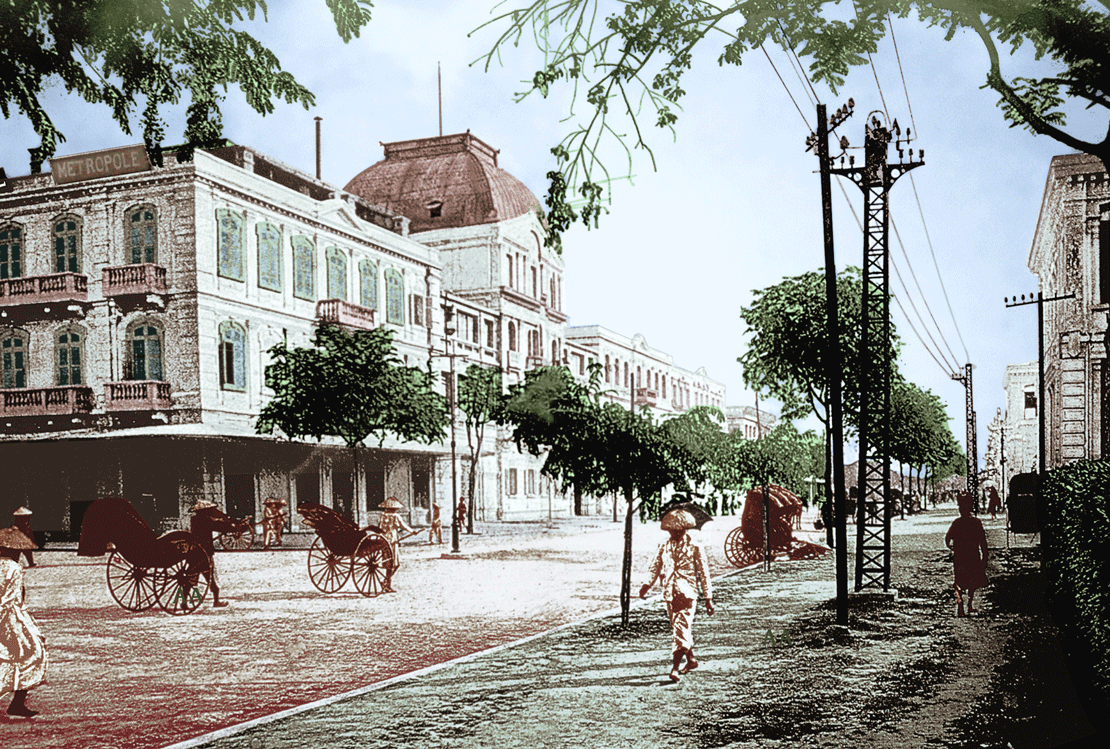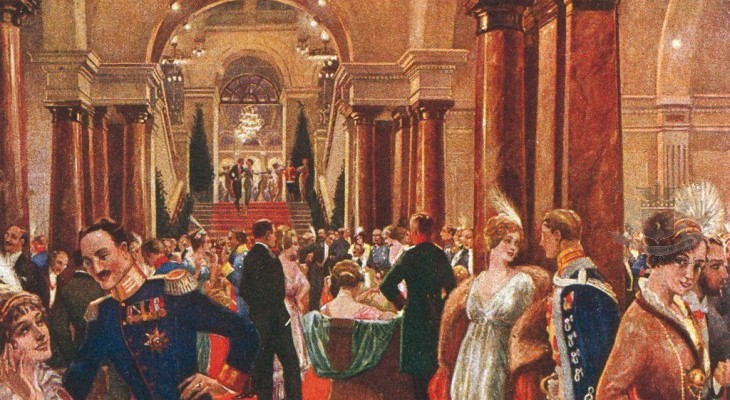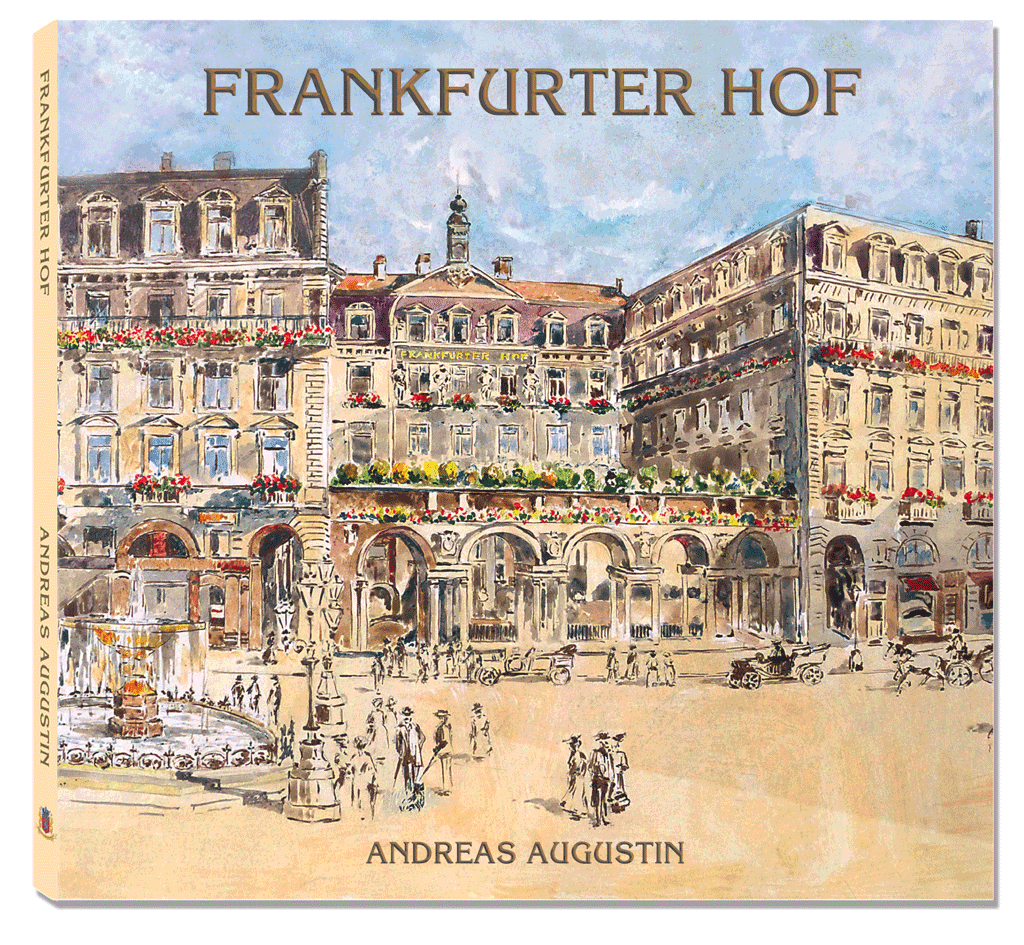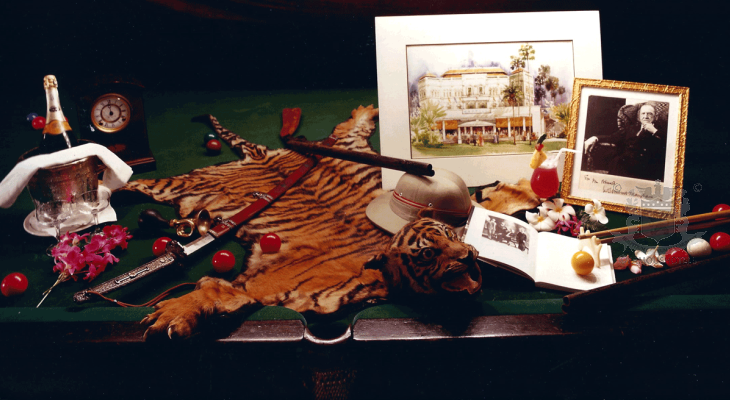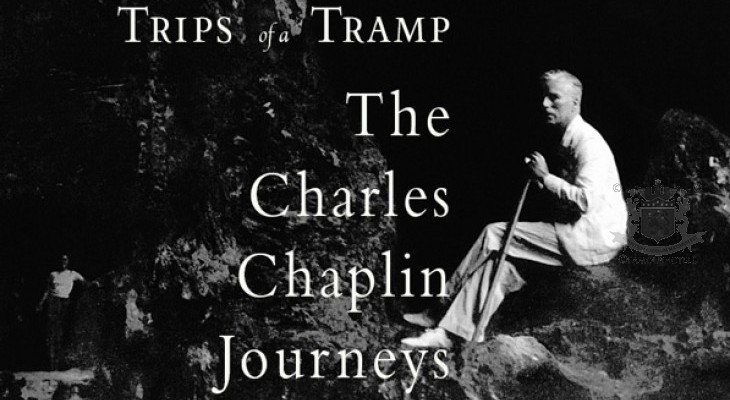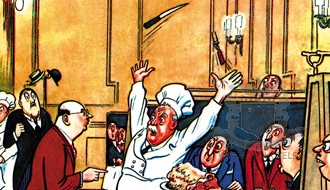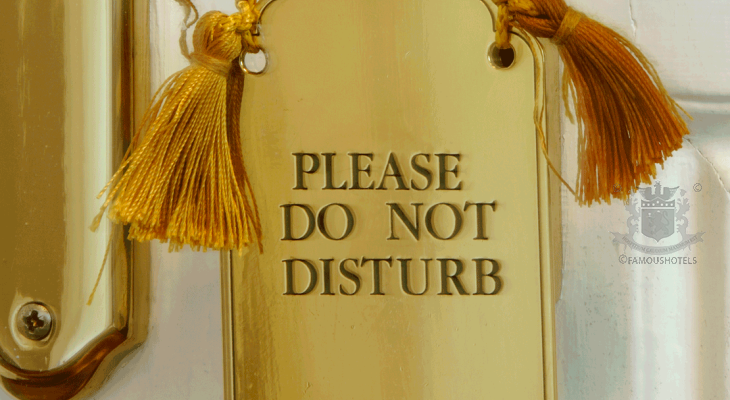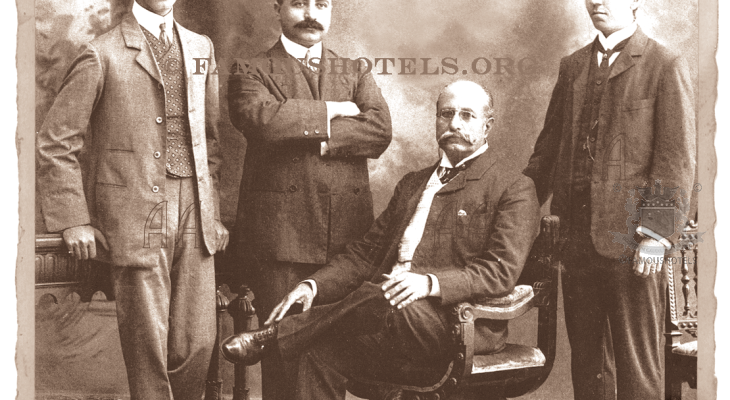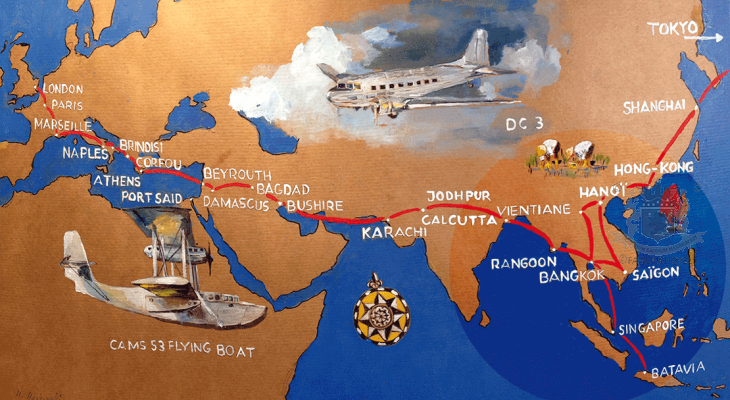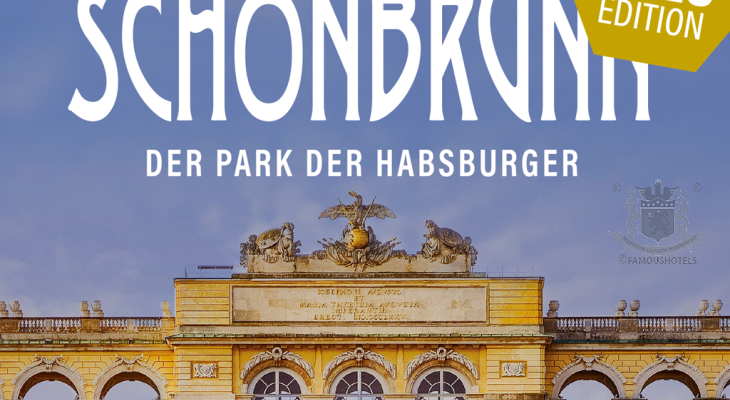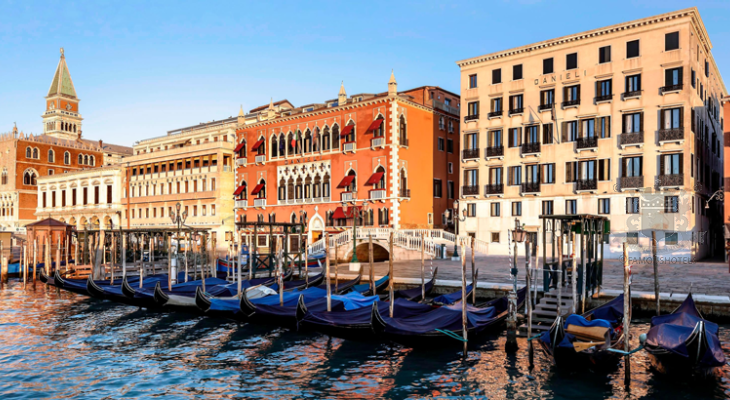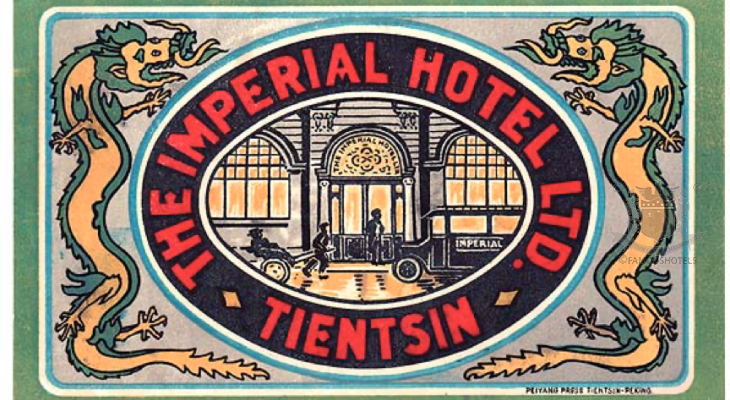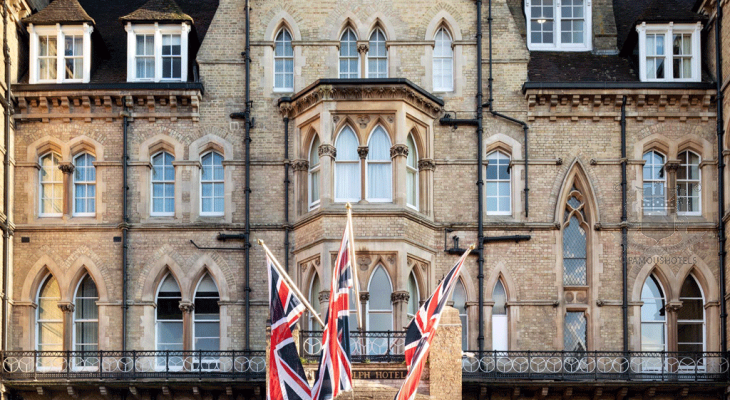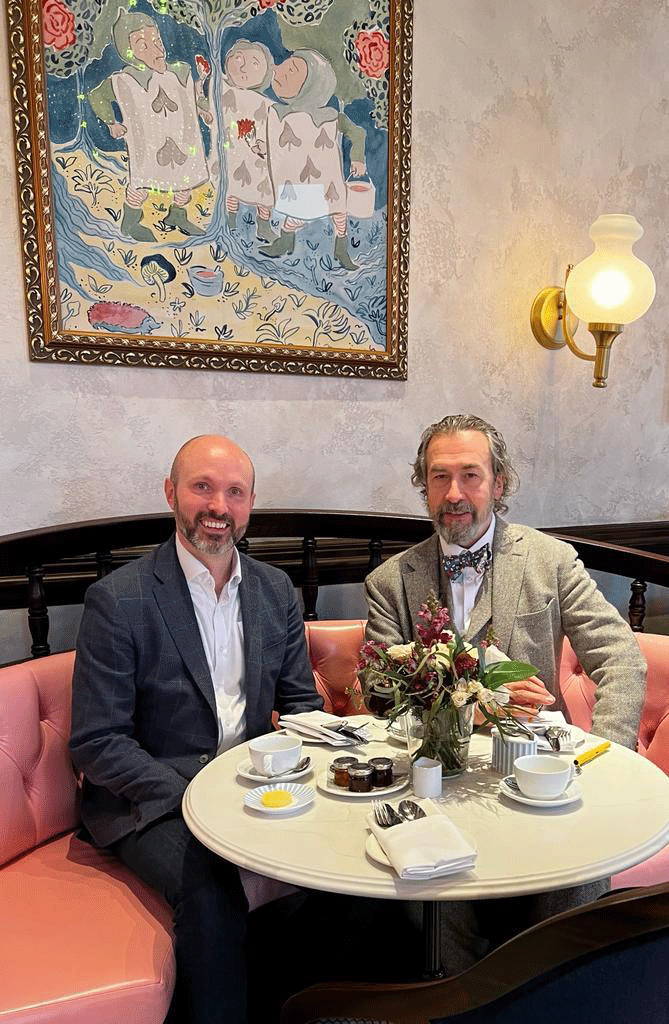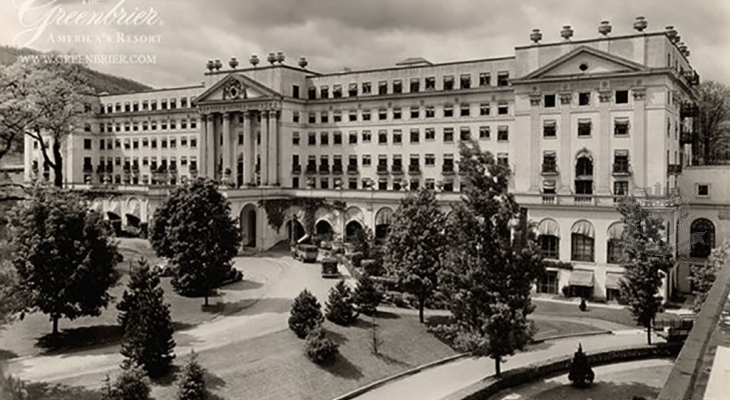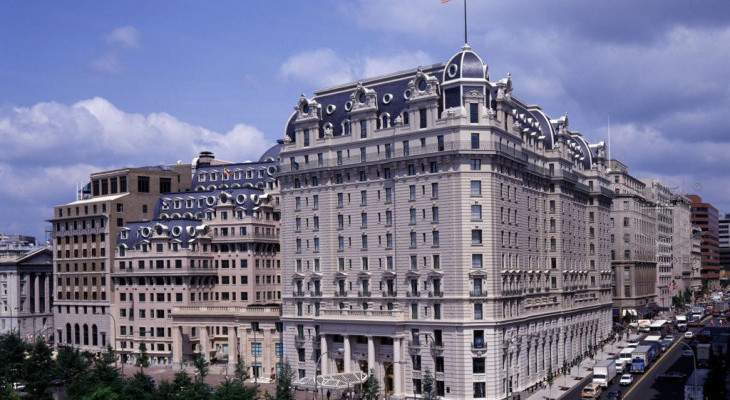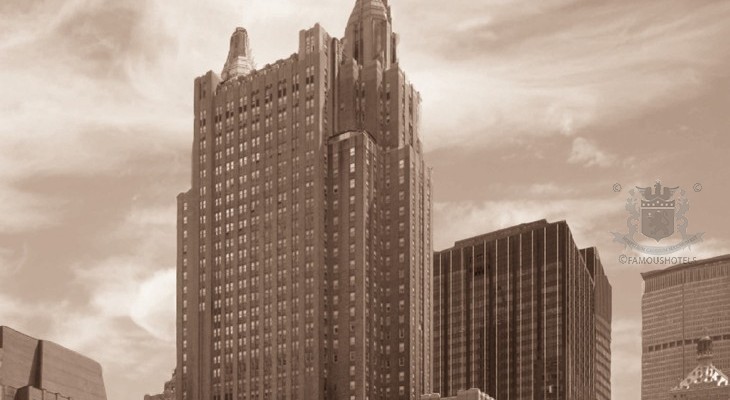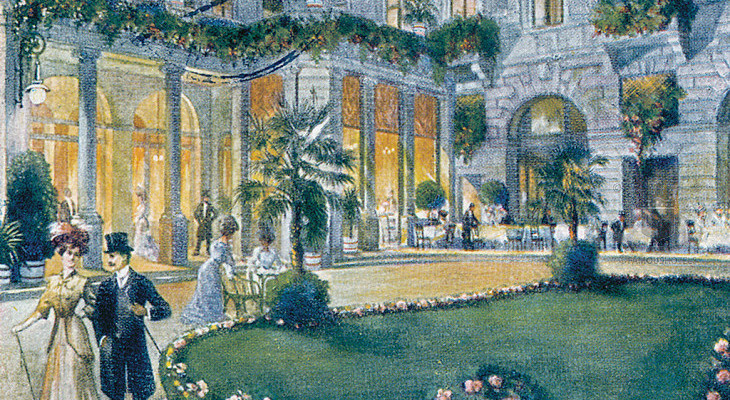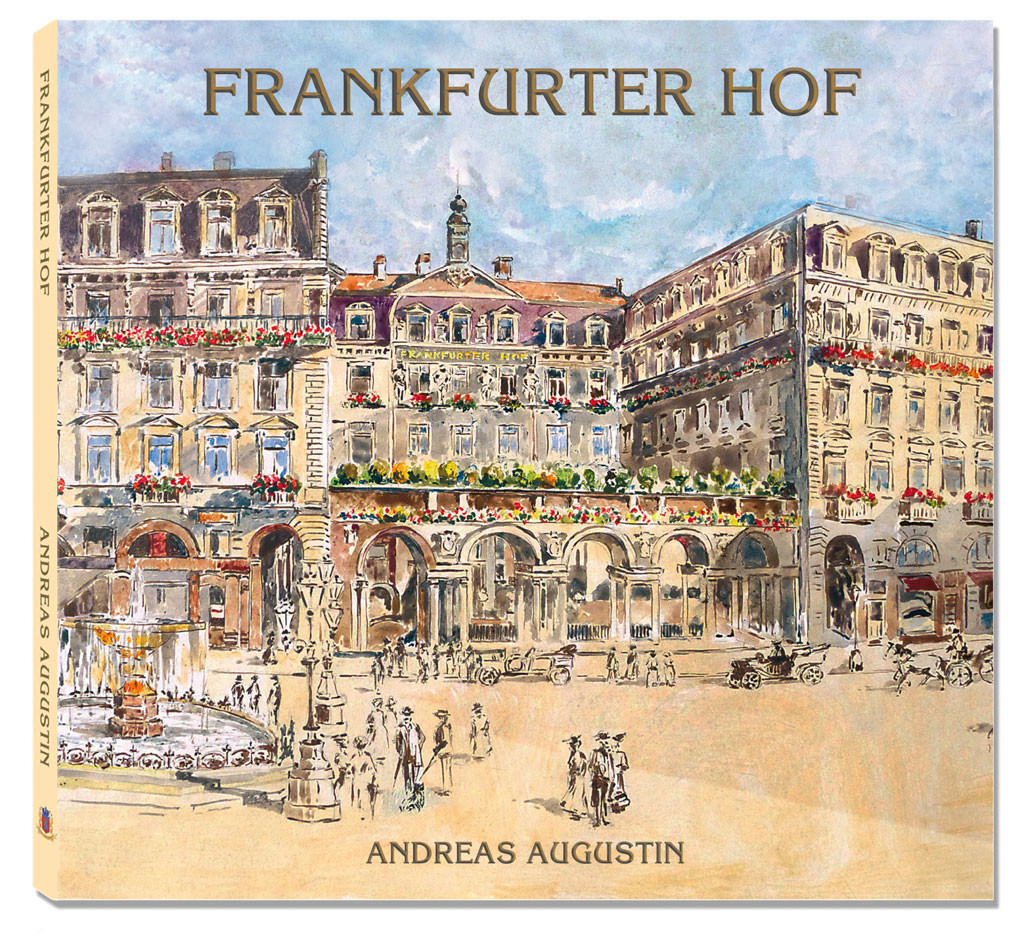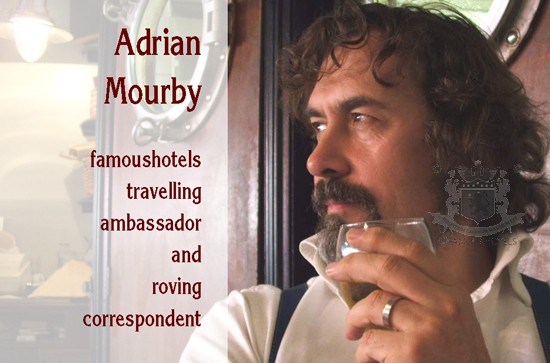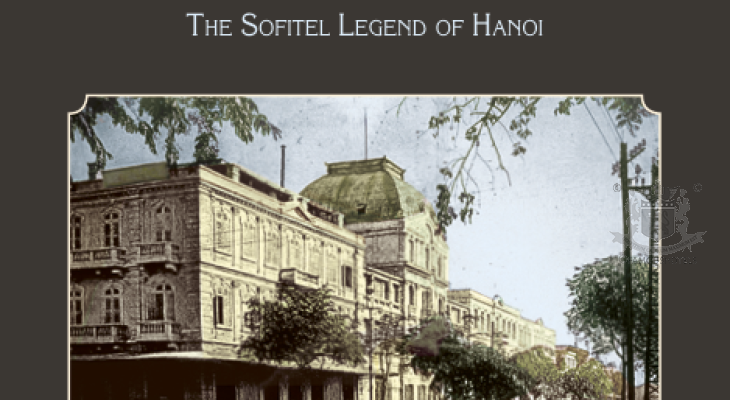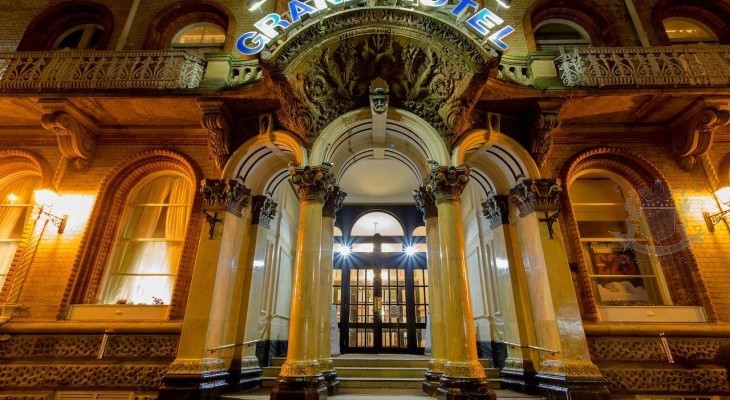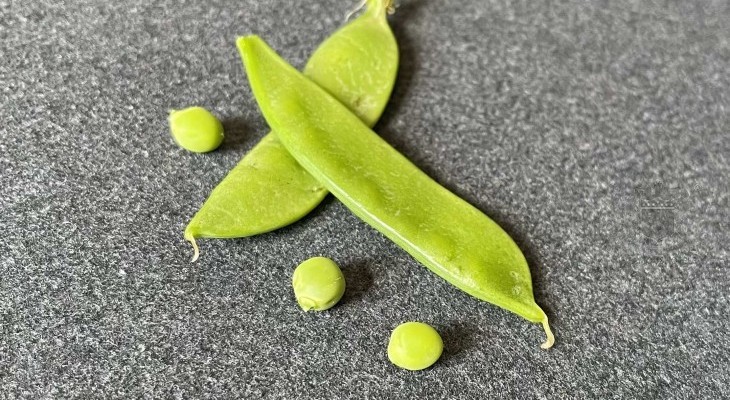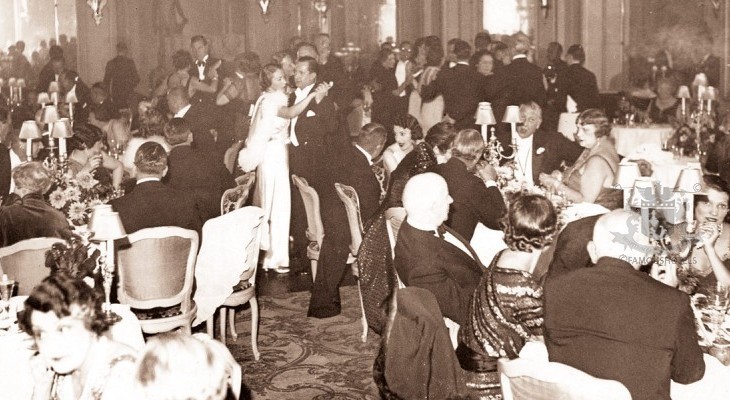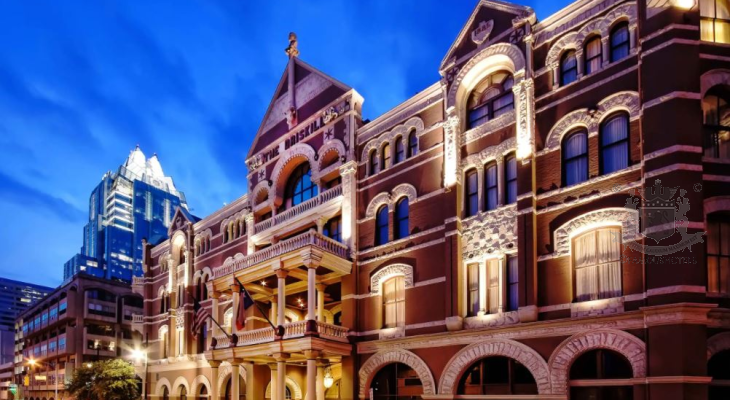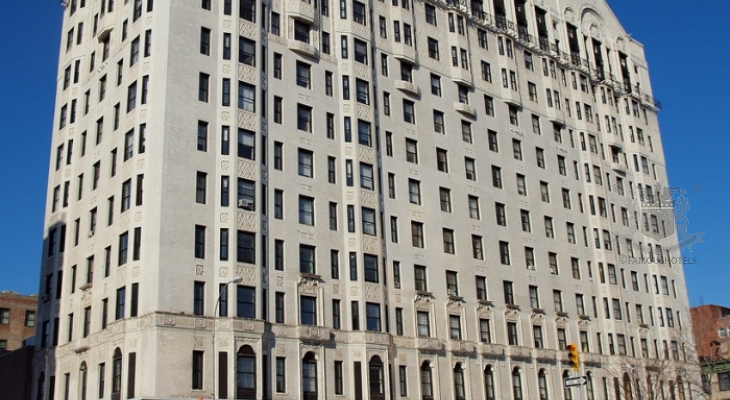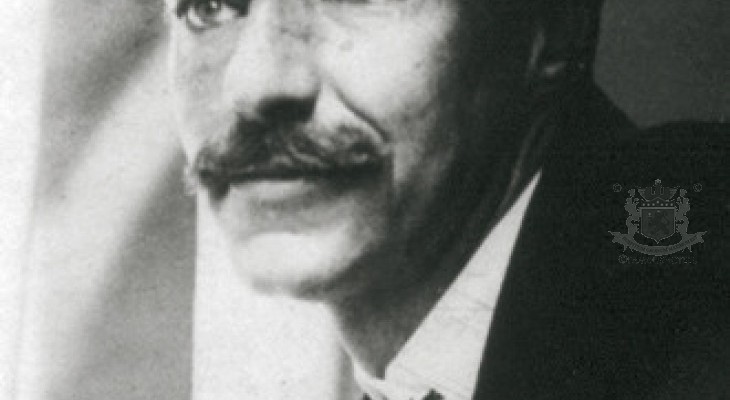Historic Hotel Names
( words)
All entries are in alpahbetical order.
BAUR EN VILLE / BAUR AU LAC
takes its name from its founder, Johannes Baur, who had first built the Hotel Baurin downtown Zurich in 1838. When he opened his second hotel by the lakeside in 1853, he renamed the original property en Ville (“in town”) and the new one au Lac (“at the lake”) — to avoid confusion. Unlike names such as Bellevue, Grand Hotel, or Bristol, which spread across the world, the name Baur remains unique. A Hotel Baur did once exist in Venice, but it had no relation to Johannes Baur or his Swiss establishments.
BELLEVUE
One of the most common historic hotel names, referring in general to a loction with an extraordinarty good view (also italian "Bella Vista", spanish "Buena Vista", german "Zur Schönen Aussicht").
BRISTOL
Bristol hotels all over the world like to claim that they were allowed to name their house after Frederick Augustus Hervey, the fourth Earl of Bristol. It has been said that the Earl only gave permission for the use of his title to those hotels that could measure up to his high standards. This is of course nonsense since the majority of these hotels opened their doors over 100 years after the Earl had died. Furthermore, these hotels also carry the coat of arms of the city of Bristol, a city, not a travelling aristocrat.We can assume that the early Bristol hotels (Rome 1870, Paris 1878 = not the Bristol we have today, this one was in Place Vendôme and the Hotel Bristol in Vienna, founded 1892) served as role-models to the hotels that opened in later years (Warsaw 1901, Oslo 1920, Paris 1925 plus around 50 further hotels across Europe).
They all proudly carry the coat of arms of the City of Bristol. The often quoted connection to the Earl of Bristol is no more than a poorly researched PR-gag.As you can see, the hotel trade is full of surprises and inventions. Until recently this story had been supported by many Bristol Hotels and sold to guests as fact.
Who first brought up the legend about the traveling duke - we don't know. The person in question is the late Frederick Augustus Hervey(1730-1803), Earl of Bristol and Bishop of Derry. The Earl and bishop was an eccentric traveller. Nevertheless, for the hotels to have named their houses with his consent, he should have lived one hundred years later.
The solution of the riddle is in the coat of arms.
We have long studied the legends around the Earl of Bristol. Finally we compared the coats of arms of the Earl and the City of Bristol. All hotels use the coat of arms of the city of Bristol, none the one of the Earl. For example, the coat of arms of the Hotel Bristol in Vienna went through various stages. The first one 100% resembled the coat of arms of the City of Bristol.In 1923 it was updated to a more modern version in Art Nouveau style. For the first time lions were used instead of unicorns. The lions later changed back to unicorns. The current coat of arms is once again graced by lions, however, the centre piece is the coat of arms of the city Bristol in England.
GRAND HOTEL
The term first appeared in London in the 16th century, but was taken over and developed on the European continent in the 1870s, when the first hotels – offering all possible and thinkable services and all of them under one roof – opened.
These hotel where usually owned by shareholders (this explains the absence of a personal name like e.g. "Sacher", "Brown's",).
(e.g. Grand Hotel Vienna, 1870)
: A Grand Hotel offers at least 100 of rooms, all of them of a considerable equal size and shape.
and it offers (and offered) - under one roof:
: accommodation (with bath rooms, en suite or on the same corridor).
: food and beverages (a restaurant, room service)
: stables (later garages)
: staff quarters (servants rooms - mostly on the upper floors, for the equipage of the wealthy traveller)
: services such as luggage transport (porter, upon request, extra to pay for)
: amenities such as heating (log fire in rooms, upon request, extra to pay for)
: light (candles, upon request, extra to pay for)
: all services related to organising things in the city (concierge - theatre tickets, train tickets and ship passages, ...)
The evolution of the Grand Hotel:
One day all services mentioned above, were included in the basic lodging price (no more extra bills for candles, log fire and service of porters, etc., today known as hidden hotel charges). In 1889, The Savoy Hotel in London was the first to provide all these services on an "all inclusive" base. The terms half-board and full-board (Halbpension, Vollpension) came into being - providing breakfast plus one or two meals per day included into the room rate.
The First Grand Hotel
The oldest Grand Hotel we have found so far opened in January 1774 in London. David Low opened the 'Grand Hotel'. The hotel was intended for residence by a wealthy clientele, with a top price of 15s. a night for a suite of two rooms.
The Grand Hotel (du Louvre) in Paris opened in 1855, the Grand Hotel Vienna in 1870.
Growing into a Grand Hotel:
The Grand Hotel Kronenhof in Pontresina (CH) was actually founded in 1851, but only changed its name to ‘Grand’ Hotel in 1890. The same applies to the Grand Hotel in Stresa, Italy, founded during the 1860s. The Grand Hotel Pupp in Carlovivary, Czech Republic, prides itself in a history dating back to 1701, but as a matter of fact, it had adopted the name ‘Grand’ Hotel only in 1913. The Grand at Trieste opened in 1873, the Grand Hotels Oslo and Stockholm in 1874, the Grand Hotel Vesuvio in Naples in 1882.
IMPERIAL
Imperial Hotels can not only be found in Imperial surroundings. You find them in democratic countries like America, too. Obviously the name is used to explain that the guest can expect "imperial grandeur". See a complete list of all Imperial Hotels here.
KEMPINSKI
Berthold Kempinski was a wine merchant in Raschkow near Posen. In 1872 he moved to Berlin and became a popular restaurant owner. In 1889 he opened Berlin's largest restaurant. His philosophy was to make luxury available for everybody. On good days his "half portions for half the price" attracted 10,000 customers.
He later adopted a male heir, his son in law, Richard Unger. Kempinski died in 1910, on 5 October 1908 his name was registered as a trademark for "delicatessen" (Feinkostwaren). He never was a hotelier.
The Kempinskis were dispossessed during the Nazi era, arrested and deported. Today's hotel chain has no living connection to the Kempinski family.
Berlin's Hotel Bristol, opened in 1952, was managed by the Hotelbetriebs-Aktiengesellschaft (founded 1897). In 1970 it became the first hotel to bear the name Kempinski.
ORIENTAL
PALACE HOTEL
RAFFLES
Sir Thomas Stamford Bingley Raffles (6 July 1781 – 5 July 1826) was a British subject, best known for founding the city of Singapore (now the city-state of the Republic of Singapore). He is known as the "Father of Singapore". He was also heavily involved in the conquest of the Indonesian island of Java from Dutch and French military forces during the Napoleonic Wars.
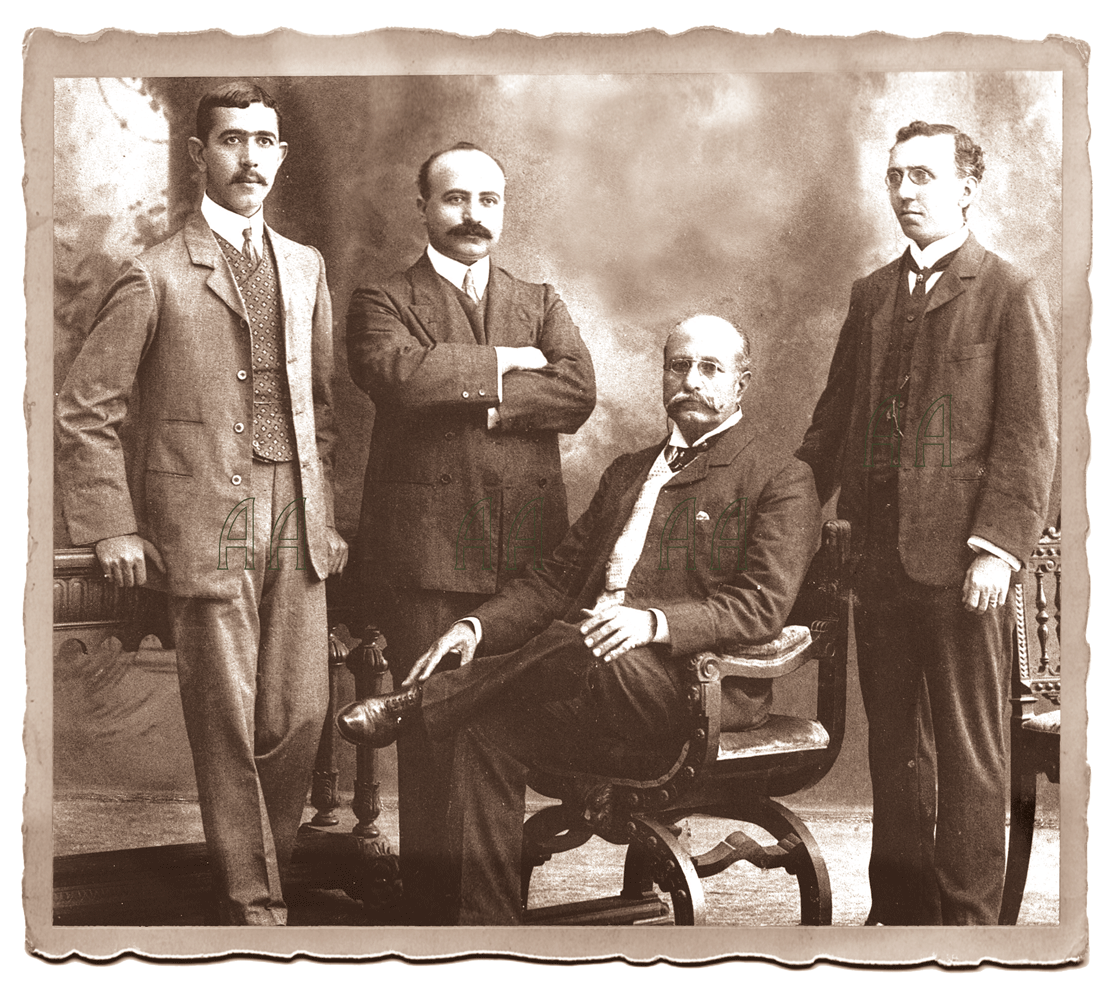 1819, February 6th: Sir Thomas Stamford Bingley Raffles signed the treaty with the new Sultan of Johore to establish a trading post in Singapore for the British East India Company. Raffles installed a committee that drew the basic plans for a controlled development of Singapore.
1819, February 6th: Sir Thomas Stamford Bingley Raffles signed the treaty with the new Sultan of Johore to establish a trading post in Singapore for the British East India Company. Raffles installed a committee that drew the basic plans for a controlled development of Singapore.
The Sarkies brothers: Tigran, Arshak, Martin and Aviet (from left)
In 1886 the Armenian Sarkies brothers took over the manison of Captain George Julius Dare in Singapore´s prestigious "Twenty - House Street" (Beach Road). The property, facing the harbour, belonged to the Arabian trader Syed Mohammed Bin Ahmed Al Sagoff. In 1887, the Sarkies transformed the house, which operated as a Tiffin Room, into a small hostelry and opened with 20 rooms only under the name Raffles Hotel on December 1st.
Only in 1899 the elegant Raffles Hotel main-building we know today with a total of 102 rooms was created. It was the first hotel in the Straits Settlements employing electricity to illuminate and cool a building.
SAVOY
A Global Phenomenon
Few hotel names have travelled the world like Savoy. Its story begins in London, where in 1889 RICHARD D'OYLY CARTE (managed by César Ritz and Auguste Escoffier) created the world’s first truly modern hotel — The Savoy. Yet the name itself goes back centuries earlier, to Prince Peter of Savoy, the 13th-century nobleman who built the Savoy Palace on the same stretch of the Thames. A statue of him still guards the entrance to London’s Savoy Hotel — a reminder that hospitality, like history, has noble roots.
Countless Savoy Hotels appeared around the world. A hotel operating under this name opened in 1888, a year earlier than the London Savoy (1889) and it is where one would probably least expect it: in Kansas City, Missouri. It rose to considerable fame as the haunt of Roosevelt, Rockefeller and consorts. Unfortunately, during the recessional 1930s it suffered considerably and today, all that is left of its former glory is a modest inn (with an extraordinary interior) and the legendary Savoy Grill, which opened together with the West Wing in 1903.
On 1 March 1896, The Savoy in Florence opened its doors, and is still regarded as one of the city’s finest hotels. In Cairo, a Savoy Hotel opened on 28 November 1898, while there was another on Elephantine Island at Aswan. The Savoy in Copenhagen opened in 1906 and The Savoy in Berlin (1929), a small hotel, acquired popularity as an artists’ haunt. Today, one can find the name Savoy on hotels from Brighton (in Victoria, Australia) to Prague, from Frankfurt to Cologne, to Rotterdam, to New York, Blackpool, Caorle and San Francisco. A little hotel in the Italian beach resort of Grado was named The Savoy in 1952 because it was considered a traditional name for famous hotels. There is a Savoy in Buenos Aires, in Rome, Cannes, Vienna, New York and even in Thonon-les-Bains, France, not forgetting the one on the island of Madeira.
Oslo, Lausanne, Caracas, Berne, Moscow and Cannes all have their own Savoy. To distinguish the Baur in the city from the Baur au Lac in Zurich, the prefix Savoy Baur en Ville was added to the famous hotel in the Bahnhofstrasse. The Savoy Baur en Ville is today called Mandarin Oriental Savoy, Zurich.
One can also find a Savoy hotel in the Swedish city of Malmö, in Cusco in Peru, in Yangon in Myanmar and in Melbourne, Australia.
SPEKE HOTEL
(Kampala, Uganda) is named after the famous British explorer, John Hannington Speke, who 'discovered the source of River Nile. Speke Hotel is the first and oldest hotel in Uganda, built in the British Colonial times of the 1920.
- accor
- bangkok
- baur au lac
- bristol
- earl of bristol
- england
- frankfurt
- grand hotel
- hotel imperial
- imperial
- india
- legend
- london
- madeira
- mandarin oriental
- new york
- oriental
- oriental hotel
- palace hotel
- palast hotel
- paris
- raffles
- rockefeller
- rome
- roosevelt
- sacher
- sarkies
- savoy
- savoy hotel
- singapore
- sting
- thailand
- ukraine
- vienna
- yangon
Built in less than two years: the New Waldorf Astoria
( words)
The Waldorf Astoria New York is a member of The Most Famous Hotels in the World since the very first hour of our organisation in 1986. There was no doubt for the two of us that we will enjoy our partnership. Ever since, we are researching the history of the Waldorf.
famoushotels academy
( words)
FAMOUSHOTELS ACADEMY
Where history meets innovation in hospitality communication.
The FamousHotels Academy is the 1989-founded education institute of The Most Famous Hotels in the World®. It is designed for aspiring professionals in hotel PR, guerrilla marketing, and heritage-driven storytelling.
What We Teach
-
Public Relations & Hotel Storytelling
Learn how to shape narratives that connect your hotel’s heritage with today’s guests. -
Basic Skills in History Research
Understand how to distinguish historical from alternative facts. Where to find what? -
Guerrilla Marketing & Brand Activation
Bold, unconventional strategies that make historic hotels stand out in a crowded marketplace. -
Social Media Strategy
From TikTok to LinkedIn: how to manage, plan, and grow a hotel’s online voice. -
Desktop Publishing & Visual Identity
Practical skills in Adobe Creative Cloud (InDesign, Photoshop, Illustrator) for brochures, invitations, and digital campaigns. -
Fine-Tuning & Professional Standards
Turning good ideas into polished, professional results that reflect the excellence of the world’s greatest hotels.
Who Should Apply?
-
Young professionals aiming to specialise in PR & communications for hotels
-
Hotel marketing teams who want to sharpen their skills
-
Students of hospitality eager to gain hands-on creative tools
-
Freelancers and agencies wishing to align with heritage-based storytelling
Why FamousHotels Academy?
Since 1986, The Most Famous Hotels in the World® has been the global library of hospitality history. Our Academy builds on this expertise, combining rigorous research, practical tools, and creative innovation to prepare a new generation of communicators. Leading Professor is Andreas Augustin (guest professor at, among others, EHL Switzerland, Modul University, Austria, ...).
Certification
Participants receive a FamousHotels Academy Certificate, proof of professional competence recognised across the hospitality industry.
Apply Now
Applications are open. Places are limited.
For dates and detailed information please write to aa@famoushotels.org with your CV and a short statement of motivation.
We Live in the Now – But Never Destroy Our Heritage
( words)
„We Live in the Now – But Never Destroy Our Heritage“
Innegrit Volkhardt, owner of the Bayerischer Hof, Munich
By Hans Amrein
Innegrit Volkhardt (60) has been at the helm of Munich’s legendary Bayerischer Hof since 1992. At just 27 she took charge of the grand hotel, founded in 1841 at the wish of King Ludwig I of Bavaria. Today the 337-room property with six restaurants, 40 event spaces, spa, cinema, theatre and jazz club is one of Germany’s most successful hotels, employing over 700 staff. The Volkhardt family has owned the Bayerischer Hof since 1897 — and the fifth generation is already preparing to continue the story.
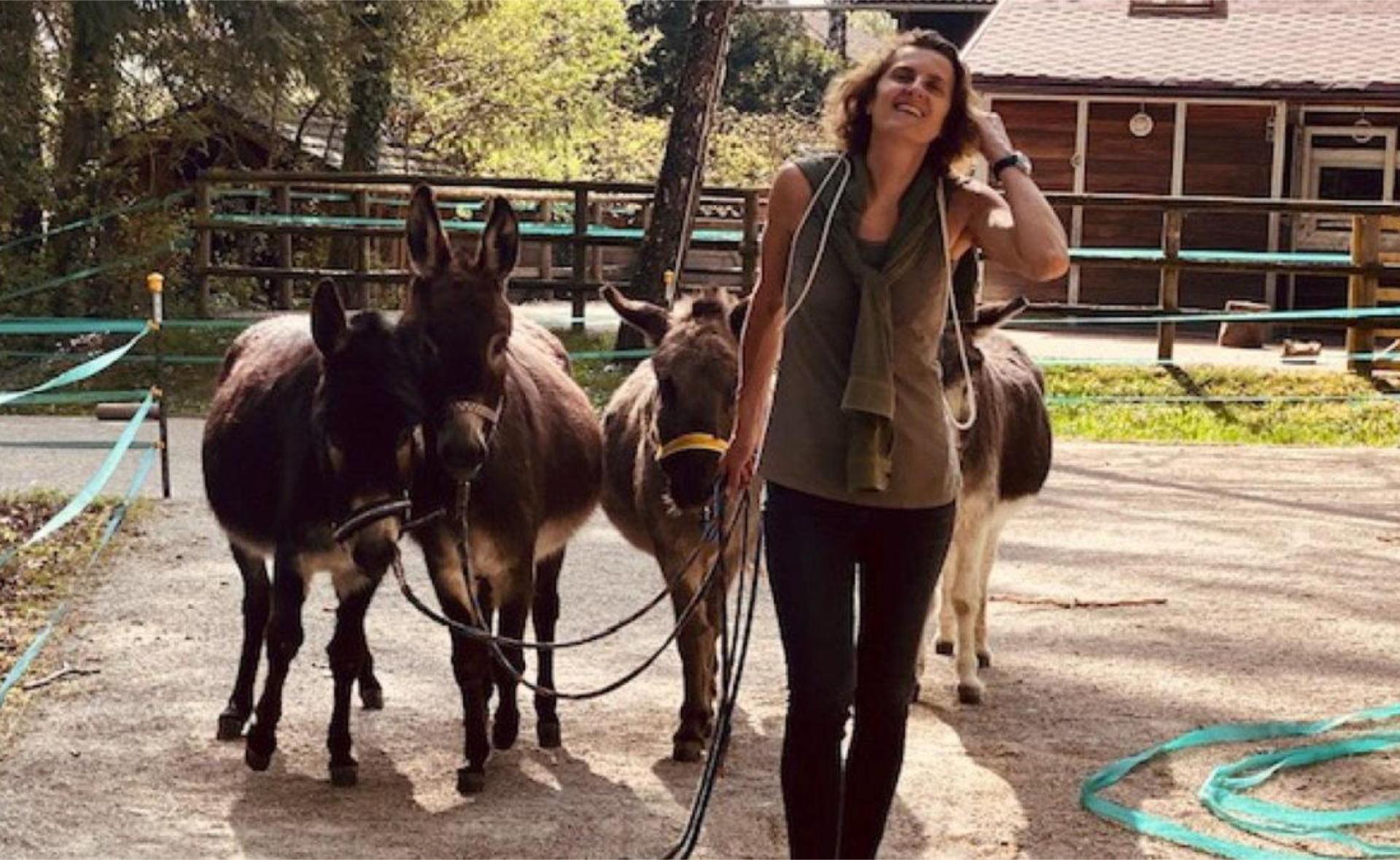 Your mornings begin with four donkeys at Lake Starnberg. A counterbalance to hotel life?
Your mornings begin with four donkeys at Lake Starnberg. A counterbalance to hotel life?
Volkhardt: Absolutely. They are my first and last joy every day. Even when I return late at night, I check if they are asleep.
And jazz is another passion of yours — the hotel has its own jazz club.
Volkhardt: Yes, jazz is very close to my heart. Many world-class musicians have played in our club. To host them here was a privilege.
Let’s talk about history. How relevant is tradition in the age of TikTok?
Volkhardt: Very much so. King Ludwig ordered the hotel built in 1839; my great-grandfather acquired it in 1897. For German guests, this history is part of our appeal. International guests may not choose us because of history, but they are always impressed when they learn the house is family-run in the fourth generation.
You became general manager in 1992. At 27, that was young.
Volkhardt: Yes, but it was also a chance to modernise while safeguarding the hotel’s soul.
Your father Falk Volkhardt was legendary; the historic „Falk’s Bar“ is named after him.
Volkhardt: Indeed, and we still serve guests there under antique mirrors dating back to 1841 — with a contemporary twist.
The hotel in pre-world-war-2 days. During the war (1939-1945) is was almost completely destroyed.
How do you balance heritage and innovation?
Volkhardt: By respecting what is irreplaceable while adapting to new expectations. Our Palais Keller serves Bavarian cuisine in a historic setting but has been sensitively modernised. Now we are redesigning the reception and introducing digital check-in via smartphone. Yet the essence — personal service and authenticity — must never be lost.
Axel Vervoordt designed your avant-garde rooms. Bold for a grand hotel?
Volkhardt: Bold, yes, but our staff guide guests through the concept. And those who prefer more classic rooms still have the choice.
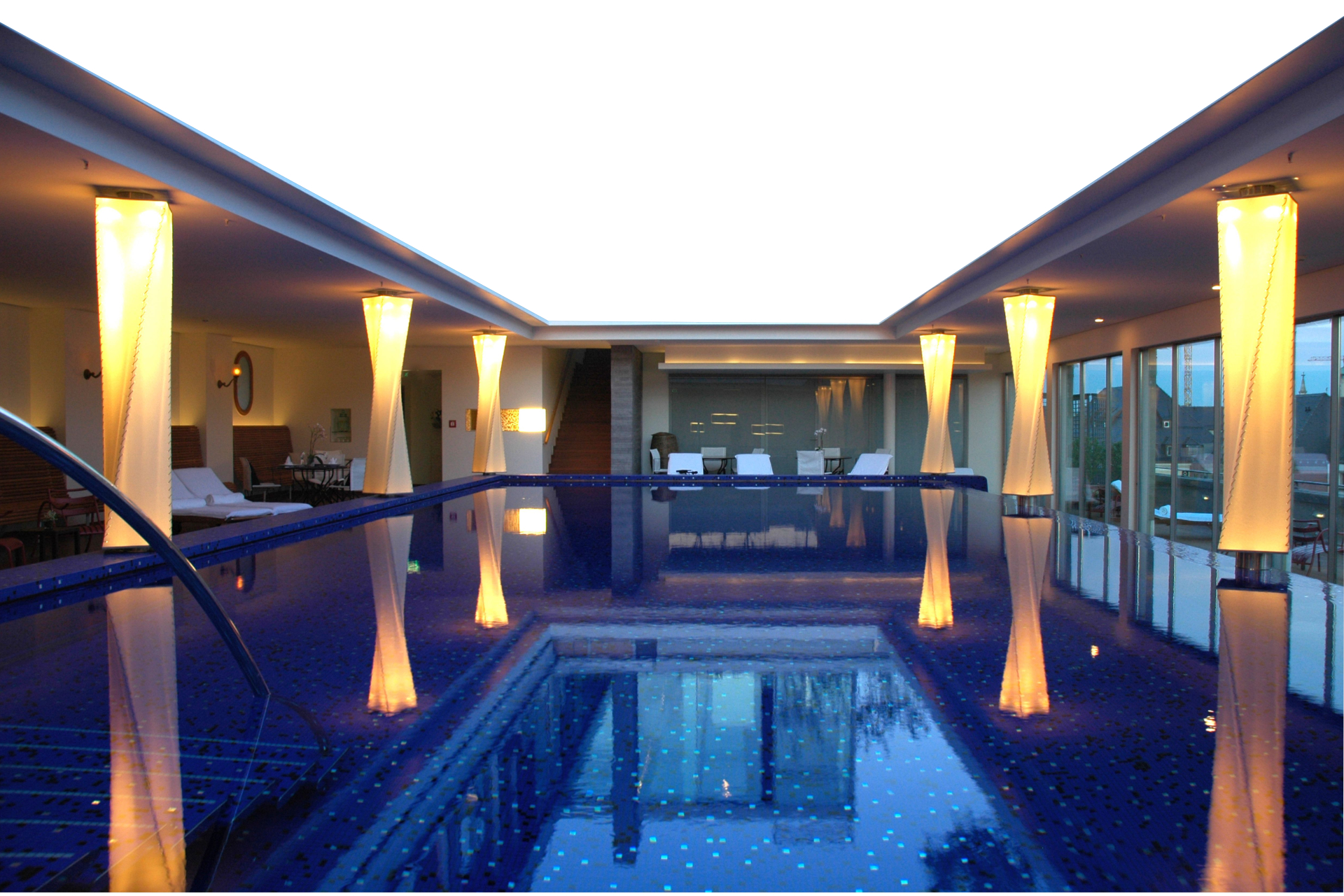
Rooftop Pool with a view
Rooftop view over Munich and Frauenkirche
Luxury today is no longer chandeliers and marble. How do you define it?
Volkhardt: Luxury means being treated as an individual. That requires staff with empathy and passion. Many of our employees have been here for decades — they know how to exceed expectations.
Munich has seen new competition: Rosewood, The Charles, Mandarin Oriental. Does the Bayerischer Hof still play in the Champions League?
Volkhardt: Of course. We have history, culture, our theatre, jazz club, Blue Spa, and a team that delivers. Competition keeps us sharp. In the end, all hotels cook with water.
Could you ever imagine selling?
Volkhardt: Never. The Bayerischer Hof is family. The fifth generation is preparing to take over – the daughter of my sister, to be precise.
Innegrit Volkhardt
Born 1965, she studied business administration, trained in hospitality and worked with Käfer and Intercontinental Hamburg before taking over the Bayerischer Hof in 1992. She has since invested over €150 million, adding highlights like the Blue Spa by Andrée Putman. Honours include Hotel Manager of the Year and the Bavarian Order of Merit. She lives at Lake Starnberg — with cats, donkeys, and a love for jazz.
The Bayerischer Hof, Munich
-
Opened: 1841, designed by Friedrich von Gärtner, at the request of King Ludwig I.
-
In family ownership since 1897 (Volkhardt family).
-
337 rooms, 74 suites, six restaurants (including a Michelin 3-star), 40 event spaces, spa, cinema, theatre, jazz club.
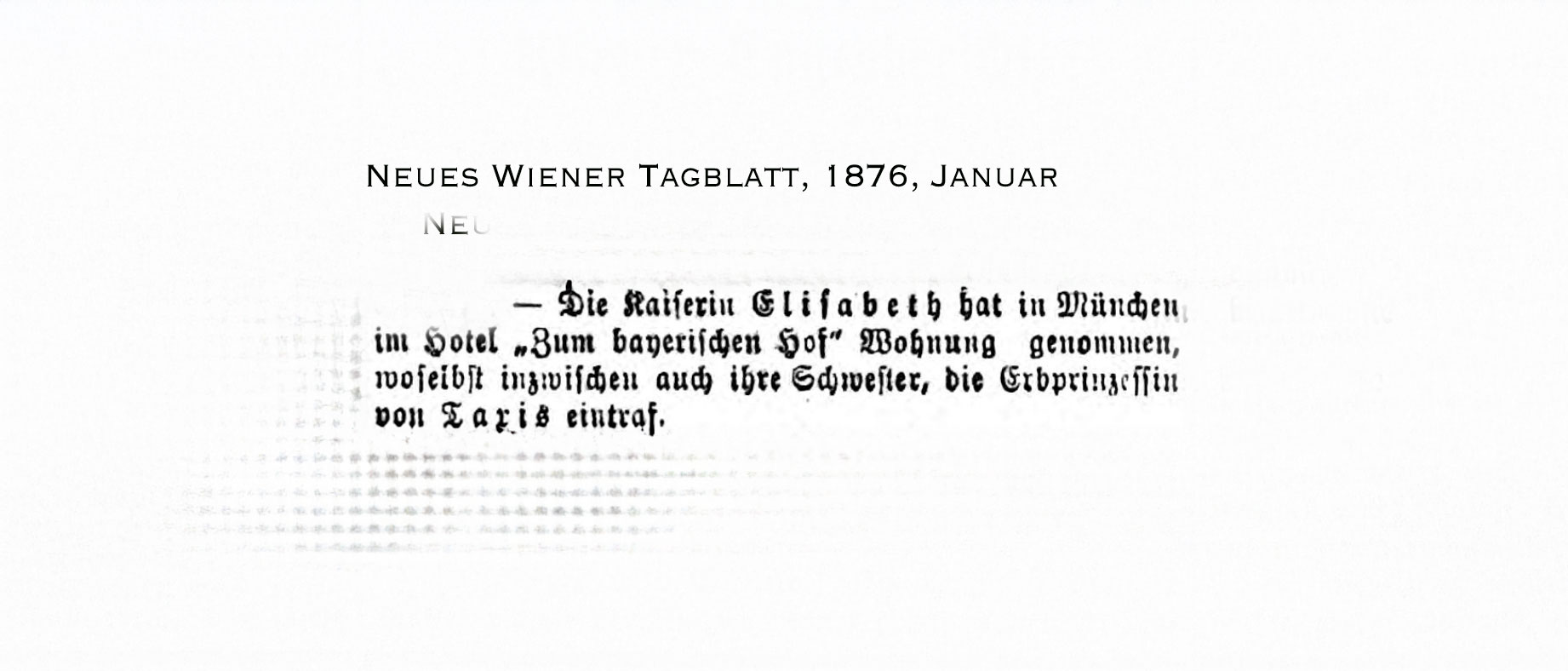
The arrival of Empress Elisabeth of Austria, reported in the Viennese Newspaper in January 1876.
-
Famous guests: Richard Wagner, Sigmund Freud, Kaiserin Elisabeth, Michael Jackson, the Rolling Stones, Angela Merkel, Hillary Clinton, Brad Pitt, George Clooney, and many more.
-
Host of the Munich Security Conference since the 1960s.
A living legend: part Munich, part international stage.
https://famoushotels.org/hotels/bayerischer-hof
This interview by Hans Amrein first appeared in hotelinside.ch — the global echo of the Swiss/German/Austrian Sphere of Hospitality: https://hotelinside.ch/frau-volkhardt-wie-schaffen-sie-den-spagat-zwischen-tradition-und-moderne/
Scent of a Woman
( words)
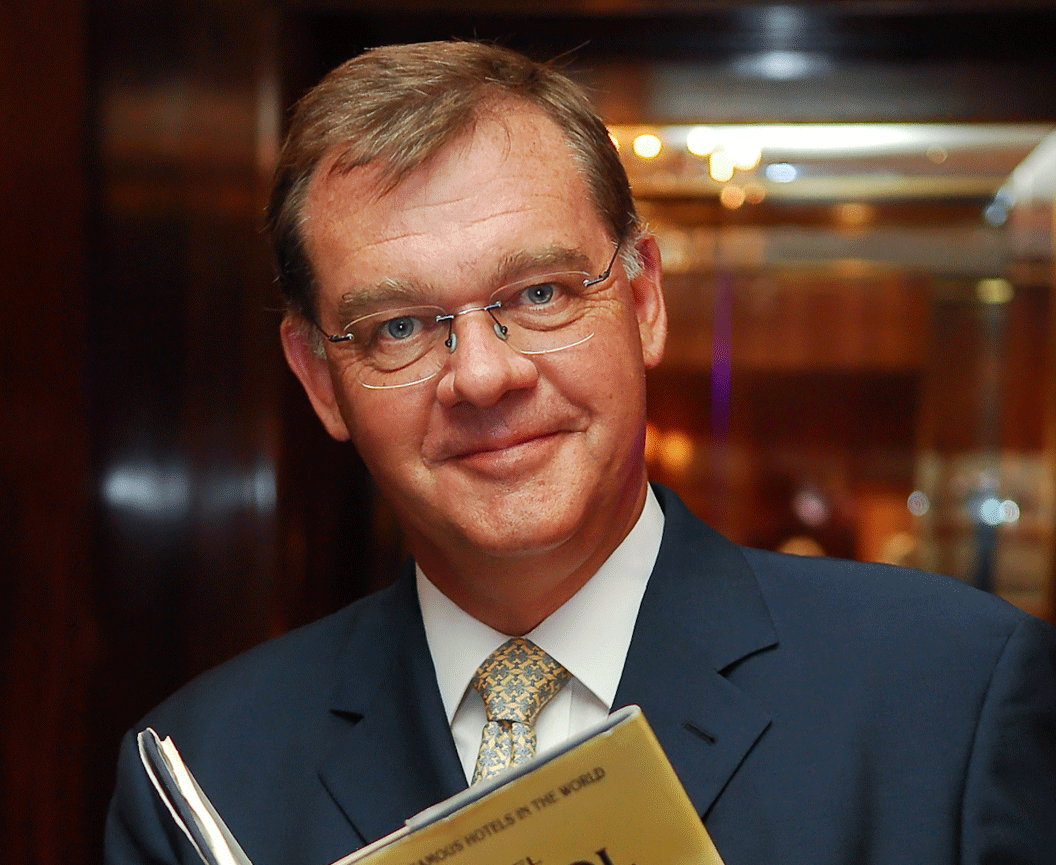 Gracious Thai dancer at “Sala Rim Naam” - the title photograph is by Michelle Chaplow
Gracious Thai dancer at “Sala Rim Naam” - the title photograph is by Michelle Chaplow
Author Andreas Augustin visits a good old friend. Once called one of the “Maidens of the East”, today one of the Grand Old Ladies of South East Asia. The Mandarin Oriental in Bangkok keeps its reign as the most famous hotel of Thailand, but for most travellers it is just the best hotel in the world.
Darling, so good to see you again! Let me bow in classical Thai style, my hands folded – I “wai” to you. You look younger than ever, how do you possibly do that? Love your perfume!
I feel tempted to inquire, but of course a true gentleman would never ask the age of a lady. On the other hand, you officially announced your birthday. We all know the story: in 1976, you have decided that you admit to 100 years of age. That would make your opening year 1876, and we are counting ever since, aren’t we? But - we spokie about it before - I have stumbled upon a “Bangkok Calendar” from 1863, where your name featured prominently: “ORIENTAL HOTEL — Dyer and West, Proprietors”. So in fact you are older than ... could it be that you are telling stories here and there, as many grand old ladies do, and we graciously pardon them.
Your landing pier today is the driveway where the limousines pull up. But back in time the only way to arrive was directly from the River Chao Phraya, the mother of all waters. So, from your early days on, you were home to seafaring people and tradesmen, travellers and explorers. You burnt down twice, in the 1880s you grew into a respectable hotel with a large quadrangular structure and an inner courtyard, today’s Authors’ Lounge.
Not far from here, a strange “animal” with four arms and four legs had been discovered: the first Siamese twins, Chang and Eng. They became an international attraction.
In the jungles of Siam, rare and sacred white elephants were rounded up and brought to the Royal palace as a symbol of a successful reign.
During the 1890s, the Royal Thai Yacht Maha Chakri anchored in front of you because you had become the hotel of choice of the King. There were no other hotels of western style and quality. Your first Royal visitor was the King of Siam, as Thailand was called before, HM Chulalongkorn, who invited his first international guest, the future Tsar of Russia, to stay at The Oriental in 1891.
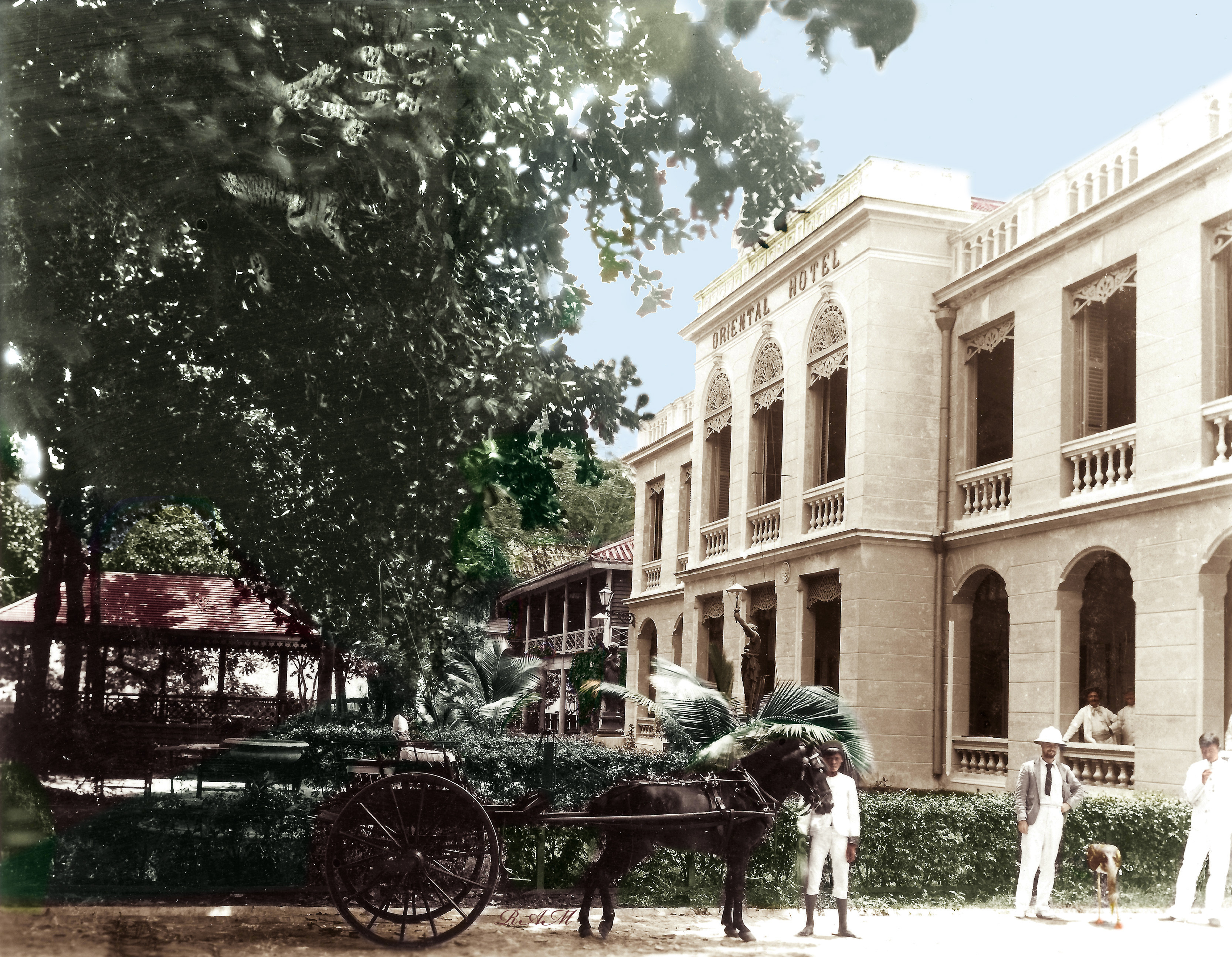
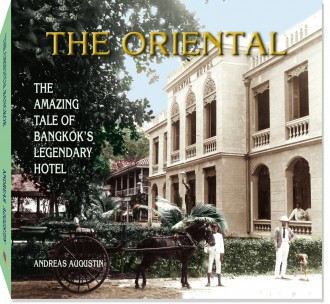 You were owned and managed by various outstanding characters: by Dutch businessman and founder of the East Asiatic Company, H. N. Andersen, by Marie Maire, a championship golfer and talented amateur hotelier, by French photographer Germaine Krull, a Thai politician and American silk trader Jim Thompson, by Italian-Thai owners. Then you accepted the proposal of Hong Kong based hotel group Mandarin, which – after its happy marriage with you – became known as Mandarin Oriental. Today, professional managers are at the helm of your operation. German Kurt Wachtveitl was there for over 40 years — and what an honour it had become to be in this position.
You were owned and managed by various outstanding characters: by Dutch businessman and founder of the East Asiatic Company, H. N. Andersen, by Marie Maire, a championship golfer and talented amateur hotelier, by French photographer Germaine Krull, a Thai politician and American silk trader Jim Thompson, by Italian-Thai owners. Then you accepted the proposal of Hong Kong based hotel group Mandarin, which – after its happy marriage with you – became known as Mandarin Oriental. Today, professional managers are at the helm of your operation. German Kurt Wachtveitl was there for over 40 years — and what an honour it had become to be in this position.
With the railway, driven into Siam by farsighted kings, more and more travellers arrived. In 1916, the God of Dance, Vaslav Nijinsky, performed at the hotel. In 1923, English novelist Somerset Maugham recovered from Malaria in his room. Convalescent, he composed – in the shade of the shutters of his veranda – a fairy tale of Siamese princesses. In 1932, it took a KLM flight 15 stops between Amsterdam and Bangkok to arrive. In 1945 the Bamboo Bar opened. The first thing you introduced there was a dress code: tie compulsory. No excuse.
You have received so many extensions that I almost lost count. The Embassy Wing and the Tower Wing, the River Wing, and last but not least Asia’s first internationally acclaimed Spa and Fitness centre with tennis courts. The Royal family of Thailand still treats you as its guesthouse. Therefor it is always appropriate to be well dressed, as a member of the Royal family may just come down the stairs. After all, HM The Queen personally cut the ribbon to open your River Wing.
You have a sense for culture, you present the portraits of your visiting writers in the Authors’ Lounge and you honour the winner of the SEA Write Award, the South East Asia writers’ award, with generous hospitality. In 1980, James A. Michener held the laudation of the first event, followed by Paul Theroux, Norman Mailer, Sir Peter Ustinov, …
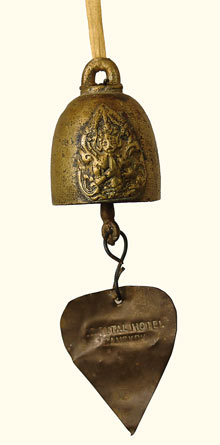 You have put on new make-up, Darling, and you look stunning. Your historic Authors’ Wing holds a new secret tip, the new Ambassador Suite. And how generously and elegantly you decorated the sumptuous Royal Suite! Downstairs you serve me “La Grande Dame“, a tea blend exclusively created by the classic Paris house of tea Mariage Frères for your Afternoon High Tea. But this is only the start, you invite me to eight restaurants, and, as always, it is not hard to choose.
You have put on new make-up, Darling, and you look stunning. Your historic Authors’ Wing holds a new secret tip, the new Ambassador Suite. And how generously and elegantly you decorated the sumptuous Royal Suite! Downstairs you serve me “La Grande Dame“, a tea blend exclusively created by the classic Paris house of tea Mariage Frères for your Afternoon High Tea. But this is only the start, you invite me to eight restaurants, and, as always, it is not hard to choose.
After crossing the river on your private ferry boat, I return to my suite from your tennis courts at 7 pm. I observe details of carefully assembled interiors and amenities. While I was away, my butler has laid out the content of my Necessaire on a white towel as if he wants to give me an educated overview of my personal possessions. The TV plays the current company’s trailer. Ever since the clip “Moments of Delight at Mandarin Oriental", I am fascinated by Chinese musician Sa Ding Ding.
While I change for dinner, I enjoy the assorted hors d’oeuvres you have kindly sent me on a plate covered by a glass cloche. Exquisite goose liver pâté. A sip of champagne, a glance at the knot of my tie. I hope you like it. My butler is waiting in the wings, so to say, since generations an undisclosed system tells him when I leave the room. I know his secret. After I have left, he will quickly enter and restore my bathroom, the towels, to turn-down my bed. Arrange my manicure set.
At first nights in Asia I usually prefer the wonderful breeze on the “River Terrace”. The opulent buffets are too tempting. Same with breakfast. Sitting outside when the day awakes, I read my mails, the papers, watch the world over my coffee cup. Gently, my time flows down the Chao Phraya river. Sometimes, it comes back. The River, I mean. It’s a matter of low and high tide in its delta nearby. It is clean water, by the way. Hundreds of fish. Just throw a piece of bread into it.
One of the following nights is dedicated to “Le Normandie”. Two Michelin Stars at the top of The Oriental. Here you ask gentlemen to wear a jacket. Thank you for keeping up the tradition of etiquette. “Ciao” is classic Italian food on the terrace, “Lord Jim’s” – named after Polish-English writer Joseph Conrad’s book — serves seafood in a cool interior. Thai food at “Sala Rim Naam”, where I enjoy sea crab meat cooked in coconut milk. And the show of your Thai Dancers. Next to the front entrance is “The China House“, kept in Shanghai Art Deco. Cantonese cuisine, Dim Sum and Brunch on Sundays to be reserved.
I wander through your gardens. An orchestra of cicada boys in the trees serenades the diners on nearby terraces, but in fact they are playing their music to attract cicada girls. All this occasionally totally drown out by the overwhelming clatter of the long tail boats on the river. Large dinner cruise ships glide by, lit by garlands of colourful light bulbs, entertained by piped music. Their diners look at us and think, how lucky we are to be sitting on the terrace of The Oriental. We – in return – rarely envy them.
The later the evening, the more contributes the fragrance of Hibiscus, Bougainvillea and Frangipani to my olfactory impressions. What a scent.
In front of the Authors’ Wing stand two statuettes of torch holding ladies. They appear on the earliest photographs of the Oriental. Always lit by electricity, their shine had lead great travellers, writers, actors, statesmen and crowned heads while wandering the gardens at night. How many declarations of love were made in their gleam?
An overwhelming flower arrangement stands in the lobby (think Christmas tree, Rockefeller Center). Modestly, but prominent, at the concierge desk, rests my book about your history on a shiny brass presenter. So kind of you to display it so notably. But I get carried away — it is a heavy perfume you have put on, my dearest lady. Jasmin, Bougainvillea and Frangipani are a wonderful mix, seducing in every respect. The mild air carries the sound of Jazz from the Bamboo Bar, performed by The Oriental’s house band. Is this your last temptation that evening? Don’t worry, you have already convinced me: I will spend another night in your bed — dreaming of white elephants, Siamese Twins and Princesses.
The Mandarin Oriental is a Select Member of The Most Famous Hotels in the World.
Andreas Augustin is the author of the book THE ORIENTAL – THE AMAZING TALE OF BANGKOK’S LEGENDRAY HOTEL.
Originally this story appeard in Marie Claire Italy: https://www.marieclaire.com/it/lifestyle/viaggi/a20120730/hotel-in-thailandia-the-oriental/
- 1876
- 1891
- 1916
- art deco
- bangkok
- china
- david bowie
- graham greene
- hong kong
- jim thompson
- joseph conrad
- kurt wachtveitl
- legend
- mandarin oriental
- maugham
- michael jackson
- nijinsky
- oriental
- paris
- peter ustinov
- prince of wales
- rockefeller
- roger moore
- roosevelt
- royal
- russia
- siam
- sirikit
- somerset maugham
- south east asia
- thailand
- vaslav nijinsky
From Transit Stop to Destination
( words)
By Adrian Mourby
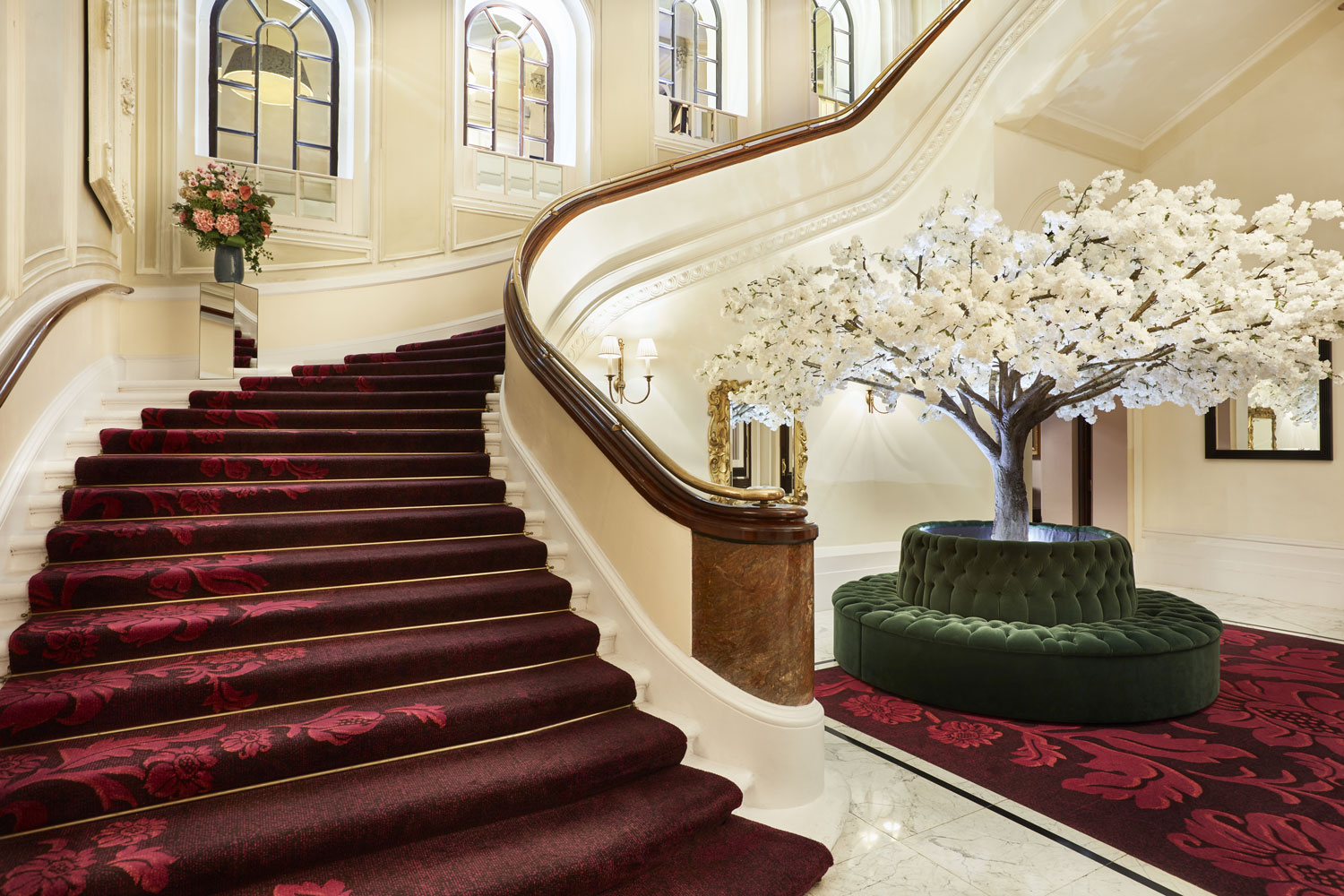 Charing Cross is one of several Victorian railway terminus hotels built in London in the 19th century. Opened in 1865 above its station, it served as the grand arrival point for Calais–Dover boat passengers — travellers from the Continent, then the most important of all. In that age of glamorous rail travel, the most expensive rooms overlooked the railway platforms, while the prestigious Strand view was of lesser value.
Charing Cross is one of several Victorian railway terminus hotels built in London in the 19th century. Opened in 1865 above its station, it served as the grand arrival point for Calais–Dover boat passengers — travellers from the Continent, then the most important of all. In that age of glamorous rail travel, the most expensive rooms overlooked the railway platforms, while the prestigious Strand view was of lesser value.
In the 1980s, the station was redeveloped and the air space above the platforms used for new office accommodation. Designed by Terry Farrell, Embankment Place rests on a concrete raft put in place of the 1906 roof.
Today, the Clermont Charing Cross pairs its Victorian railway‑age grandeur with the futuristic, spaceship‑like station that now spans the Thames, and a prime location in the heart of London.
The Clermont Charing Cross is one of several Victorian railway terminus hotels built in London in the 19th century. By 1850 the British capital was already the largest city the world had ever known, forging railway links with the rest of the country. Instead of a single central station, London built a ring of them: Euston to the north, Liverpool Street to the east, Paddington to the west, and Charing Cross to the south, connecting all the way to Dover.
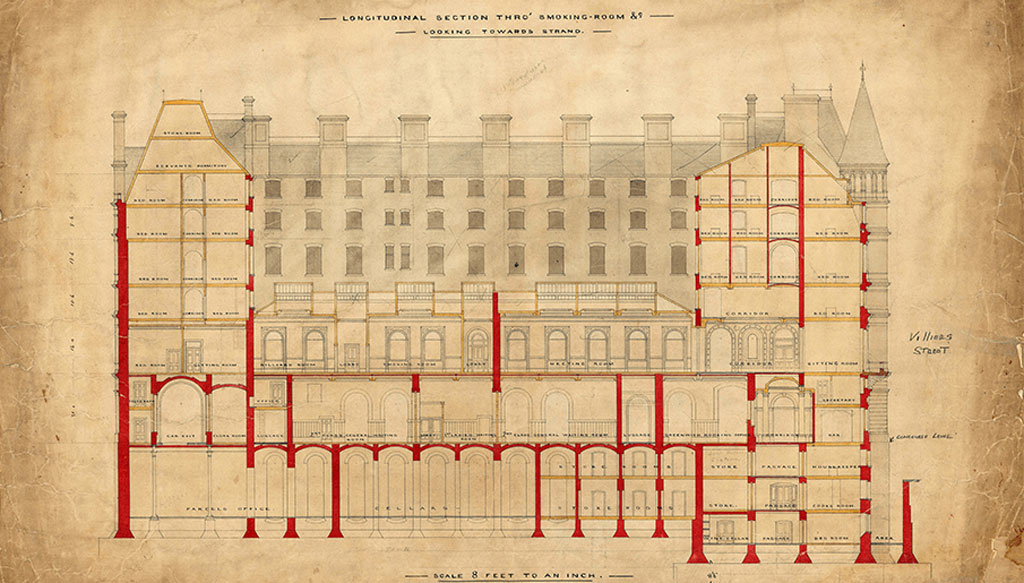 Each station had its palatial hotel. At Paddington, the Great Western Royal Hotel was the brainchild of Isambard Kingdom Brunel, conceived as the start of a GWR journey all the way to New York. St Pancras was arguably the most beautiful — a veritable cathedral of a hotel designed by the Gothic Revival master George Gilbert Scott. Yet the Charing Cross Hotel was premier. Built above Charing Cross Station, it served the boat train from Calais, receiving European visitors for their first night in England. Interesting to Note: Around 1900, some 100 of the largest hotels in the United Kingdom were run directly by the railway companies themselves. By parliamentary act, they were granted permission both to build and to operate these hotels — a recognition that such ventures were in the public interest. The arrangement greatly boosted travel and the profitability of the British railways. The Midland Railway, for example, estimated that without its grand Manchester hotel, some 40,000 travellers in 1904 would not have stayed overnight in the city at all. The Midland Hotel in Manchester was then one of the largest and most prestigious hotels in England, employing 400 staff, serving 1,000 meals a day, and in its celebrated German restaurant selling some 80,000 portions of German specialities and half a million glasses of German beer annually
Each station had its palatial hotel. At Paddington, the Great Western Royal Hotel was the brainchild of Isambard Kingdom Brunel, conceived as the start of a GWR journey all the way to New York. St Pancras was arguably the most beautiful — a veritable cathedral of a hotel designed by the Gothic Revival master George Gilbert Scott. Yet the Charing Cross Hotel was premier. Built above Charing Cross Station, it served the boat train from Calais, receiving European visitors for their first night in England. Interesting to Note: Around 1900, some 100 of the largest hotels in the United Kingdom were run directly by the railway companies themselves. By parliamentary act, they were granted permission both to build and to operate these hotels — a recognition that such ventures were in the public interest. The arrangement greatly boosted travel and the profitability of the British railways. The Midland Railway, for example, estimated that without its grand Manchester hotel, some 40,000 travellers in 1904 would not have stayed overnight in the city at all. The Midland Hotel in Manchester was then one of the largest and most prestigious hotels in England, employing 400 staff, serving 1,000 meals a day, and in its celebrated German restaurant selling some 80,000 portions of German specialities and half a million glasses of German beer annually
Back to London: soon other hotels clustered nearby — The Strand, The Grand, the Metropole (now the Corinthia) — but the Charing Cross Railway Hotel came first. It was designed by Edward Middleton Barry RA, son of Sir Charles Barry, who shaped Victorian Britain with works including Trafalgar Square, the rebuilt Palace of Westminster, and many country houses. Sir Charles favoured a florid yet neoclassical style. His third son Edward was more versatile, designing both the station and the hotel. The blunt yellow-brick façade was relieved by two extravagant first‑floor conservatories overhanging the east and west entrances, and the roofline was crowned by two mansard turrets — later lost to the Luftwaffe in 1941.
The hotel was built in 1863–64 by Charles and Thomas Lucas, also engaged on the Langham Hotel near Regent’s Park, and later the Albert Hall. The Charing Cross opened on 15 May 1865 with its station. Passengers walked beneath the hotel to reach their trains. It had 250 bedrooms over seven floors. While the front faced the Strand, the priciest rooms overlooked the platforms — train travel then was a mark of glamour.
After the war, the top two floors were rebuilt in 1953 to designs by F.J. Wills & Son. The new roofline was more functional, with a hint of Art Deco squareness, yet it suited the building better than the old mansards. One repair was never made: debris from the wartime blast dented the elegant handrail of the grand staircase leading from bustling ground‑floor London to the piano nobile. The dent remains, polished to a gleam.
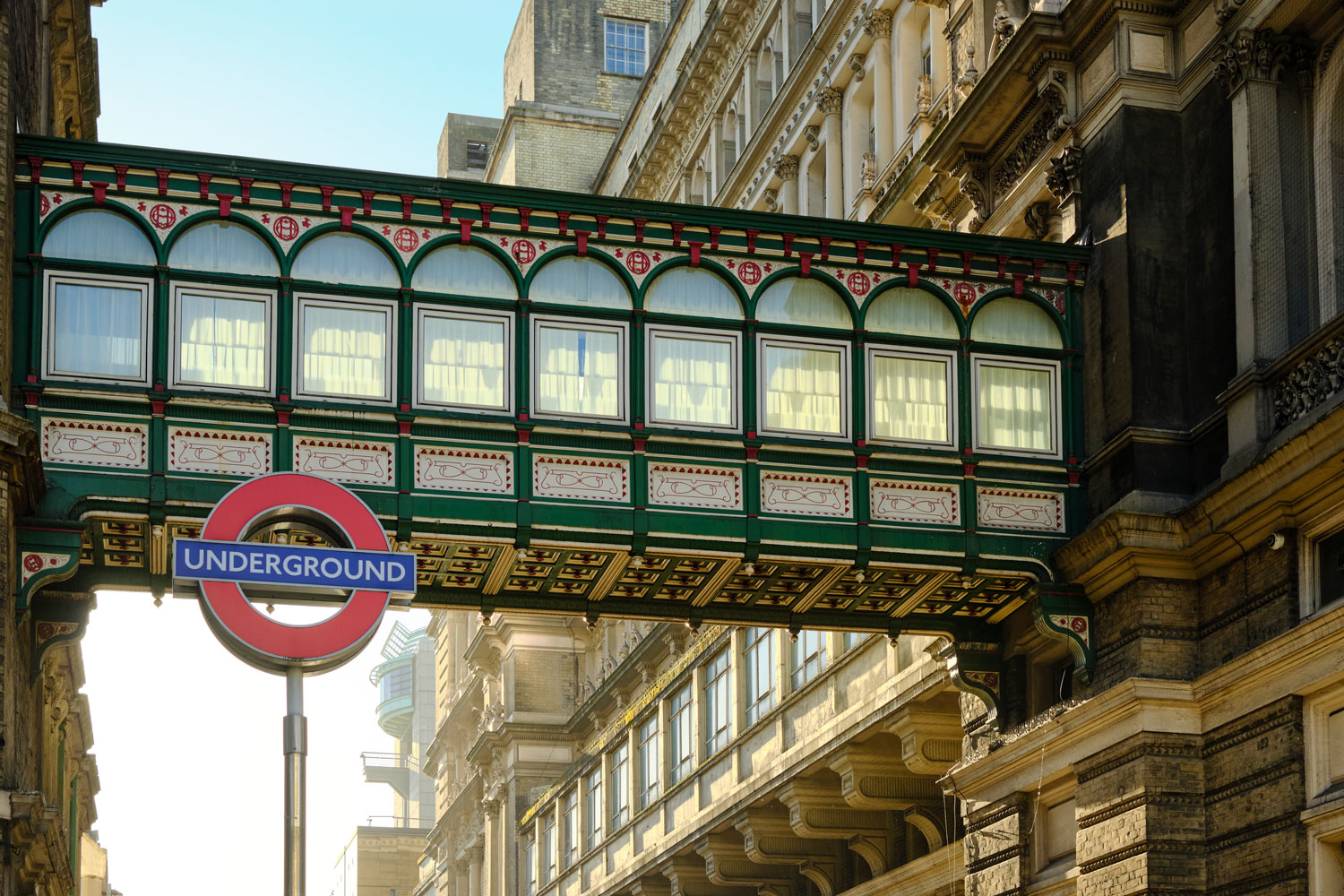
The hotel is home to a covered footbridge, built in 1878, that connects the original building on the western side with the newer addition to the east, and stretches over Villiers Street between Embankment and Strand. In addition, a small museum showcasing the history of the hotel can be enjoyed as part of the hotel stay.
On the first floor are a bar, the dining and breakfast room, and the two conservatories, now used for events. Breakfast here offers fine views of the Charing Cross monument. Traditionally this was the point from which all distances from London were measured. The original 13th‑century cross marked the bend in the Thames — from the Old English ċierring — with Westminster upstream and the City downstream. Destroyed under Cromwell’s Commonwealth, it was rebuilt after the Restoration of Charles II, now standing some 200 metres east of Trafalgar Square.
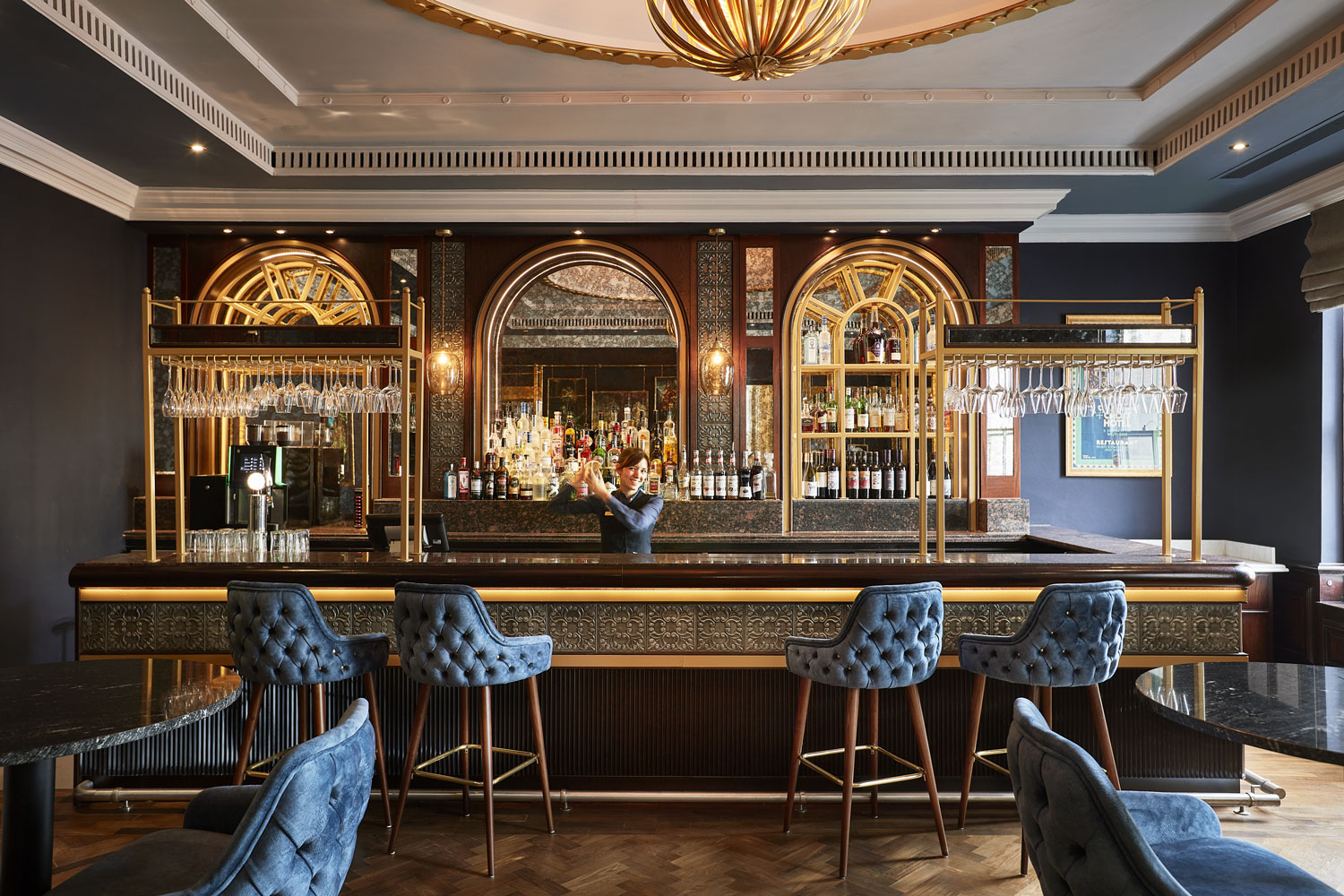
Originally built to house continental train travellers, the modern‑day Clermont Charing Cross has taken on a new role since its 2022 reopening and rebranding. It is a short walk to Trafalgar Square, the Houses of Parliament, and the West End theatres, and close to the National Gallery, National Portrait Gallery, and Royal Academy, as well as Leicester Square, home to UK film premieres.
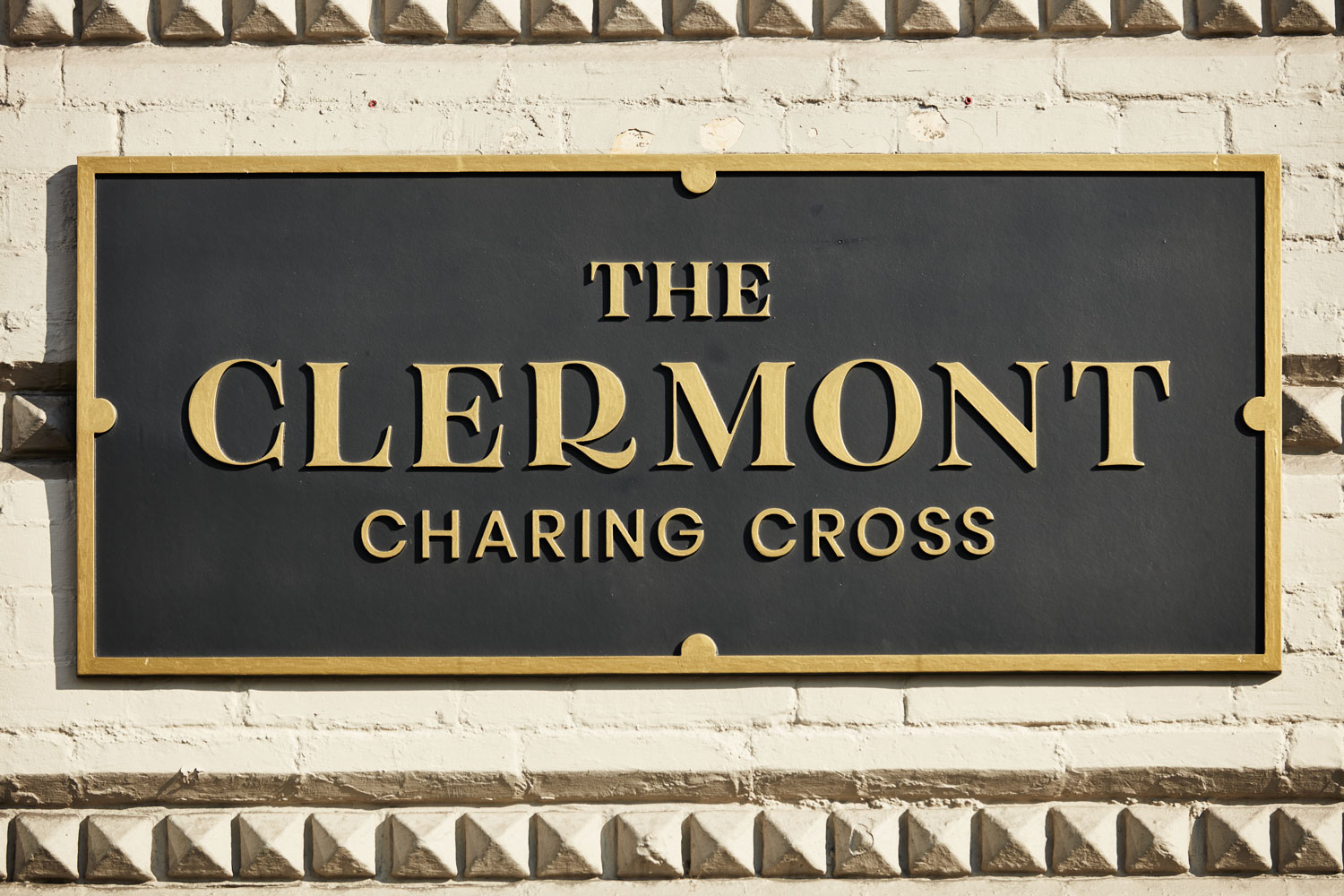 Built for one purpose, the Clermont Charing Cross now thrives with another.
Built for one purpose, the Clermont Charing Cross now thrives with another.
FAMOUSHOTELS HISTORY CHECK
The Clermont Charing Cross – History Presentation Review
Positives
-
History is clearly linked to the railway age and Victorian heritage. A small museum showcasing the history of the hotel can be enjoyed as part of the hotel stay.
-
Architectural highlights — Edward Middleton Barry’s design, the grand staircase, and ballroom — are mentioned.
-
Notable guests, including Sir Arthur Conan Doyle, add depth and prestige.
-
Anniversary celebrations and external press coverage reinforce its heritage value.
Negatives
-
No dedicated History page or visible history button in the main navigation — content is buried under blog or “About”.
-
No structured timeline of key events such as opening dates, expansions, or wartime repairs.
-
Lacks the fully branded heritage narrative expected at a Famous Hotels level.
-
Missed opportunity to feature archival photography and richer guest stories in the public presentation.
Archival material: Custard Communications, The Network Rail archive (The Network Rail archive is the custodian of a vast collection of historic documents and plans relating to today’s railway infrastructure)
First Influencers: Wanderlust in Watercolor
( words)
First Influencers: Wanderlust in Watercolor
By Andreas Augustin
Fernweh – Artists on the Road - on show at the Albertina Vienna (27 June – 24 August 2025)
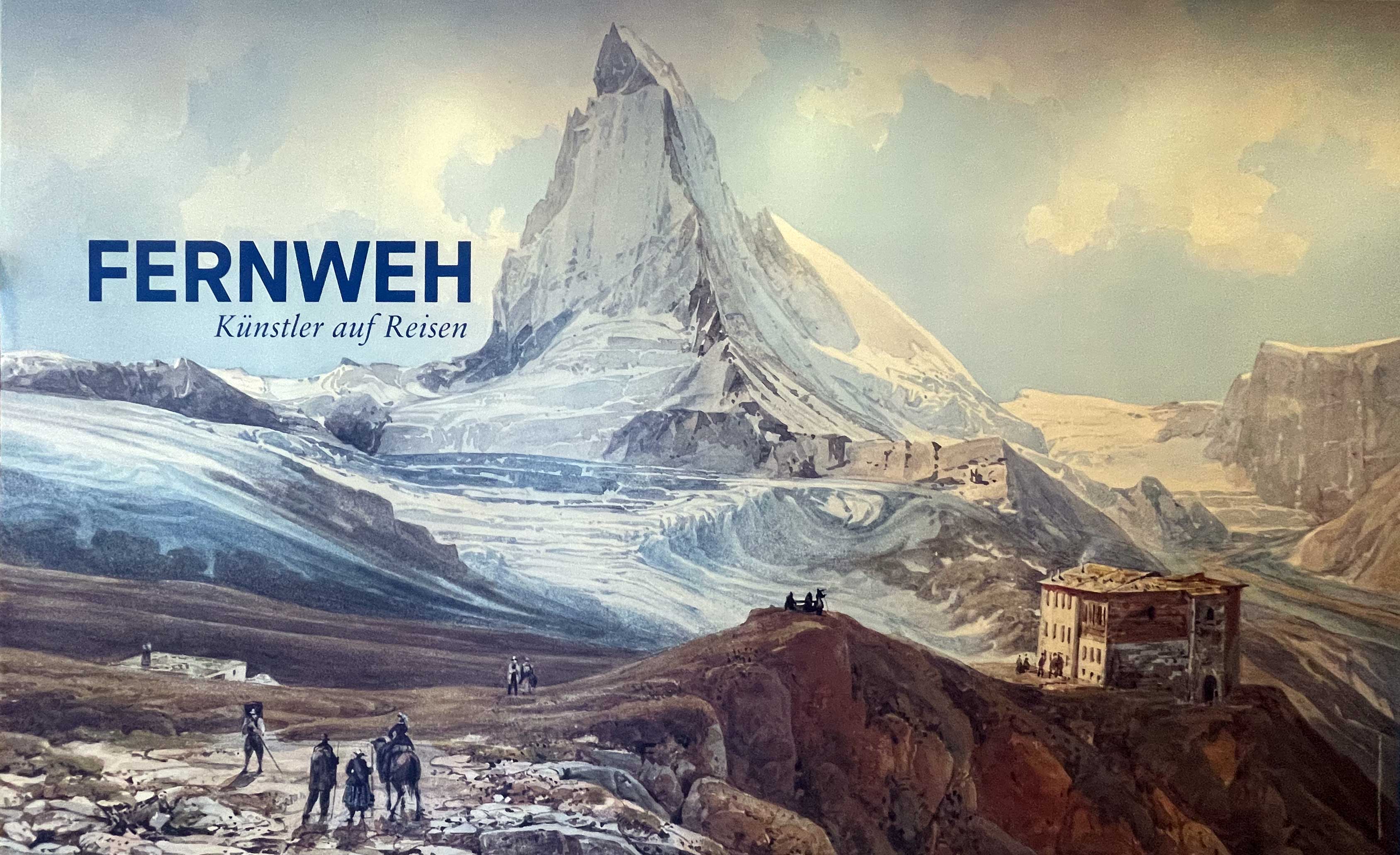 Artists were the world’s first influencers. Their travel journals, their sketches, their paintings awakened wanderlust. A scene captured in Rome, Florence, or the Alps—later exhibited in London, Paris, or Berlin—would etch itself into the minds of the onlookers. People longed to see the places behind the brushstrokes.
Artists were the world’s first influencers. Their travel journals, their sketches, their paintings awakened wanderlust. A scene captured in Rome, Florence, or the Alps—later exhibited in London, Paris, or Berlin—would etch itself into the minds of the onlookers. People longed to see the places behind the brushstrokes.
Writers joined them. Goethe’s Italian Journey, the sharp observations of Heine, the tales of Twain, Kipling, Conrad, Maugham—all stirred thousands to lace up their boots.
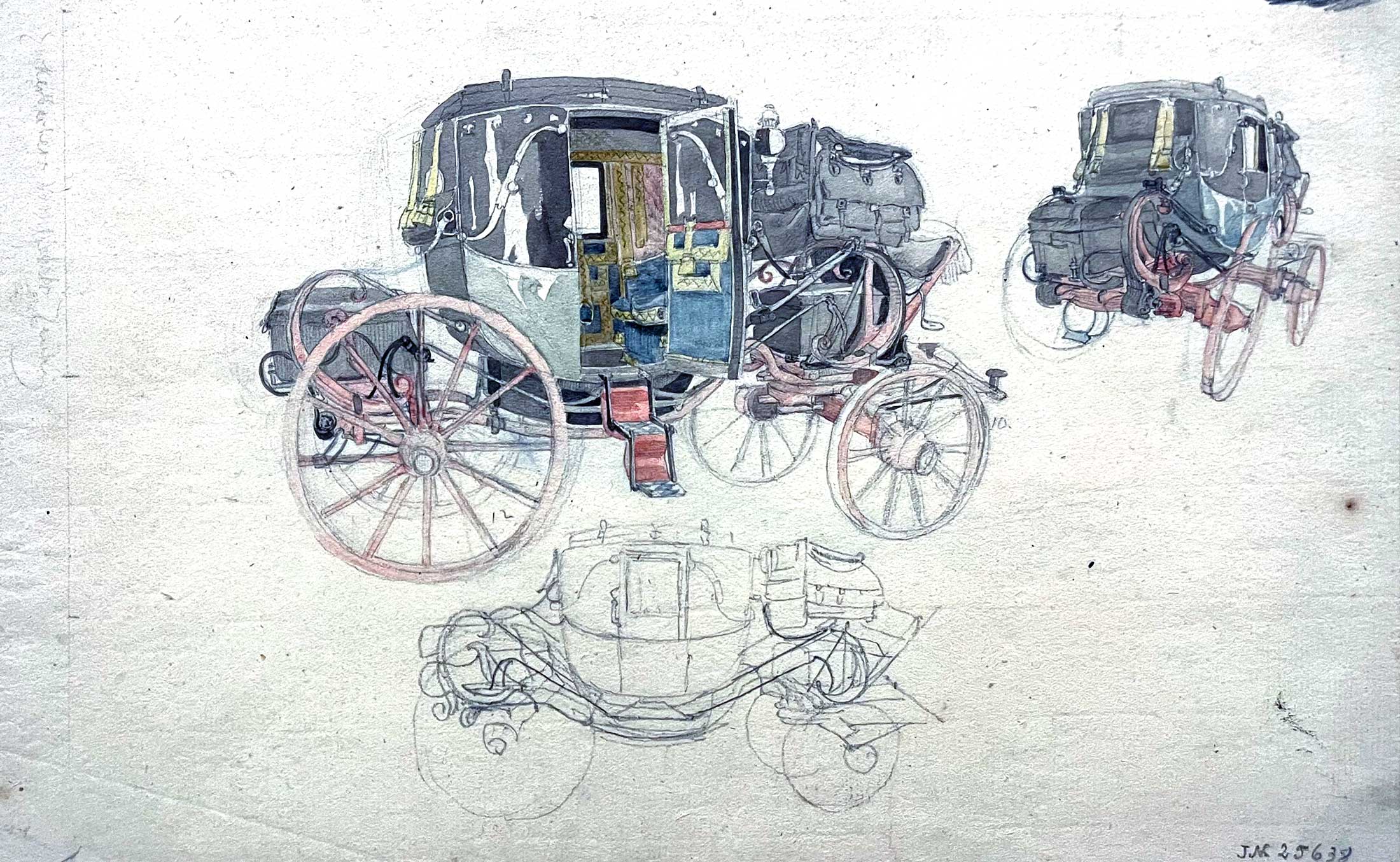
Detailed study of a post coach by Franz Partick Reinhold (1800–1872), watercolor and pencil on paper. Through an open door, we are offered a rare glimpse into the richly upholstered cabin—complete with travel blankets and storage compartments. Such drawings capture the elegance and complexity of 19th-century travel, when long-distance journeys were made in stages, through weather and wilderness, drawn by horses.
Now, the Albertina in Vienna, conveniently next to the Hotel Sacher (est. 1876), explores the early days of this phenomenon. Its exhibition Fernweh – Artists on the Road (27 June – 24 August 2025) shows 133 works from the museum’s collection. These are delicate watercolours and quick sketches and a rare collection of artists' original sketchbooks. Think of the Matterhorn from Gornergrat, painted by Thomas Ender in 1854. Or the Dachstein, captured by Rudolf von Alt. Or Goethe’s own watercolours from Sicily.
It is more than a collection of landscapes. It is a map of yearning that takes you around the globe.
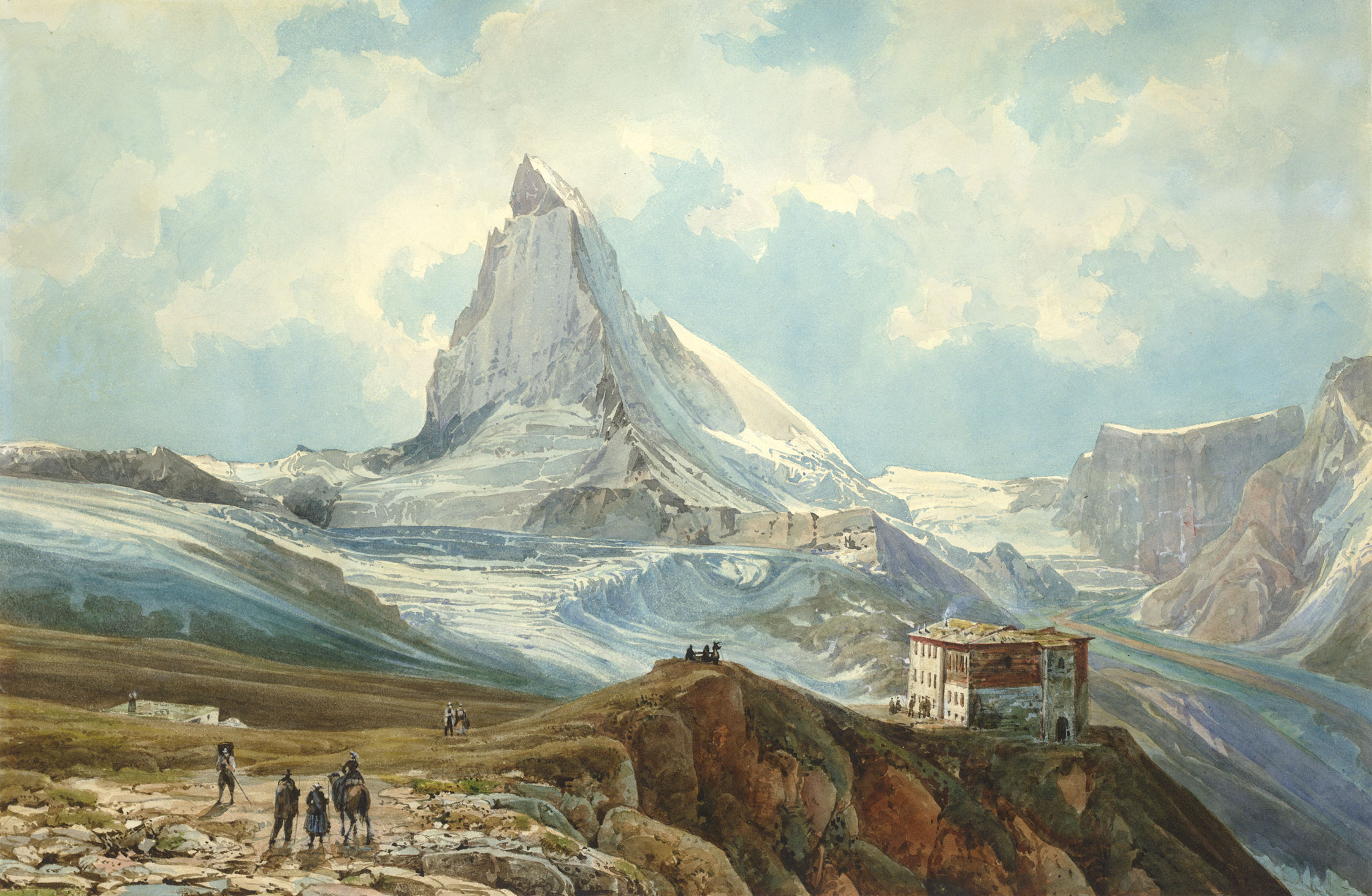
View of the Matterhorn, Switzerland. By Thomas Ender
This exhibition traces a journey from the era of the Grand Tour to the dawn of mountaineering—from Capri to the Salzkammergut. It reveals how the Alps, once considered hostile and grotesque, became symbols of grandeur. Paintings by Thomas Ender and Matthäus Loder chronicle this transformation—from wilderness to wonder.
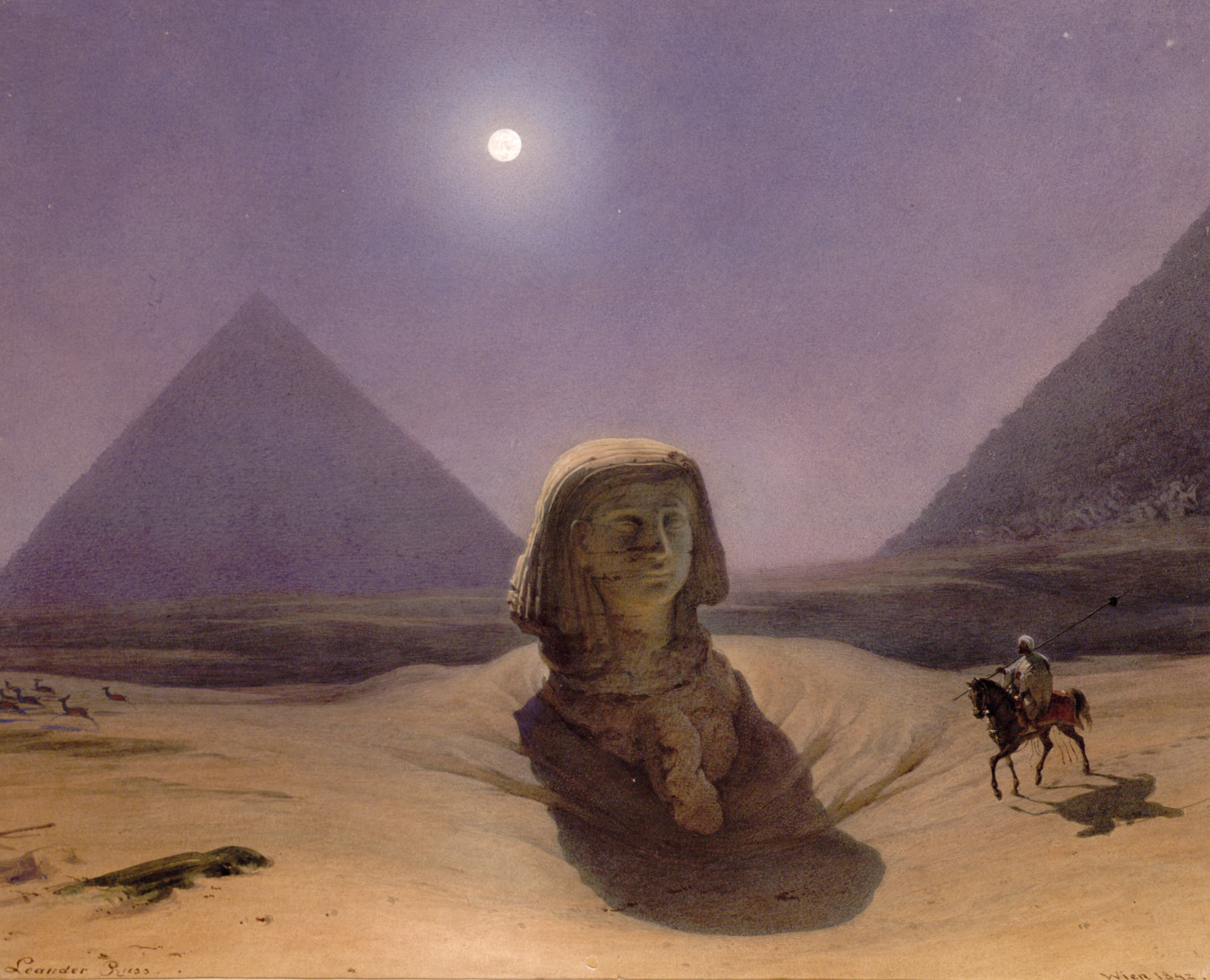
At the Pyramids, by Leander Russ
What moved me most were the works of the female painters: Tina Blau, Olga Wisinger-Florian, Emilie Mediz-Pelikan. Often denied formal education and commissions, they still produced art that endures.
For hoteliers, this exhibition is more than a historical glance. It is a mirror. It reminds us how people once travelled—why they travelled—and how they recorded their impressions. At a time when journeys were taxing, dangerous even, travel was a form of devotion. To explore was to seek truth.
Travel became art. And these early works—shared with the public for the first time in exhibitions—planted the seeds of tourism. If you work in hospitality, see this show. It tells us one thing: our craft is rooted in longing. And our task is to turn that longing into lasting memories.
Note on the Title Image:
„Goethe in the Roman Campagna“ was painted by Johann Heinrich Wilhelm Tischbein in 1787. It shows the poet during his Italian journey of 1786–88, later published in 1816–17. The original painting resides at the Städel Museum in Frankfurt.
But not here. The image shown with this article was generated today by AI. It reimagines Goethe in the Campagna—in modern dress, holding an iPad, surrounded by a changed landscape. A nod to Tischbein, yes—but unmistakably 2025. Neither painting is on view in Vienna. Only their spirit.
From the Left Bank with Love – Paris Iconic Hôtel Lutetia Joins the Mandarin Oriental Family
( words)
By Andreas Augustin
3 April 2025.
Spring has returned to Paris. Temperatures oscillate between 5 and 20°C. The city begins to blossom: chestnut trees lining the boulevards push forth their first buds, café terraces bustle with conversation, and the sidewalks once again welcome the unhurried pace of sun-chasers. On this day, amid the seasonal reawakening, the Hôtel Lutetia at the Rive Gauche – the only Palace-designated hotel on this side of the Seine in the heart of Saint-Germain-des-Prés — formally entered a new chapter in its already storied life—joining the Mandarin Oriental Hotel Group.
The Lutetia has long occupied a singular space in the Parisian hotel landscape—not merely as a luxury destination, but as a cultural institution. The Belle Époque hotel, completed in 1910 along Boulevard Raspail, owes its existence to the entrepreneur Aristide Boucicaut, owner of the elegant Le Bon Marché department store just across the street. Boucicaut envisioned a residence that would suit the lifestyle of his wealthy provincial clientele visiting Paris to shop. That luxurious life was short-lived: in 1914, the Lutetia was converted into a military hospital for wounded soldiers; during the Second World War, the hotel was requisitioned by the German occupying forces and used to house their military intelligence services. In 1945, it briefly became a sanctuary for Holocaust survivors—a plaque near the hotel entrance still commemorates this moment.
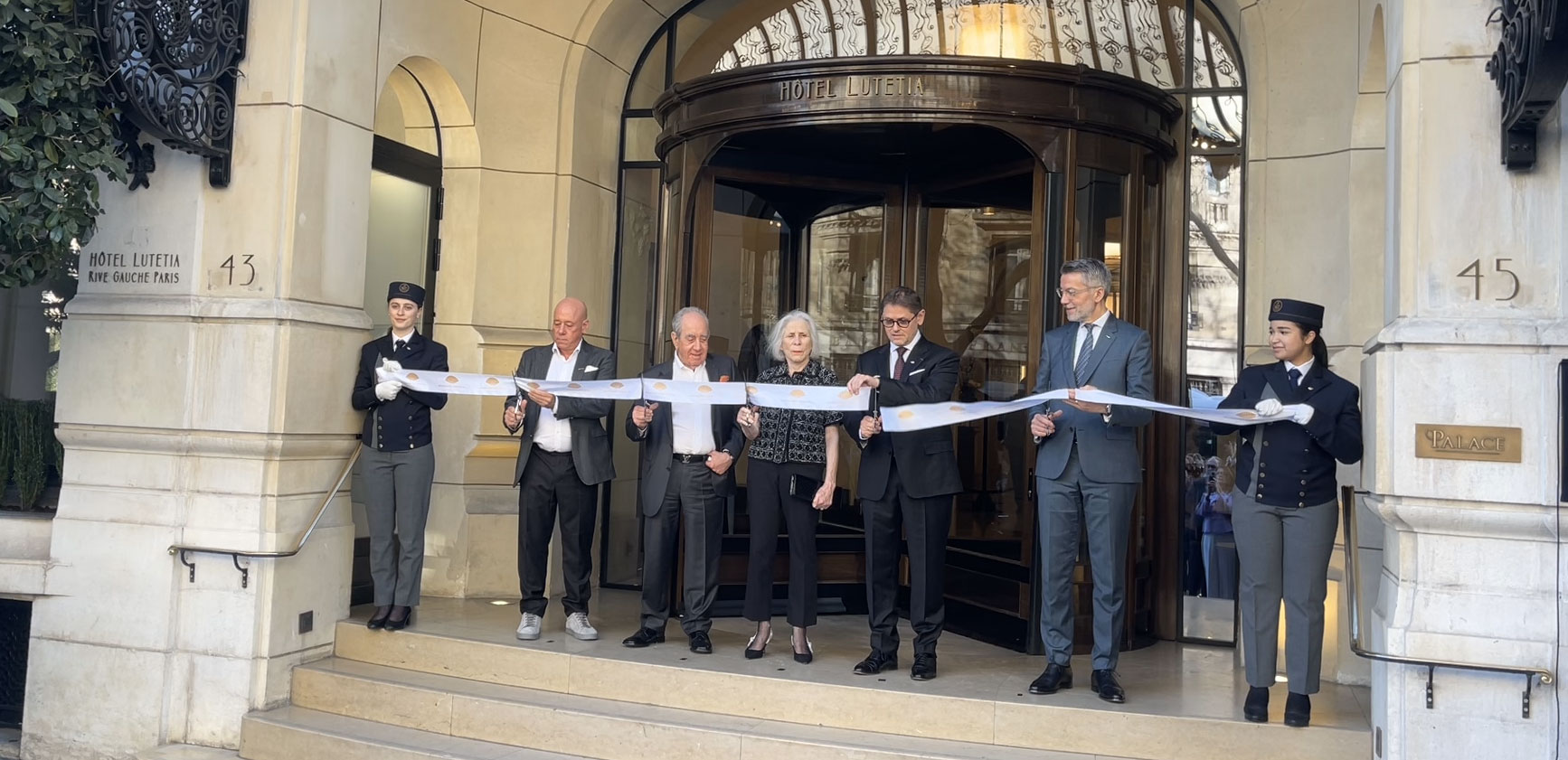 At the ribbon cutting: the Akirov family, Laurent Kleitman and Jean-Pierre Trévisan, General Manager of the Lutetia
At the ribbon cutting: the Akirov family, Laurent Kleitman and Jean-Pierre Trévisan, General Manager of the Lutetia
Back to the present. Present at the inauguration were the owning Akirov family, Laurent Kleitman, CEO of Mandarin Oriental, and COO Amanda Hyndman, who had just arrived from Hong Kong—an old friend from our collaboration at the Mandarin Oriental Bangkok, where we co-created the first coffee table book on the Oriental's history in our Edition Raconteur and established the permanent history exhibition The Oriental Journey together. Isn’t it remarkable how every historic hotel worth its name these days has carved out space for its own exhibition on hotel history—visible, professionally curated, and proudly in-house?
A site of intellectual gathering, political symbolism, and artistic resonance, the Lutetia now dons the livery of one of the most internationally revered hotel brands, and with that transformation comes a recalibration of identity. Jean-Pierre Trévisan, General Manager of the Lutetia, expressed candid optimism: the brand partnership, he noted, would offer visibility in markets previously unfamiliar to the hotel, particularly in Asia. Laurent Kleitman, a master of the well-turned speech, remarked in his stirring address that it is the human values which connect the Akirov family and the Mandarin Oriental Hotel Group.
To Mandarin Oriental’s credit, the hotel’s Parisian soul remains unbroken. The architectural and atmospheric language of the Left Bank persists: the jazz still flows in Bar Joséphine, the worn floorboards still whisper of literary ghosts. There is a deliberate preservation of place here. Slowly, the Asian signature that defines the Mandarin Oriental experience, will appear. In the scent of the hallways, in the gestures of hospitality, in the cadence of service. In its finest properties across Asia, the group delivers hospitality as ritual. In Paris, these signatures are less overt. Yet! Though subtle traces emerge: an exacting standard of attentiveness, a floral choreography of cherry blossoms, ranunculus, and flamingo lilies artfully arranged throughout the bar, and a remarkable culinary presence displayed in the precision of the hors d’oeuvres of the flying buffet. The potential for a deeper cultural layering remains tantalizingly just beneath the surface.
The coming months will slowly transform the Lutetia into a true Mandarin Oriental. A hint at the refined stand-up collar of an elegant Thai suit, the shimmering silk dresses of Siam. Maybe the gentle “Wai” of universal Thai greeting fame—now a global ambassador since the pandemic’s polite reshuffling of gestures. The air infused with the delicate scent of orchids, perhaps grown in the inner courtyard.
A whisper of the very enchantment that made the Mandarin Oriental in Bangkok the spiritual flagship of the entire group will change it all. Because here’s the thing: when someone walks into a Mandarin Oriental, they expect an Asian experience. Otherwise—why not just go to the Ritz?
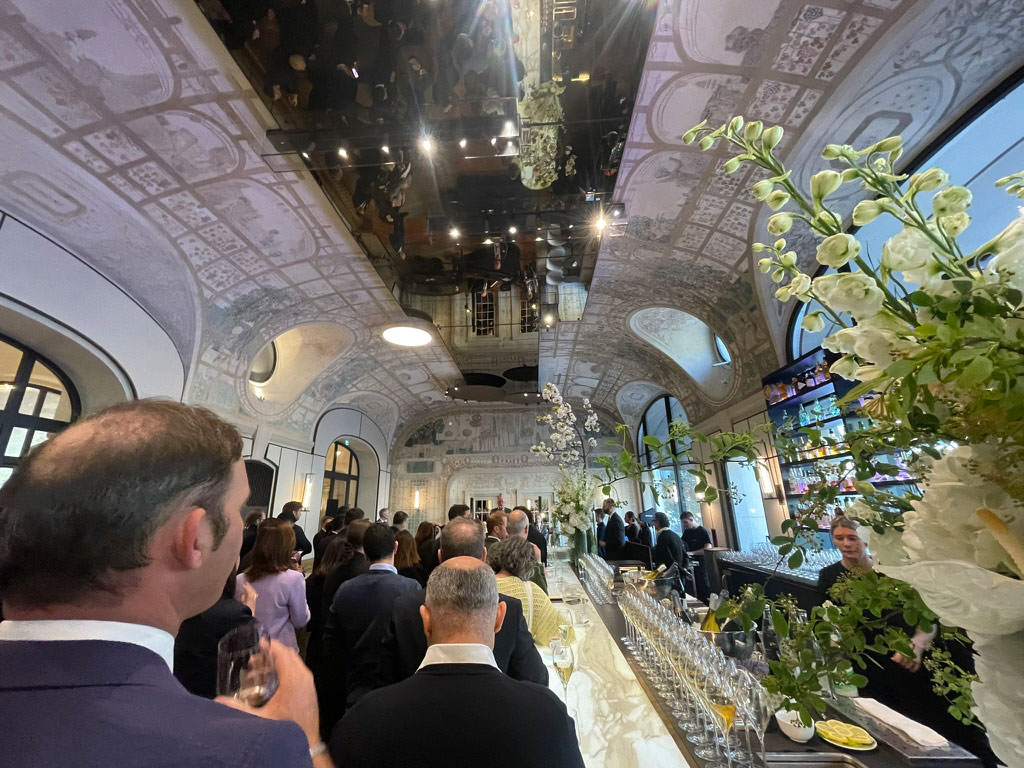
Bar Joséphine — a floral choreography of cherry blossoms, ranunculus, and flamingo lilies artfully arranged for the ceremony.
The hotel's physical and symbolic transformation over the past decade has been significant. The Palace distinction, conferred in 2019, affirmed the Lutetia’s elevated status, distinguishing it as the only such designated property on the Left Bank. This accolade followed an ambitious four-year renovation (2014–2018), overseen by architect Jean-Michel Wilmotte and financed by the Alrov group, which acquired the hotel in 2010 for €145 million. The restoration, reportedly costing €200 million, revived original frescos and stucco, while reimagining 184 rooms and suites in an aesthetic of restrained elegance. A selection of these suites pays tribute to personalities such as Francis Ford Coppola and Isabelle Huppert, whose presence echoes the intellectual tone of the neighborhood.
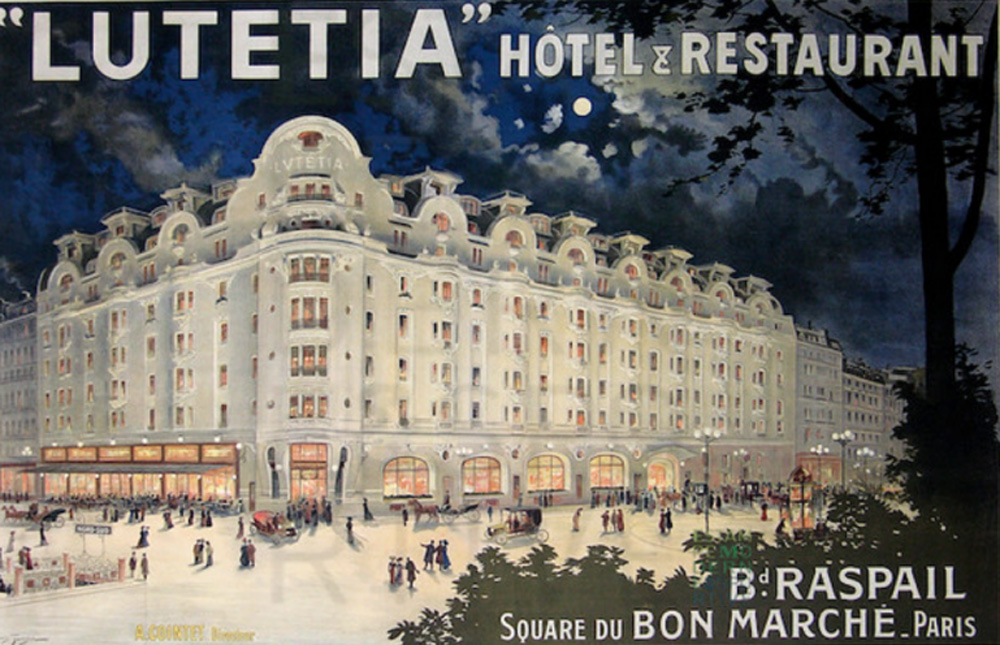
The building rises majestically onto the boulevard. The corner tower, with its large rounded façade, gazes like the head of a cobra toward the Square du Bon Marché. Here stands a truly exceptional grand hotel — a magnificent edifice from the early 20th century. Opened in 1910, the Lutetia's founding connection to the oldest and most luxurious department store of the country – Le Bon Marché, established by the Boucicaut family in 1910, endures as both legacy and active collaboration.
The media continues to dwell—somewhat wearily—on the Lutetia’s complex wartime legacy, particularly its role during the German occupation. However, more compelling perhaps is its post-liberation moment: in 1944, General de Gaulle requisitioned the hotel to accommodate thousands of returning deportees. Archival images from Agence France-Presse document emaciated survivors dining in the hotel's restaurant in May 1945, and others consulting bulletin boards listing repatriated names. And by the way, isn’t it time we talk about this recurring theme? No grand Parisian hotel without its Wehrmacht chapter, no wine cellar that wasn’t allegedly walled up to protect vintage treasures from the Nazis. National pride, it seems, lies in denying the enemy access to the Bordeaux.

Jiasheng Wan, the hotel’s chef sommelier
Of the vintage bottles and the men who once knew them, none have survived the years. Today, the Lutetia’s ultra modern and elegant cellar holds some 20,000 bottles. The wine list spans 40 pages of selections. The original vaulted cellars from the early 20th century are under Jiasheng Wan, the hotel’s chef sommelier, who explains: „A 1997 Auxey-Duresses 1er Cru is our oldest wine.“ In-Cellar wine tastings are reserved for the in-residence clientele of the house. Wan: “Our most expensive wine is a Petrus 2014 at €7,800. I’m working on getting a Romanée-Conti.” The perennial bestseller, as expected, is the Chablis Village by the glass.
Famous Partons or: How Legends Are Constructed and How Songs Become Testimonies
There is a story that circulates, whispered with a certain Left Bank reverence: James Joyce wrote parts of Ulysses at the Hôtel Lutetia. It sounds beautiful. Almost believable. The address fits, the aura fits, the timeline—more or less—could be made to fit. And yet, it isn't true. Not quite. Joyce did complete Ulysses in Paris. He lived on the Rive Gauche, not far from the Lutetia. He passed its doors, perhaps even sat there briefly. But no credible record—no letter, no note, no eyewitness—places him writing at that hotel. Still, the idea persists. Because it is convenient. Because it flatters both hotel and guest. Because it gives us something to sip with our Bordeaux.
It is said that Serge Gainsbourg’s nocturnal wanderings were immortalized in Eddy Mitchell’s smoky ballad Au bar du Lutetia. It sounds perfectly plausible. The bar, the mood, the man. One imagines him slouched in a velvet banquette, murmuring something indecent over a Gauloise and a glass of bourbon. But the song never mentions him. Au bar du Lutetia conjures ghosts, yes—but none are named Serge. No factual record ties Gainsbourg to that bar in song. Still, the myth survives. Because it fits. Because Paris runs on the fumes of poetic association. Because sometimes, legend walks in after closing time, orders a drink, and never really leaves.
And so we arrive at the Bar Josephine. A name that sounds, to the critical ear, almost too perfect. One could have doubts. One might suspect branding dressed as memory. But in this case, the myth meets the woman. The Bar Josephine—lavish, theatrical, Left Bank to the bone—is rightfully named. Josephine Baker was here. Often. Elegantly. In the years after World War II, when she returned not only as a star, but as a war hero, France’s adopted daughter.
The Lutetia welcomed her, like so many others who had helped liberate the country—and in doing so, elevated its own story. Charles de Gaulle, however, did make history within its walls, spending his wedding night at the Lutetia on April 7, 1921, long before his rise to the presidency. Samuel Beckett, Gertrude Stein, Charlie Chaplin, Henri Matisse were all among its distinguished guests. Over the years, Pablo Picasso, Isadora Duncan, Peggy Guggenheim, and François Truffaut also contributed to the rich cultural tapestry that defines the hotel’s legacy.
Because not every legend is invention. Some are tributes.
And some stories are true. Take Juliette Gréco, for instance—the legendary chanteuse and muse of the existentialists, so intimately connected with the Lutetia. She was reportedly close to tears when, in April 2014, she bid farewell to the hotel before its renovation.
Today, the hotel’s gaze is fixed forward. For the Lutetia history I recommend to visit https://famoushotels.org/hotels/lutetia
And then there’s the pool. It was, after all, legendary — for over a hundred years a social meeting place for Paris’s refined bathers. Today, it has become an elegant spa where only hotel guests can relax, undisturbed by the ordinary bustle of the boulevard. Because, among the most distinguished additions in the recent renovation is the exclusive spa, all facilities including its 17m pool strictly reserved for in-house guests.
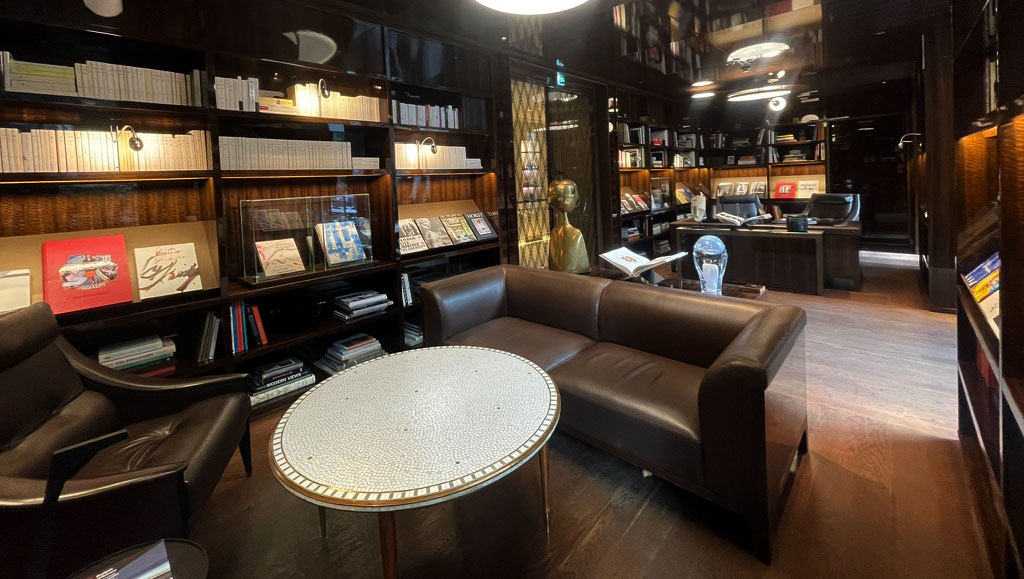 Not to forget a particularly exquisite creation: the hotel library. More than a functional reading room, it is a design statement—a tactile celebration of the printed word. Curated under architect Wilmotte’s direction, it houses 2,000 volumes reflecting the hotel's own history and its surrounding arrondissement. Yuval Noah Harari, author of Nexus: A Brief History of Information Networks, was recently interviewed there by multiple international television outlets. It is not difficult to see why; the space is a sanctuary of substance.
Not to forget a particularly exquisite creation: the hotel library. More than a functional reading room, it is a design statement—a tactile celebration of the printed word. Curated under architect Wilmotte’s direction, it houses 2,000 volumes reflecting the hotel's own history and its surrounding arrondissement. Yuval Noah Harari, author of Nexus: A Brief History of Information Networks, was recently interviewed there by multiple international television outlets. It is not difficult to see why; the space is a sanctuary of substance.
Privacy, of course, is part of the proposition. With entry-level room rates beginning at €1,500 per night, the Lutetia ensures a deliberate exclusion of the merely curious. This hotel, like many of its calibre, functions as a cultural microclimate—exclusive and immersive. And yet, the ground floor remains in the hands of the Parisian intelligentsia—here, one is human, here, one is allowed to be.
Situated in the heart of Saint-Germain-des-Prés, it is part of the area's vibrant history of artists, philosophers, and writers. Myriam Munnick, Executive Commercial Director, explains: The hotel has always been at the center of this intellectual hub, and we embrace that heritage, offering our guests an immersive experience that reflects the essence of the Left Bank. We are proud to be part of this artistic community and ensure that our offerings align with the creative spirit that defines this area.
The property’s cultural programming remains dynamic. Art and music are integral to its identity. Recent initiatives include a comic-style cocktail menu at Bar Joséphine by Serge Clair—an homage to the visual languages of the 20th century—as well as a photography exhibition by Philippe Carly. The hotel also features permanent works by prominent artists such as Arman, known for his striking sculptures and assemblages; César, a leading figure of the Nouveau Réalisme movement famed for his compressed sculptural forms; Philippe Hiquily, celebrated for his surrealist metal structures; and Mikhaïl Chemiakine, whose expressive pieces often engage with complex social themes. French painter Thierry Bisch has held a permanent artist-in-residence position at the Lutetia.
Strategically, Munnick explains, the future is global: "The hotel is expanding its commercial gaze toward Asia, the Middle East, and the MICE markets of North America. The ambition is to increase occupancy by 10% over the next year."
If Mandarin Oriental can truly weave its deeper brand ethos into the very fabric of the Lutetia, it may well succeed in creating something remarkable. Time will show.
This was no fairy tale wedding
Lutetia and Mandarin Oriental. No princess awakened by a prince. What we’ve witnessed is more akin to two royal houses joining forces, merging their legacies to chart a shared future. At present, the Lutetia is a compelling hybrid—still steeped in Parisian gravitas, now with a whisper of globalism. Mandarin Oriental, meanwhile, is on a shopping spree around the globe. With 42 hotels already in its portfolio—and more to come—one might wonder how many of the world’s great addresses are still left on the market.
At Paris, the Left Bank, adventurous as ever, awaits its next chapter.
Quick Facts
• Rooms and Suites: 184 total, including 47 suites
• Restaurants and Bars: 3 — Brasserie Lutetia, Bar Joséphine, and Bar Aristide
• Spa: Akasha Holistic Wellbeing Centre, exclusively for guests, includes a 17-meter pool, sauna, steam room, fitness area, and six treatment rooms
• Library: 2,000 curated volumes, conceptualized by architect Jean-Michel Wilmotte
• General Manager: Jean-Pierre Trévisan
• Address: 45 Boulevard Raspail, 75006 Paris, France
Famous Hotels Awarded!
( words)
Washington, DC, – Historic Hotels Worldwide® is pleased to announce that the Austrian Hotel Historians Andreas and Carola Augustin have been named the recipients of the Historic Hotels Worldwide® Historian of the Year Award.
“We are honored to recognize Andreas and Carola Augustin for their numerous accomplishments over nearly four decades of academic and scholarly research of the histories of more than four hundred legendary grand hotels,” said Lawrence Horwitz, Executive Vice President Historic Hotels of America and Historic Hotels Worldwide. “They have created the finest library of the stories of hospitality and many of the most famous hotels around the world. They have curated various of the noteworthy “Path of History” permanent exhibitions at famous historic hotels. We have inducted many of the hotels into Historic Hotels Worldwide that have documented histories researched and written by Andreas and Carola Augustin. Their collective work has resulted in the increased awareness and appreciation of the historic significance of these hotels.”
For over 35 years, Andreas and Carola Augustin have used their expertise as researchers and writers to record and make available the histories of the world’s most-famous hotels. The Augustins emphasize historical accuracy. Their research – always uncovering startling new evidence – aims to go beyond superficial exploration to separate fact from fiction.
Together, the Augustins have researched and written over 70 books, translated into eight languages, contribute their historical expertise to TV documentaries, manage the public website famoushotels.org as a hotel history resource, and curate hotel history exhibits. Their Path of History permanent exhibitions have become fixtures in some of the most legendary hotels around the world. Together, the couple has researched and documented the histories of over 450 hotels—representing nearly 100 countries.
Andreas and Carola were completely surprised! "This award, after nearly 40 years of voluntary work, is a full validation for us. We are deeply grateful and truly overjoyed. We share this joy with the many wonderful hoteliers who have collaborated with us. A special thanks goes to our team, whose support has been integral to our success. Our children have also been wonderful supporters, discovering hidden treasures in archives more than once. Above all, we must thank our readers, who cherish our books, collect them, and hold them in such high esteem."
Deeply indebted!
The non-profit organisation The Most Famous Hotels in the World was founded in 1986 when Andreas recognised that many historic hotels were in danger of losing valuable historical records. Leading experts such as the late Stanley Turkel—recipient of the Historic Hotels of America® Historian of the Year Award in 2014, 2015, and 2020—were invaluable. Authors and historians have contributed, with special thanks extended to Andy Williamson, Laura Kolbe, Zhang Guangrui, Aruna Dhir, Thomas Cane, Larissa Fortak, Guillermo Reparaz, Roddy Martine, the late Raymond Flower, Marcello La Speranza, Rahel Jung, Adrian Mourby, the late Cherry Chappell, the late Kurt Grobecker, and so many other renowned travel writers who regularly enrich the library on famoushotels.org. World-renowned photographers such as Michelle Chaplow, Heimo Aga, Holger Leue, Bill Lorenz, and others lend famoushotels history books a contemporary yet classic appeal. Artists like Manfred Markowski, Peter Baldinger and Geoffrey Baeverstock have created some fantastic cover paintings. (see THE TEAM)
The Augustins are currently preparing the histories of two iconic Raffles hotels—Le Royal in Phnom Penh and the Grand Hotel d’Angkor in Cambodia—as well as the Galle Face Hotel in Colombo, Sri Lanka (1864). Recently appeared a history of Half Moon resort in Jamaica and a book about one of the oldest grand hotels of Europe, Mandarin Oriental Savoy Zurich (1838). In the past years the Augustins visited the war-torn city of Lviv, Ukraine. Despite Russian air attacks, they conducted extensive research into the 1894-opened Grand Hotel, with the help of local historians.
Carola met Andreas in 1986, the year he founded The Most Famous Hotels in The World, and they bonded over their shared passions for travel and hotel histories. Andreas brings his background in journalism and hospitality to the partnership, while Carola, who has a master's degree in history, applies her trained eye to the research. They married in 1989 and have two children.
“She rallies words of encouragement when I am on the verge of despair, unable to find new material. For hours she sits in dark archives, unearthing incredible results. Often, it is the obvious details that escape a casual observer, but her sharp eye catches them,” Andreas Augustin said of his wife and partner. “It is particularly exciting how we keep uncovering new discoveries about these hotels, which we include in each new edition of our books.”
Their goal in all of this is to leave behind a reliable and comprehensive library of hospitality history, safeguarding this knowledge for future generations.
The 2024 Historic Hotels Worldwide® Historian of the Year Award was presented to the Augustins on Thursday, November 21, 2024, at the 2024 Historic Hotels Annual Awards of Excellence Ceremony & Gala, in front of an audience of owners, general managers, senior decision-makers, and guests representing many of the finest historic hotels from around the world. The 2024 Historic Hotels Annual Awards of Excellence Ceremony & Gala took place at The Omni Homestead Resort (1766) in Hot Springs, Virginia, USA. The Omni Homestead Resort was inducted into Historic Hotels of America® as a Charter Member in 1989 and was designated a National Historic Landmark by the U.S. Secretary of the Interior.
About Historic Hotels Worldwide®
Historic Hotels Worldwide®, an official program of the National Trust for Historic Preservation (in the USA), is a prestigious and distinctive collection of historic treasures, including luxury historic hotels built in former castles, chateaus, palaces, academies, haciendas, villas, monasteries, and other historic lodging spanning ten centuries. Historic Hotels Worldwide represents the finest and most distinctive global collection of more than 320 historic hotels in forty-nine countries. Hotels inducted into Historic Hotels Worldwide are authentic historic treasures, demonstrate historic preservation, and celebrate historic significance. Eligibility for induction into Historic Hotels Worldwide is limited to those distinctive historic hotels that adhere to the following criteria: minimum age for the building is 75 years or older; historically relevant as a significant location within a historic district, historically significant landmark, place of a historic event, former home of a famous person, or historic city center; hotel celebrates its history by showcasing memorabilia, artwork, photography, and other examples of its historic significance; recognized by national preservation or heritage buildings organization or located within UNESCO World Heritage Site; and presently used as a historic hotel. For more information, please visit HistoricHotelsWorldwide.com. Historic Hotels Worldwide is affiliated with Historic Hotels of America, a program of the National Trust for Historic Preservation for increasing the recognition of the finest historic hotels in the United States.
Kempinski, Hoteliers since ... when?
( words)
Research in progress / comments welcome
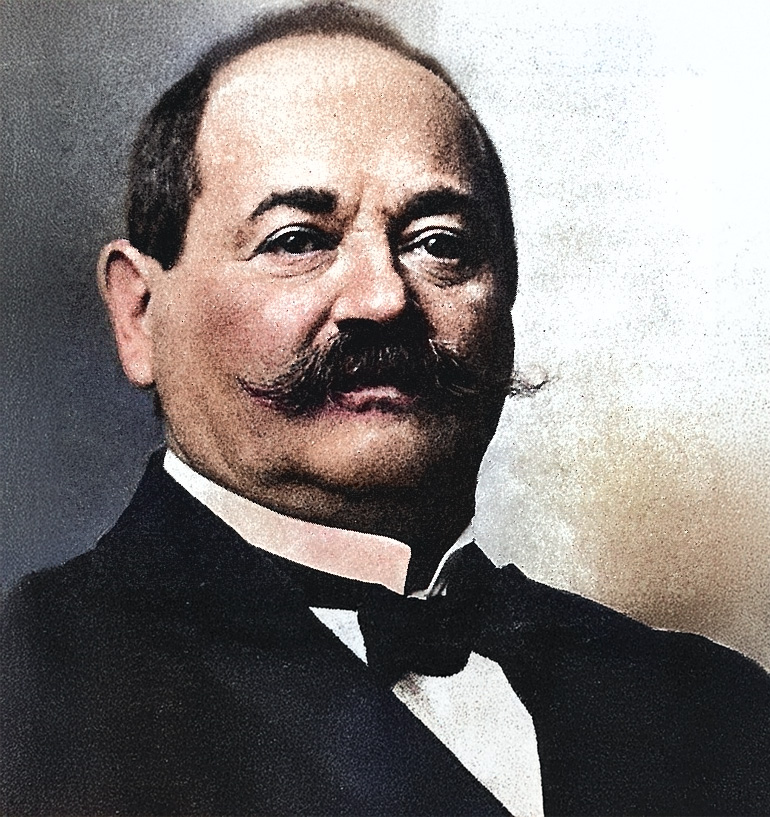 Berthold Kempinski, wine merchant, restaurant owner and entrepreneur, died in 1910, long before his company was “Aryanized” by the Nazis in 1937. In the 1970s, his name was adopted by a Berlin based Hotelbetriebs AG, which has since operated as Kempinski Hotels, managing numerous luxury hotels worldwide. A proof that the Kempinskis are hoteliers since the 19th century is missing.
Berthold Kempinski, wine merchant, restaurant owner and entrepreneur, died in 1910, long before his company was “Aryanized” by the Nazis in 1937. In the 1970s, his name was adopted by a Berlin based Hotelbetriebs AG, which has since operated as Kempinski Hotels, managing numerous luxury hotels worldwide. A proof that the Kempinskis are hoteliers since the 19th century is missing.
Kempinski was a host, not a Hotelier!
At The Most Famous Hotels in the World, we cheer every time a hotel flies its history like a banner. Just make sure it’s not upside down.
The use of the small tagline "Hoteliers since 1897" under the Kempinski logo is causing controversy. What is the famous former flagship of German hospitality doing, and why? In reality, the Kempinskis — owners of various Berlin restaurants — were never hoteliers. After over 50 yeares of successfully operating various restaurants and a wine trade, being Jewish, they were expropriated, persecuted, and murdered by the Nazi regime. Today, the Kempinski hotel group claims to prove that they have been "hoteliers since 1897," but this information lacks any historical basis. Here are the facts:
The Wine Tavern:
The Kempinski era began with a determined Jew named Bertold Kempinski from Breslau (now in western Poland), who set out to conquer the soul of the capital of the German Empire, Berlin. And he had a hunch that this soul lay in the stomach. Around 1870, he opened a wine shop at Friedrichstraße 178, which was officially registered in the commercial register in 1872. The wine tavern, operated with his wife Helen, proved to be a lucrative source of income providing the Kempinskis with capital. The place soon became too small and having achieved a secure level of prosperity they bought real estate at Leipziger Strasse.
The "Weinhaus Kempinski" soon became an institution. But we must not imagine it as a modest tavern—it had a distinct social character, lively and popular in every respect. At the height of the Bertold Kempinski era, the press celebrated:
"7,200 guests and 20,000 oysters daily—caviar for the people—wine cellars—bakery and laundry—hygienic facilities—not a single table empty!"
Despite this success, Kempinski and his wife Helen remained grounded. Alongside roasts and sausages, they served oysters, crabs, caviar, woodcocks, even lapwing eggs—affordable for everyone. It gets even more astonishing: for his scattered wine cellars across Berlin, he paid an annual rent of 30,000 marks. He ran his own bakery and laundry, a facility for silver-plating tableware, and a porcelain painting workshop where plain factory-purchased porcelain was decorated and glasses were adorned with gold rims.
On peak days, the bakery produced up to 17,000 bread rolls, while the laundry processed up to 20,000 freshly washed and ironed napkins. These did not only supply his own restaurant but also many other establishments, which—an innovation at the time—rented table linens. A bottle-washing facility cleaned 10,000 bottles daily, and a dedicated waste incineration plant was installed.
From a social perspective, Kempinski must also be highlighted: he maintained an emergency accident and medical station. The common practice of reusing food scraps was eliminated by the principle that once food left the kitchen, it was not allowed to return. Some kitchen waste was turned into soap, some was used as animal feed, and some was sold to chemical factories, bringing in an additional 20,000 marks annually.
He is said to have once joked: "You will find the president of the Reichstag and deputies from all parties here, just as you will find a young man dipping into his pocket money. But one thing you will never find: an empty table."
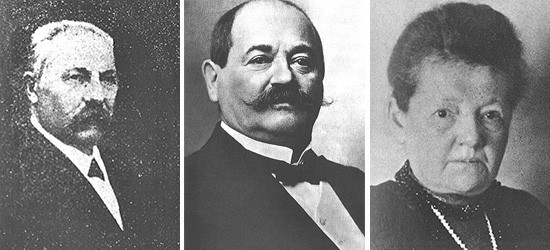
Moritz Kempinski (1835-1910); his younger brother, Bertold (1843-1910) and wife Helen Kempinski.
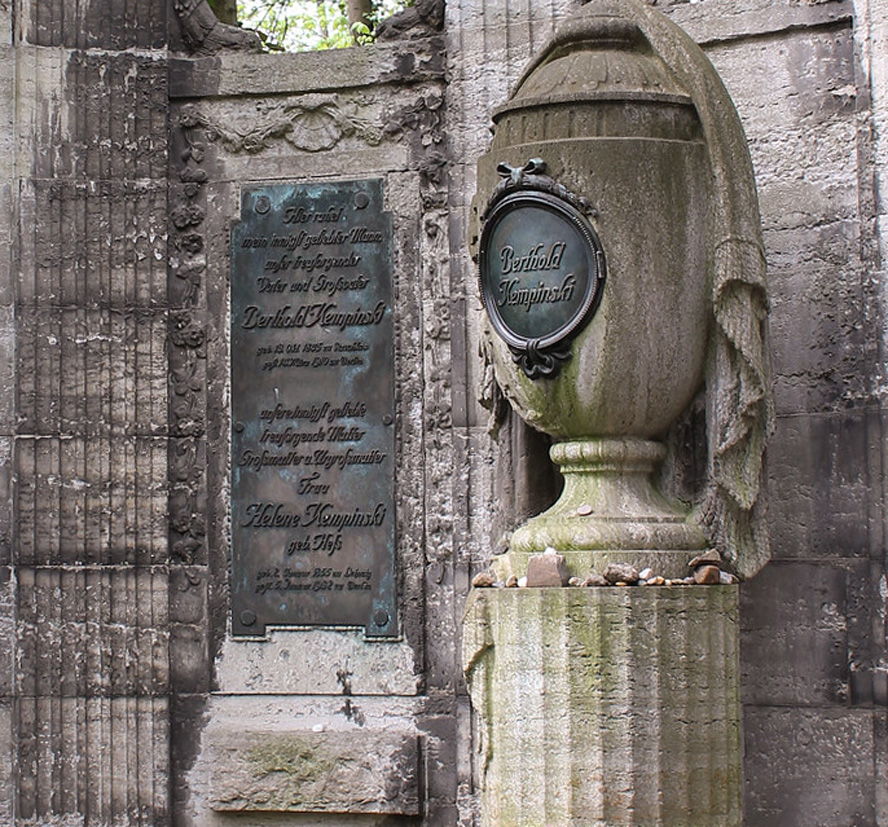
Berthold Kempinski's honorary grave is located in Field T2 at the Jewish Cemetery in Berlin-Weißensee.
The Unger Era:
The Kempinskis had no male heir. For this reason, their son-in-law, Richard Unger, the husband of their daughter Frieda, and a nephew, Hans Kempinski, joined the company. The artistically inclined Hans was a passionate painter, but Unger proved to be a skilled businessman. Bertold Kempinski retired, enjoying his well-earned rest, and passed away in 1910. By the time of the First World War (1914–1918), Unger, who now owned the business, had managed to build a respectable real estate complex around the company. He expanded it into a large-scale gastronomic enterprise.
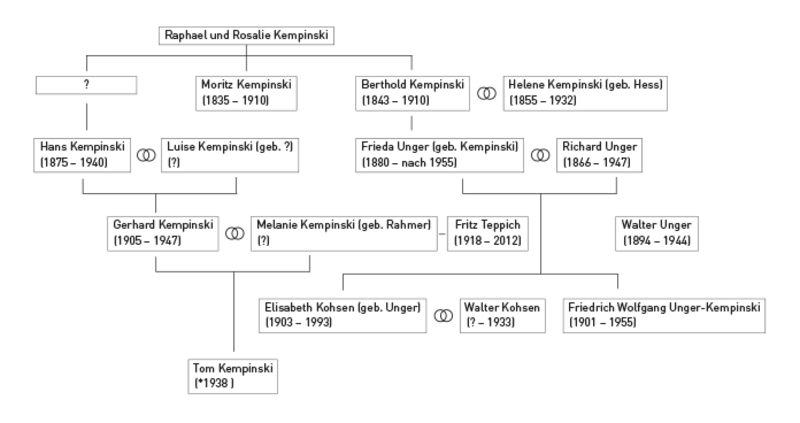
Kempinski family tree
Ku’damm 27
As the area around Kurfürstendamm grew increasingly popular, Unger purchased and operated a restaurant at Ku’damm 27 (Kurfürstendamm 27). In 1928, he took over the management of Haus Vaterland at Potsdamer Platz and introduced a groundbreaking new restaurant concept—an entertainment dining experience unlike anything Berlin had ever seen.
Spread across four floors, exquisite delicacies were served, complemented by artistic performances. Kempinski became renowned far beyond Berlin, much like Sacher for Vienna or Sprüngli for Zurich—his name became a synonym for fine dining. When the Great Depression reached Germany in December 1929, the lavish oyster selection at Kempinski was still praised, offering guests a way to pass the time before the promised Porterhouse steak for five to six people arrived within 30 minutes, as stated on the menu.
However, it is important to note: despite its fame and scale, Kempinski was still only a restaurant—not a hotel! In 1932, Unger made an excursion into the hotel business by operating Schloss Marquardt near Potsdam. In 1932, the family leased and operated Schloss Marquardt as a hotel, but it did not carry the Kempinski name. It was simply a property managed by the family—an early and singular step into hospitality, without branding it as such. It was a brief chapter in an otherwise culinary-focused history. The hotel was not called “Kempinski.” The true rise of Kempinski as a hotel brand came two decades later.
Nazi Regime:
During the Nazi regime and World War 2 (1930s–1945) the jewish Kempinski business under Unger came to an abrupt halt. Richard Unger and his wife emigrated to the United States. Under the pressure of the anti-jewish racial laws, the Kempinski enterprise was in fact stolen by the German Reich, which constituted a typical act of 'aryanization', as these acts of expropriation were called. Walter Unger, son of Richard, had remained in Germany to continue the business. Eventually, he had been forced to transfer the shares of his family's company to a company called Aschinger AG, all this in exchange for his own life. After the deal was executed, Walter Unger was murdered at the concentration camp Auschwitz. Even the jewish name Kempinski was no longer accepted by the regime. The restaurant(s) were renamed F.W. Borchard.
After World War 2:
After 1945 (end of World War 2), Bertold Kempinski's grand son Friedrich W. Unger had been able to restitute the location of Kurfürstendamm 27 from the Aschinger company who had bought it for a ridiculous low sum it in 1937.
Hotel rooms were scarce after the war. Supported by the Marshall Plan, the construction of a hotel was approved. In February 1951, in the presence of Berlin's Governing Mayor, Dr. Walther Schreiber, the foundation stone for a hotel was laid on Kurfürstendamm plot number 27. The hotel opened in 1952. It was to become the first Kempinski.
For the first time, the name Kempinski—previously associated with the successful restaurant chain before World War II—adorned a hotel in a prime location in West Berlin. Unger sold his shares. According to various sources, he failed to share the profits with the other members of the Kempinski family.*)
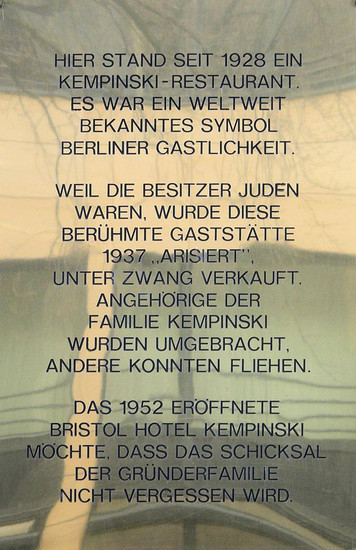
In 1994, after lengthy discussions, a memorial plate was unveilde at the Kempinski Bristol in Berlin. To claim that Kempinski has been hoteliers since 1897 is simply audacious. Let us take to heart what is written on the commemorative plaque at the hotel:
HERE STOOD A KEMPINSKI RESTAURANT SINCE 1928.
IT WAS A WORLD-RENOWNED SYMBOL OF BERLIN HOSPITALITY.
BECAUSE ITS OWNERS WERE JEWISH, THIS FAMOUS ESTABLISHMENT WAS "ARIANIZED" IN 1937 AND FORCIBLY SOLD.
MEMBERS OF THE KEMPINSKI FAMILY WERE MURDERED, WHILE OTHERS MANAGED TO ESCAPE.
THE BRISTOL HOTEL KEMPINSKI, OPENED IN 1952, WISHES TO ENSURE THAT THE FATE OF THE FOUNDING FAMILY IS NOT FORGOTTEN.
Hoteliers since 1897 ...?
In 2010, Kempinski, under its president Reto Wittwer, added the line "Hoteliers since 1897" to the company's name. For the first time ever the date 1897 had been circulated. It looked like an attempt to create a legend.
It takes just a small trick to come up with a much better and historically approved tagline
In the Munich commercial register Kempinski Aktiengesellschaft (it is no longer listed in Berlin) is registered with its headquarters, branch, and domestic business address at Maximilianstr. 17, 80539 Munich (Hotel Vier Jahreszeiten Kempinski Munich). The date of the first statutes is recorded as April 5, 1897, which at best creates the illusion of historical continuity.**
In reality, a "hotel operating company" in Berlin adopted the Kempinski name in the 1970s. This is still far from "Kempinski – Hoteliers since 1897." Out of respect for history-conscious consumers, it would be only fair to clarify this misleading claim.
Why doesn’t Kempinski use "Hospitable" — or "At Your Service since 1872" instead? With a bit of imagination and verifiable facts, they could rightfully make that claim, referencing their origins in the wine trade.
* There is information available on the web concerning the dubious 1950s-deals, involving the former aryanization-company Aschinger AG, which continued to be involved via sub-companies even in modern Germany. Names featured among others are Paul Spethmann and Werner Steinke (sources: Fritz Teppich and others), who were former Nazis, still acting in the same positions after the war.
For example: //hagalil.com/archiv/98/08/kempinski.htm
Book about the saga of the Kempinski family: //berlinerliteraturkritik.de/detailseite/artikel/die-familiensaga-der-hoteldynastie-kempinski.html?type=1&cHash=eabf4ee4fba3ae5aeb8a5e126d102547
** Kempinski’s grand son Friedrich W. Unger merged his share of the business with a Hotel Corporation called Bristol and Kaiserhof. Thus the company acquired the name Bristol. The Bristol was a hotel located Unter den Linden, in a different part of the city. It had opened for business in 1890. A 'Hotelbetriebs-Aktiengesellschaft', registered in 1897, had acquired it in 1904. Before 1952, that hotel Bristol had nothing in common with the Kempinski Bristol Berlin.
Hotels lost in History
( words)
Austria
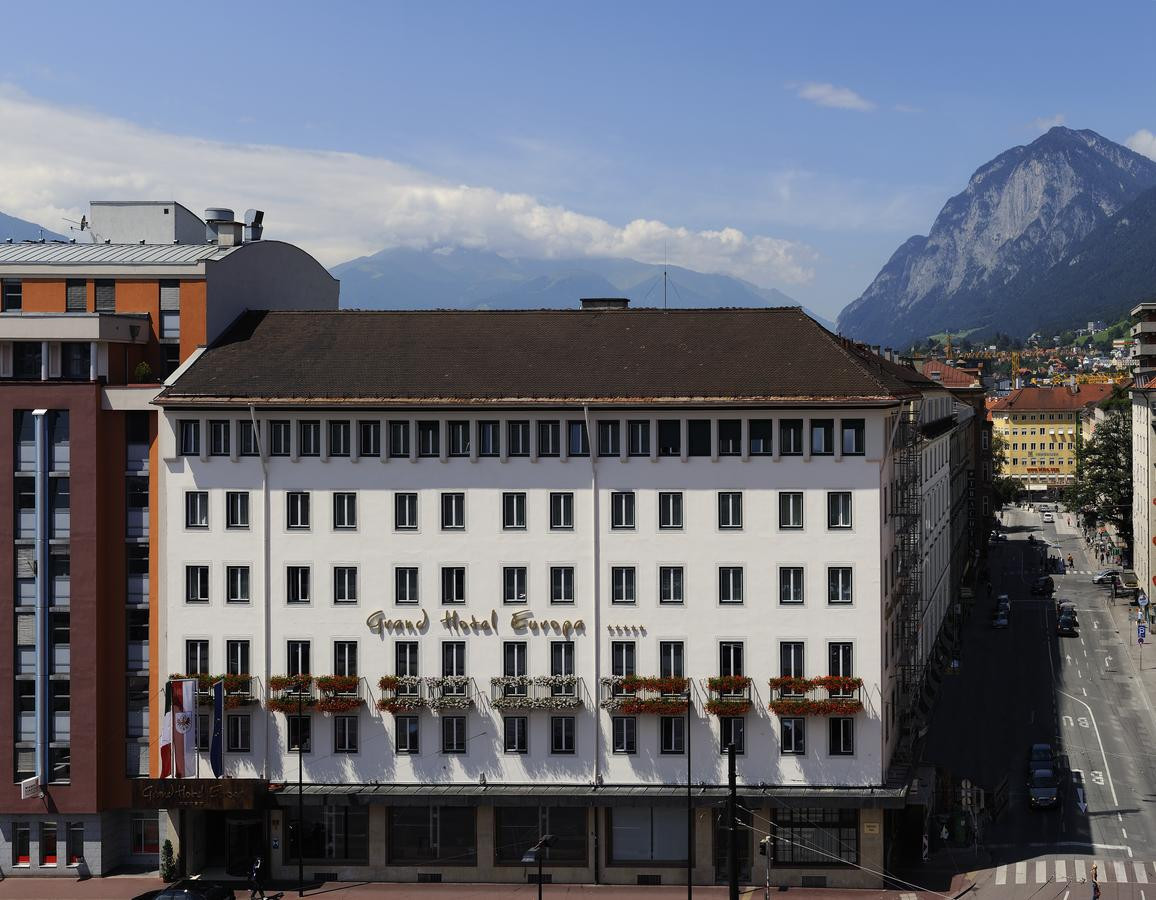
- Grand Hotel Europa Innsbruck used to be regularly in the social limelight of the Tyrolean provincial capital in the heart of Innsbruck. Its Baroque Hall from 1883 was the chosen venue for functions of all kind. Bavaria's King Ludwig II described the 5-star hotel as "the most beautiful place in Innsbruck to celebrate festive events". King Karl Gustav of Sweden found in the suites of the Grand Hotel the necessary rest and relaxation between the competition of the two Olympic Winter Games from 1964 and 1976. In 2007, the Italian "Palenca Luxury Hotels" acquired Innsbruck's most important hotel. Extensive renovation and expansion works - which have already been completed in the lobby, bar and reception area - followed in 2008/09. In 2020, the hotel closed and auctioned its inventory.
- Hotel Metropole, Vienna, opened 1873; by architects K Schumann und L Tischler, famous before the war, infamous headquater of the GESTAPO during 1939–1945, destroyed by bombs in 1945, never rebuilt.
-
Hotel Continental, Vienna, opened 1873, is today's Sofitel Vienna - a very chic modern architecture with interesting features. Destroyed in 1945 during the battle for Vienna, between Germany's army and Russian forces. Dating back to 1591 as a coach inn "Zum goldenen Lamm" and an other part used to be the hotel "Zum weißen Schwan", merged into "Hotel Continental" for the world expo in 1873 (with 200 rooms, large ball room for 600 pax and one coffee house).
- Hotel National, Vienna; built 1848, dating back to 1687 (original name of the inn: Zum goldenen Ochsen) - picture below.
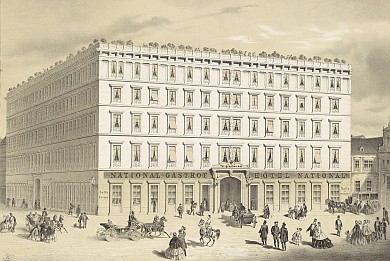
Hotel National, Vienna Architects: Ludwig Förster, Theophil Hansen. By 2017 an apartment building facing either renovation or demolition.
- Bad Ischl: Tallachini’s Grand Hotel, where Princess Sisi (later Empress Elisabeth) accepted Emperor Franz Josef’s proposal of marriage, was later renamed the Hotel Kaiserin Elisabeth and is now the Residenz Elisabeth. In Summer 1908, it hosted HRH Edward, the Prince of Wales.
- Semmering: Südbahnhotel — elegant resort of the Austrian-Hungarian empire, gathering place during the 1930s, and again in the 1950s. Lost momentum as entire region was abandoned in favour of more attractive tourism destinations. Stands as a testimonial to uncreative tourism and region management in Lower Austria, commanding a stunning view over the Semmering mountains.
Bahamas
- Nassau: Royal Victoria. The first luxury hotel in the Bahamas, built in 1861 and closed in 1971. The abandoned building sat vacant for years, gradually being stripped, until it burned down in the mid-1990's. A parking lot replaced it. The sprawling gardens of the hotel remain, however. Link to photographs here.
Chile
-
Carrera, Santiago de Chile: since 1940, its opening year, the hotel was originally a luxury apartment building, and designed to be part of the new Civic Center. 1940s-60s: The guest list included a mix of socialites, jet-setters and celebrities. 1985: Pro-democracy guerillas attempted to blow up Pincohet's office from one of the most desirable rooms in the hotel (see Legendary Stories). 2001: Hoteles Carrera increased its capital through the issue of 5,358,920 shares equivalent to US$6.2mil. In December 2004 the hotel closed for conversion to government offices.
China
- Macau, Hotel Bela Vista
-
Beijing Hotel (Huafeng), Beijing
1880s-1900: The Compagnie des Wagons-Lits built hotels like the Ghezireh Palace in Cairo, the Pera Palace in Constantinople, the Hôtel de la Plage in Ostend (Belgium), the Hôtels Terminus in Bordeaux and Marseille, and the Riviera Palace in Monte-Carlo. 1900: The foundation stones of the hotel were laid 1905: The company opens the Grand Hôtel des Wagons-Lits in Peking. The only hotel in the Legation Quarter, it was to accommodate travellers from Europe on the Trans-Siberian Express. A 1930s guidebook says the original building stood in a large garden ornamented by stone fishponds, sole relics of ancient imperial offices. 1915: The hotel's five-story red brick building was completed. Later known as the 'old building', this structure brought the hotel very brisk business. 1917: Prospering with good management and the booming tourism industry, the hotel received an investment boost of two million silver coins which added a seven-story French-style building (today's Building B). This new structure, which is now called the 'middle building', consisted of 105 suites furnished with central heating, telephone and toilet facilities, dining halls and kitchens, a hair saloon and a ballroom with a sprung floor. Otis brand elevators took guests to the bar and open-air terrace for dancing on the seventh floor. Foreign guests described it as the number one luxury hotel in the Far East. Its opening was attended by well over 800 distinguished guests who packed the lobby and dining halls. 1920s: The Thomas Cook Travel Agency set up an office in the hotel and rented the liner Franconia to ferry tourists to China. In those days, a model of the ship was displayed in the Western dining hall and a banquet with dancing would be thrown around the model for each group of new arrivals. 1922: The Hong Kong Hotel Company acquired 85 percent of the Shanghai Hotels Limited, which held 60 percent of the share capital of the Grand Hôtel des Wagons-Lits. 1937: The '1937 Incident' when Japan invaded China triggered a slump in business. The hotel was taken over by the Japanese during their occupation of Beijing. 1945: After World War II, the hotel was taken over by the municipal government of the Kuomingtang, after the war. Its business remained slack for the instability of society and the lack of foreign tourists. 1949: The People's Republic of China named Beijing its capital and offered the hotel a new lease of life. State and Diplomatic functions had to be held in a place with Chinese characteristics and high popularity 1954: Completion of a new wing. 1974: The old brick building was pulled down and a new 89-metre structure put in place. At the time it was the highest building in Beijing.
Egypt
- Cairo: Shepards — burnt down
- Continental-Savoy (Cairo), still standing, but empty
England
London
- Hotel Cecil, built in 1896, a large hotel in the Strand in London, England. It was named for Cecil House, a mansion that had occupied the same site in the 17th century. Designed by architects Perry & Reed in a "Wrenaissance" style, the hotel was the largest in Europe when it opened with more than 800 rooms. The proprietor later went bankrupt and was sentenced to 14 years in prison. The Cecil was largely demolished in Autumn 1930, and Shell Mex House was built on the site. The Strand facade of the hotel remains, with, at its centre, a grandiose arch leading to Shell Mex House proper.
- The Grand Hotel (we have reasons to believe that it was the first in the world by this name) had opened in January 1774 (by David Low), but ceased to exist in the 1880s.
- Basil Street Hotel was an oasis of English charm, run by the same family for 3 or 4 generations, just behind Harrods. Beloved of the hunting, shooting fishing set, and home to the famous Parrot Club it closed around 2005 to be stripped and turned into offices. The collection of antiques furnishing the hotel collected by the family took days to sell.
-
Grillon’s Hotel
-
Pulteney Hotel
-
To celebrate the defeat of Napoleon at the Prince Regent’s Grand Jubilee celebration in 1814, while Napoleon sailed for Elba, France’s King Louis XVIII took rooms at Grillon’s Hotel on Albemarle Street. Another popular hotel among foreign royals staying in London was the Pulteney Hotel, named after Pulteney, Earl of Bath, who had resided in the building before it became a hotel. It was located on the west corner of Bolton Street at 105 Piccadilly.
-
France
Nice
-
Excelsior Regina: today appartements; built in between 1895 and 1897 as a hotel for the royal faces and for the rich aristocracy who used to visit Nice in the late 19th century, the Excelsior Regina Palace is at present an apartment building which has lost nothing of its past architectural splendor. It is located in the hilly and tranquil Cimiez. The history of the construction of the Excelsior Regina Palace is related to the name of Queen Victoria of England who promised she would visit the French Riviera more often provided that a royal residence to match her reputation was built.
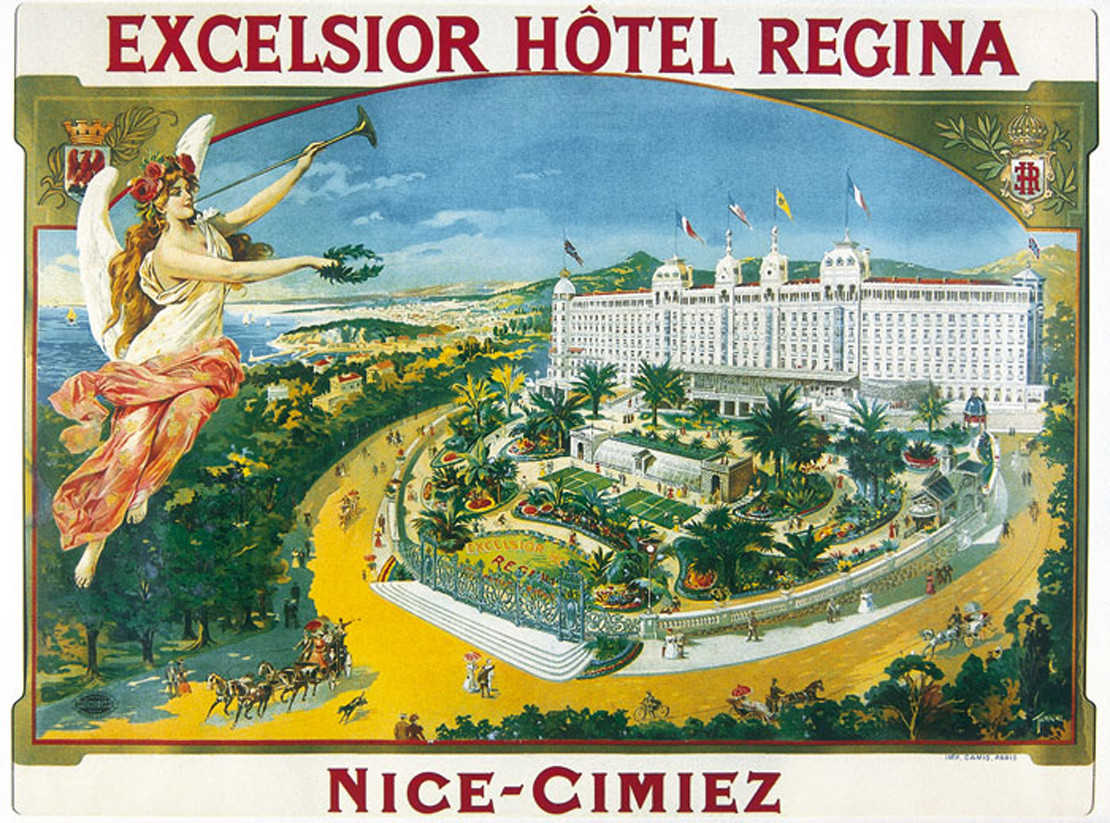
The building bristles with decorative elements characteristic of the Belle Epoque period. Lush bas-reliefs, glass marquees, picturesque attics and oriels peg out the white façade of the building. Parts of the Excelsior Regina Palace and the garden stretching in front of it, including the marble statute which depicts Queen Victoria (a monument placed at one of the garden entrances) enjoy the statute of historical monument. They were listed as such in 1992. Source: [url=http://www.nice-tourism.com/en/nice-attractions/historical-edifices-and-landmarks-in-nice/excelsior-regina-palace.html]http://www.nice-tourism.com/en/nice-attractions/historical-edifices-and-landmarks-in-nice/excelsior-regina-palace.html[/url]
Beaulieu sur Mer
-
Bristol Palace: True architectural masterpiece of the Belle Epoque, the Rotonde de Beaulieu rises in front of the sea and catches the eye of the passers-by and visitors of the town. Large circular room with glass-faced apses and a cupola with cut-off sides, the Rotonde is a former outbuilding of the Hotel Bristol, built between 1899 and January 1904 at the request of the British clientele of the palace to serve tea. This lounge was built in the south continuation of the building by the same architect, the Danish Hans-Georg Tersling. The Hotel Bristol, financed by a London furniture manufacturer, Sir John Blundell Maple, was built in record time, like many palaces on the Riviera during the Belle Epoque, between February 1897 and December 16, 1898. Inaugurated on January 5, 1899, the palace comprises 300 luxuriously equipped rooms, including bathrooms fed with heated sea water, spread over 5 floors with 60 rooms per floor. The building has high roofs evoking the style of an English castle. On March 28th 1911, in the evening, fanned by a strong wind, a fire broke out in a chimney and spread to the top two floors of the building and to its entire cover. Following the intervention of the firemen of Beaulieu and Nice and of the Chasseurs Alpins, the fire is mastered by flooding the upper floors. Thanks to the reinforced cement structure of the building, the lower part of the building remains relatively intact, the fire reducing the upper two floors to nothing.
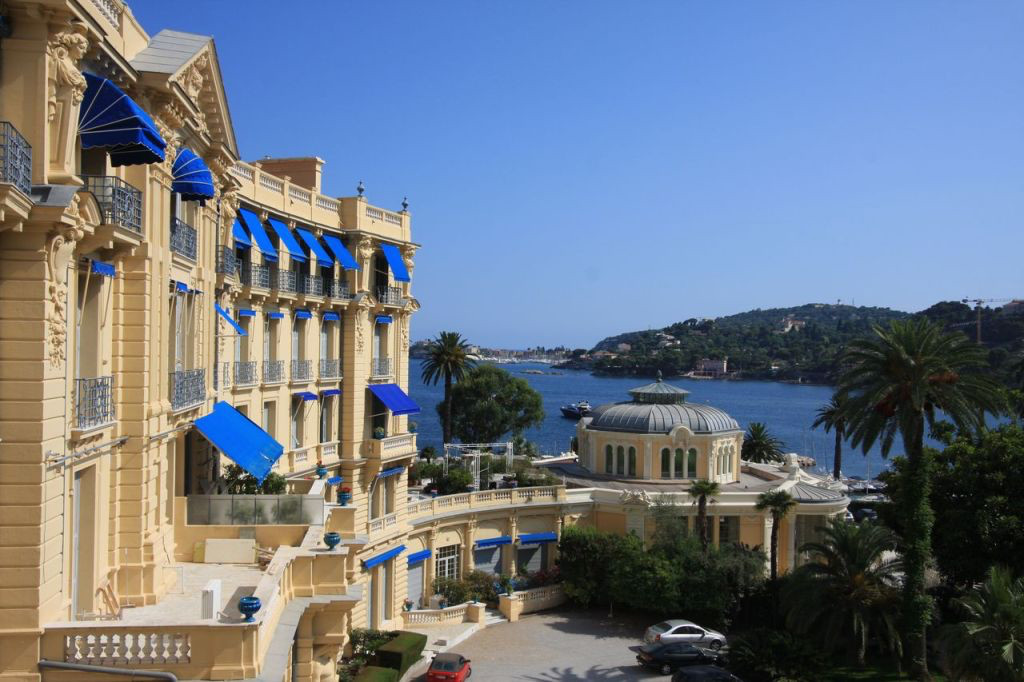
The rest of the hotel is quickly rehabilitated and the Bristol reopens for the winter season of 1911-1912, amputated from the destroyed floors and with a classic roof in red tiles with a slight slope. Converted into a high-end condominium by the promoter Saglia in 1954, the Bristol loses part of its gardens as well as the tennis courts, ceded to the municipality of Beaulieu. The building retains its original appearance, decoration and part of the lobby. La Rotonde was for his part neglected and left without maintenance, threatened with demolition and finally expropriated for the benefit of the municipality in the 1970s. Transformed into a conference center in 1982 and operated by the Partouche group, it will not be any more used from 2001. Again abandoned during 10 years, it now shelters, since October 2011, the Salons de la Rotonde Lenôtre and took back its festive vocation and initial receptive. -
source: http://www.agencebristol.com/en/news/the-bristol-and-the-rotonde
Germany
Leipzig
- Hotel de Prusse (1805-1905), Hotel Preussischer Hof (1905-1921)
- Bühlerhöhe: Schlosshotel Buehlerhoehe (Bühlerhöhe): officers home since 1918; luxury hotel between 1986 and September 2010. Closed due to low business.
-
Pflaums Posthotel Pegnitz: An inn that perfectly illustrates the European tradition of a single family`s involvement in a highly personal business over centuries. Pflaums Posthotel Pegnitz, opened in 1707, was owned and run by the founding familiy for 11 generations. As the inn is only 19miles from Bayreuth, it was filled with celebrities during the music festival, and trough much of the rest of the year as well. The 5 star superior rated property has two award winning restaurants 'and 'Outdoor Dining'; . Golf, Spa and conference facilities for incentives and small meetings, Open All Year. Hotel of the Year Germany. Grand Award and Golden Key for Interior Design. New York. Designer Magazine and American Hotel and Restaurant As. 1707 opened under the name Gasthof Post Schwarzer Adler by Heinrich Friedrich Pflaum (with five rooms) Recently a boutique design and arts hotel with ony 25 individually designed rooms, run by Hermann Pflaum, one of the leading chefs of Europe. It closed in 2016.
Hongkong
- Hong Kong Hotel — the "mother" of the Hong Kong – Shanghai Hotels company
- Repulse Bay Hotel, one of the last remaining colonial style buildings in Hongkong until it was demolished to give room for a high rise apartment building ca. 1985. It had a huge balcoly with a view of the South China Sea and was an important part of Hongkong history when it was torn down. The veranda is said to have been rebuildt somehow, but the old atmosphere must be gone forever.
Hungary
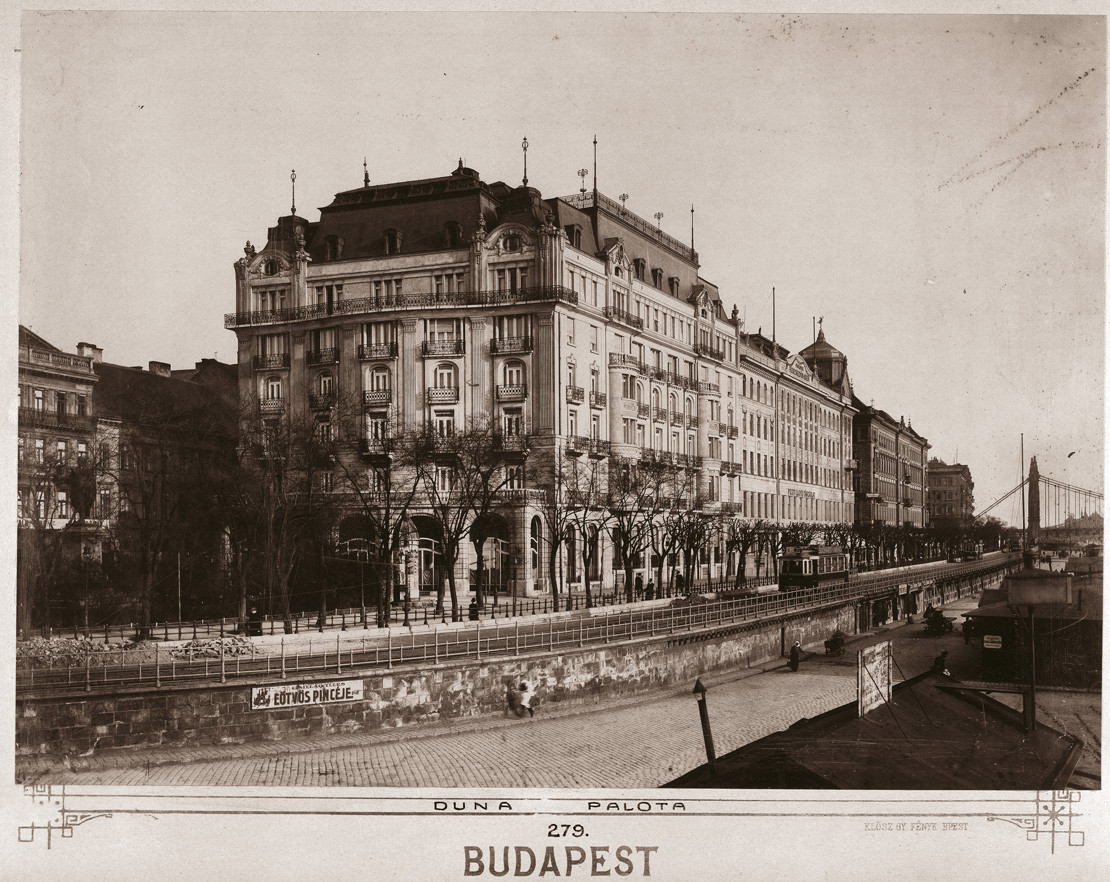 Budapest — Hotel Ritz — one of the "Ritz" franchise projects —it opened in 1913 with 120 suites, a reading room, a reception and banquet hall, a winter- and a rooftop-garden, a café, a restaurant, a bar, a barbecue room, central heating, three passenger and four service lifts. Despite the professional management of Károly Vásárhelyi, in 1916, the luxury hotel went bankrupt in the recession due to the First World War.
Budapest — Hotel Ritz — one of the "Ritz" franchise projects —it opened in 1913 with 120 suites, a reading room, a reception and banquet hall, a winter- and a rooftop-garden, a café, a restaurant, a bar, a barbecue room, central heating, three passenger and four service lifts. Despite the professional management of Károly Vásárhelyi, in 1916, the luxury hotel went bankrupt in the recession due to the First World War.
In 1913, Mrs César Ritz, Marie, personally supervised the opening. It was reopend as Duna Palota (Danube Palace). On January 15, 1945, the hotel was bombed and finally flushed for several days. The ruins were removed in 1947. From 1981, the Hotel Forum (now InterContinental Budapest) stands in its place.
India
- Calcutta Great Eastern built by David Wilson in 1841 Spence's by John Spence, before 1830 Grand, by Stephen Arathoon, opened in 1911, closed in 1937.
Indonesia:
- Hotel des Indes was one of the oldest and most prestigious hotels in Asia. Located in Batavia (now Jakarta), in the Dutch East Indies (now Indonesia). The hotel had accommodated countless famous patrons throughout its existence from 1829 to 1971. Before being named Hotel des Indes, a name suggested by the writer Multatuli, it was named ‘Hotel de Provence’ by its first French owner and for a short spell went by the name ‘Hotel Rotterdam’. After Indonesian independence it was renamed ‘Hotel Duta Indonesia’, until it was demolished to make way for a shopping mall. >>> This hotel should not be confused with ‘Hotel des Indes’ in The Hague, the Netherlands. Details on wikipedia.
Italy
Venice:
- The Grand Hotel des Bains was one of the famous hotels on the Lido of Venice. Built in 1900 to attract wealthy tourists, it is remembered amongst other things for Thomas Mann's stay there in 1911, which inspired his novella Death in Venice. Luchino Visconti's film of the novel was shot there in 1971. The hotel was also used as Shepheard's Hotel in Cairo in the 1996 film The English Patient; Diaghilev died at the hotel in 1929. Until 2010 the hotel was frequented by movie stars during the Venice Biennale. In 2010, the hotel was closed to be converted into a luxury apartment complex, the Des Bains residences. As of September 2017 the hotel is still awaiting renovation. A large fence surrounds it, with a guard employed inside.
- Rifugio Guglielmina / Ricovero al Col d’Olen It was 1878 when Ricovero al Col d’Olen was first inaugurated: it was the third among the 8 hotels founded, or run, by the Guglielmina family between the last half of the nineteenth century and the first half of the twentieth century. Giuseppe Guglielmina was a humble shoemaker from Mollia: the reason for the fast growth of its hotel business can be find in the entrepreneurial spirit of many public figures of the time as well as in the atmosphere of openness to tourism which followed the conquest of Monte Rosa. As a matter of fact, only eight years after the rise to Signalkuppe (today named Punta Gnifetti), Giuseppe Guglielmina and his family were able to run the Albergo del Monte Rosa, inaugurated in Alagna in 1850 and which was later expanded; then, they managed to run the Albergo delle Alpi in Riva Valdobbia in 1871, the Ricovero del Col d’Olen in 1878, the Albergo d’Italia in Varallo Sesia in 1879, the Albergo del Mottarone on the Maggiore lake in 1884, the Hotel Bellevue Alpino in Gignese in 1900, the Hoten Royal in Ospedaletti Ligure in 1901 and the Grand Hotel Eden in Santa Margherita Ligure in 1090. Moreover, the newspaper of the time record their presence even in Sicily, in Palermo, where they ran the Ristorante Cafè Chantant on the occasion of the Universal Exposition in 1981. Unfortunately Rifugio Guglielmina has been completely burned down. The fire started in the early morning of 22 December 2011 and couldn't be stopped because of strong wind, that did not allowed firemen to reach Col d'Olen.
Japan
- Kobe
The Tor Hotel was constructed in 1907 and decorated in the style of a Swiss chalet by Alfred Mildner, a German hotelier born in Alcase Lorraine, because the popular Oriental Hotel near the port was overcrowded each time passenger ships arrived. It catered to visiting dignitaries and tourists as well as wealthy Japanese and foreign residents. The hotel received its name from it location, tor, a Cornish word for ‘rocky hill’. Soon people started to call the road leading to it ‘Tor Road’. The hotel was located on the northern end of Tor Road, near the present-day location of the Kobe Club.
The Tor Hotel burned down in 1950, and little now remains of the earlier history of the site except for the giant Himalayan cedars in the front car park, thought to have been planted around 1890 by Arthur Greppi, a European businessman who had lived on the site before the hotel opened in 1908. There is also one small, red torii gate – all that remains of an Inari shrine that was located in the hotel garden and had several torii leading to it.
Lebanon
- St. Georges of Beirut was the place where Mr. Philby held court in the bar for seven years until he suddenly disapeared before reappearing in Moscow. The hotel or what is left of it, was built on one of the most valuable pieces of sea side property in central Beirut in the 1930s and became a gathering place for diplomats, reporters and spies. Yes, for once this cliche can be applied. In the sixties and early seventies, in Beirut's golden years, presidents, Hollywood stars and the rich Golf arabs, stayed at he hotel while visiting The Casino du Leban in Jounieh, Pepe Abed fish restaurant in Byblos or the Roman ruins in Baalbek. Lebanese-Palestinian writer Said K. Aburish has devoted a 200 page book to "The St. Georges Hotel Bar", published by Bloomsbury, London 1989. The destruction of the hotel in the so-called war of the hotels in December 1975 is vividly described by the American correspondent Jonathan Randal in his book "Going All the Way: Christian Warlords, Israeli Adventures and the War in Lebanon (Viking 1983). Randal was held hostage in the building during the fighting.
- The slim hope of the owner to rebuild the hotel was finally shattered by the powerful road bomb that killed prime ministe Rafik Hariri in February 2005. The neighbouring high rice Holiday Inn was also destroyed in 1975 and is, together with the St. Georges ruin, standing as an emty monument over the civil war.
- The beautiful Phoenicia Hotel re-opened as The Intercontinental some years ago but was also forced to close for a while in 2005 due to the Hariri bomb.
Malaysia
- Kuala Lumpur: Railway Station Hotel
- Penang: Runnymede Hotel
- Penang Hill: The Crag
Mozambique
- Beira: The Grande Hotel Beira was a luxury hotel in Beira, Mozambique that was open from 1952 to 1963. It continued to be used during the 1960s as a conference center and swimming pool. During the Mozambican Civil War (1977-1992) it became a refugee camp. The hotel opened in 1954, when it was billed as the "pride of Africa," and was widely regarded as the largest and most exquisite hotel on the continent. Its owners intended to include a casino, but failed to secure the necessary government authorization. The hotel was never profitable, and never attracted the wealthy clientèle it was intended to. It closed as a hotel in the early 1960s. The swimming pool and conference rooms continued to be used during the 1960s and even after the independence in 1975. The last event held in the hotel was the new year's eve party in 1980-81.
After independence in 1975 its basement was used as cells to hold political prisoners. Some members of the police and army started using the third floor as their living quarters. After 1981, it was taken over by the general population. The new guests used the entire parquet floors as fuel. The building has no running water or electricity, and is currently inhabited by more than 1,000 people.
Journalist Florian Plavec describes a visit to the hotel in a July 2006 feature in the Austrian newspaper Kurier. According to his accounts, virtually everything of any value has been looted from the hotel, including its marble and bathroom tiles, wooden flooring, sinks, and bathtubs. The former pool now serves as a water collector for clothes washing, and the former pool bar as a urinal. The hotel has also experienced structural damage, as trees continue to grow out of terraces, and floors collapsed.
The hotel in its actual state of decay has been shot by South-African photographer Guy Tillim in his serie "Avenue Patrice Lumumba"in 2007 (published by Prestel Verlag).
- Xai-Xai: Chongoene Hotel: Ruins remain the only victim of a bygone era of the Chongoene Hotel. Recently the South African company East Coast Development Corporation has shown interest in rehabilitating the hotel.
Pakistan
- Peshwar: Deans Hotel
Sri Lanka
Colombo
- Hotel Bristol
Switzerland
- Montreux Grand Hotel National, opened in 1875 as the first grand hotel in the resort on the Swiss Riviera that would eventually become known for its stately accommodation. The lights went out in the 1980s, when the hotel owners decided to close it down.
USA
Florida
- St. James Hotel in Jacksonville — after the Great Fire of 1901
Los Angeles
- The Ambassador Hotel, Hollywood, built 1921, demolished 2006.
California, Salton Sea
- Palms Motel
Unsurprisingly repulsed by the smell of rotting fish that besieged the town following a series of ecological disasters (the huge lake became so polluted that all marine life was doomed to end up dead on the sand banks), residents and visitors abandoned Salton City, California in the late 1980s. The Palms Motel remains though — at least its structure.
Detroit
- Lee Plaza Hotel
Abandoned in the 1990s, the 15-storey Lee Plaza Hotel is a monument to early 20th-century design, added to the United States National Register of Historic Places in 1981.
Liberty, N.Y.
- Grossinger's Resort - closed in 1986, remains destroyed by a fire in 2022.
New York
Many hotel buildings have been lost such as the
- Astor House on Broadway between Vesey and Barclay was designed by Isaiah Rogers and opened in 1836 and was demolished in 1913.
- Fifth Avenue Hotel on 23rd to 24th Streets that was designed by William Washburn and had the first hotel elevator and opened in 1858 and was demolished in 1908.
- The Ritz-Carlton, designed by Warren & Wetmore, architects of the new Grand Central Terminal. The Ritz-Carlton, on Madison Avenue and 46th Street, opened at the end of 1910, reached its fashionable heyday at about the time of the First World War. Its ballrooms and lobbies, and some say its service and general ambiance, where between than those furnished later elsewhere at the Ritz Tower. The Ritz-Carlton was razed in 1951 to provide a site for an office building.
- McAlpin (1912), now a condominnium building
- Drake Hotel (1927), demolished 2007.
Notable guests of the old 640-room hotel included Frank Sinatra, Muhammad Ali, Judy Garland, Jimi Hendrix and Glenn Gould. In the 1960s and 70s, rock groups like The Who and Led Zeppelin chose to stay at the Drake when they visited The Big Apple from the UK. Famously, Led Zeppelin reportedly had $203,000 in cash stolen from a safe deposit box at the hotel. famoushotels.org columnist Stan Turkel ran the Drake for several years in the Sixties. The famous nbightclub was called Shepheard's, which was Manhattan's first discotheque, named after the famous Cairo hotel. It was Egyptian-themed with two large gold sphinxes either side of its entrance. The Drake Room was one of the places to eat and be seen in Manhattan. The executive chef, a man called Nino Schiavone, championed the idea to have waiters prepare food at the tableside. Cuts of prime steak mixed with sweet butter, fresh chives and other seasonings were flamed with cognac and sherry at the tables of an eclectic and well-heeled crowd. Providing the ambience at The Drake Room was a famous salon piano player, Cy Walter. So renowned was the pairing of pianist Walter at The Drake Room, Turkel arranged for MGM Records to record an album. Released in 1966, the cover of the record, Cy Walter at The Drake, was a photograph of Walter with his Steinway grand piano outside the Drake entrance, on 56th St. - Traymore Hotel (1879), Atlantic City, N.J.; demolished
- Vemon Manor Hotel (1924), Cincinnari, OH.; convened to ahospital building.
- Savoy Plaza Hotel is now the site of what was the GM building. For a time, it was the Savoy Hilton Hotel.
- Ambassador Hotel on Park Avenue, which was Sheraton Ambassador for a time.
- Hotel Theresa opened in 1913 on 125th Street and Seventh Avenue in Harlem. It became famous for accepting both races in the 1940s. It closed its doors as a hotel in 1970. In 1971, the hotel was converted to an office building with the name Theresa Towers and was declared a landmark in 1993 by New York’s Landmark Preservation Commission.
- GROSSINGER’S CATSKILL RESORT AND HOTEL In its heydays Grossinger’s Catskill Resort Hotel was attracting more than 150,000 guests per year to its 35 buildings, a golf course, beauty salon, pool, and even artificial ski slope. The 1972 death of its legendary hostess, Jennie Grossinger, though, coincided with the death of the hotel’s heyday as the rich and famous sought glamour elsewhere. Abandoned in 1986, the Catskills resort provided the location one year later for Dirty Dancing.
Kauai, Hawaii
- COCO PALMS RESORT Once a star-studded luxury resort on the Hawaiian island of Kauai, Coco Palms was so badly damaged by hurricane Iniki that it was forced to close in 1992. Left abandoned since then, the hotel that once hosted the Elvis Presley movie Blue Hawaii was further gutted by fire in 2014; it remains unclear whether the blaze was started by the ghost of the King ... but we think it probably was.
Philadelphia
- DIVINE LORRAINE HOTEL Standing at the corner of Broad Street and Fairmont Avenue in North Philadelphia, The Divine Lorraine Hotel is an abandoned hotel with a future. Derelict since 1999, the hotel has attracted ruin aficionados, graffiti artists, and vandals to its 11-storey playground — but plans are well underway to restore the iconic building to its former glory. Once home to a cult, the Divine Lorraine is also significant as the first racially integrated hotel in America. Following a $US44 million ($57 million) renovation, the blighted building could open as early as the end of 2016, which would make it the first (and only) former creepy abandoned hotel on our list.
Pocono Mountains
- BUCK HILL INN closed in 1990. At this time — when owner Jacob Keuler’s wife fell ill — Keuler drove her to the hospital, checked her into the psychiatric ward, went back to the hotel, and shut the whole place down, leaving everything as it was.
Kansas City
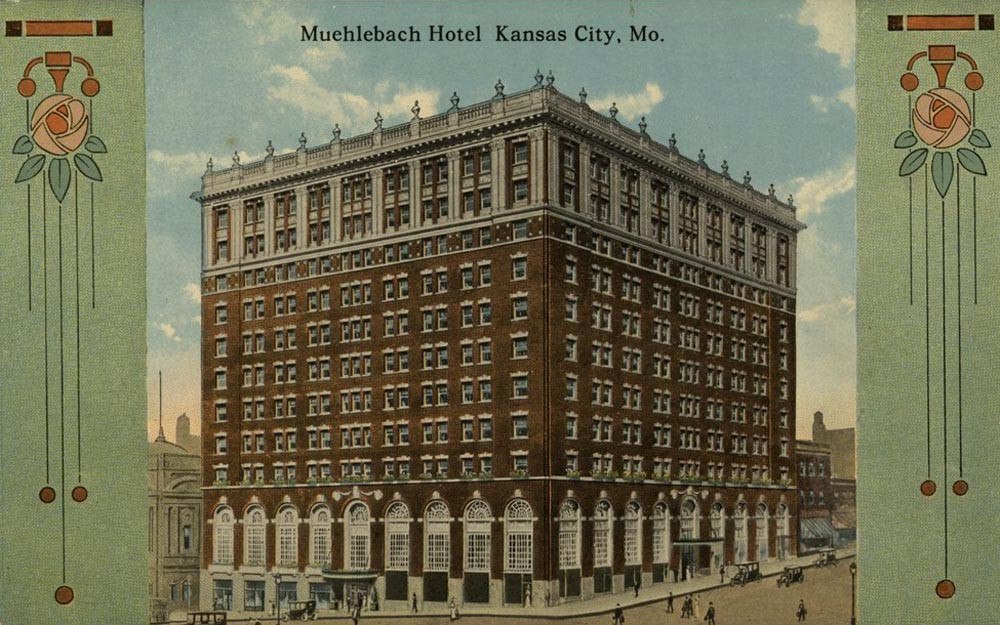
- Muehlebach: The original 12-story building was constructed in 1915. It was designed by Holabird & Rocheand, 144 feet (44m) high and owned by George E. Muehlebach, whose father, George E. Muehlebach Sr., founded the Muehlebach Beer Company. The younger Muehlebach also built Muehlebach Field, which achieved its greatest prominence under the ownership of Barney Allis. In 1952 a 17-story western annex and parking lot were added. The entire hotel underwent a major restoration in 1976 and operated for a time as the flagship of the Radisson hotel chain under the name Radisson Muehlebach Hotel before finally closing in the 1980s.
Charleston
- West Virginia, Daniel Boone Hotel, opened in 1929, closed 1981
Chicago
- The Edgewater Beach Hotel was a hotel in the far-north neighborhood community of Edgewater in Chicago, Illinois. Designed by Benjamin H. Marshall and built in 1916 for its owners John Tobin Connery and James Patrick Connery, it was located between Sheridan Road and Lake Michigan at Berwyn Avenue. An adjacent tower building was added in 1924. The hotel closed in 1967, and was soon after demolished.
The Edgewater Beach Apartments were completed as part of the hotel resort complex in 1928. The "sunset pink" apartments, complimented the "sunrise yellow" hotel in a similar architectural style. The apartments remain standing and have been listed on the National Register of Historic Places. More history --> Wikipedia - The Raymond Hotel dominates the South Pasadena landscape. It opened in 1886. The Raymond remained Southern California's leading resort hotel until Easter Sunday, 1895. On that day, an ember flew from one of the Raymond's 80 chimneys landed on the hotel's wood-shingle roof. No lives were lost, but within a couple hours the Raymond was no more. In 1901 Walter Raymond was able to rebuild and reopen his hotel. With 400 rooms, golf links, and formal gardens, the Raymond's second iteration was even grander than the first. At the entrance, a new floral display, augmented by 575 electric lights, announced in ten brightly colored letters that visitors had arrived at "THE RAYMOND." Guests then entered a tunnel -- which still exists today, though sealed, under Raymond Hill -- and ascended into the hotel via elevator. In the 1930s, facing intense competition from Pasadena's newest luxury resort, the Huntington Hotel, the Raymond was unable to remain profitable. A bank foreclosed on the aging property in 1931 and, in 1934, the Raymond was demolished.
This list is growing — with the help of our corresponding friends. Please send us names and photographs of lost hotels.
Thank you
- bristol
- budapest
- cairo
- china
- continental
- egypt
- excelsior
- frank sinatra
- germany
- grand hotel
- hilton
- hong kong
- hotel metropole
- hungary
- imperial
- india
- jacksonville
- lost hotels
- metropole
- muhammad ali
- national
- new york
- oriental
- oriental hotel
- penang
- pera palace
- prince of wales
- queen victoria
- russia
- savoy
- schlosshotel
- semmering
- shepherd
- shepherds
- sinatra
- stan turkel
- sting
- südbahnhotel
- thomas cook
- thomas mann
- uk
- usa
- vienna
A Winter Arrival at the Grand Hotel BELVÉDÈRE
( words)
A Winter Arrival at the Grand Hotel Belvedere
In a winter around 1900, a horse-drawn carriage on runners glided to a halt before the Grand Hotel Belvedere in Davos, Switzerland. The snow-covered landscape framed an elegant arrival: two uniformed hotel staff swiftly unloaded luggage from the carriageâ's roof, their breath almost visible in the crisp alpine air. A distinguished lady, dressed in a flowing black gown, stepped carefully onto the packed snow. At the entrance, a senior hotel official, impeccably dressed, extended a warm welcome.
This remarkable moment was captured by A.L. Henderson, court photographer to Queen Victoria. His lens preserved not just a scene, but an era—the golden age of grand hotels, where winter retreats in the Swiss Alps were a mark of sophistication and health. The Belvedere, already a renowned sanatorium and luxury retreat, stood as a beacon of hospitality, offering warmth, refinement, and impeccable service to Europe's elite.
Henderson's photograph remains a treasure of both photography and hospitality history, a glimpse into a world where the arrival at a grand hotel was as much a spectacle as the stay itself.
---------
Alexander Lamont Henderson (1838*/“1907) was a Scottish-born photographer renowned for his contributions to Victorian-era photography. His work included portrait photography, as evidenced by cartes-de-visite and cabinet cards from the 1860s to the 1880s.
In 1884, Queen Victoria awarded Henderson a Royal Warrant, recognizing his skill in capturing everyday royal life. This honor allowed him to document various aspects of the royal household, contributing significantly to the visual history of the British monarchy. After Queen Victoria's death in 1901, Henderson retired from professional photography. He then embarked on photographic tours across Europe, visiting countries such as France, Italy, and Spain, further enriching his portfolio with diverse cultural scenes. Henderson passed away in 1907, leaving behind a legacy that offers a valuable glimpse into 19th-century British society and the royal family.
The Fall of a Jewel: The Attack on Hotel Bristol, Odessa, Ukraine
( words)
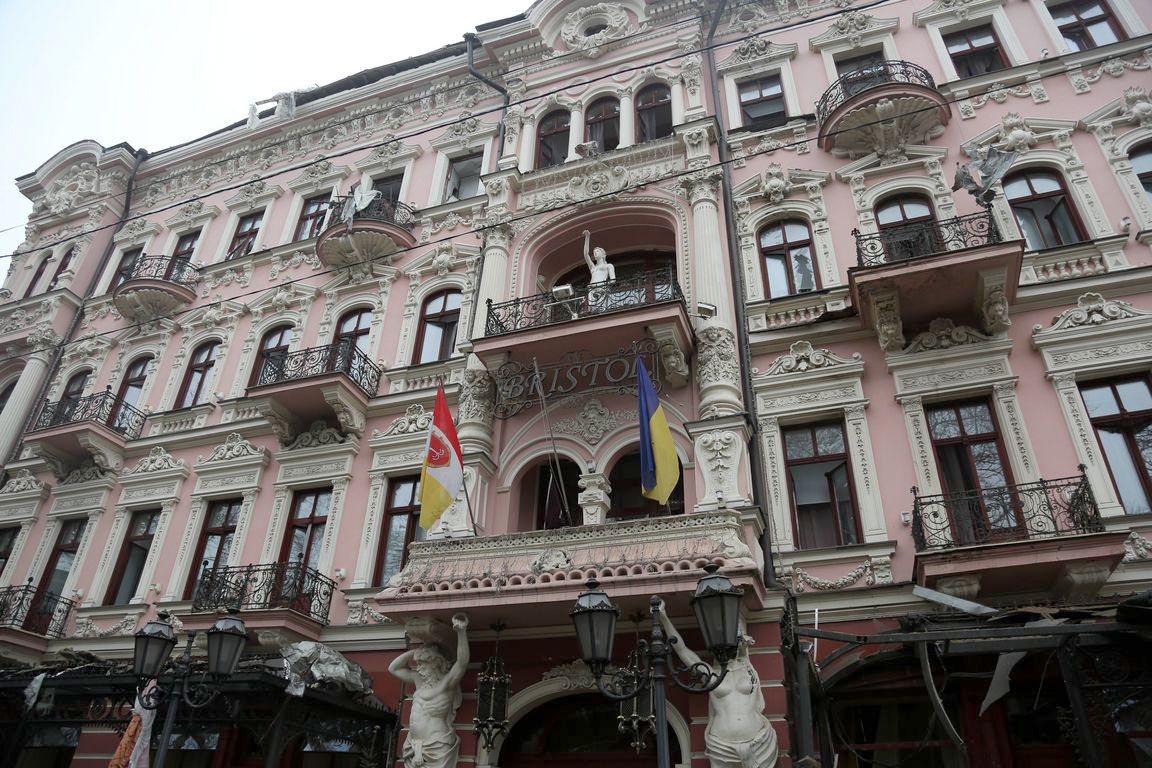 The Fall of a Jewel: The Attack on Hotel Bristol, Odessa
The Fall of a Jewel: The Attack on Hotel Bristol, Odessa
Odessa, often called the Nice of Ukraine, mirrors the charm of the Côte d'Azur with its Black Sea coastline, elegant boulevards, and vibrant cultural life. Its sun-drenched beaches and historic architecture make it a timeless seaside retreat. On the night of January 31, 2024, the heart of Odessa trembled. Russian missiles rained down upon the historic center, shattering not only buildings but the spirit of a city steeped in history. Among the wounded was a symbol of Odessa’s grandeur—the illustrious Hotel Bristol.
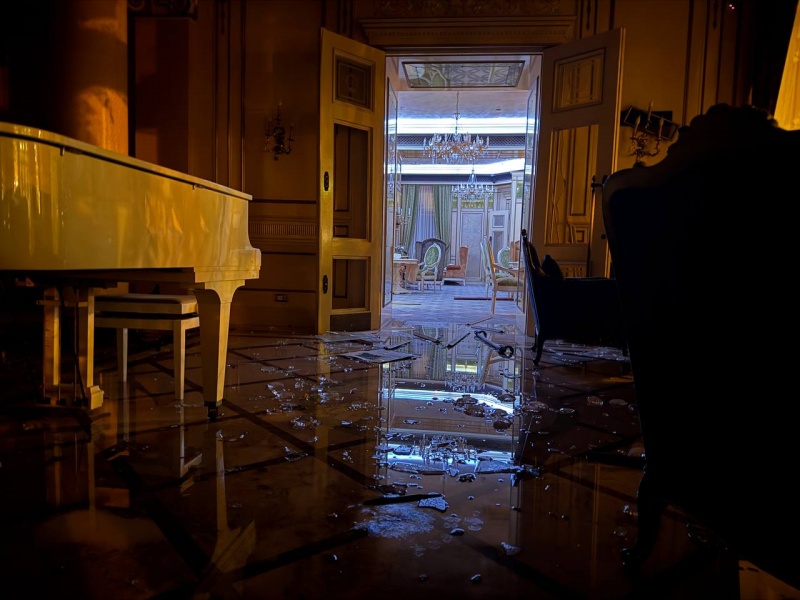
Since its grand opening in 1898, the Bristol stood as a beacon of elegance. Designed by renowned architects Alexander Bernardazzi and Adolf Minkus, its façade, a masterpiece of Renaissance revival, spoke of an era when Odessa was the gateway between East and West. It welcomed dignitaries, artists, and travelers, its marble halls echoing with conversations of empire, revolution, and rebirth.
Through wars, political upheavals, and the shadow of the Soviet era—when it was renamed *Hotel Krasnaya*—the Bristol endured. After the fall of the USSR, it faced years of neglect, but like the city itself, it rose from decay. Painstakingly restored, the hotel reopened in 2010, reclaiming its place as a crown jewel on Odessa’s skyline.
 But history, it seems, repeats its tragedies. As missiles tore through the night sky, the Bristol’s storied walls crumbled. The same halls that once hosted grand balls and whispered secrets of a bygone age now stood in ruins, a silent witness to the brutal assault on Ukraine’s cultural soul.
But history, it seems, repeats its tragedies. As missiles tore through the night sky, the Bristol’s storied walls crumbled. The same halls that once hosted grand balls and whispered secrets of a bygone age now stood in ruins, a silent witness to the brutal assault on Ukraine’s cultural soul.
The Bristol’s fall is more than the destruction of a building—it is an attack on memory, on heritage, on the very essence of Odessa. Yet, as history has shown, this city and its treasures have a resilience no bomb can erase.
Teleseme: 104 good reasons to call the staff
( words)
By Andreas Augustin / famoushotels.org
International hotels around 1900 were filled with inventions lavishly described in their promotional literature. Guests were assured that the air they breathed was the freshest possible, thanks to novel ventilation systems. Doors closed quietly on nonslamming hinges. To open them, you didn't have to leave your bed. Services like shoe-polishing were provided unobtrusively via the 'servidor, a compartment in the room door accessible by small doors on either side (still in use at The Oriental in Bangok and at The Peninsula Hong Kong, for example). Once central clock was in charge of the clocks in all rooms. And so on.
Here we have a sophisticated machine for you: the Herzog Teleseme.
In 1894, *The Electrician* reported that a New York hotel had replaced its new telephone service with a teleseme system. The hotel cited guest complaints, especially from women using phones to lodge grievances, and operators overwhelmed by calls. The teleseme, invented in the 1880s by F. Benedict Herzog and Schuyler Wheeler, became an emblem of hotel luxury before the widespread adoption of telephones in guest rooms.
The teleseme allowed guests to make specific service requests through a dial mechanism offering over 100 options. Requests, ranging from food and beverages to specific staff like valets or chambermaids, were sent to an office where attendants processed orders. This streamlined process avoided delays caused by buzzing the front desk and waiting for a staff visit. For example, guests could order anything from lemon squash to oysters or newspapers to laundry service.
Herzog, an American electrical engineer and inventor, founded the Herzog Teleseme Company in New York, which manufactured the devices. The company marketed telesemes as modern, efficient, and capable of integrating into existing hotel wiring. Patented in 1895, they were installed in prestigious hotels like the Élysée Palace in Paris, the Jefferson Hotel in Richmond, and Statler Hotels. The teleseme’s dial even included options like “call me at a specific time but do not disturb until then,” highlighting its innovation.
Despite its popularity, the teleseme had limitations. It could not handle complex requests, sometimes leading to errors. For instance, one guest requesting water was receiving champagne instead. By the 1910s, hotels transitioned to PBX systems, which provided telephones in every room, rendering telesemes obsolete. Some hotels resisted the change initially, but the technological shift eventually prevailed.
Herzog later adapted the teleseme’s principles for police signaling in New York, but the original device disappeared from use. Today, the teleseme remains a fascinating relic of hospitality history, though finding an intact example for museum purposes has proven elusive.
Here one could press for example for
My fire, prepare my bathroom, my mail post cards telegrams, newspapers in French, my luggage is ready or bring my luggage, porter, Herald, frappée, bottle of soda water, drinking water, Sherry, Cognac, Brandy and soda, cigars and cigarettes, I am coming down or show up visitor, hurry my order or do not disturb me. The first (or last) button was dedicated to the simple outcry HELP, fire, doctor!
The Teleseme was invented to send instructions to the staff from a guest's room, long before telephones became a standard in every room. Its list of services shows us the standards of a true luxury hotel around 1900. We have added a high resolution picture for our readers to print out.
The Teleseme was – as described in historic technical papers – a system of apparatus for electric signals to be transmissioned by moving an indicating finger or index of as many as 104 different buttons, each connected by a separate wire with the push button (at the bottom of the device).
A teleseme from Electric Telegraphy (1896) came with the following instructions:
GRASP the crank PIN, and move it IN or OUT, from centre, and RIGHT or LEFT, until it REMAINS AT REST on what you want AFTER you remove your hand then PRESS the red "push" button once firmly, and don't touch the pointer after that. OBSERVE: The pin remains where you set it, until your want is known. Then it moves back to the "rib."
Art in Hospitality
( words)
Top: Edward Hopper, Hotel Magazin
Curated by Andreas Augustin
To view all pictures in full beauty, please open them in a separate window (mouse right click)
Pierre Le-Tan
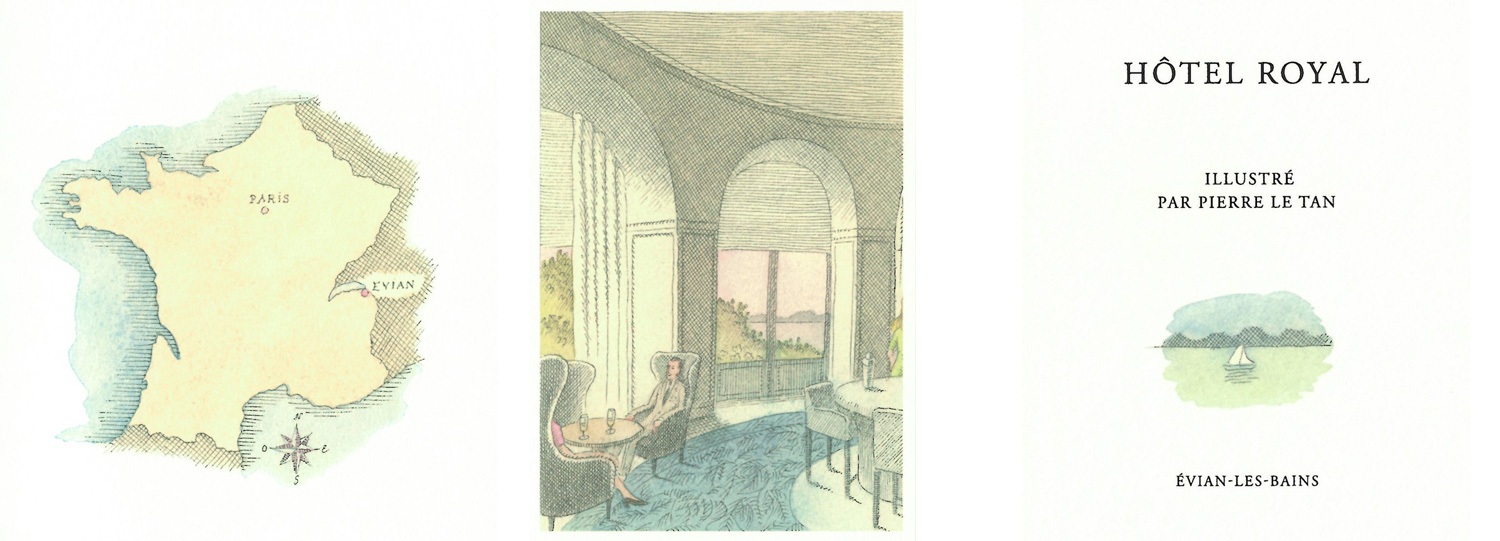 Pierre Le-Tan (1950–2019) was a distinguished French illustrator and painter, celebrated for his unique ability to encapsulate the charm and ambiance of various settings, notably hotels. Born in Paris to a Vietnamese father and a French mother, Le-Tan's multicultural heritage deeply influenced his artistic perspective. His father, Lê Phổ, was a renowned painter, which immersed Pierre in a world of art from an early age.
Pierre Le-Tan (1950–2019) was a distinguished French illustrator and painter, celebrated for his unique ability to encapsulate the charm and ambiance of various settings, notably hotels. Born in Paris to a Vietnamese father and a French mother, Le-Tan's multicultural heritage deeply influenced his artistic perspective. His father, Lê Phổ, was a renowned painter, which immersed Pierre in a world of art from an early age.
Le-Tan's illustrations are characterized by delicate lines, subtle color palettes, and a nostalgic aura that transports viewers to serene environments. His work often graced the covers of esteemed publications like *The New Yorker*, *Vogue*, and *Harper’s Bazaar*, showcasing his versatility and appeal.
One of his notable projects includes illustrations for the Hôtel Royal Évian, where he masterfully depicted the hotel's grandeur and tranquil surroundings. These artworks not only highlight the architectural beauty of the establishment but also evoke the serene atmosphere experienced by its guests.
Le-Tan's legacy extends beyond his illustrations; he was also an avid collector, amassing a diverse array of art and antiques that reflect his eclectic taste and artistic vision. His personal collection was so remarkable that it was featured in a Sotheby's auction, underscoring his profound appreciation for art in various forms.
In essence, Pierre Le-Tan's work offers a unique lens through which we can appreciate the intricate relationship between art and hospitality. His illustrations serve as timeless representations of hotel spaces, capturing their essence and inviting viewers to experience the subtle beauty of these environments.
Dan Sweeney's Hotels
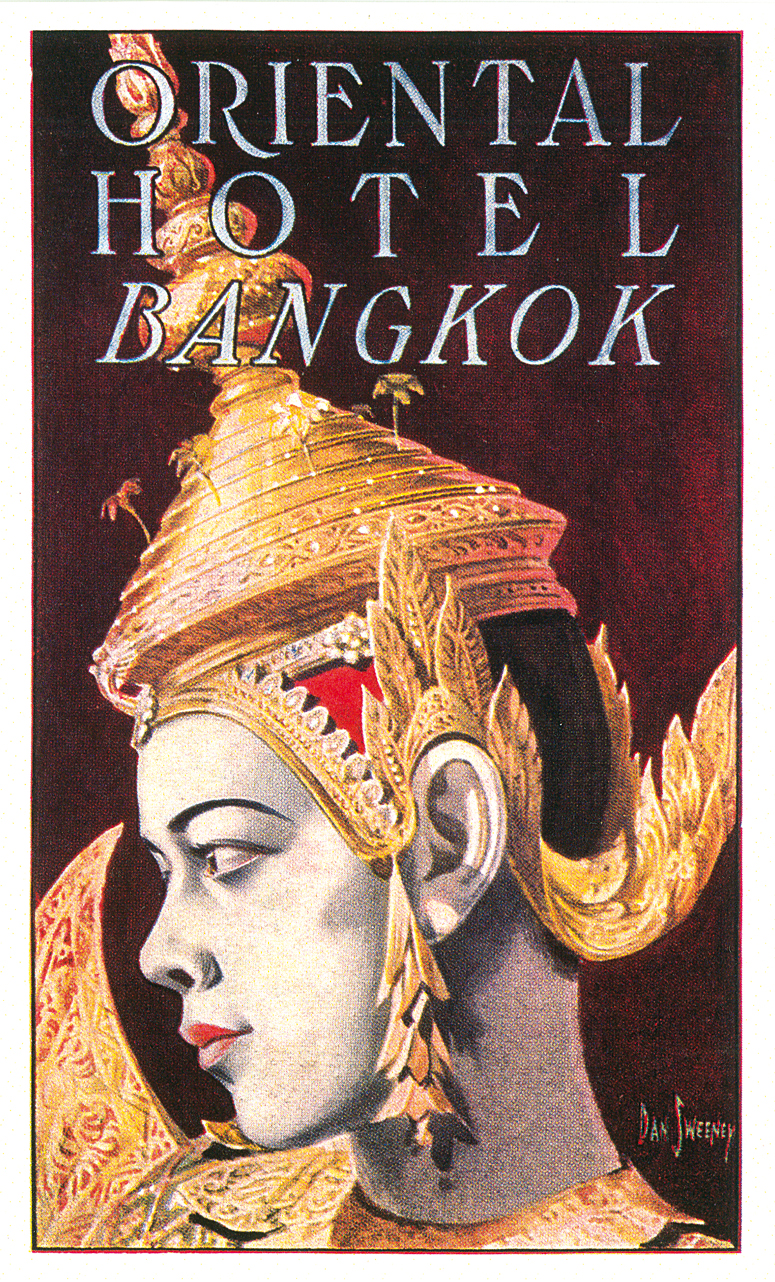
During the 1920s an American was the first to introduce the art of "hotel posters" to the leading hotels of Asia. He helped them to establish a corporate identity of a very special nature. His fine posters were used as labels or covers for hotel brochures.
His name was Daniel C. Sweeney (*1880, Sacramento, California, †1958). Sweeney was a seasoned illustrator with a track record going back to the San Francisco Chronicle and World Traveler Magazine. Sweeney also painted posters for theater lobbies, which led to doing travel posters. He began work for several steamship lines and traveled around the world, to many out-of-the-way places, doing background research for unusual poster subjects. One of his most successful series of pictures was of pirate subjects for the Grace Lines.
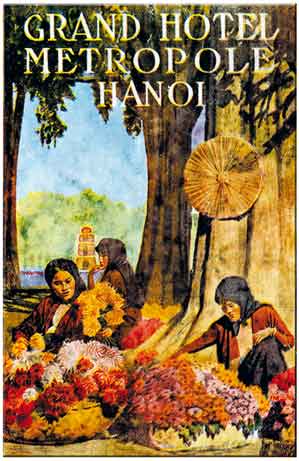
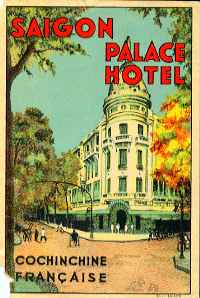 For many years, Sweeney was a steady contributor of fiction illustrations to Collier's magazine, particularly of sea and Western subjects rendered in wash or transparent water-colour.
For many years, Sweeney was a steady contributor of fiction illustrations to Collier's magazine, particularly of sea and Western subjects rendered in wash or transparent water-colour.
He was most likely discovered for Asia by The Oriental Hotel in Bangkok, where he created a poster depicting a Thai dancer. This poster soon graced the 1920s sales brochure of the hotel. Sweeney also drew posters for The Peninsula and the Hong-Kong Hotel as well as The Peak Hotel, Repulse Bay Hotel, all in Hong Kong; Grand Hotel des Wagons-Lits, Peking; Astor House, Shanghai; Majestic Hotel and Palace Hotel, both in Shanghai; the Continental Palace Hotel, Saigon; the Manila Hotel and the Metropole in Hanoi.
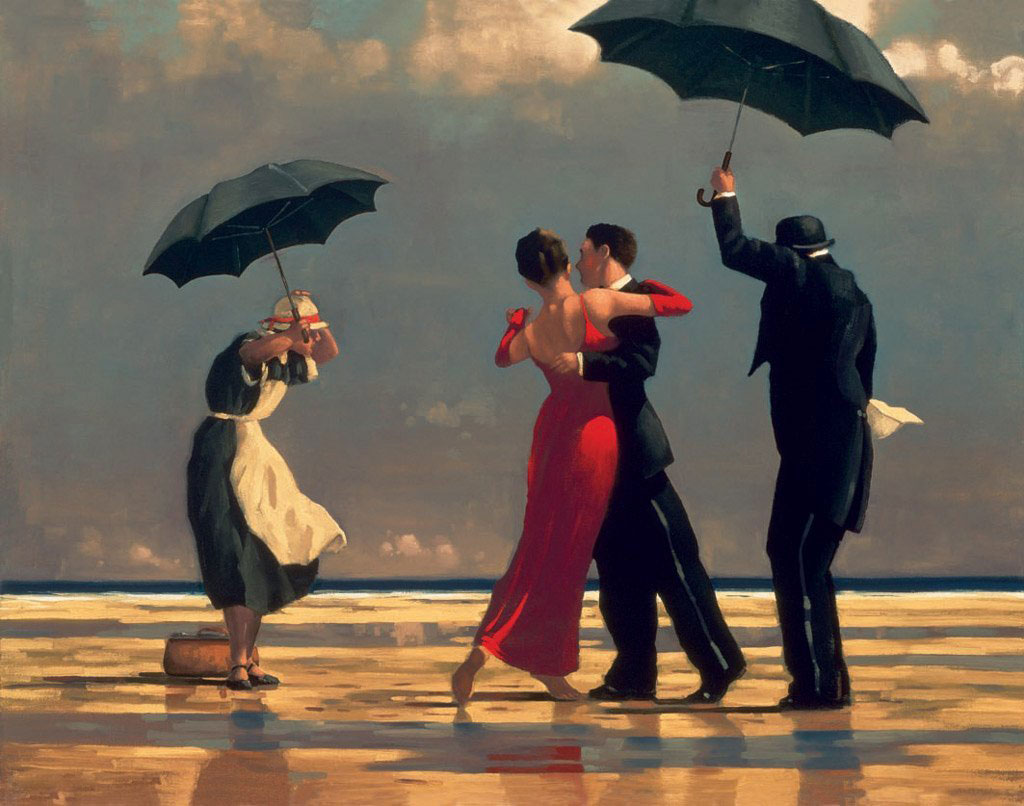
The Singing Butler is an oil-on-canvas painting by Scottish artist Jack Vettriano in 1992. One could argue if the Singing Butler is a subject of hospitality, but it certainly shows a dedicated butler and a maid, assisting their principals in a very special way.
What I find interesting is the fact that you can not see the butler actually sing. So we rely on the title which makes us believe that we see something that is in fact hidden.
From the web: It sold at auction in 2004 for £744,800, which was the record at the time for any Scottish painting, and for any painting ever sold in Scotland. No surprise reproductions of The Singing Butler make it the best-selling art print in the UK. It is by the way based on an image of actress Orla Brady posing in her own dress which was published in The Illustrator's Figure Reference Manual (1987) as part of a series of photographic figure studies. Vettriano's easel paintings cost between £48,000 and £195,000 new According to The Guardian he earns £500,000 a year in print royalties. Well deserved.
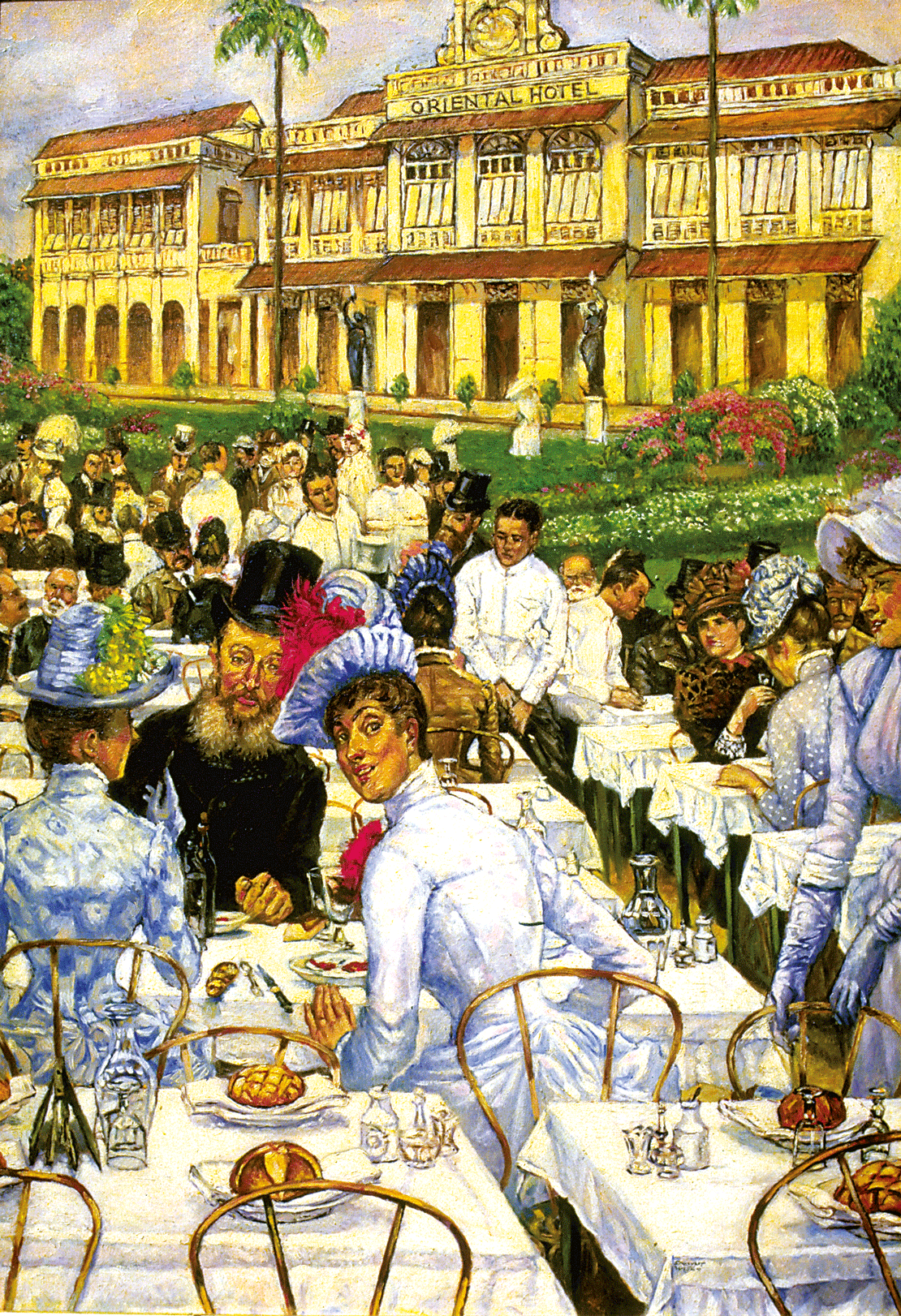
This is how one might imagine a Western gathering in front of the Oriental Hotel in Bangkok around 1900: high-necked dresses, stiff “father-killer” collars, and, to top it all off, hats. Painting by Australian artist Valerie O'Neill (1929-2010).
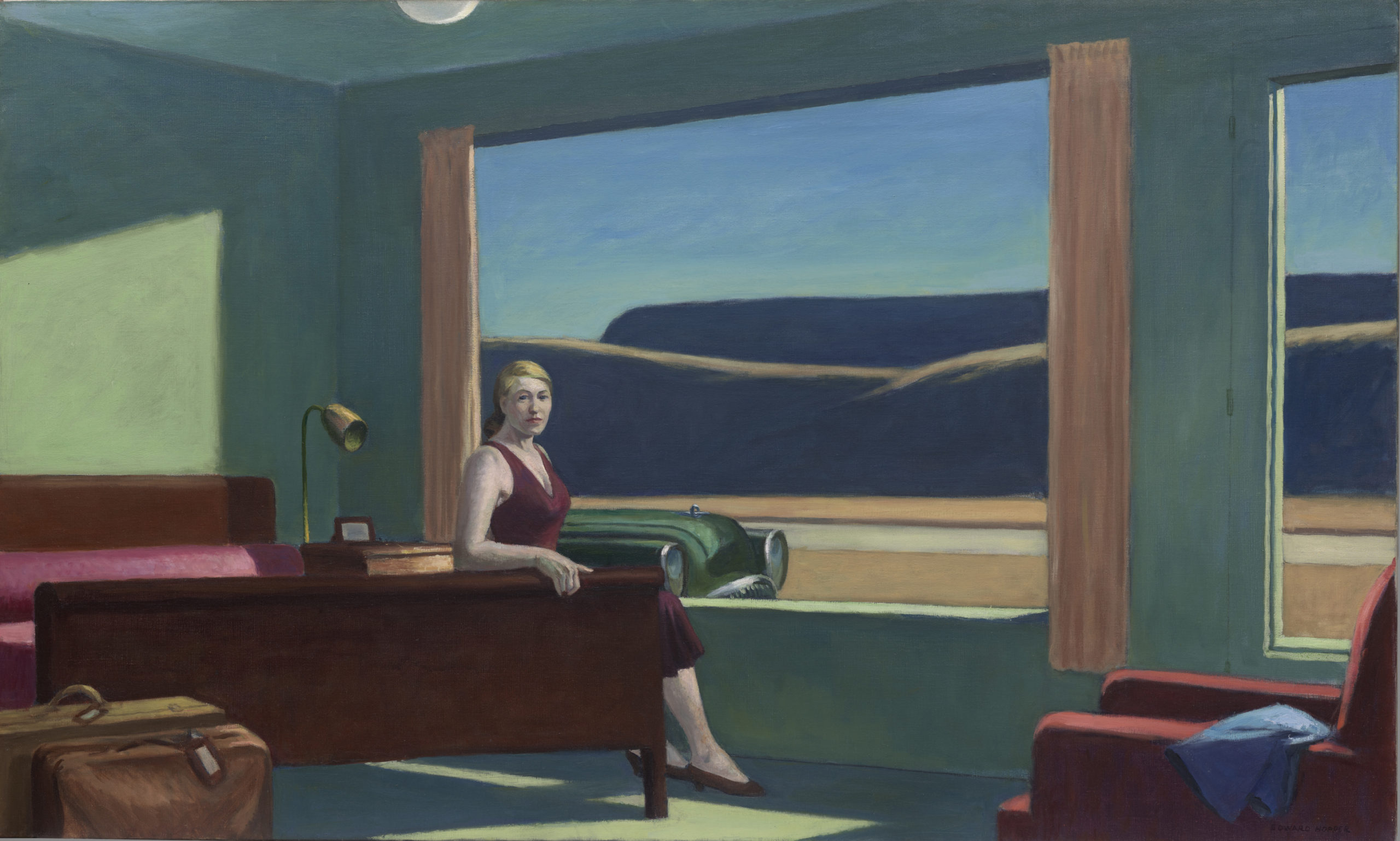
Edward Hopper, "Western Motel," 1957, oil on canvas, 30-5/8 × 50-1/2 in. Yale University Art Gallery, Bequest of Stephen C. Clarke, B.A., 1903, 1961.18.32 © 2020 Heirs of Josephine N. Hopper / Artists Rights Society (ARS), NY.
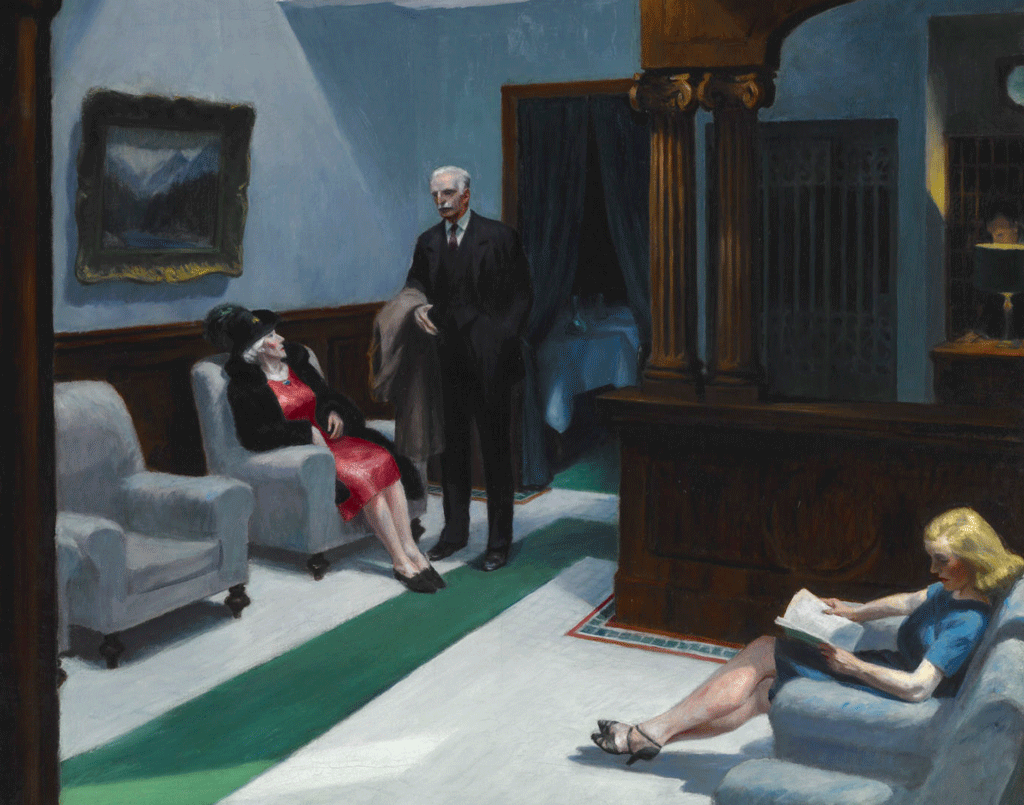
Hopper created subdued drama out of commonplace subjects layered with a poetic meaning, inviting narrative interpretations.
Edward Hopper “Hotel Lobby,” 1943, oil on canvas, 32-1/4 × 40-3/4 in. Indianapolis Museum of Art at Newfields, William Ray Adams Memorial Collection, 47.4 © Edward Hopper.
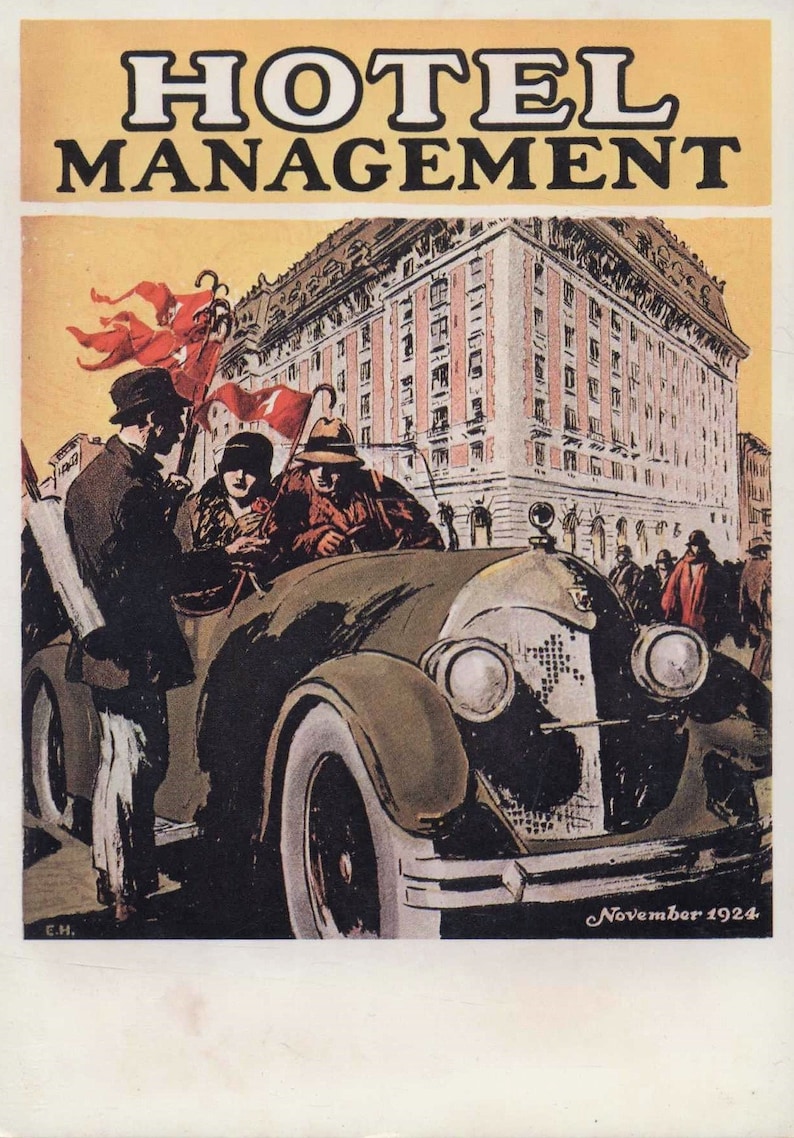
Edward Hopper is another famous painter capturing the business of hospitality.
Edward Hopper (July 22, 1882 – May 15, 1967) was an American realist painter and printmaker. Known for his oil paintings, he was equally proficient as a watercolorist and printmaker in etching.
His art work graced the covers of the American magazine HOTEL MANAGEMENT during the 1920s. Here's is one sample of his fine art.
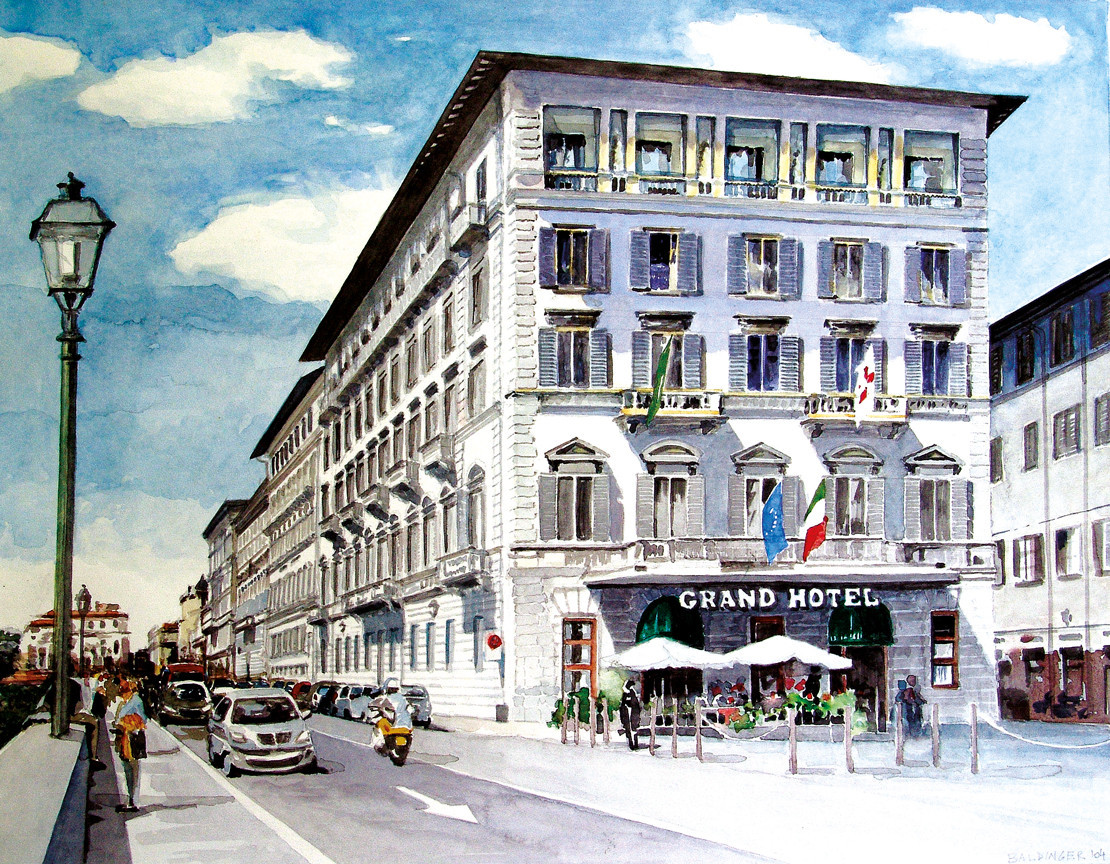
Grand Hotel Florence by Austrian artist Peter Baldinger served as cover for the book by Andreas Augustin.
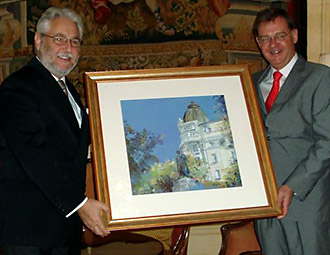 Handing over the original cover painting of the Hotel Ritz in Madrid by Manfred Markowski to general manager Anton Küng at the presentation of the book HOTEL RITZ MADRID (2011, to the right Andreas Augustin)
Handing over the original cover painting of the Hotel Ritz in Madrid by Manfred Markowski to general manager Anton Küng at the presentation of the book HOTEL RITZ MADRID (2011, to the right Andreas Augustin)
Formality vs. Function: Western Attire in the Tropics, 1900
( words)
Around 1900, Western men in tropical regions like the Kingdom of Siam often dressed in outfits that, while reflecting their European origins, were far from ideal for the climate. These included heavy, woolen suits, high-collared shirts, and ties, all intended for formal wear in the European tradition. Light-coloured linen or cotton suits were a slight adaptation, but the overall effect remained formal and restrictive, with the typical look often completed with pith helmets, which were believed to offer sun protection but were cumbersome in the heat.

This is how one might imagine a Western gathering in front of the Oriental Hotel in Bangkok around 1900: high-necked dresses, stiff “father-killer” collars, and, to top it all off, hats. Painting by Australian artist Valerie O'Neill (1929-2010).
In contrast, locals dressed in loose, breathable clothing suited to the tropical climate. Traditional attire for men often consisted of wrap-around garments such as the chong kraben, a type of sarong, or other light, draped fabrics that allowed air circulation and comfort in the heat and humidity. The simplicity and breathability of local clothing made it far better adapted to the tropical environment, allowing for more comfort and freedom of movement. This contrast highlighted the Western adherence to social norms over practical adaptation, a distinction that would gradually evolve as Westerners learned to adopt elements of local dress to cope better with the heat.
Oriental-Mania
( words)
The Orient evokes 1001 associations in us. Around 1900, the Orient was a myth to many. Hotels were baptised 'De L'Orient' or 'Oriental' and inspired legends and fables. In hospitality industry, the myth eventually became synonymous with its associated cities and countries. For most of us, today, the term Oriental Hotel appears to be linked to the city of Bangkok. In fact, many believe that there always was only one Oriental Hotel.
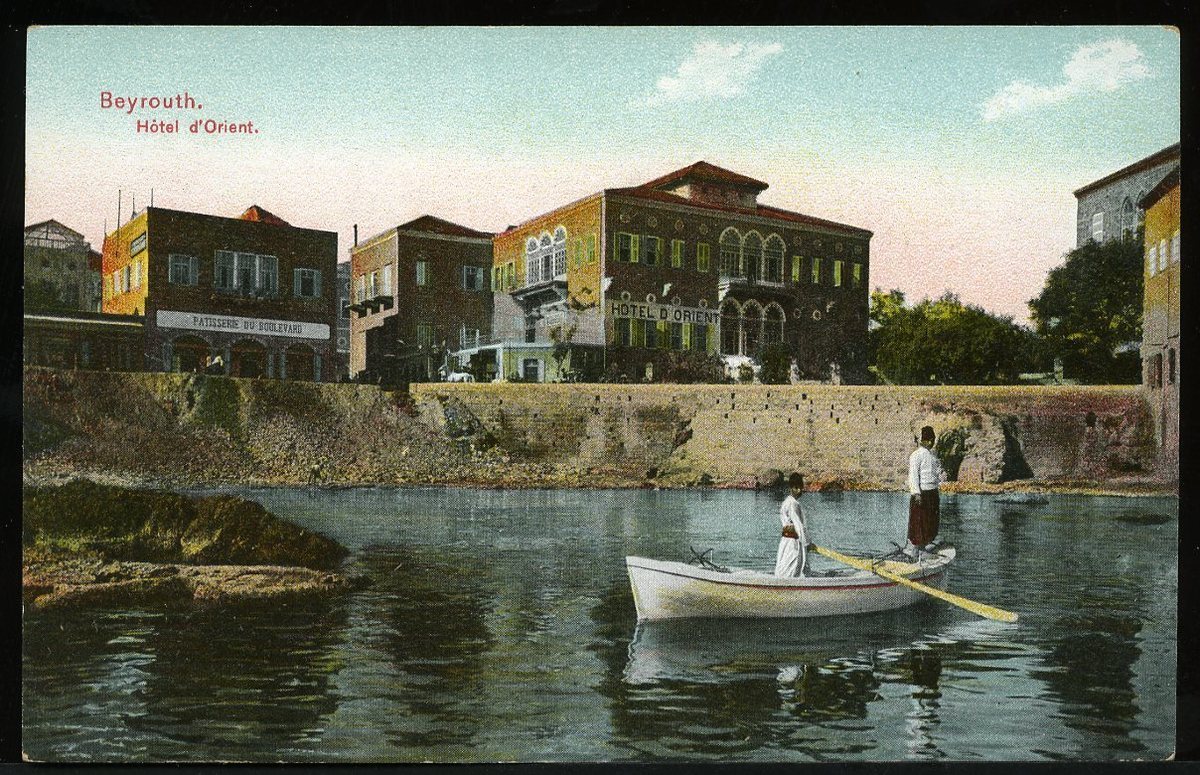
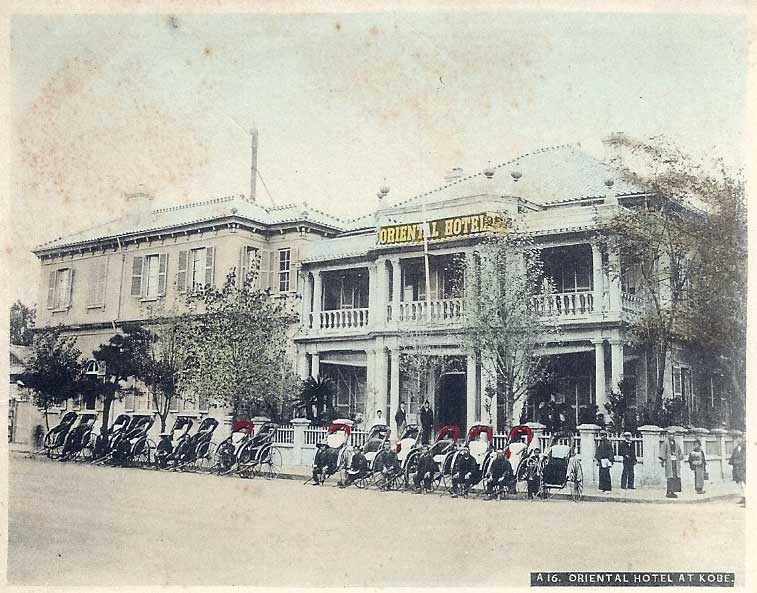
JAPAN KOBE THE ORIENTAL HOTEL — a modest start
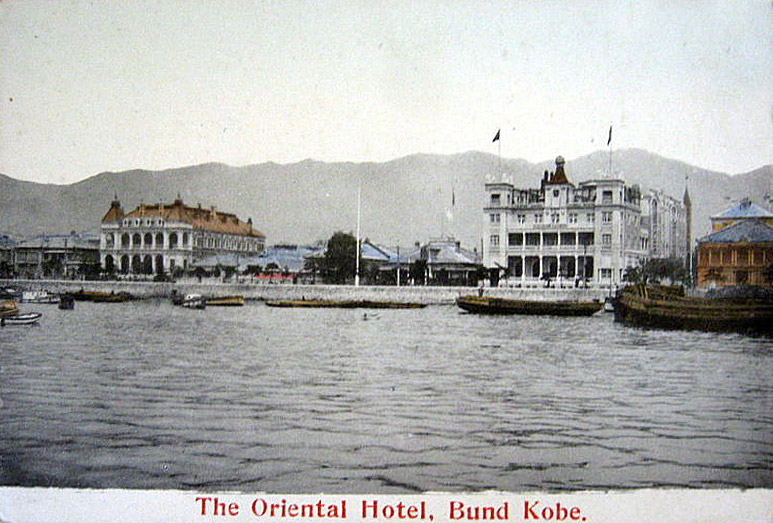
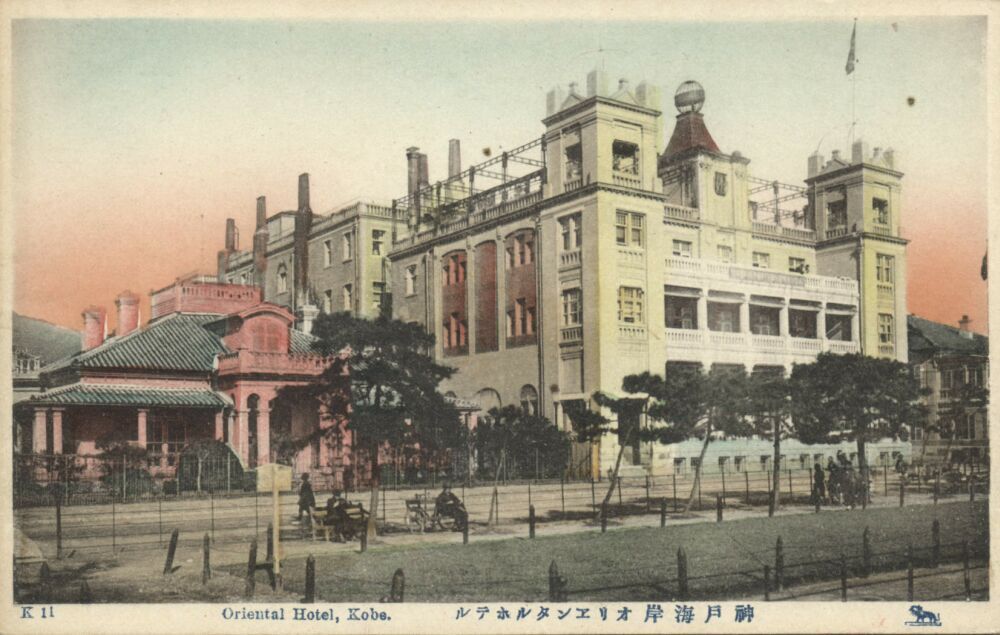
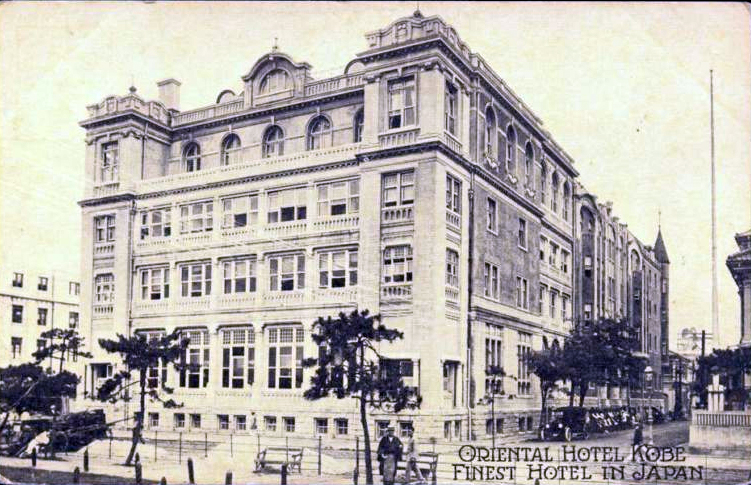
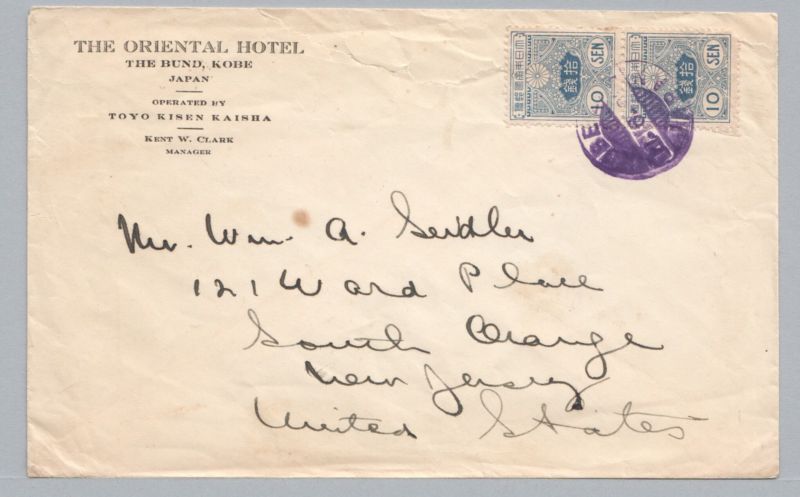
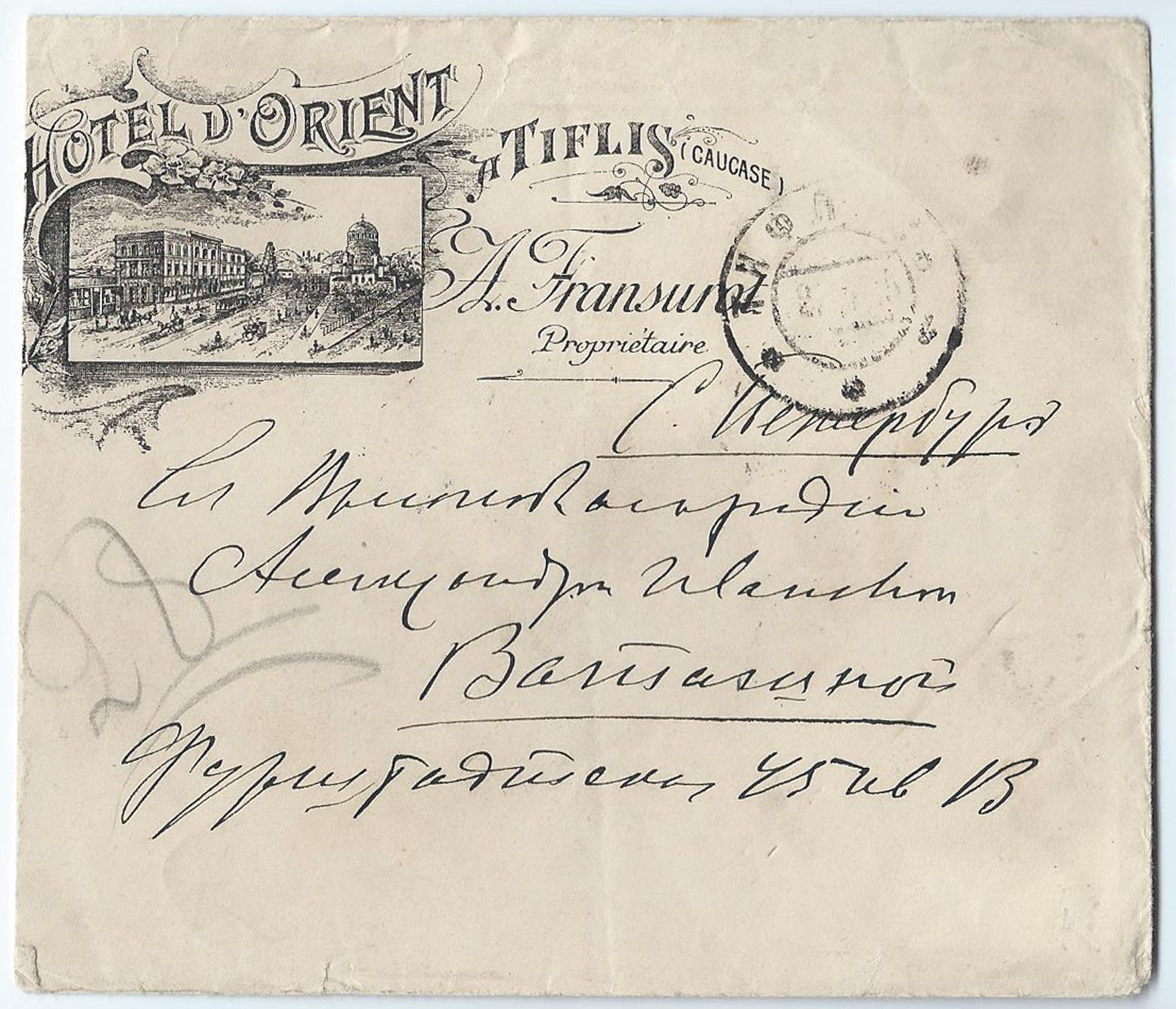
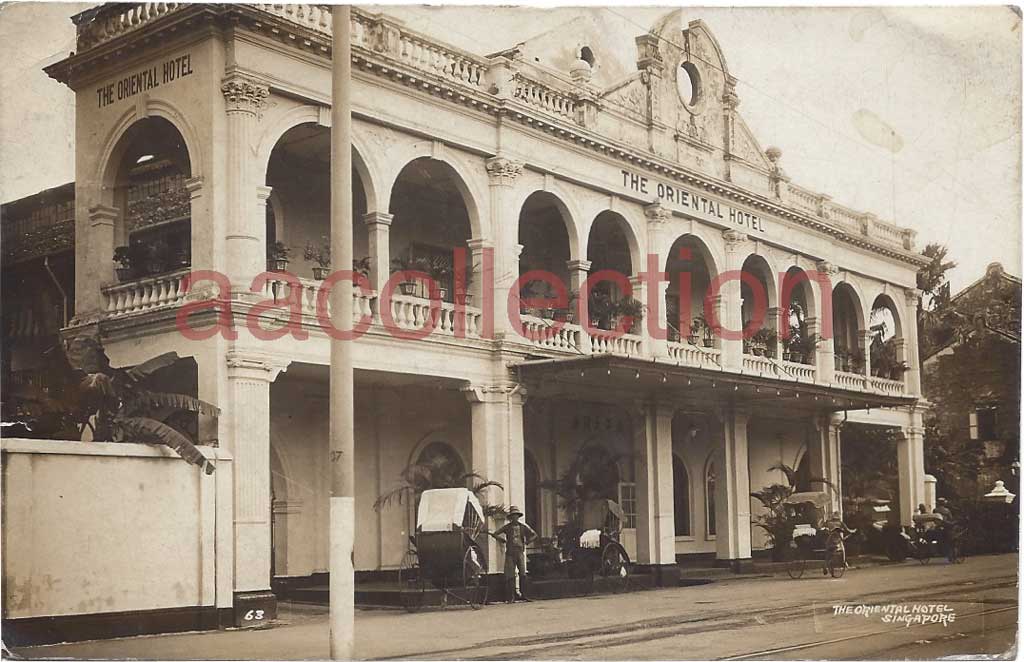
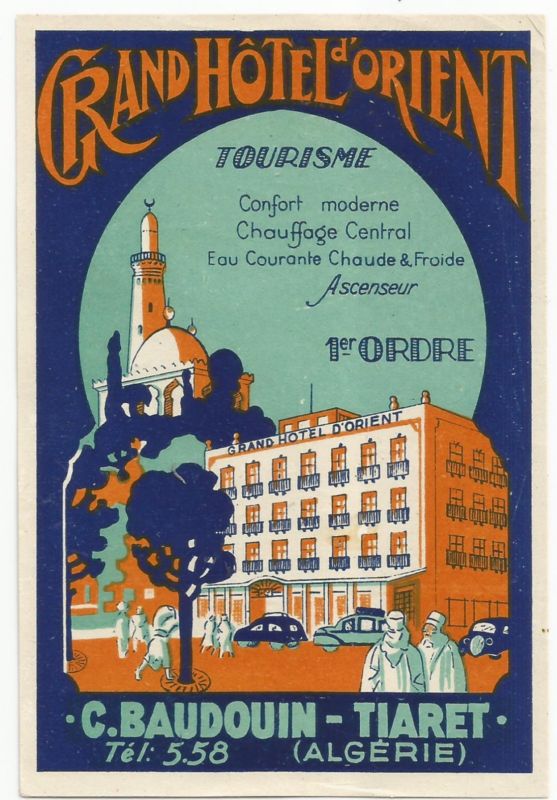
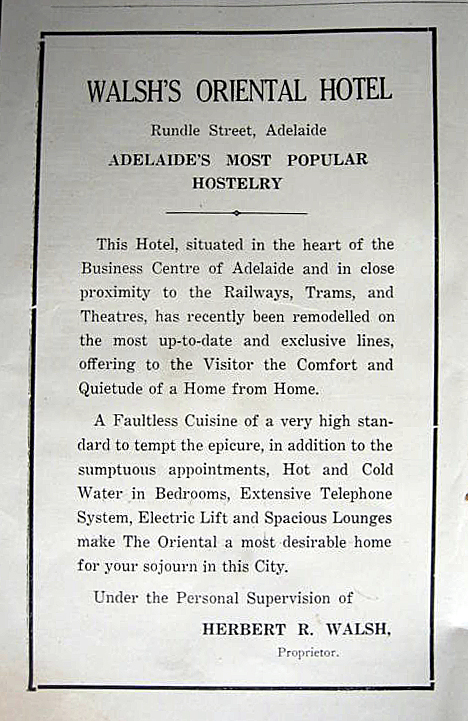
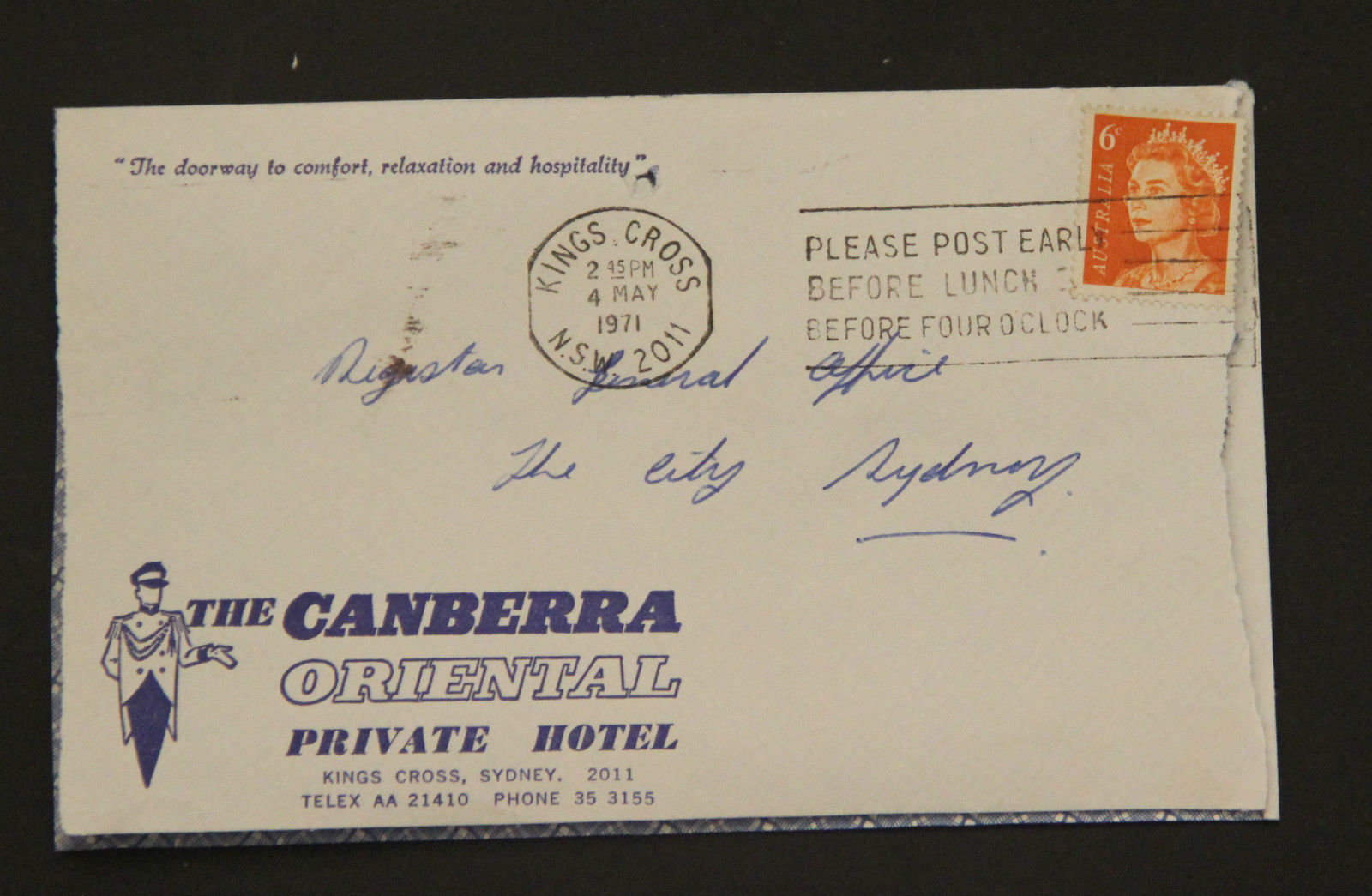
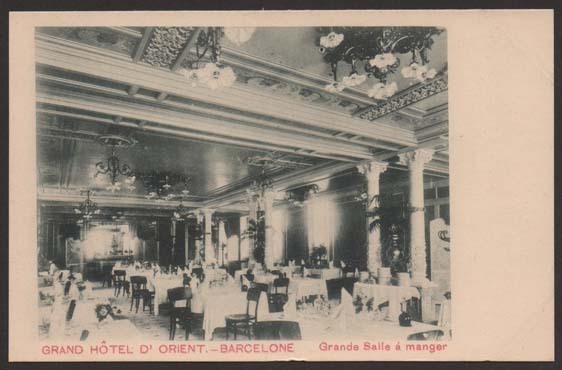
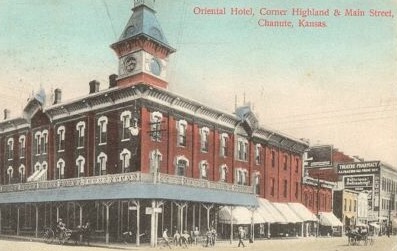
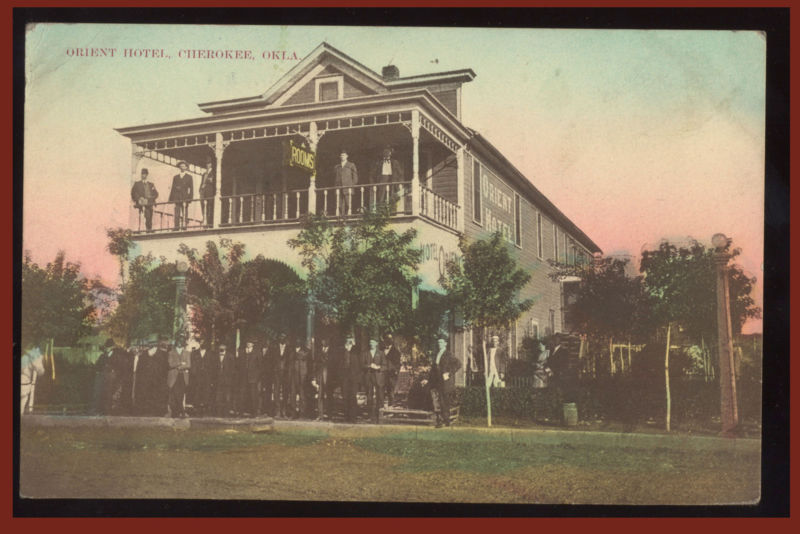
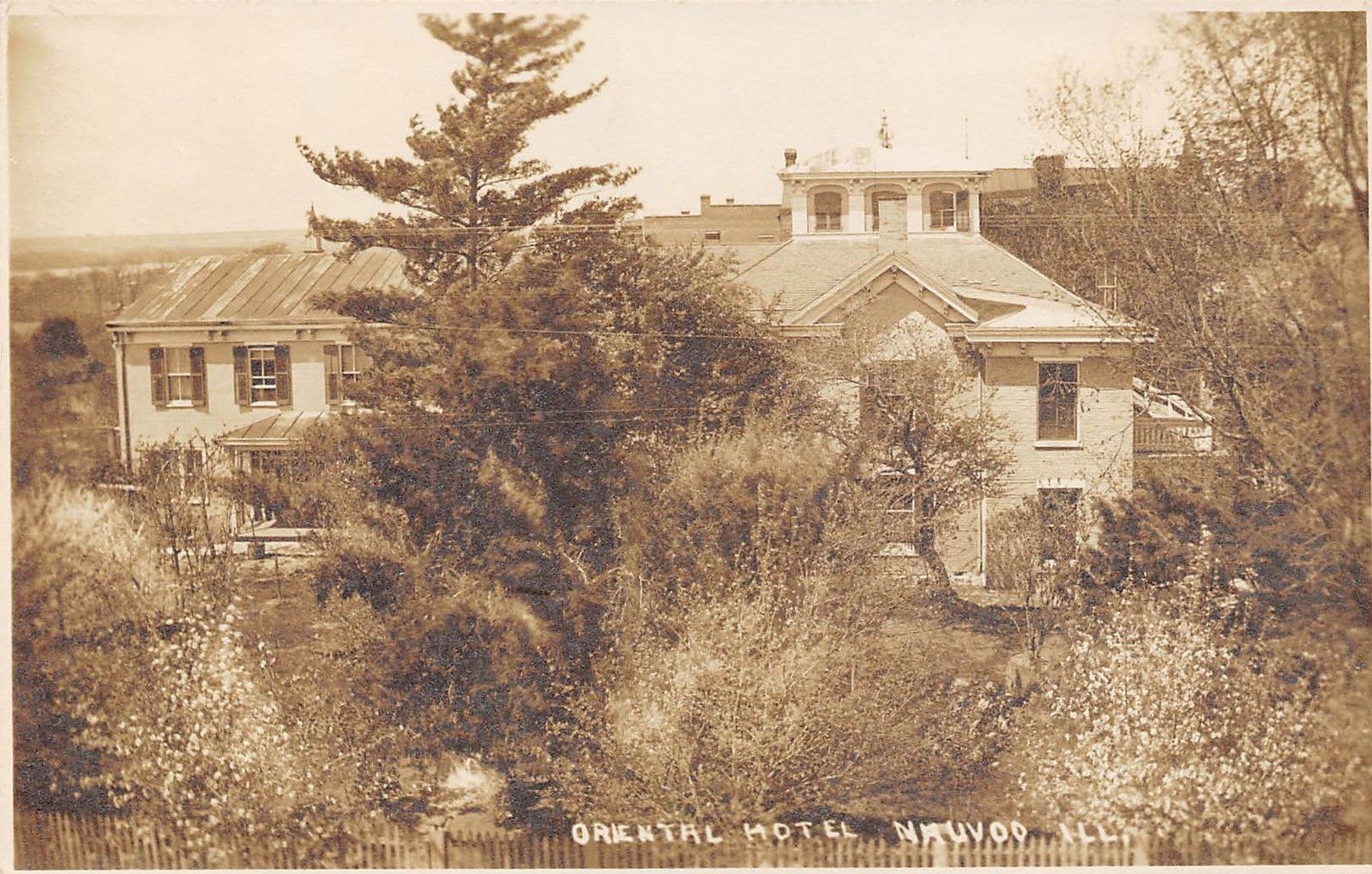
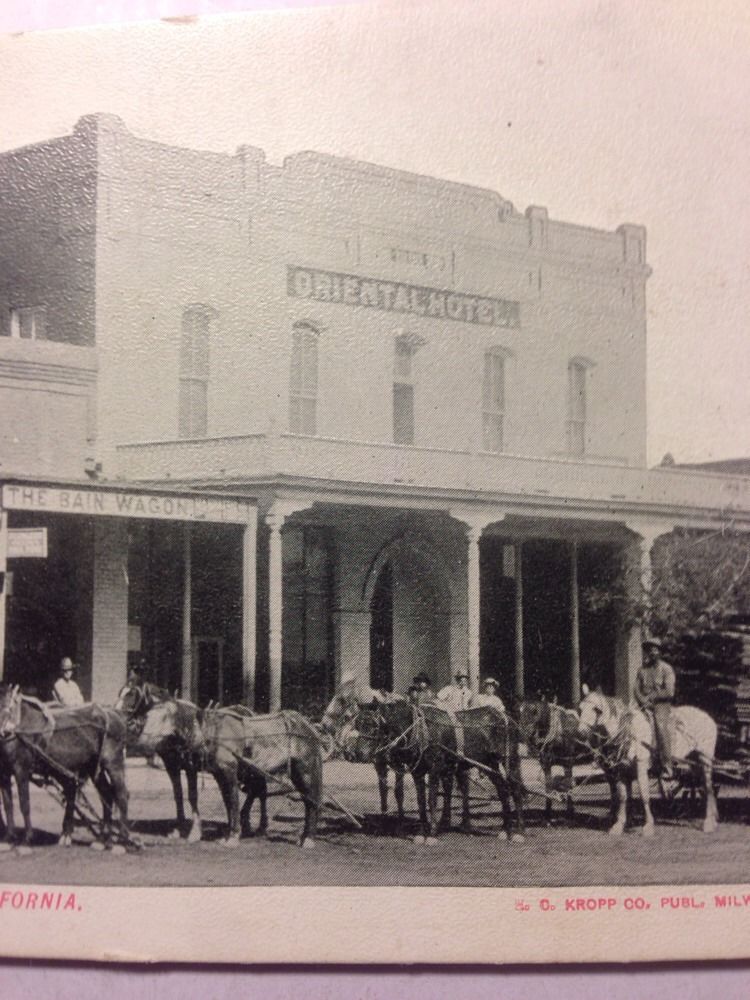
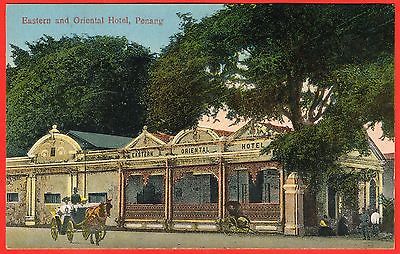

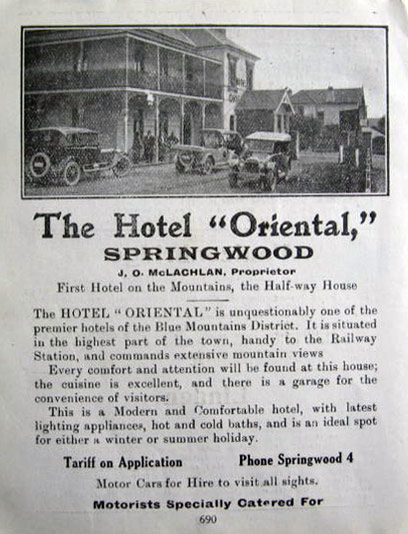

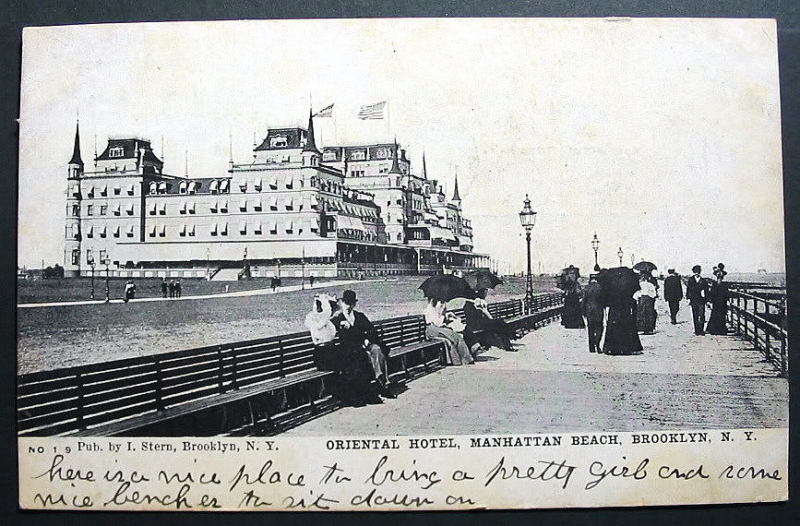
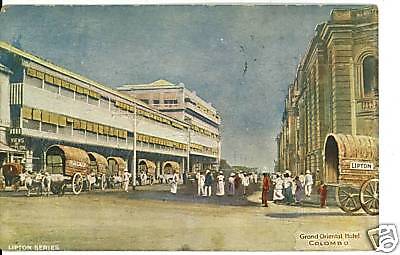
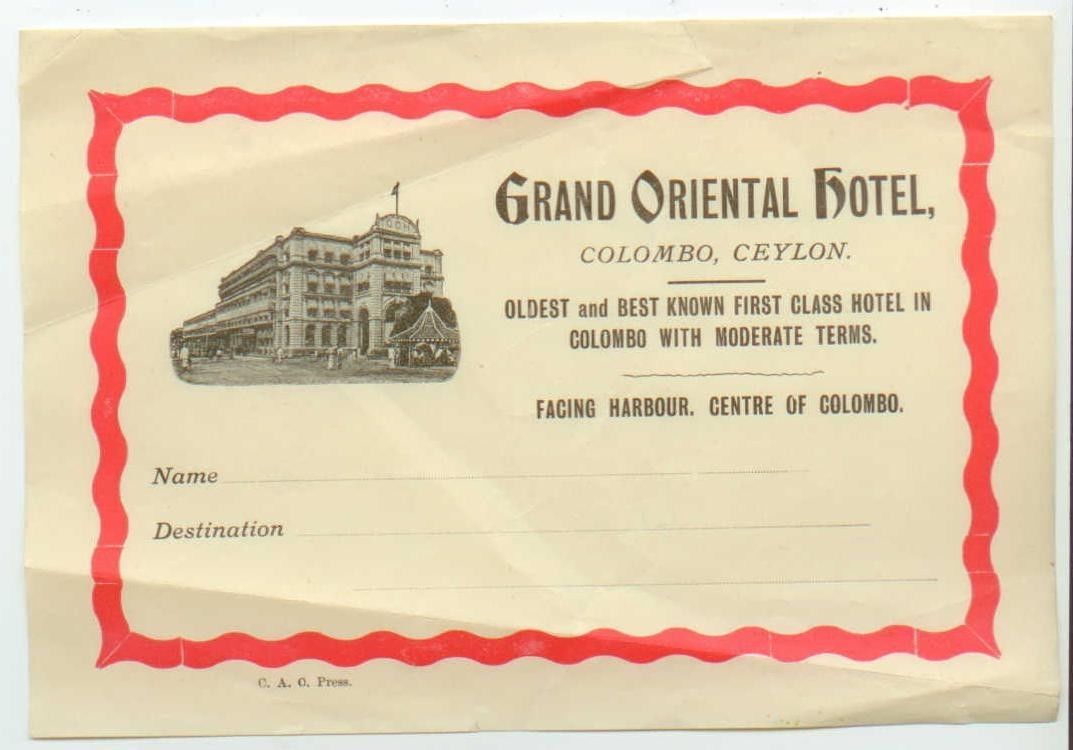
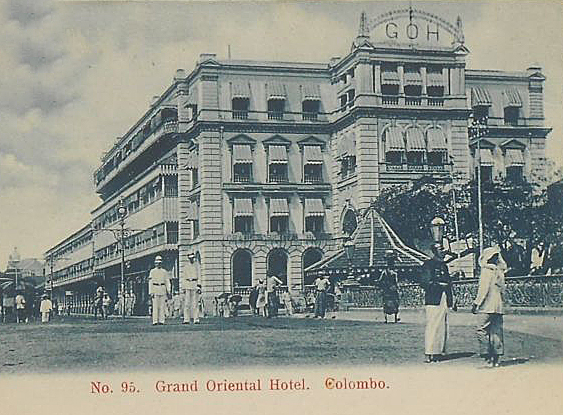
GRAND ORIENTAL HOTEL COLOMBO (it still exists today)
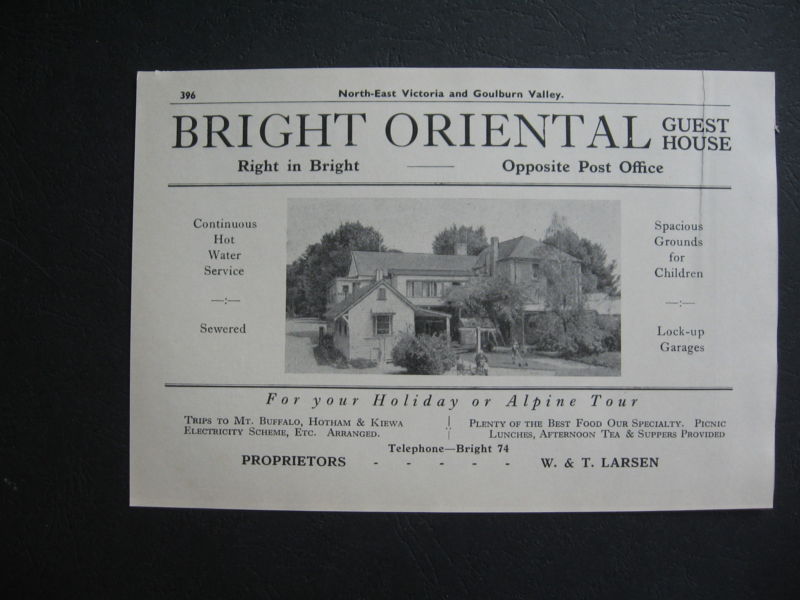
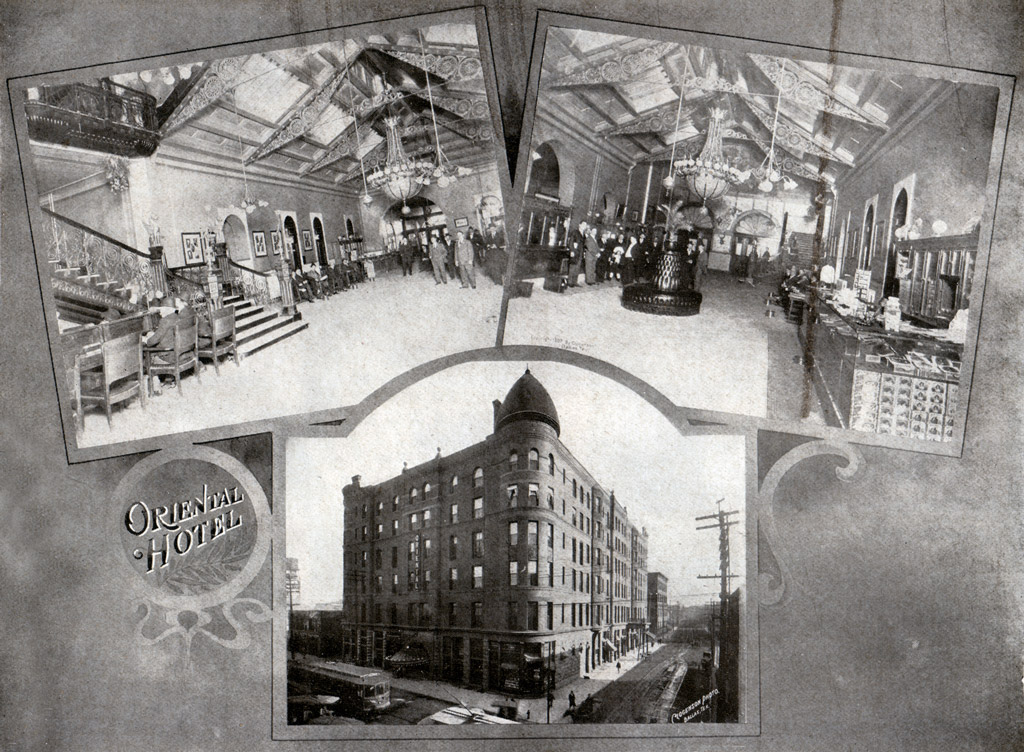
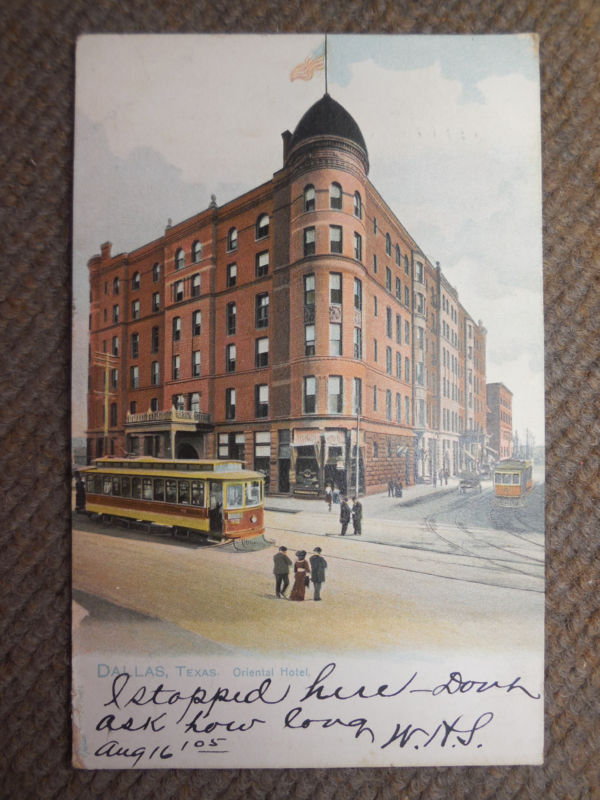
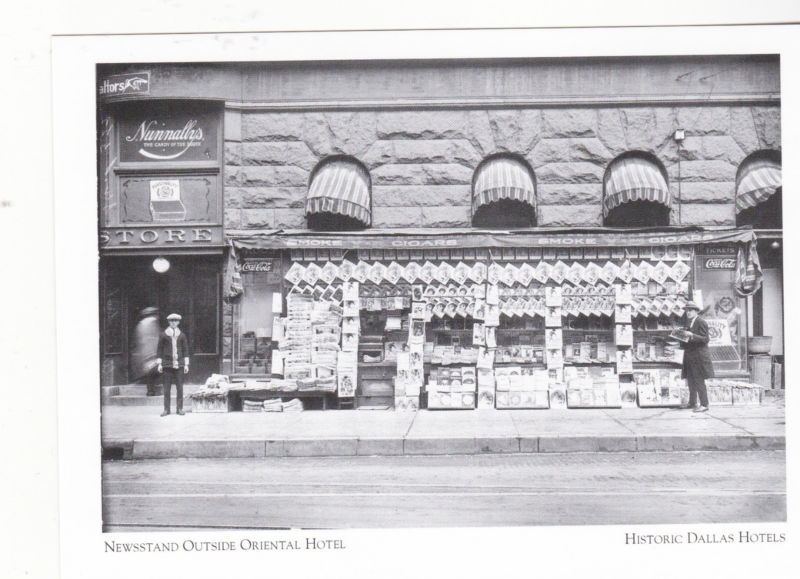
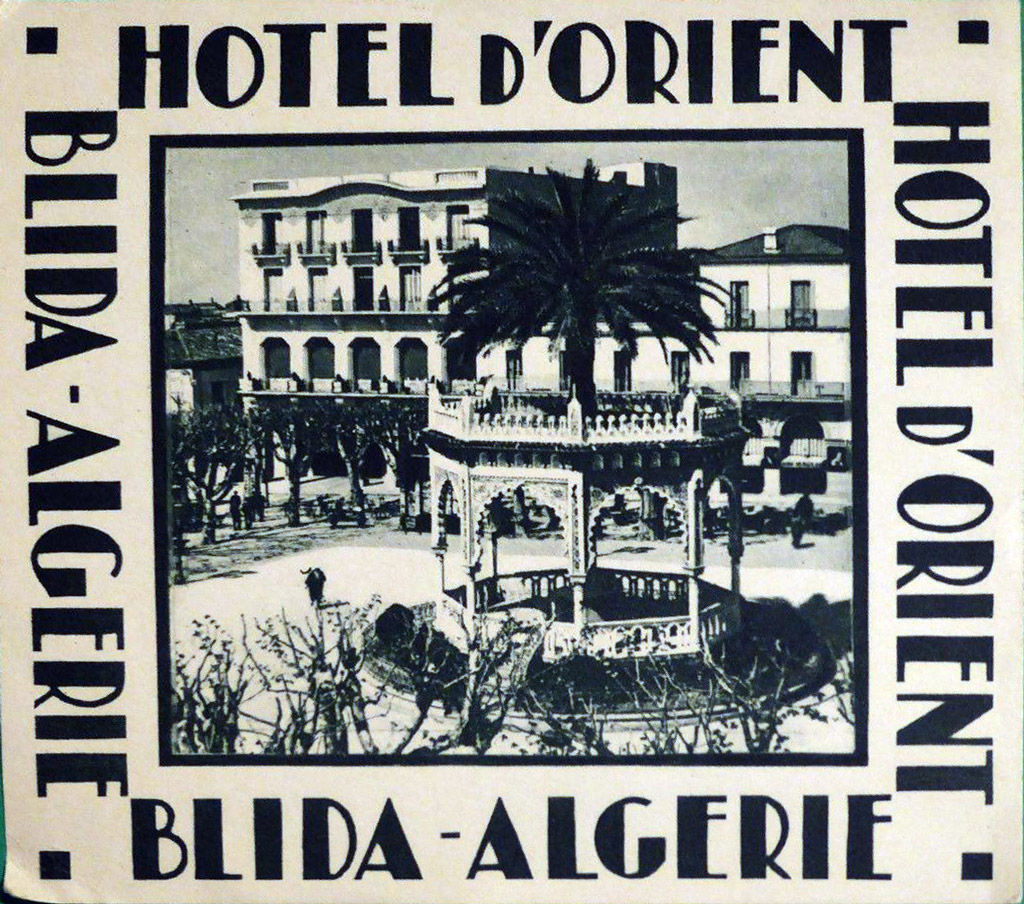
… and finally, one more legend: the New Oriental in Galle, Ceylon (now, of course, Sri Lanka). It was renowned for being neither new nor oriental.
Her name was Nesta Brohier, the proud owner and operator of The New Oriental Hotel, and we all adored her. Every classic hotel joke fit perfectly: "There wasn’t a single mosquito (they came in swarms)," or "24-hour room service referred to the time it took for a club sandwich to appear."
Travellers fell for the heavy Dutch armchairs on the terrace, with their wooden flaps to rest your legs, as you leafed through “the latest” newspapers that were at least four weeks old.
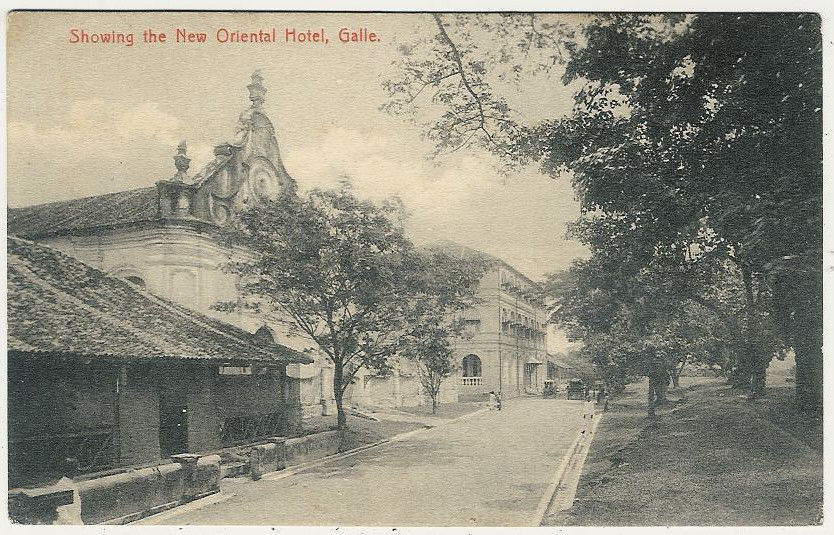
The New Oriental Hotel (in the background).


Books for Students
( words)
We provide hotel management schools/universities worldwide with our collection of historic hotel books. Beneficiaries include IMC Krems, Klessheim College of Hotel Management, Cornell University, and Ecole Hôtelière de Lausanne, among over 100 prestigious institutions.
This collaboration offers students unique insights into the vital role of history within hospitality, empowering future leaders to confidently communicate their hotel’s heritage and deepening their understanding of the industry’s global evolution. History, often an overlooked unique selling point (USP), becomes a potent asset in a competitive market when skilfully leveraged.
Books are donated to institutions for the benefit of all students, accessible through the library.
How to apply;
1. Contact us with your institution’s details.
2. We verify your request.
3. You receive a list of books for donation.
4. You agree to cover handling and shipping costs.
5. We send the books.
For more information, contact us at:
From Trunks to Trolleys - A Short History of Luggage
( words)
A Short History of Luggage: From Trunks to Trolleys
(blog in progress - to add to this knowledge base please write to editor at famoushotels dot org)
Luggage has evolved dramatically over centuries, from simple trunks to modern, lightweight carry-ons. This post-in-progress explores the history of luggage, focusing on the evolution of materials, luxury travel, and famous luggage brands. From the days when servants and porters carried trunks to the modern trolley effortlessly gliding over marble floors, luggage tells a story of how we travel.
1. Evolution of Materials
In the early days of travel, luggage was not just a tool for carrying belongings but a reflection of one's social status. In the 18th and 19th centuries, wooden trunks reinforced with leather and metal were popular, often carried by servants or porters. Aristocrats and wealthy travellers required trunks large enough to carry entire wardrobes, and such pieces were often crafted from the finest materials.
As travel modernised in the 20th century, lighter materials such as aluminium and plastic replaced heavy wood and leather. Today, polycarbonate, known for its balance of strength and weight, dominates the luggage industry. Modern travellers seek not only durability but also ease of transport.
2. Luxury Travel and the Rise of Trunks
In the golden age of travel, luxury was paramount. During the era of postcoach and horse-drawn carriages, well-to-do travellers didn’t carry their own belongings. Instead, a team of porters and servants handled the task, ensuring that wardrobes filled with gowns, hats, and accessories arrived intact at grand destinations.
Celebrities like Marlene Dietrich were known for travelling with up to 12 pieces of luggage, including her famous hat boxes. These were not mere suitcases but bespoke creations, often designed by legendary houses such as Louis Vuitton. Each piece was a testament to the craftsmanship of the time: leather, brass locks, and gold embellishments were standard. These were items to be displayed, not hidden.
3. The Golden Age of Travel
The late 19th and early 20th centuries marked the height of luxury travel. The grand hotels and luxury liners of this era catered to an elite clientele that expected the highest standards. Trunks were transported by ship, rail, or carriage, often filling entire compartments.
Porters carried luggage into lavish suites, arranging belongings with precision. The aristocracy, diplomats, and stars of the silver screen expected nothing less. A journey was not merely a transfer from point A to point B but an experience in itself, and luggage was a critical part of that experience.
4. From Trunks to Trolleys: Modern Luxury
Today, the world of luxury travel has evolved. While the need for massive trunks has disappeared, the desire for refined travel accessories has not. In the lobby of a grand, historic hotel, the sound of a four-wheeled trolley gliding over polished marble floors signifies the ease of modern luxury. Porters are no longer required to carry heavy trunks, as sleek, lightweight hand luggage trolleys now serve that purpose.
Guests no longer rely on an army of servants, yet the elegance of travel remains. The luggage may be lighter, but the legacy of travelling in style continues to live on in the world’s most famous historic hotels.
The Extended Journey: Seasons Away
In earlier times, journeys often took weeks or even months. Travellers would move not just for a short holiday but for an entire season. The wealthy required entire wardrobes, suited for every occasion, from morning coats to night gowns, black tie attire, and evening wear.
Servants played a critical role in ensuring the smoothness of their master’s travel experience. They often arrived a day earlier to unpack trunks, ensuring that each item was perfectly placed in the wardrobe, the linens were pressed, and everything was in order before the master arrived. Every detail was attended to, with the highest standards of elegance and precision.
The Modern-Day Glamour: Porters and Private Planes
Still today, in the lobbies of grand hotels, it is not unusual to see a matching set of ten exquisite suitcases waiting to be loaded into a private plane. The tradition of refined travel persists, and though the luggage has become lighter, the grandeur has remained intact.
When such an occasion arises, the porters make certain to be on duty, ready to handle the luggage of these discerning travellers. Whether it’s whisked away to a private jet or carefully placed in a luxury suite, the timeless elegance of travel is never lost.
The leading luxury luggage producers in the world:
Bric’s – Italy, Como
An Italian luxury luggage company blending elegance and practicality.
Fendi – Italy, Rome
A renowned fashion house producing high-end luggage and accessories.
Globe-Trotter – United Kingdom, London
Established in 1897, known for its handmade lightweight suitcases.
Goyard – France, Paris
One of the oldest Parisian trunk-makers, famed for its exclusivity and craftsmanship.
Hartmann – United States, Milwaukee, Wisconsin
Founded in 1877, known for luxury leather goods and durable luggage.
Louis Vuitton – France, Paris
Synonymous with luxury travel since 1854, famed for its monogrammed trunks.
Montblanc – Germany, Hamburg
Known for pens, watches, and luxury luggage with a focus on craftsmanship.
Mossman Trunks – United Kingdom, Leeds
A heritage brand known for its durable, handmade trunks since the 1930s.
Prada – Italy, Milan
A luxury fashion brand producing high-end travel accessories and minimalist luggage.
Rimowa – Germany, Cologne
Famous for its distinctive grooved aluminium suitcases, established in 1898.
Samsonite – United States, Denver, Colorado
Founded in 1910, known for innovative, durable luggage designs.
Smythson – United Kingdom, London
Known for its elegant leather goods and luxury luggage.
T. Anthony – United States, New York City
Founded in 1946, known for handcrafted luggage favoured by celebrities and royalty.
Tumi – United States, Edison, New Jersey
Known for practical and innovative designs, catering to luxury and business travellers.
Valextra – Italy, Milan
An Italian luxury brand known for minimalist, high-end leather goods and luggage.
Zero Halliburton – United States, Los Angeles, California
Known for sleek, durable aluminium cases, founded in 1938 by American industrialist Erle P. Halliburton, the brand originally designed cases to protect delicate equipment in harsh environments. Its iconic aluminium briefcases and luggage became popular for their durability and security, even being used by NASA to carry lunar rock samples back to Earth. Today, Zero Halliburton remains a symbol of high-end, secure, and stylish travel gear, combining aerospace-grade materials with modern design.
- accessories
- aluminium
- aristocracy
- aristocrats
- black
- brands
- bric's
- bric’s
- carriages
- celebrities
- coat
- compartments
- craftsmanship
- dietrich
- diplomats
- durability
- elegance
- embellishments
- exclusivity
- explorers
- fendi
- floors
- globe-trotter
- gold
- gown
- gowns
- goyard
- grand
- hats
- history
- hollywood
- horse-drawn
- hotels
- jet
- leather
- locks
- louis
- luggage
- luxury
- marble
- marlene
- materials
- metal
- morning
- night
- planes
- plastic
- polycarbonate
- porters
- prada
- private
- quality
- rail
- rimowa
- samsonite
- servants
- ships
- smythson
- style
- suitcases
- suites
- t. anthony
- tie
- transport
- travel
- travellers
- trolleys
- trunks
- tumi
- valextra
- vuitton
- wardrobes
- wealthy
- zero halliburton
“I hope he is not going to die at my hotel!”
( words)
Fatal last stays at hotels are of course part of the business, however, the hoteliers main concern is always: "I hope he/she is not going to die at my hotel!"
"See Naples and Die". Enrico Caruso, star-tenor of the past century, took this catch phrase to heart and died at the Grand Hotel Vesuvio in Naples on 2 August 1921. He died of an abscess that brought on peritonitis. Until today, the management is happy about the kindness of the super star, as thousands of visitors are lured to the hotel in memorial of t heir great singing idol.
heir great singing idol.
On 11. February 2012, Whitney Houston, one of America's most successful singers, has died aged 48 in a suite on the fourth floor of the Beverly Hilton Hotel in Los Angeles where she was a guest. She was pronounced dead at 3.55pm local time.
John Belushi was just 33-years-old when he died from a drug overdose at the Chateau Marmont hotel off the Sunset Strip in L.A. Actors Robert De Niro and Robin Williams apparently had gone to see him in Bungalow 3 just before he passed away.
Janis Joplin also died in a Los Angeles hotel. She died from an overdose in 1970 at the Landmark Hotel – which is now the Highland Gardens Hotel. Anna Nicole Smith was found unresponsive in room 607 of the Seminole Hard Rock Hotel and Casino in Miami in 2007. She was rushed to hospital but pronounced dead an hour after the 911 call had been placed.
The Ritz in Paris had reason to turn away luminaries from the stage and screen, especially after the famous silent-screen actress Olive Thomas reputably died in one of its rooms in 1920. For many years, the cause remained cloaked in secrecy. A more recent version of the mini-scandal claims that an apparently drunk and distressed Olive Thomas accidentally ingested a large dose of mercury bichloride that had been prescribed for her playboy husband Jack Pickford’s chronic syphilis. She actually died several days later at the American hospital and not in the Ritz itself. Of course, The Ritz is for ever associated with the tragic deaths of Dodi Al-Fayed and Princess Diana, but it was merely the starting point, not the scene of the tragedy.
Some other famous people have spent their last hours at the Ritz in less than ideal circumstances. Pamela Churchill Harriman’s early years were pretty wild: as a teenager, she was personally introduced to Hitler. She married Randolph Churchill before turning twenty. She had several other marriages and affairs, all to men of prominence, including the son of Aga Khan III, and the son of Baron Robert Phillippe de Rothschild. In 1971 she married one of her previous lovers, American millionaire Averill Harriman. A successful fundraiser for the Democratic Party, Pamela Harriman was appointed Ambassador to France in 1993 by President Bill Clinton. Aged 77, she died after having a heart attack while taking her customary morning swim in the Ritz’s pool. President Chirac was at the Elysée Palace nearby when he heard the news, and rushed over. As always, the Ritz handled the death with tact and discretion.
Fashion legend Coco Chanel also died at the Ritz Hotel in Paris in 1971 at the age of 87. The esteemed fashion designer had lived at the hotel for three decades.
Before we turn The Ritz into one big cemetery, let’s quickly look at Bangkok. Here, a deadly dramatic story almost ended in disaster but narrowly escaped.
In 1923, the manageress of The Oriental Hotel in Bangkok had serious worries about writer Somerset Maugham, who had conducted malaria. "I hope he is not going to die at my hotel!" she remarked to the doctor, right outside of the room of the patient. Maugham recovered soon and spent so much time at the hotel, that The Oriental has enough reason to name one of her best suites after him. Reconvalescent he spent more weeks at the hotel and left us a cute short story, certainly written at The Oriental.
Three Funerals and one Birth
The Beau Rivage in Geneva, Switzerland, is certainly famous for being one of the leading (and for almost all of its career family run) luxury hotels of Switzerland. However, three tragic death cases within its walls lend it a certain albeit unwanted fame:
Charles II, Duke of Brunswick (German: Karl II, Herzog von Braunschweig; 1804 – 1873), ruled the Duchy of Brunswick from 1815 until 1830. He rose to fame for being on the losing side of the "Opera Game," defeated by American chess master Paul Morphy in one of the most famous chess games ever played. During his lifetime he sued several newspaper publishers for libel when they alleged that, among other things, he solicited homosexual encounters. However, in 1849 he won a defamation case for the publication of an article by a newspaper, The Weekly Dispatch, in 1830, after sending a manservant to procure archive copies of the edition from the publishers and the British Museum. He lived in Paris after leaving Brunswick. During the Prussian-French war he moved to Geneve and into the Hotel Beau Rivage.
In his will drawn up in 1871, Charles left his entire estate to the city of Geneva with a single stipulation: that a mausoleum be built for him in Geneva "in a prominent position and worthy“.
He died on 18. August 1873 at the Hotel Beau Rivage. The Brunswick monument was unveiled in 1879. The Duke's estate amounted to 24 million Swiss Francs, two million of which were expended on the monument, the remainder was spent on a number of new public buildings, for example the Grand Théâtre.
The Appleton's Journal of 20 November 1875 referred to the Duke as "that painted, bewigged Lothario, whose follies, eccentricities, and diamonds made him the talk of Europe."
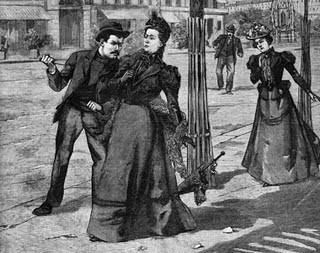
In 1898 Empress Elizabeth 'Sisi', of Austria was a guest at the Beau Rivage in Geneva. As she was leaving to board the boat which was to take her to Territet, and while she was crossing the street to the landing-place, she was stabbed by an Italian anarchist. Carried tenderly back to the hotel she soon breathed her last. Today the hotel offers a "Sisi-Menu" at Christmas (24. December, day of birth of the late Empress) at 250 Francs per person, served in the suite of the monarch.
On 11 October 1987, nine days after his resignation, German politician Uwe Barschel was found dead under mysterious circumstances in the bathtub of his room at the Hotel Beau-Rivage. While a police investigation concluded that Barschel had committed suicide , the circumstances of his death remain controversia to this day.
1889 was a joyful year - at least for one couple who stayed at the Beau Rivage. One day the cry of a newborn echoed through the corridors -- a child was born at the hotel. What a relief!
On 5 October 1909 Reuter news agency reported the "SUICIDE OF MR ALBERT PULITZER, Hungarian born proprietor of the New York World and himself a well known journalist, shot himself on Sunday at the Grand Hotel, Vienna. He had been suffering from nervous malady."
One guest of no fame but with enough money turned to the Mena House in front of the Great Pyramid in Cairo for eternal peace. He rented a room with view upon the pyramid. While spending most of his time on his terrace, looking at the final resting places of various Pharaohs, most notable Ramses, the rumours leaked that he has come to the hotel to wait until he dies. The tactful management approached the guest to investigate if he would not prefer to leave and find his peace – please! – somewhere else. After knocking on the door, nobody opened. With the usual "Housekeeping, sorrrrryyy!" a small delegation entered the room. They found their guest laying in bed, his arms peaceful crossed, eyes shut. He had followed the great Pharaoes to their final destination.
At L'HÔTEL in Paris, where Oscar Wilde lay in his death throes, which ended on November 30, 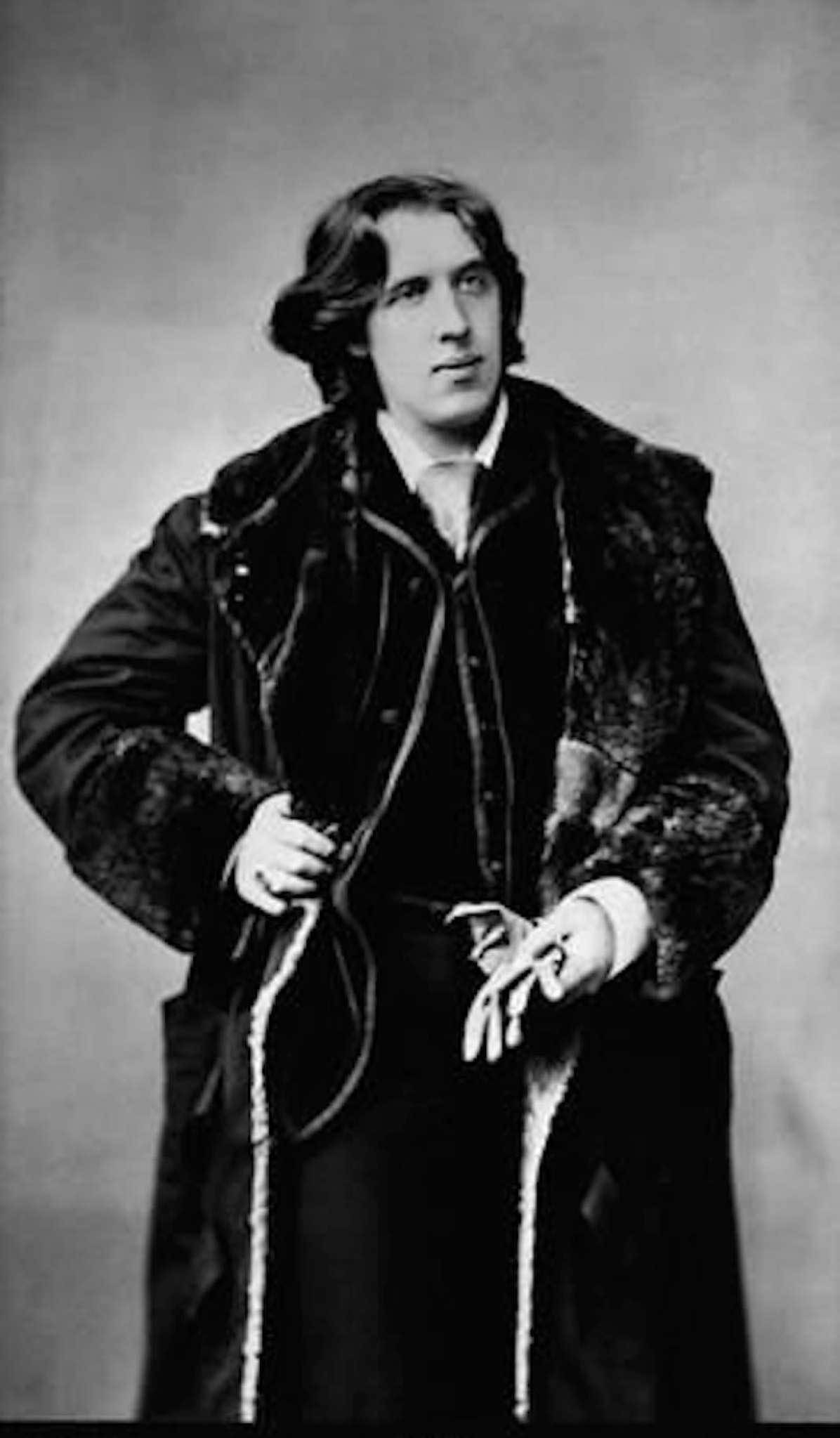 1900, his bill remains unpaid until today. One of his last quips, "I am dying beyond my means," referred not to the hotel's elegance, but to his own total insolvency. But Wilde's last days in room 16 are shrouded in mystery. Did he die of syphilis, or cerebral meningitis resulting from an ear infection? Did he willingly join the Catholic faith, or was he dragooned into accepting last rites by pushy priests? One thing is clear: The hotel's decor was not up to the aesthete's standards. His last words are reputed to be, "My wallpaper and I are fighting a duel to the death. One or other of us has got to go." His bill of 26,000 francs is still outstanding.
1900, his bill remains unpaid until today. One of his last quips, "I am dying beyond my means," referred not to the hotel's elegance, but to his own total insolvency. But Wilde's last days in room 16 are shrouded in mystery. Did he die of syphilis, or cerebral meningitis resulting from an ear infection? Did he willingly join the Catholic faith, or was he dragooned into accepting last rites by pushy priests? One thing is clear: The hotel's decor was not up to the aesthete's standards. His last words are reputed to be, "My wallpaper and I are fighting a duel to the death. One or other of us has got to go." His bill of 26,000 francs is still outstanding.
At the Viennese Hotel Bristol (Austria) it all ended there for one unfortunate lady: the newspaper Kronen-Zeitung reported that Julie Earl from England was robbed and murdered at the Bristol Hotel on 23 May 1918. Miss Earl had been the companion of Baroness Vivante de Villabella from Trieste. The Baroness, her husband and the unfortunate victim had resided at the Bristol for the past three and a half years. 180 Crowns in cash and jewellery worth one million Crowns were stolen. However, the perpetrators didn’t get very far. They were arrested the very same day. (from our book HOTEL BRISTOL VIENNA).
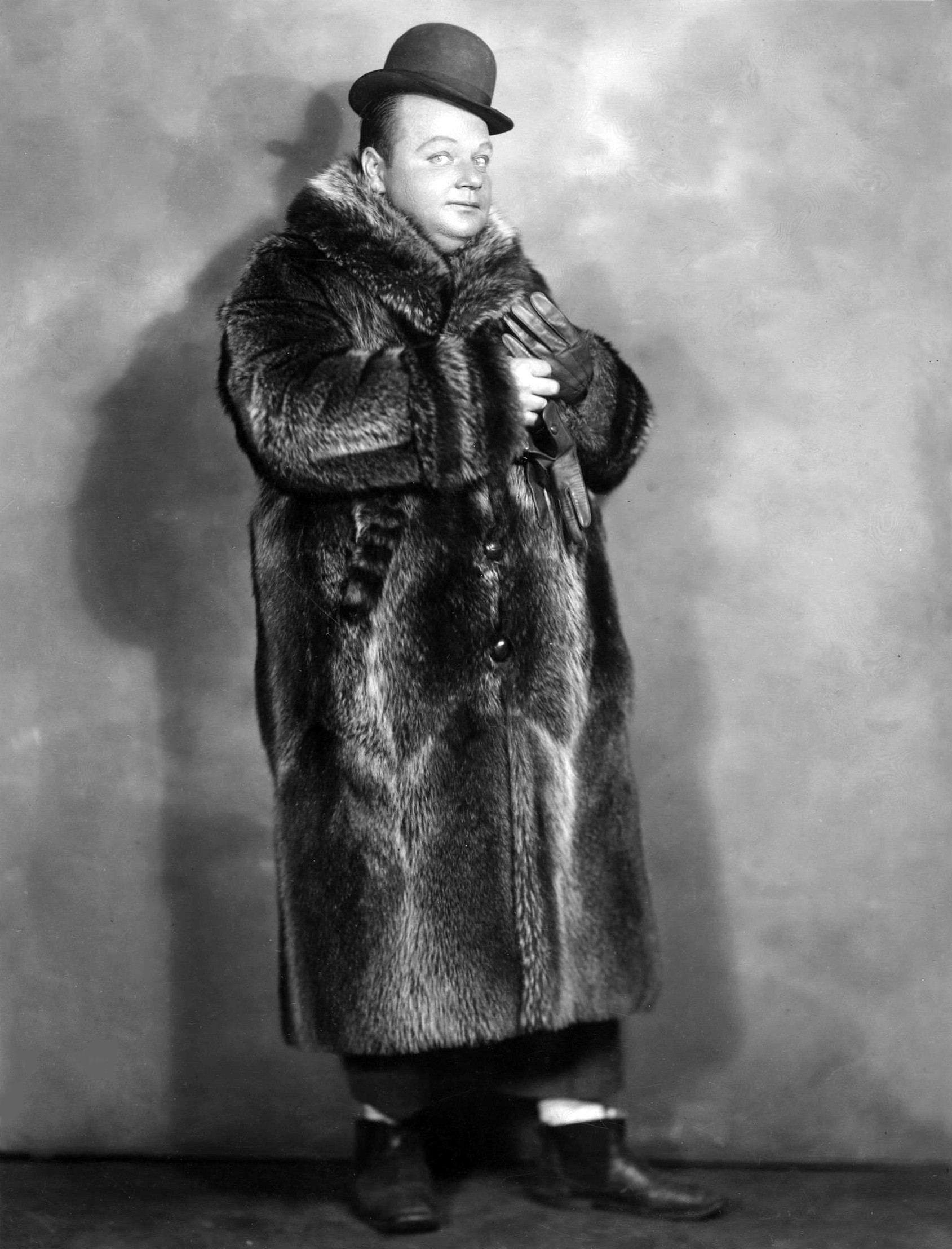
Silent-film comedian Roscoe "Fatty" Arbuckle's 1921 Labor Day bash in room 1220 of the Westin St. Francis provided newspapers with the scandal of the decade, complete with illicit booze, groupies, and the death of a young actress. The actual events are clouded in San Francisco fog: At some point in the proceedings, Virgina Rappe, a 30-year-old starlet with a few screen credits, went off to the bedroom by herself, quite drunk. Four days later she was dead, and Arbuckle was tried for first-degree murder, with the San Francisco D.A. claiming the star had raped Rappe and fatally injured her with his excessive body weight. There were three trials and finally, a verdict of not guilty. Arbuckle was banned from several studios and went bankrupt; one little trip to the bedroom made him, in his own words, "the guy everyone loves to hate."
Operation Tiderace was the codename of the British plan to retake Singapore in 1945. Japan's defeat in World War II caught the Japanese Command in Singapore by surprise. Many were unwilling to surrender and had vowed to fight to the death. There was even a secret plan to massacre all Allied PoWs on the island. But on August 20, the Japanese commander Itagaki told his men that they would have to surrender. That night, one officer committed suicide at Raffles Hotel.
In 2009 Kung Fu movie star David Carradine was found dead in his hotel room in Bangkok, Thailand. Apparently he was found hung in the closet. The rest is unknown.
The Astoria in St. Petersburg has its famous case, too: Aleksandr Vertinsky a famous Russian actor, singer and songwriter who had become a cult figure among Russian émigrés. He died of a heart attack on 21 May 21 1957, at the Astoria Hotel in Leningrad (St. Petersburg).
Music photographer Jim Marshall, who spent more than a half-century capturing rock-and-roll legends including the Beatles, Bob Dylan and Janis Joplin at work and in repose, has died alone in his New York hotel room.
The two-story 1950s cast-concrete former Landmark Motor Hotel was the perfect stage for a celebrity's last act. And on October 4, 1970, Janis Joplin provided just that, dying of an alcohol-and-heroin overdose in the wee hours of the morning. Joplin obtained some startlingly strong heroin, injected herself, went to the lobby to buy cigarettes, returned to her room, and keeled over from her bed into an end table. She was found the next day, dressed in a blouse and panties, by her road manager. Joplin was thus a founding member of the "27 club," the dubiously honorable circle of musicians who expired at that tender age, along with Brian Jones, who died the previous year, and Jimi Hendrix, who preceded her by a mere two weeks. The Landmark Motor Hotel has been renamed the Highland Gardens Hotel.
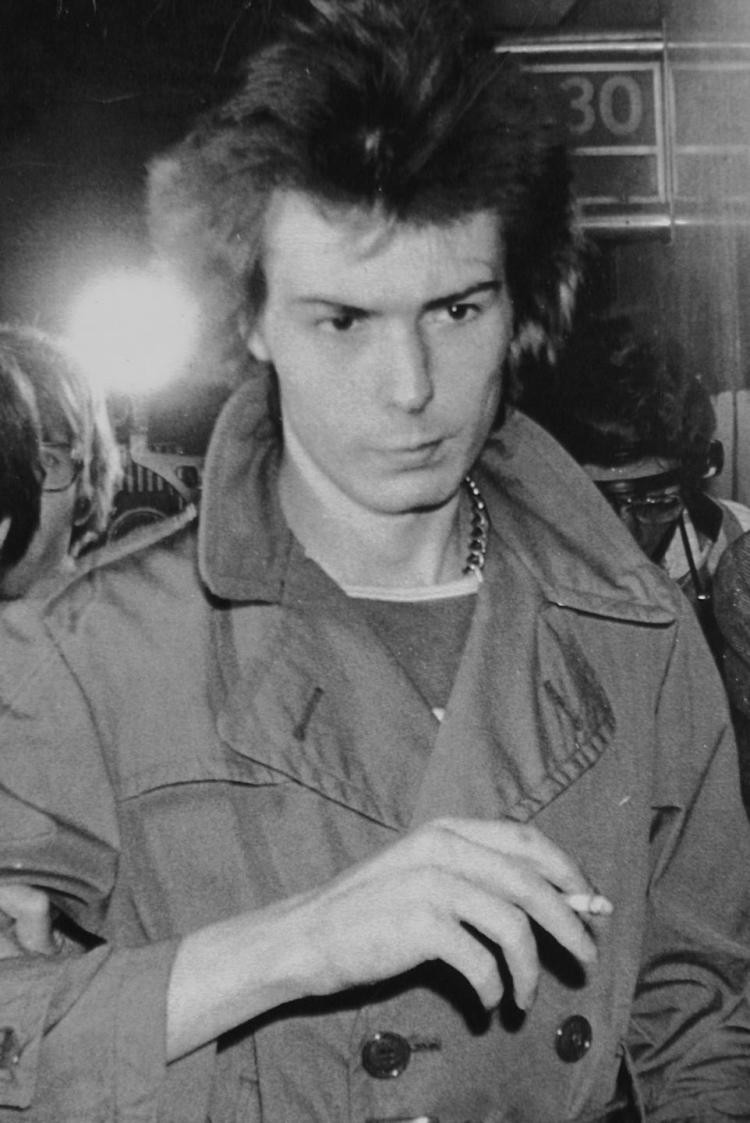
New York’s Chelsea Hotel has its fair share in this story’s subject: poet Dylan Thomas died of alcohol poisoning at St. Vincent’s Hospital after being at the Chelsea in 1953. Nancy Spungen, girlfriend of Sid Vicious of the Sex Pistols, was found stabbed to death on October 12, 1978. Lost Weekend author Charles R. Jackson committed suicide at the Chelsea in 1968. On the other hand, Painter Alphaeus Cole died there at the record-setting age of 115. Close to death had been several survivors of the Titanic, who actually stayed for some time at the Chelsea after being rescued, as it is a short distance from Pier 54 where the Titanic was supposed to dock. Vienna's Hotel Imperial added a case to the list. The former minister of foreign affairs from Jordan, Said Saad Bashir Kheir, died there in his bed on 9 December 2009.
And one more throwback in time: In April 1913 - John Pierpont MORGAN died at the Grand Hotel in Rome, decades later, in 1941, the exiled Spanish King Alfonso XIII, breathed his last at the same legendary Roman hotel. Grand to stay, grand to die at.
In Austria, a former hunting lodge has its own way of handling such cases of an unexpected end of a journey. The Jagdhotel Kühtai, run by Christian Stolberg, a descendant of the last Austrian emperor, has its very own cemetery. It is adjacent to the house chapel just above the hotel. It is the highest cemetery of the county of Tyrol, situated on a scenic mountain plateau. One guest already checked into this final resting place, lending the term long-term-stay a new meaning.
The Peace of Zurich — a rolemodel for the Swiss Ukraine Peace Conference?
( words)
Swiss President Viola Amherd aims to organize a "high-profile peace summit" for Ukraine.
Switzerland, a neutral haven, is renowned for hosting international peace negotiations. In 1859, the Peace of Zurich, facilitated by hotelier Johann Bauer, led to the formation of modern Italy. Sardinia, France, and Austria were the key players, staying in Bauer's Zurich hotels during negotiations.His Hotels were fully booked: the Baur au Lac today run by legendary hoteliers Kracht and Baur en Ville, todays Savoy Zurich of the Mandarin Oriental Hotel Group.
Hotel Baur, today Savoy Mandarin Oriental Zurich, one of the two meeting places of the PEACE OF ZURICH conference and home to the delegation from Sicily and Prince Napoleon
The Peace of Zurich, or How to Save the Hospitality Industry (Temporarily)
A lengthy peace conference could serve as a financial boost for many Swiss tourist destinations. In the past, such a conference convened in neutral Switzerland saved Zurich's two most famous hotels.
Switzerland, known for hosting hundreds of diplomatic missions and legendary historical events, from peace conferences to the founding of the states, offers legendary places like Davos, Bern, and, of course, Geneva. Historically, however, we must not forget Zurich.
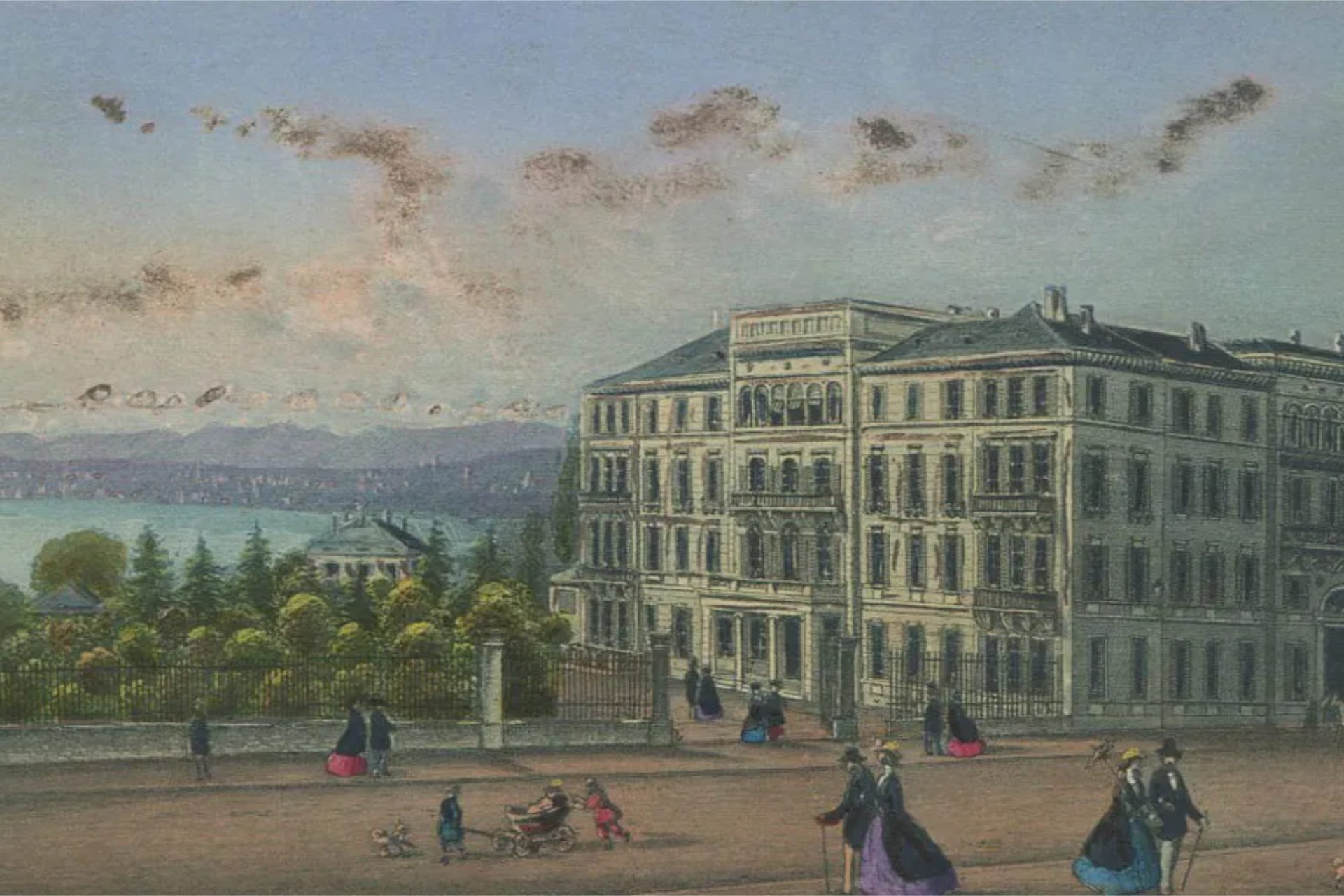
Hotel Baur au lac in Zurich, one of the two meeting places of the PEACE OF ZURICH conference and home of the French and Austrian delegation
Let's rewind to 1859. Napoleon III of France orchestrated the Second Italian War of Independence against Austria, culminating in the legendary Battle of Solferino. The provisional peace, known as the Peace of Villafranca, was ratified in Zurich through negotiations between France, Sardinia, and Austria. Zurich, being the only significant city between the two conflicting parties, provided the necessary infrastructure for a large-scale peace conference. Crucially, Zurich was in neutral Switzerland, a republican territory free from monarchic influences of other European states. Switzerland was ideal for bringing together the rival monarchies of France and Austria.
Now, for the hospitality aspect: such conferences are not one-day affairs. On August 6, the French, Austrian, and Sardinian envoys and their entourages arrived in Zurich. The conference began on the 8th, following a welcome by the Zurich government the day before. Austrians and French lodged at the "Baur au Lac" while the Sardinians stayed at the "Baur en Ville" (now Savoy Mandarin Oriental Zurich). Johannes Baur, aside from the lucrative business, had the satisfaction of hosting all conference participants as his guests. He became the host of peace.
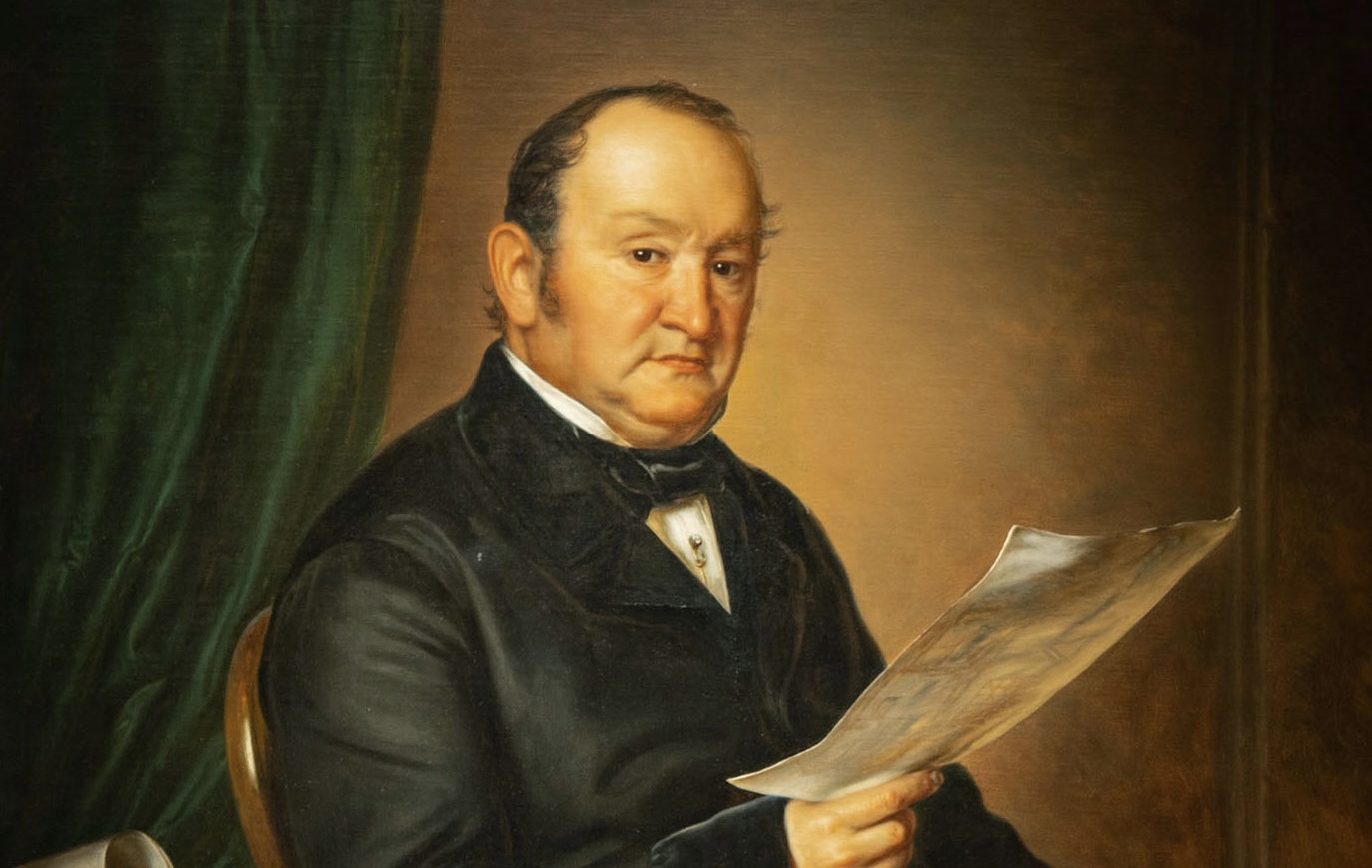
Hotelier Johannes Baur - host of all delegations
Delegates, press members, onlookers, and political figures from across Europe, including "Plon-Plon" Prince Napoleon, future son-in-law of Italian King Victor Emanuel II, gathered in Zurich. Daily international press coverage documented the negotiations. The Peace of Zurich found its place in history books, like the Peace of Westphalia in 1648 or the Treaty of Versailles in 1919.
Although the government offered the casino as the conference venue, the gentlemen preferred holding discussions in private hotel salons but wished for the solemn concluding act to be held at the town hall.
The only one allowed into the private salons was Johannes Baur. Hence, he was bombarded by political reporters with various questions, including the future of Venice. Diplomatically, he replied, "He knew nothing about Venice, but it was certain that his 'Venedigli' (as he called his private house), burdened with a considerable mortgage, would be paid off after the conference would be over."
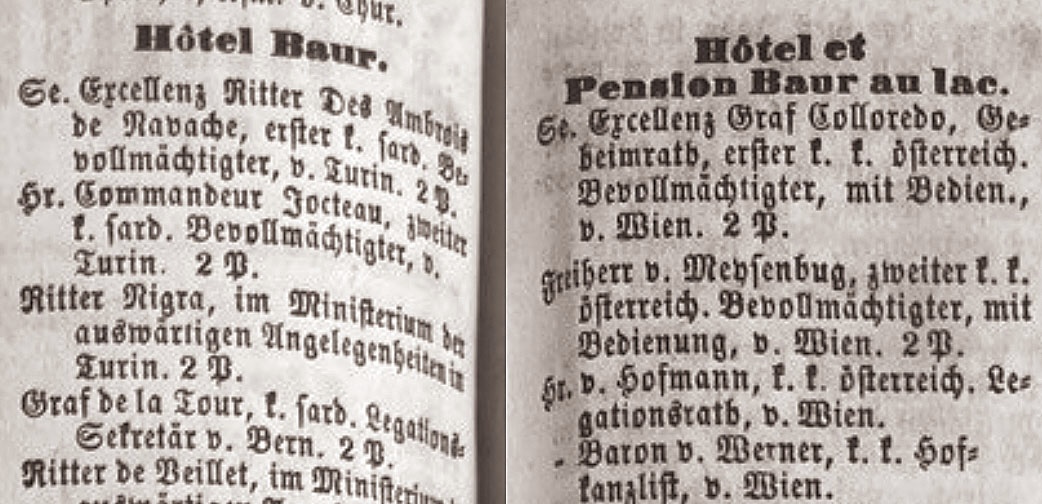 The guest list every hotelier is after: the top diplomats and leaders of the delegations at the two Baur Hotels Click to expand
The guest list every hotelier is after: the top diplomats and leaders of the delegations at the two Baur Hotels Click to expand
Three months and thousands of guest nights later, Johannes Baur presented bills exceeding 100,000 francs to the three signatory powers. As a memento of the negotiations, publishing house Hoffmann and Campe printed the drama "HOTEL BAUR - A Diplomatic Heroic Piece - In Four Rhymed Conferences" on 43 pages. Delegates went home, Lombardy was free, the state of Italy faced few obstacles, and Johannes Baur was restored.
For Switzerland and, in this case, Zurich, the reputation as the perfect place for peace negotiations was established. A peace conference seems a definite recovery plan for any ailing hospitality industry.
Guertler-Mauthner, Elisabeth
( words)
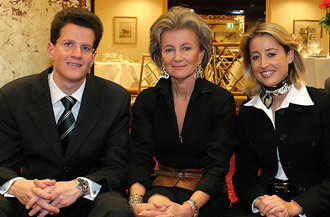
Elisabeth Gürtler with her children Georg and Alexandra, who own the hotels Sacher in Vienna and Salzburg.
Elisabeth Guertler-Mauthner, was born in Vienna (May 7, 1950). She studied commerce in Vienna, from 1988 she was shareholder in her father's business, in 1990 after the death of her former husband, Peter Guertler, she took over the management of the hotels (Hotel Sacher in Vienna, Hotel Oesterreichischer Hof in Salzburg, today renamed Hotel Sacher Salzburg), which their under-age children Aelxandra and Georg had inherited in 1991.
She managed the Viennese Opera Ball for many years, today she also manages the Spanish Riding School in Vienna. Until 2015 she still took care of the day-to-day business of the hotels in Vienna and Salzburg.
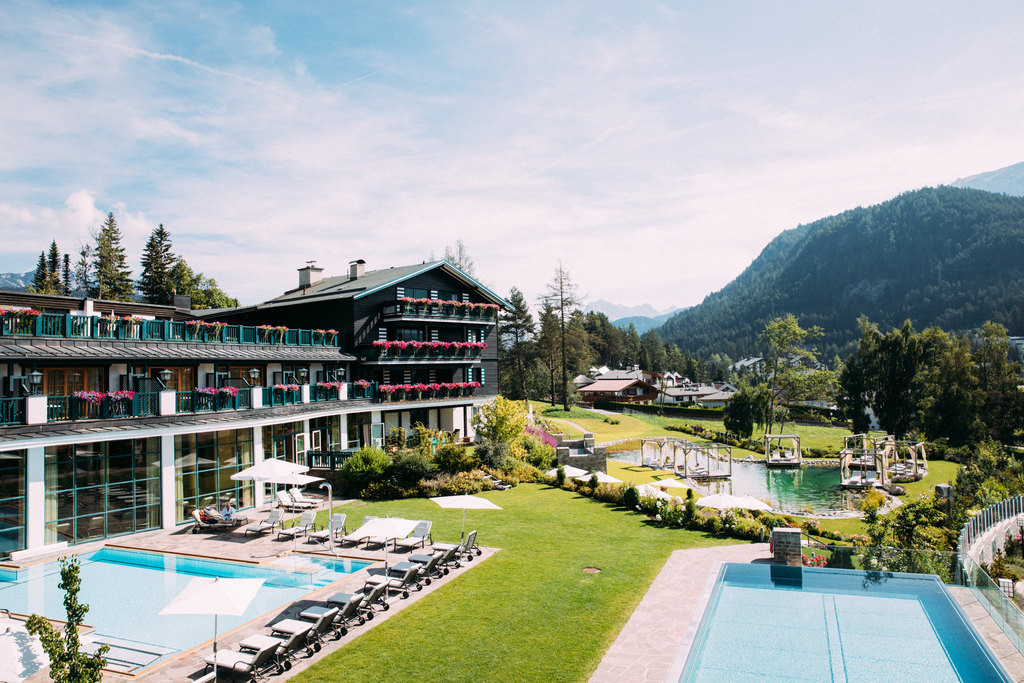
Mrs Guertler has now largely retreated to Seefeld in the Tyrolean mountains, where she transformed the former small family hotel Astoria into a luxurious resort. The hotel's spa has an international reputation. The half-board system provides guests with a breakfast buffet and a multi-course dinner. Recently, the hotel was incorporated into the Sacher Hotel Group and is now the "highest-altitude Sacher hotel in the world."
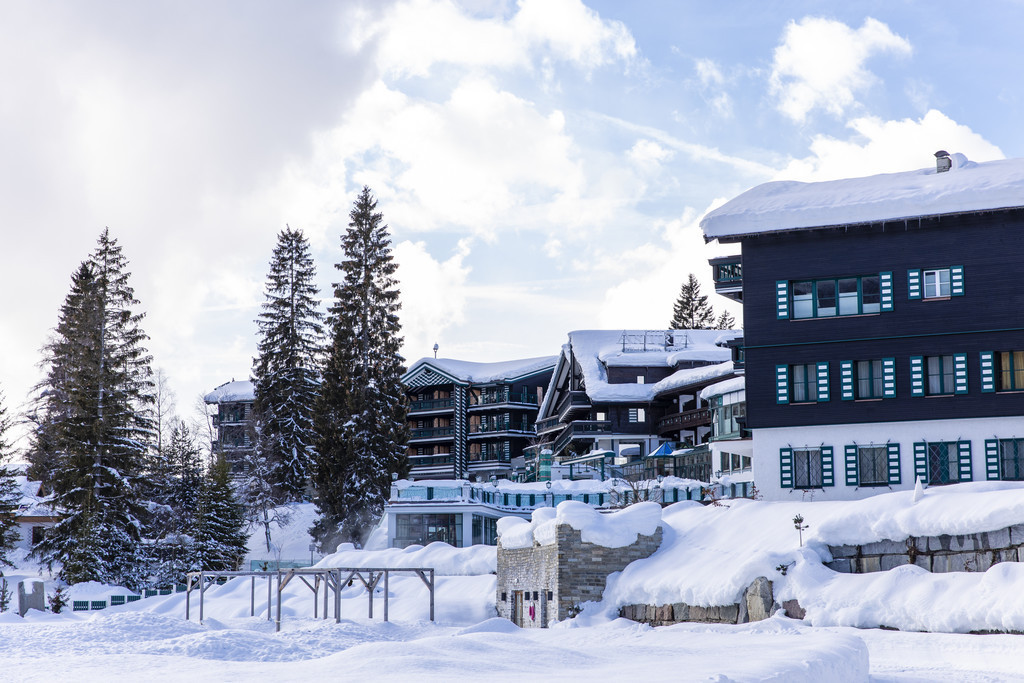
Marketing Success: Sisi - the Travelling Empress
( words)
By Andreas Augustin
Opening Paragraph
The arrival of a truly famous visitor can leave an indelible mark on a hotel's history and influence its success, given the right strategy, marketing plan, or simply enough patience—say, around 100 years. Reid's Hotel on Madeira, Portugal, waited 114 years to confirm the presence of a guest who could become one of its greatest marketing assets. Despite a long list of royal visitors, Nobel Prize winners, and celebrities, one mysterious guest's arrival had remained a myth for a century.
To put an end to all rumours:
In 1986, we saved Raffles Hotel Singapore from demolition by discovering its original building plans. We restored the Metropole in Hanoi's historic identity and serve as "house-historians" for over 400 Select Member Hotels worldwide. Now, we were called to Reid's Hotel on Madeira. General Manager Sandro Fabris and his wife, Doris, the PR head, sought to confirm the rumored stay of Empress Elisabeth of Austria, known as Sisi.
Our team initially tried to prove whether Empress Elisabeth (24 December 1837 – 10 September 1898) had stayed at Reid's at all. Contradictions suggested she may have stayed at a nearby bungalow or elsewhere. Our research led us to local newspaper archives, some newly digitized, and involved leading historians. Portuguese newspaper articles from 1893 revealed that Elisabeth had booked a suite at "Mr. Reid's New Hotel" over Christmas 1893, planning a 10-day visit.
Elisabeth's life changed after the death of her only son, Crown Prince Rudolf, in 1889, an event known as Mayerling. This tragedy led her to travel extensively across Europe and the Mediterranean. Elisabeth's distinctive attire and reclusive behavior became legendary. Avoiding Vienna, she preferred destinations like Cap Martin, Lake Geneva, Bad Ischl, and Corfu, visiting places like Spain, Morocco, Algeria, Malta, Greece, Turkey, Egypt, and Portugal. Travel became both a passion and an escape for her.
Empress Elisabeth at Reid’s.
By M. Markowski
Arrival Confirmed!
On 24 December 1893, her 56th birthday, Empress Elisabeth of Austria arrived in Funchal, Madeira, aboard the steamer Greif. Greeted by British Navy ships with an imperial salute, she stayed at Reid's Hotel for several weeks in a ground-floor suite.
Through the efforts of local Madeira archives and the Austrian Court archives in Vienna, we confirmed her stay. Correspondence between Elisabeth and Emperor Franz Joseph increased during this period, reflecting a platonic and warm relationship. In his letters, Franz Joseph expressed pleasure at her weight gain, noting the tempting cuisine at Reid's.
Marketing Efforts
Elisabeth, often compared to Diana, Princess of Wales, is a 19th-century icon and free spirit who defied court protocol. She has inspired filmmakers, theatrical producers, and now, hoteliers.
Few photos exist of Elisabeth in her later years, taken by photographers who caught her unawares. In the tradition of historical art, we commissioned artist Manfred Markowski to depict Elisabeth at Reid's. Her suite still exists, and we plan to establish a "Sisi" Suite to enhance Reid's historical authenticity.
Tea At Reid's - An Afternoon Tea Companion, was the first book to mention all these details. It was published in 2008. And the collated history of Reid's Hotel (needless to mention - with an exclusive report about the exiting research results) came out in 2009 (REID'S PALACE HOTEL, MADEIRA in the library of THE MOST FAMOUS HOTELS IN THE WORLD®).
G.B. Shaw and Sir Winston Churchill already have their names on the doors of two fantastic suites at the hotel. Now the Empress of Austria "follows suite", so to say.
Andreas Augustin
Other hotels connected to Empress Elisabeth:
Sacher Vienna: her supplier of fine chocolate cakes.
Cairo - during her stay: Shepheard's Hotel, (no longer in existence)
Norfolk Coast, Cromer, during her stay: Tucker's hotel (no longer in existence)
Zurich - Baur au Lac, 1864, 1867 and 1894
Geneva - during her stay: Beau Rivage, here she died, stabbed to death in front of the hotel.
________
*Manfred Markowski, the cover artist:
How War Reshapes the Hospitality Industry: A Deep Dive into Ukraine’s Current Crisis
( words)
Grand Hotel LvivHow War Reshapes the Hospitality Industry: A Dive into Ukraine's Current Crisis
by Andreas Augustin
Wars have always altered the hospitality landscape, often for the worse. Historical data from the World Wars reveals profound impacts on guest demographics and staffing. As young men went to the front lines, women, the elderly, and the wounded filled their roles. The Grand Hotel in Lviv, Ukraine, is desperately trying to maintain its staff of 120.
Since the onset of the current conflict, over five million Ukrainians have fled the country. More than one million men and 70,000 women have been conscripted. This upheaval inevitably impacts the hospitality sector. Luxury leisure travelers are being replaced by business clientele; the international market is shifting to local guests. Currently, only 25% of guests in Ukraine’s luxury hotels are international.
Instead of tourists seeking relaxation and entertainment, hotels now host international delegations, journalists, and local businesspeople. Local events have gained importance, with charities now raising funds for drones rather than children's hospitals.
The Grand Hotel in Lviv features a luxurious spa in its basement. While it remains operational, it also serves as an air raid shelter during alarms. In the Lobby Bar, at the restaurant or on the floors above nothing hints at the war In the luxurious rooms, state of the art bathrooms, the rooftop Presidential Suite or the kinky Sacher Masoch room rules business as usual
**Read our latest book, *GRAND HOTEL LVIV*, which takes you through the captivating history of this remarkable city and its iconic Grand Hotel.
The book is available shortly please reserve your autographed personal copy today.
Britains Oldest Hotel
( words)
Above: John Carr of York with the drawings of the hotel
By Adrian Mourby
The oldest purpose-built hotel in Britain is generally agreed to be The Royal Clarence in Exeter.
Opened in 1770, it burned down in 2016 and is currently still being rebuilt. This moves (10 years younger) The Crescent at Buxton way up the list of hotels vying for the honour of being Britain’s most senior. There are many older buildings in Britain that operate as hotels today but none of them were built to serve that purpose originally. Not like the Crescent.
It was in 1780 that the 5th Duke of Devonshire commissioned a hotel to be built on a plot of land he had purchased opposite the ancient well of St Ann in Buxton. William Cavendish reckoned one of these new French-style "hotels" could exploit the famously efficacious thermal springs. The Romans had opened up the waters of Aquae Arnemetiae (Buxton) for bathing during their occupation of Britain. Indeed St Ann’s Well proved such a place of health and devotion that Henry VIII's chancellor, Thomas Cromwell shut the shrine down when dissolving the English abbeys for his master during the Reformation.
A new hotel with all Georgian amenities might prove a money-spinner, thought the Duke, in the same way that Bath had made fortunes in the south west of England
However a popular story runs that the 5th Duke had an ulterior motive. His wife, the fabulous Georgiana (played by Keira Knightly in the film The Duchess) was forever disappearing off to London and Bath for the delights of the "season" - and running up huge gambling debts thereby. So His Grace decided to bring some of the charm of both cities to Derbyshire where his family seat was based at the palatial -but rather isolated- Chatsworth House.
In due course the celebrated architect, John Carr of York was dispatched to Bath to study its Royal Crescent. This, still one of the most famous buildings in Britain had been designed by John Wood Jnr as a unified sweep of 30 facades behind which builders could create individual townhouses. In Buxton Carr created only eight "houses" but his design incorporated a uniform crescent with a thermal bath at one end and assembly rooms at the other. This was Bath in miniature, brought to the chilly Peak District. Known variously as St Ann's Hotel and The Great Hotel, what is now The Ensana Crescent Hotel created the basis of Regency tourism in Buxton. Other, lesser hotels sprang up nearby and the Duke also created a positively luxurious stable for 120 horses on the slopes behind his new hotel. This still stands and is now part of the University of Derby of which the Cavendish dukes are hereditary chancellors.
Carr's perfect stone terrace cost £38,000 to complete. That was a huge amount of money in the 1780s. The headstrong Georgiana, on visiting the building site in 1783 wrote to her mother "I never saw anything so magnificent as the Crescent though it must half ruin me - my spirit makes me delight in the Duke doing it."
Fortunately William Cavendish, the 5th Duke was making that much money annually just from his copper mines in Staffordshire. The Royal Navy had recently taken to copper-bottoming their ships as the metal protected hulls and allowed British warships to sail faster. As a result copper had rocketed in price.
Once opened, The Crescent became the flagship of Buxton tourism throughout the nineteenth century. It can be argued that at a third of the width of Bath's Royal Crescent it is actually more pleasing to the eye. Certainly it is difficult to get a good view of Wood's Crescent unless one is floating over it in a hot air balloon - it is just too big - whereas Carr's Crescent is clearly a work of beauty on a more human scale, obvious to anyone walking their dog at 7am or stumbling back late into reception after a performance at the nearby opera house.
Sadly by the end of the twentieth century parts of this superb building lay derelict while others had been repurposed into council offices. The sublime assembly room -whose painted ceiling outshone anything offered in John Wood's Bath- had been turned into the to the town's borrowing library. It took a major 21st century undertaking to revive The Crescent with investment from two local councils, input from the National Lottery Heritage Fund, Historic England and the Ensana Group who run many spas in Europe. The refurbishment cost was over £67 million of which two million alone went into the removal of pigeons and other vermin from the decaying structure.
Today the result is hugely impressive, but discreetly so. The eight doors that originally let into Crow's terrace of eight hotel lodging houses have been retained (making it difficult to find the front door of the modern hotel which has no obvious signage, as would also have been the case in 1789) and every shade of paint - a lot of grey, mushroom and maroon - is strictly drawn from what would have been available in England in the 1780s. There are even eight original staircases -rather than one main flight leading off reception - reflecting the original plans for multiple occupation.
The newly revamped Ensana Crescent Hotel re-opened in 2020 for just 34 days before Covid lockdowns in Britain shut it again. Post-pandemic, it has thrived with guests coming from across the north of England - Lancashire, Yorkshire as well as the Peak District - and from the south of England too. Crow's original thermal pool at the west end of the terrace has been restored with the very same iron canopy that the Victorians added, now beautifully glazed over in blue stained glass. And the water is still warm. It arrives in the spa 5,000 years after raining down on Derbyshire, and having been boiling away miles below Buxton for millennia before reaching the town today . However, because the water is untreated the pool has to be drained every night and its tiles scrubbed clean before it can be refilled. It's a process that takes eight hours before this very special thermal pool can reopen at 8.30 the next day.
Nowadays the Assembly Rooms at the east end of The Crescent are let out for functions. Here there is a huge, circular, floating staircase that leads up past portraits of Duchess Georgiana and the 5th Duke as well as John Carr, architect. After them the splendour of the former public library is unveiled. It's a lofty room with an exquisite ceiling in pale pink, blue and yellow. James Turner, the Operations Manager claims that he only has to get a Buxton bride and groom to see this room to guarantee its booking.
Today, just as in 1789 the curve of the hotel's gracious crescent stands opposite St Ann's Well which was given a 19th century makeover and now serves as a visitor centre. And next to it is a small fountain flowing with Buxton mineral water from the Roman spring. Although this water is bottled these days by the Nestlé company and sold worldwide it is also freely available to the people of Derbyshire who drive up with huge plastic flagons to fill up for the week.
There is no doubt that it was the 5th Duke's Terrace Hotel that put Buxton on the fashionable English map when it opened in 1789 and no doubt that its restoration keeps Buxton on the tourist map over 230 years later.
Lviv - Ukraine - The Grand Hotel
( words)
As I write these lines, there is war in Ukraine. We have arrived in Lviv. A bombing raid could occur at any moment. Young men in dark green uniforms carry heavy backpacks. Their belongings for the time at the front. Farewell scenes we only knew from movies. But the tears are real. We leave the train station as quickly as possible. A strategic target, obviously. How can one come up with the idea of researching the history of a historic Ukrainian grand hotel in times of war?
Andreas Augustin
In the footsteps of Austrian emperor Franz Joseph I., Andreas Augustin embarked on a railway journey from Vienna to Lviv (Lemberg). In all modesty. Not in an imperial salon coach, but public railways.
The monarch visited the westernmost city in Eastern Europe (or, should you prefer: the easternmost city in Western Europe) several times. In 1894, he arrived to pay tribute to the "Grand Exhibition".
Andreas Augustin came to delve into the history of the most famous Grand Hotel of Ukraine. This iconic establishment, opened in 1894, holds the distinction of being the oldest luxury hotel in Ukraine. Augustin's exploration encompassed various fascinating narratives, including the evolution of travel during the monarchy, the development of railway systems, and the captivating history of Ukraine and Lviv, formerly known as Lemberg.
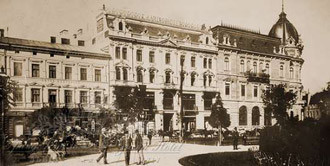
To begin his narrative, the author delved into the era of the monarchy, where travel was a privilege reserved for the aristocracy and wealthy elites. During this time, leisurely trips became a symbol of status and grandeur. Explorers and adventurers would embark on extensive journeys, often accompanied by an entourage of servants and accompanied by opulent luggage.
The advent of railway systems played a pivotal role in transforming travel during the late 19th century. Railways revolutionized transportation, making it more accessible and efficient for people to traverse vast distances. Lviv, situated at a strategic crossroads between Eastern and Western Europe, became a significant hub for railway connections. This newfound accessibility led to an influx of visitors to the city, contributing to its growth and cultural exchange.
The story of Ukraine and Lviv is a tapestry woven with historical events and diverse influences. Lviv, founded in the 13th century, experienced the rule of various empires and states throughout its history. It was a part of the Kingdom of Poland, the Habsburg Empire, and the Russian Empire at different times. Each of these eras left an indelible mark on the city's architecture, cultural heritage, and social fabric.
Before being known as Lviv, the city was called Lemberg. This name was derived from its history as a major center of commerce within the Kingdom of Poland. Lemberg flourished as an important trading hub, attracting merchants from different corners of Europe. Over time, it became a melting pot of cultures and a vibrant cosmopolitan city.
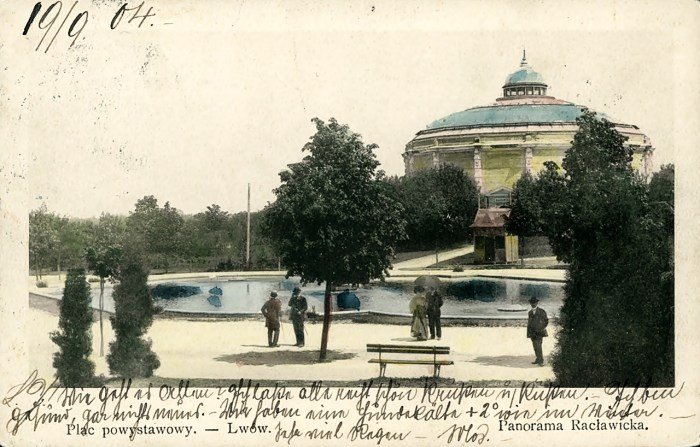
The 1894 International Exhibition in Lviv stands as a significant event in the late 19th century, showcasing the city’s cultural, industrial, and economic prowess to the world. Held in Stryisky Park from May 5 to October 28, this exposition marked Lviv’s emergence as a vibrant center of commerce and culture.
At the heart of the exhibition was the celebration of Lviv’s rich history and diversity. Visitors were treated to a captivating display of art, music, and literature that reflected the city’s multicultural identity. Lviv, situated at the crossroads of Eastern and Western Europe, was home to various ethnic communities, including Poles, Ukrainians, Jews, and others. The exhibition highlighted this diversity, fostering a sense of unity and pride among the city’s inhabitants.
The industrial section of the exhibition showcased Lviv’s growing economic significance. Various factories and businesses displayed their products, from textiles to machinery, demonstrating the city’s rapid industrialization. This attracted foreign investors and fostered economic growth, further establishing Lviv as a key player in the region’s economy.
Education and science were also integral components of the exhibition. Lviv’s renowned universities and research institutions presented their achievements, emphasizing the city’s commitment to intellectual progress. Scientific lectures and discussions were held, fostering an environment of knowledge exchange.
Artistic and architectural marvels dotted the exhibition grounds, with some structures, such as the Palace of Fine Arts, becoming iconic symbols of the event. These structures showcased the city’s architectural prowess and commitment to the arts.
The climax
In the summer of 1894, the vibrant city of Lviv, nestled within the Austro-Hungarian Empire, was abuzz with anticipation. The occasion? The grand visit of Emperor Franz Joseph I to the International Exhibition, an event that would forever etch itself into the annals of Lviv's history.
As the date drew near, the city underwent a transformation like no other. Elaborate decorations adorned the streets, and the grand exhibition hall, a marvel of architecture, stood as a testament to human ingenuity. Countless artisans and craftsmen showcased their talents, and innovations from around the world were put on display.
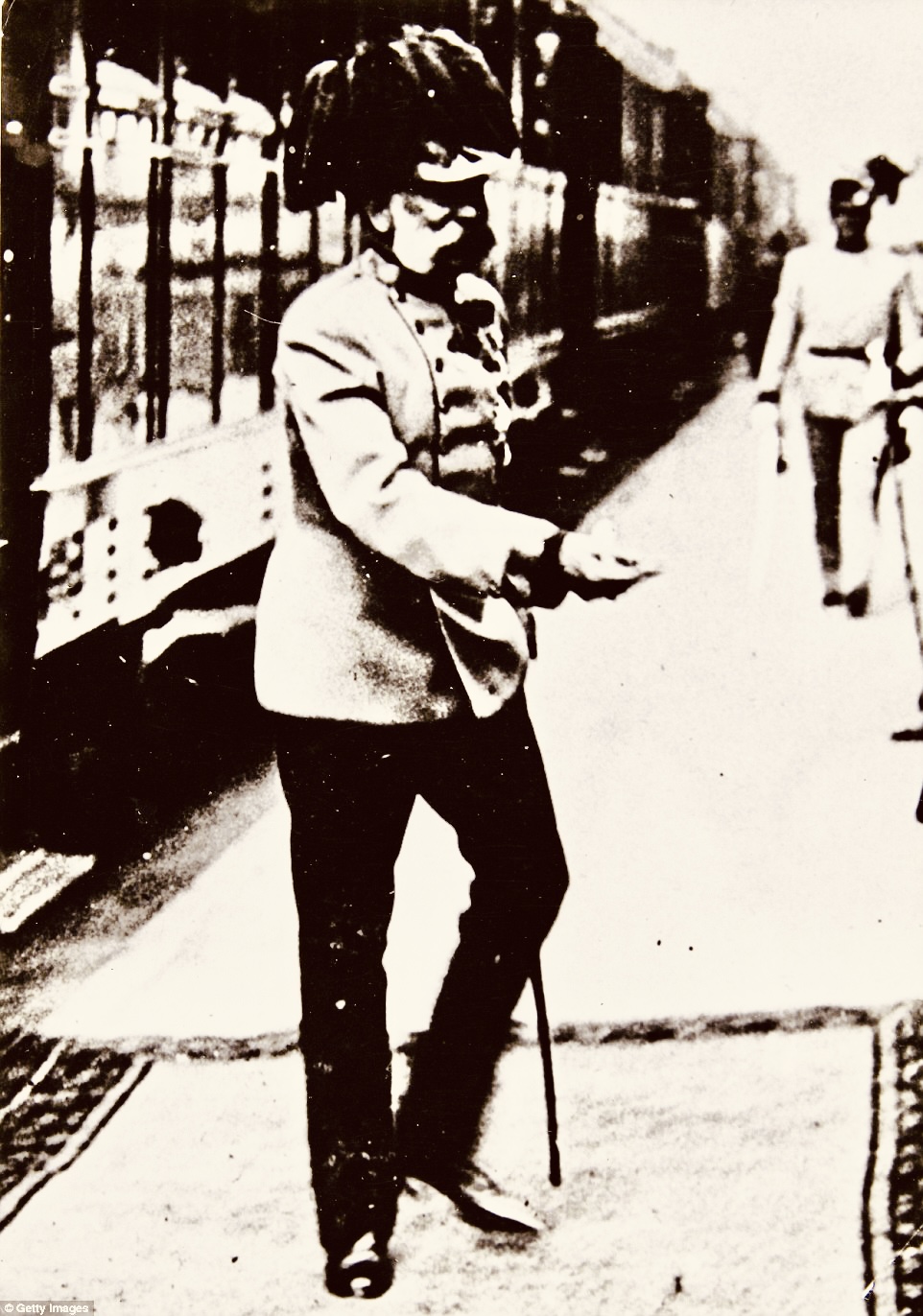 The day of the Emperor's arrival finally came, greeted by a jubilant crowd that lined the streets. The city's diverse population, a melting pot of cultures, eagerly waved flags and banners, demonstrating unity under the Habsburg rule.
The day of the Emperor's arrival finally came, greeted by a jubilant crowd that lined the streets. The city's diverse population, a melting pot of cultures, eagerly waved flags and banners, demonstrating unity under the Habsburg rule.
Emperor Franz Joseph, known for his stern demeanor, appeared genuinely intrigued by the marvels he encountered. He wandered through pavilions, observing the latest technological wonders, intricate artistry, and exotic exhibits brought from far-flung corners of the empire.
One particular highlight was the showcase of Lviv's rich cultural heritage. Traditional music and dance performances filled the air, while local artisans displayed their craftsmanship. The Emperor's visit served to reinforce the value of preserving and celebrating the unique identities within the Austro-Hungarian Empire.
The 1894 International Exhibition was not merely a display of opulence but a testament to the empire's commitment to progress and unity. It showcased the cultural mosaic that was the Austro-Hungarian Empire, with Lviv at its heart.
As Emperor Franz Joseph I departed, he left behind a city forever changed by his presence. Lviv had proven its worthiness as a cultural and industrial hub within the empire, and the memory of his visit continued to resonate through the years, a symbol of the empire's diversity and aspirations for a brighter future. It strengthened Lviv’s position as a hub of cultural exchange and economic activity in Eastern Europe. Moreover, it promoted a sense of unity and pride among Lviv’s diverse population, emphasizing the city’s unique identity. This exhibition was not just a historical event but a testament to Lviv’s enduring spirit and its ability to adapt and thrive in a rapidly changing world.
The Grand Hotel, opened right on time for the exhibition in 1894, still represents this testament to Lviv's rich history and heritage. Throughout the years, it has witnessed the changing tides of Lviv's fortunes, political transitions, and cultural transformations. Despite the challenges faced during times of turmoil, the Grand Hotel has managed to preserve its allure and continues to offer a luxurious experience to its guests.
About the book
Andreas Augustin's research and storytelling illuminates the captivating narrative of travel and the enthralling history of Grand Hotel Lviv, Ukraine's oldest luxury hotel. His exploration sheds light on the interplay between travel, culture, and the evolution of a city over time.
The First “Grand” Hotel
( words)
250 YEARS OF GRAND HOTELS
250 YEARS OF GRAND HOTELS — In January 1774 David Low opened in London the first so called 'Grand Hotel' in the world. Others followed -- we list 70 "Grand Hotels" in our timeline
250 YEARS OF GRAND HOTELS — For the opening, in 1774, David Low invited the Duke of Bedford's chief agent to the opening. The hotel was intended for residence by a wealthy clientèle, with a top price of 15s. a night for a suite of two rooms. Best seat in church included!
In No. 43 King Street, in Covent Garden, the first house to be built on this site, was occupied by Admiral Edward Russell in 1689 or 1690. He had played a leading part in bringing William of Orange to England, and as Treasurer of the Navy and commander of the fleet was the dominant naval figure in the French war of 1689–97, defeating the French fleet at La Hogue in 1692. In May 1697 he was created Earl of Orford. Later in the same year he took a twenty-one-year lease of this house from his uncle (who by then had become the first Duke of Bedford).
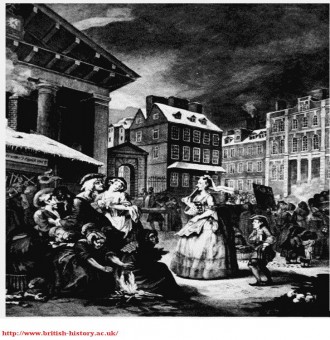
The Piazza North-west corner as depicted by Hogarath in 1738.jpeg
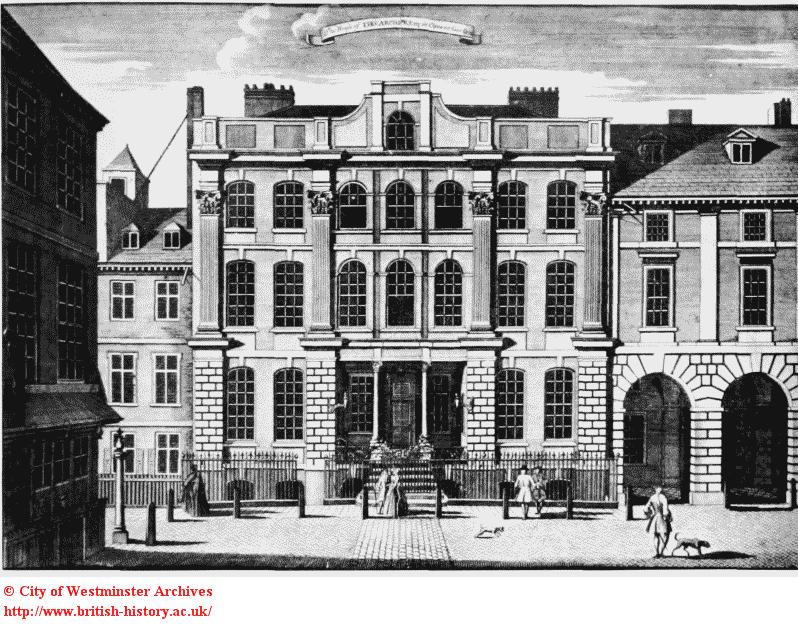
1747: 43 Kings Road, 30 years before it became a hotel,
Orford died in 1727 and we jump ahead of time to the 1770s, when the residential quarters of the seventeenth-century aristocracy were undergoing a decisive degradation, and henceforward Lord Orford's old house ceased to be a private residence. In May 1773 a fifty-five-year lease, to run from Midsummer 1779, was taken by David Low, described as a peruke-maker of Covent Garden (probably Southampton Street). The rent was £200 per annum.
In January 1774 Low opened the house as the Grand Hotel. He invited the Duke of Bedford's chief agent to the opening. The hotel was intended for residence by a wealthy clientèle, with a top price of 15s. a night for a suite of two rooms.
From an early date the occupant of the house on this site had enjoyed the use of the most prominent pew in the church, in the centre of the east gallery, over the communion table: the respectability of Low's hotel is shown by his and his successor's eagerness to obtain the continuance of this privilege for their customers.
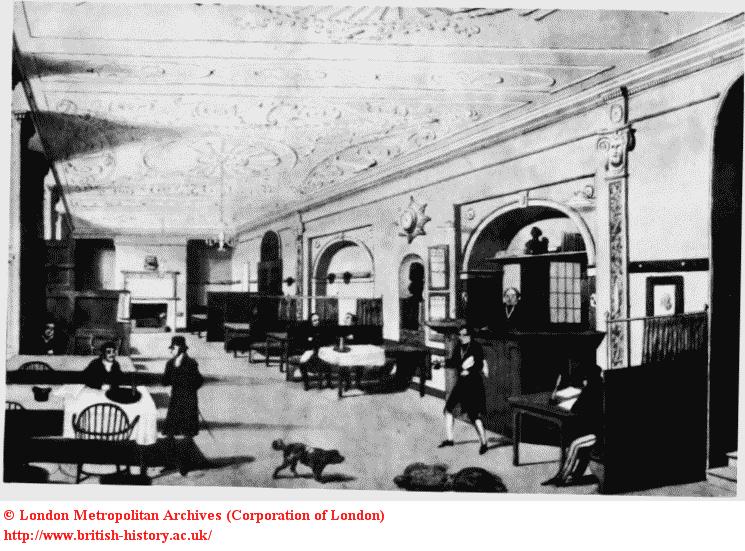
1774: the coffeeroom
By 1776 Low had added a range of bedrooms to the northern rear wing of the house, and made a coffee room in the basement. Other decorative work of this period, probably installed by Low, survived into the nineteenth century. He also made an opening into the house from the portico walk. Low later claimed that his alterations cost him £6,000 or £7,000.
He fell into difficulties with mortgagees, and by 1779 the ratepayer was another hotel-keeper, Isaac Froome, evidently as Low's lessee at a rent of £525 per annum. By 1786 Low was bankrupt and his assignees put the lease of the property up to auction, when it was bought for £1,600 by Froome. The character of the establishment is brought out in a letter to the Duke of Bedford in 1788 from Froome who sought the Duke's inspection and recommendation of 'the only Hotel for Families on your Grace's estate . . . being fitted up in a Stile of Elegance for the reception of the Nobility and Gentry requiring temporary residence in Town'.
From 1795 until the 1830's the building was usually in divided occupation, as a hotel and a coffee room. The appearance of the latter in 1804, evidently not much altered since Low's day, is shown on Plate 78b. It was at that time in the possession of Charles Richardson, who had acquired the famous lion's head originally at Button's coffee house, which can be discerned on the end wall.
In 1833 (and perhaps earlier) part of the premises was let off in apartments as Covent Garden Chambers. In the following year the lease was renewed to Walter Richardson, wine merchant, for twenty-one years at £260 per annum. In the previous year, however, some fittings, including a carved marble slab (part of a chimneypiece) and two 'landings' of inlaid oak. were removed by the Duke.
In the years 1835–7 the newly formed (Royal) Institute of British Architects had its first headquarters here, under a sub-lease at £100 per annum from Walter Richardson's mortgagee, Sir Henry Richardson.
By this time, however, part of the premises, still known as the Grand Hotel, was in the hands of a former actor and singer, W. C. Evans, who during the 1840's made the house very well known as a late-night rendezvous for song-andsupper entertainments in the basement.
Evans was succeeded in about 1846 by John Green, a self-styled 'father of the music halls'. Under 'Paddy' Green the song-and-supper part of the establishment, still retaining the name of 'Evans's', prospered greatly.
In 1850–1 some alterations of unknown extent were made to the building. In 1855 Green took a forty-year lease of the premises and had a large singing-room or music hall constructed at the back of the hotel. It was approached via the old singing-room in the basement, which had been made, probably by Evans, out of the former coffee room.
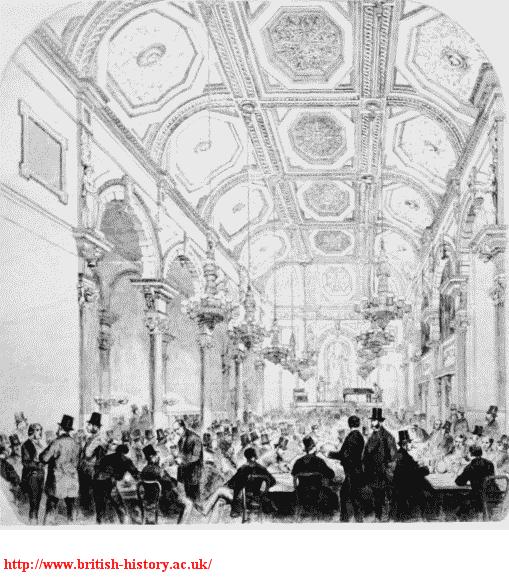
Evan's music hall at No. 43 King Street, 1855. W. Finch Hill, architect
The architect was W. Finch Hill. This expensive piece of work, with its Bath-stone columns and elaborate gas-lighting, was built in four months, to be ready to receive the provincial visitors to London 'during the week of the Cattle Show'. The contractor was W. Jackson, and the work, with some alterations to the hotel, cost nearly £7,000. (ref. 122) The appearance of the new room was applauded as a sign of improving public taste by The Builder and also by The Art Fournal, which thought it 'one of the most elegant rooms in London; its proportions are magnificent, and its style of decoration sufficiently classic, without that sombre look it too frequently assumes'. Green was also congratulated on 'having elevated the moral tone of its amusements and made them unobjectionable', a fact of which he was contentedly self-conscious. In 1871 alterations were made to the music hall and the hotel, by the architect J. H. Rowley. The former was enlarged, redecorated with much use of lookingglass, and boxes were constructed all round it. The cost was again about £7,000.
It was probably during Green's tenure, which ended about this time, that the upper part of the façade was given its present appearance, which it had certainly acquired by 1877.
In 1874 and 1875 the Savage Club occupied premises here, but the use of part of the building as a hotel seems to have continued until 1880.
Designs were prepared in 1876–7 by Henry Clutton, as the ninth Duke's consultant architect, to bring the Grand Hotel into harmony with his remodelling of the buildings in and adjacent to the Piazza, but this was not done, although the buildings on either side were designed or given elevations by Clutton. It was, however, in the years 1877–80 that the entrance to the hotel from the portico walk received its present door and doorcase. The designer is not known.
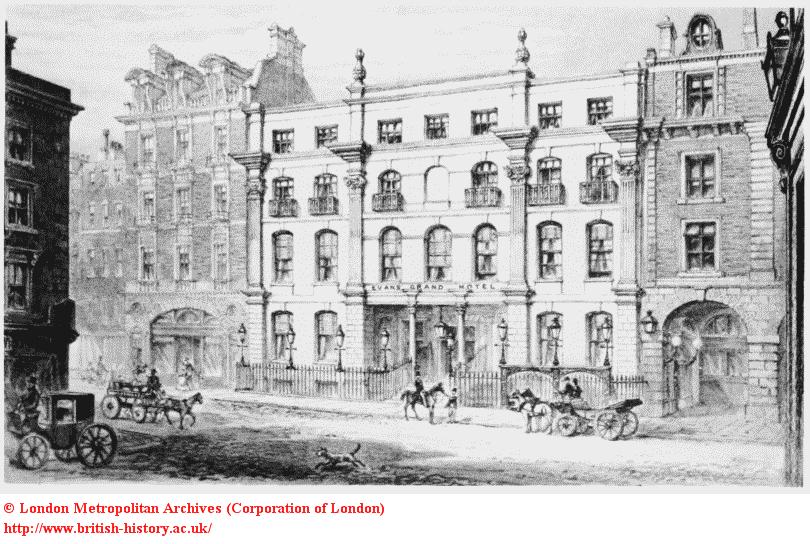
No. 43 King Street, exterior. In 1880 the first Grand Hotel in history closed*.
* In c. 1882–3 the premises were occupied by John Hollingshead's Falstaff Club, for which the upper part of the house was decorated with paintings (by Albert Calcott) and plaster reliefs illustrating The Merry Wives of Windsor.
1884—1890 this was succeeded by the New Club, run by an associate of Hollingshead's, Colonel F. A. Wellesley. The New Club enjoyed the patronage of the Prince of Wales and attracted a wealthy and aristocratic membership: both it and the Falstaff Club staged 'dances and entertainments' as well as providing the usual club facilities.
In 1891 the premises were taken by the newly founded National Sporting Club, which staged its boxing contests in the former music hall. Plans for the alteration and decoration of this boxing hall were made in 1911–12 by the architects Mewès and Davis, but it is uncertain whether they were carried out. The club remained here until its closure in 1929. The premises were then taken by the present occupants, George Monro, fruiterers, for whom extensive alterations were carried out by E. A. Shaw and Partners, architects and surveyors. They included the removal (between May 1932 and February 1934) of the original columned entrance, to provide access for lorries to the warehouse at the rear.
In 1929 there had been an intention to build a theatre on part of the site and although this was not done the third floor was hired in 1934 by the Players' Theatre Club, previously in New Compton Street. This soon closed, but in October 1936 a theatre club was re-opened on the third floor by Peter Ridgeway, as the New Players' Theatre, until its move to Albemarle Street in October 1940.
When the alterations were made for George Monro the staircase of Lord Orford's time was removed. In 1962 it was re-erected by Professor Sir Albert Richardson in South Walsham Hall, Norfolk. Today the architectural description is quite sober: 'Despite its mutilated front and altered interior, No. 43 King Street is still an important example of a town mansion.'
___________________________
Source: famoushotels.org main archives, Vienna
London Metropolitan Archives (photographs)
César Ritz’s Waterloo (1)
( words)
Part 1 by Andreas Augustin
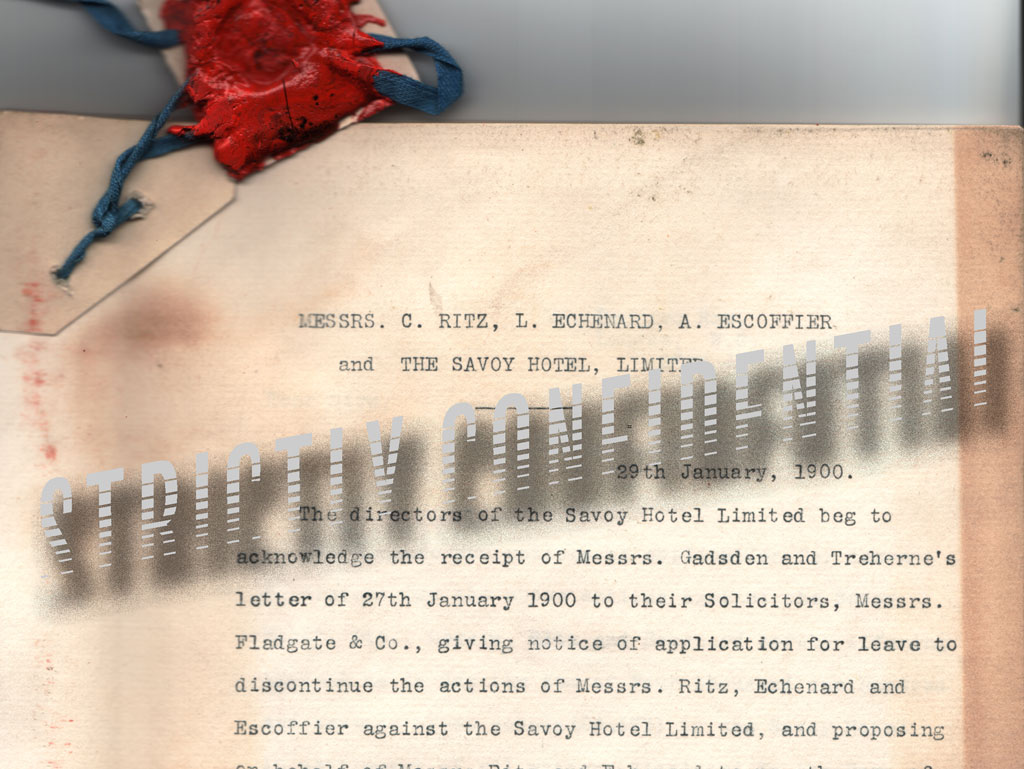
We find ourselves in the heart of London's theatre district, on the Strand. We are deeply immersed in the history of the most famous hotel of London's Westend The Savoy. We imagine the clatter of horse-drawn carriages, encounter famous figures such as the Prince of Wales, Oscar Wilde, Nelly Melba, Auguste Escoffier, the composer Arthur Sullivan, Enrico Caruso, ... OK, I shall cease; this list could continue indefinitely. And then, of course, there was one more: César Ritz.
London, The Savoy
Every night at midnight, the late shift in the kitchen had a set task: to prepare Bircher muesli. I sat on a stool in the kitchen, consuming a steak sandwich. It had become late once more. The kitchen (under Anton Edelmann) was situated a level above the Savoy's entrance from the Thames, and a floor below the driveway from the Strand. My late visits were anticipated. After all, I was on the same floor, next door in the archives. Yet today, my appetite had waned. I was simply too exhilarated. Could what I had just discovered in the archives truly be real? It was an incredible tale. A splendid story. A real sensation.
From the beginning.
Susan Scott, the Savoy Hotel archivist in London in the year 2000, oversaw a cluttered storeroom masquerading as an archive. When General Manager Michael Shepherd informed her that I would have unrestricted access to this "archive," she swallowed hard.
"Unrestricted?" she inquired. "For how long?"
"As long as it takes," said Shepherd.
Then, my London colleague Andrew Williamson and I delved into mountains of files. A room, approximately five by five metres, and four metres high, plastered with metal shelving units. These, in turn, packed with boxes and folders. Some labelled, some a complete surprise. We commenced our work. Every hour, we needed to step outside for fresh air and to wash our hands.
It rapidly became clear to us that the archive extended back to before the hotel's opening. Around 1884. Those were the days of theatre impresario Richard D’Oyly Carte, who had envisioned The Savoy Hotel beside his Savoy Theatre as a modern and luxurious retreat. Returning from one of his numerous American tours, he was convinced by the "Grand Hotel" project. You could read all these details in our book, where over 220 pages, we provide an intimate insight into the creation and life of this fantastic establishment. However, what fell into our hands that day exceeded our wildest imagination. In a notably well-sealed box, the hotel by the Thames concealed a dark secret.
And now from the very beginning: It was an undeniable fact that Richard D’Oyly Carte had established a sensational establishment with the Savoy. However, he was a theatre impresario. His speciality was filling theatres, not hotel beds and restaurants. The Savoy had plenty of both. The River Terrace offered over 100 seats that needed filling. The Savoy Grill, the conservatory, all were F&B outlets with a total of 500 seats. At that time, there was no High Tea in the lobby.
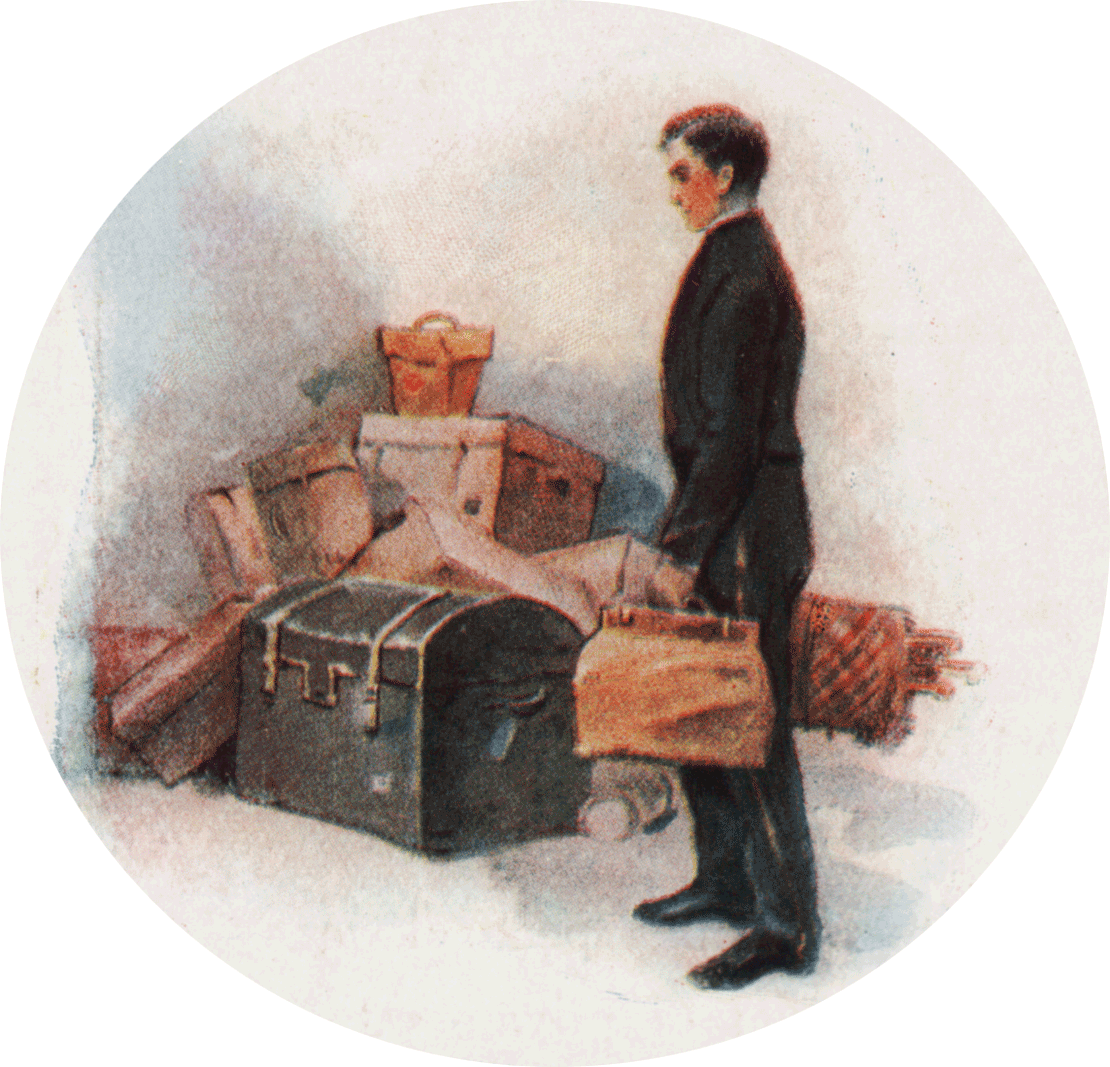
The hotel – designed entirely after an American model, was considered collapse- and fire-proof. For the first time, a hotel was built entirely with a steel structure. Its own power plant generated electricity, a deep well far below the Thames' groundwater supplied the hotel with fresh water, which bubbled up in a courtyard fountain and was heated into all baths. "Do you intend to accommodate amphibians?" a civil engineer asked when he noticed in 1884 that every room had a bath and every bath a bathtub. The Victoria Hotel, also opened around 1889, had four bathrooms for 500 guests.
The opening was sensational. All of London rolled through the narrow entrance into the new hotel's courtyard (today, this courtyard is covered and glazed over as the Thames Foyer). The excitement was immense. Yet D’Oyly Carte, as a man of the theatre, was all too aware of the danger of the nine-day wonder. For nine days, curiosity reigns, and people storm the new and unknown to explore, sniff around, love, or ... reject it. A hotel, however, was not a theatre play for a season. It had to be engaging throughout the year. It had to offer something on its stage that was nowhere else to be found. Otherwise, after the illusion of a gifted premiere came the reality of a half-empty establishment.
A little bird of noble bearing whispered to D’Oyly Carte that at the Hotel National in Lucerne, Switzerland, a certain César Ritz was working as the director. It is now pertinent to note – and I quote from the memoirs of a contemporary of Ritz who had observed him at the Grand Hotel National – "Were Mr. César Ritz not to introduce himself expressly as the manager of this splendid establishment, one might mistake this refined and distinguished figure for one of the most noble and illustrious aristocratic guests of his hotel. Mr. César Ritz gives the impression of a gentleman from head to toe — embodying the finest social graces, fluent in the languages of all cultured nations, making him appear as a native to French, English, Russian, and Italian guests alike. This phoenix of a hotelier casts a truly enchanting impression on everyone within the first few minutes, an impression that makes it quite understandable why the aristocracy almost without exception honors the Grand Hotel National."
With this reputation, Ritz approached D’Oyly Carte. Carte was interested in the Swiss man, around whom half the high nobility of Europe seemed to congregate. Furthermore, he maintained excellent connections with the American financial aristocracy, whom he had supported as a reliable hotelier on the Côte d'Azur, in Baden Baden, and indeed in Lucerne. The Vanderbilts, the Morgans, the Astors – for them, César Ritz was the point of contact. César Ritz, who had been dismissed as a boy from the inn Trois Couronnes in Brig, Switzerland, with the words "Boy, the hospitality industry requires a special talent... and you utterly lack it!", had made it.
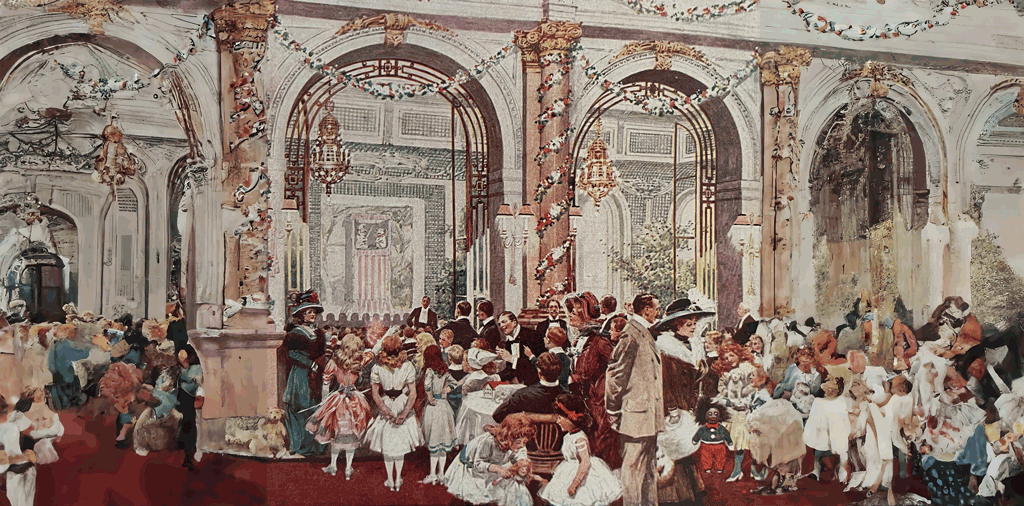 Children Christmas at The Savoy
Children Christmas at The Savoy
The diminutive man had developed the ambition to make something of himself. He observed his clientele: the fine tailored suits, the elegant footwear, not merely nailed together but the leather finely crafted with the sole, the original hats made from the finest felt. And the gestures. How the Prince of Wales casually pulled his watch on its golden chain from his waistcoat pocket, when to cut one's cigar, when to offer a light? Europe's grand dandy, a fashion idol of the high nobility and, after all, the future king of England, had caught his attention. He had followed him since the Vienna World's Fair in 1873, then again in Paris. This little waiter was always at hand. Soon it was the other way around, and the Prince of Wales is said to have remarked, "Wherever Ritz goes, I go!"
An essential part of Ritz's success was the culinary element, within which a certain Auguste Escoffier moved as proverbially as a fish in water. The Prince of Wales traveled specially to Monte Carlo to taste the French chef's specialties at the Grand Hotel. For the Poularde Derby, stuffed with rice, truffle, and foie gras, the portly heir to the throne would have trekked on foot. Later, he would serve him frog legs. This earned the French the English nickname "Froggies" and Escoffier a severe rebuke. The Prince of Wales eats everything, but certainly not frogs, he was informed.
Thus, the Ritz ecosystem gradually formed. Ritz and Escoffier were considered a power duo, a complete gastronomic concept. In this environment, a retinue of talented young hoteliers emerged, deployed by Ritz in his various hotels along the Côte d'Azur, in Baden-Baden, in Switzerland. And now, thus, the most modern hotel in London beckoned.
In the resorts of the continent, César Ritz was confined to the summer season. Each summer had to earn the money for the quiet winter months. However, London, as the capital of the British Empire, would offer the flair of a metropolis all year round. Ritz negotiated fiercely with Carte. For his first visit, he charged a proud £350 (difficult to convert, today representing a purchasing power of a hundred thousand pounds). Then he played hard to get. He had to attend to his businesses on the continent. His time was limited. Thus, he suggested installing his employee Louis Echenard as the director at the Savoy. A £500 annual salary would be a fitting remuneration. Initially, he concealed that Echenard was his head waiter.
Yet, Carte wanted Ritz personally. "I offer you £1,000 per year."
Ritz considered it. From this Savoy in London, he could probably make the best hotel in the world. It lay there by the Thames like a gleaming new Atlantic liner, just without a captain. The offer was incredibly generous. On the continent, a quarter of the sum was hardly paid for this position. Bold as he was, he gambled a round further: he demanded, for this sum, not to have to be present in London the whole year, but only six months. Furthermore, he demanded unrestricted freedom of action. For the time of his absence, he had already the right man up his sleeve: Louis Echenard. To lure the Londoners out of their clubs and activate the ladies of society, he played the culinary ace. Auguste Escoffier had to be part of the team. This would mobilize the ladies along with their husbands to go to the restaurants. After the theatre, for example.
Carte swallowed. Yet, he had no choice. He wanted this Swiss hotelier at any cost. He could also sell to the board that Auguste Escoffier would be part of the team. Carte had an infallible instinct for talent. On stage and in life. He hired Ritz, gave him all the freedoms he wanted, and paid what was demanded. Now he had a fantastic frontman and could turn back to his theatrical work. Oscar Wilde's American tour was upcoming. Ritz would deal correctly with his snobbish clientele. "Feel free to throw someone out if they're a nuisance!" he told Ritz on parting. "But, Mister Carte, I certainly won't do that. You must remember, the guest is always right."
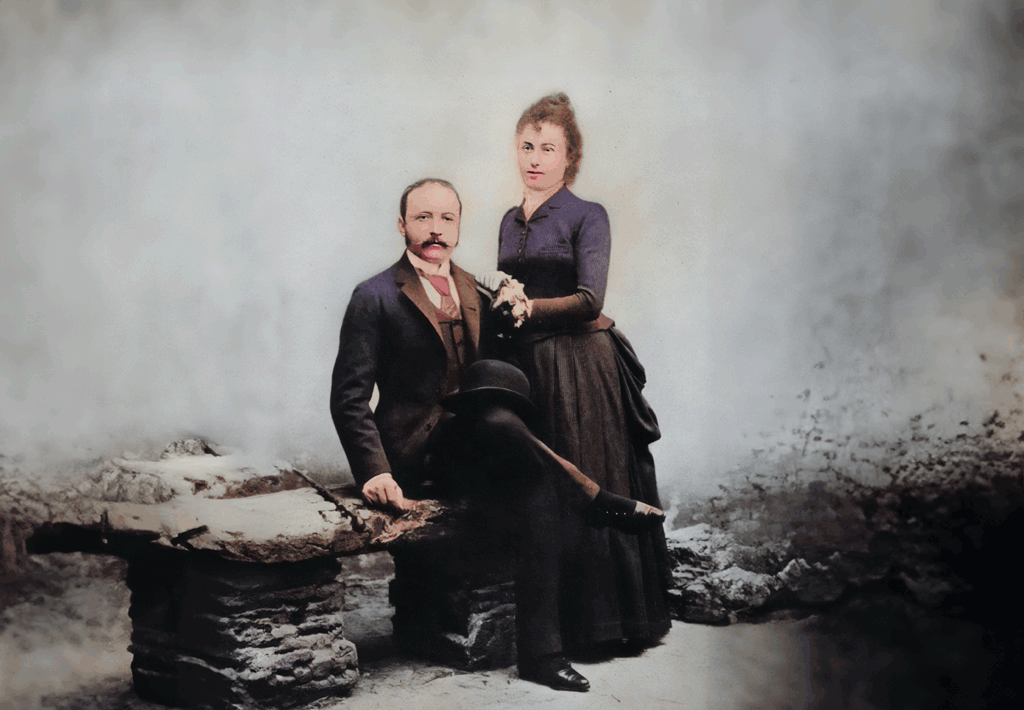
Ritz, 39 years old, moved to London. With him, his wife Marie. And Echenard, the finest wine expert on the continent, Escoffier, already over forty, who would refuse to learn English ("Otherwise I'll cook like them!"), his loyal cashier Agostini from Monte Carlo, and gradually a tail of devoted vassals. The Ritz ecosystem spread out. That it would become the greatest morass of English hotel history of the 19th century was not foreseeable at that time. It had been kept secret long enough.
Until that magical night when we opened that one box, on which in faded letters was written: "Strictly confidential."
It’s simple: HOTEL ARCHIVE
( words)
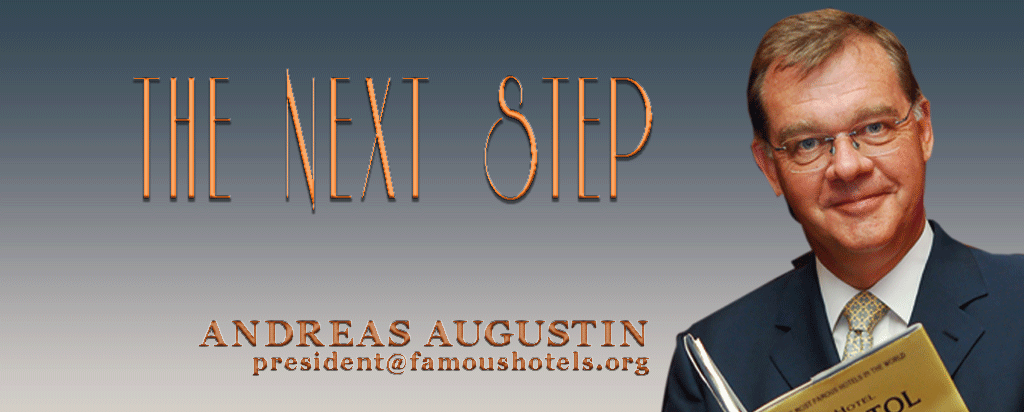 Am I getting on your nerves yet? Just wait until I'm fully up to speed. Today's exercise is a simple one:
Am I getting on your nerves yet? Just wait until I'm fully up to speed. Today's exercise is a simple one:
Preserve your present so it can become a past in the future. Too complicated? Not at all!
I asked ChatGPT to give me a precise explanation for the marvellous English word "sustainability." First off, as we've thoroughly learned, it means "sustainable." The extended definition brings us to our topic today. "Sustainability refers to maintaining something over a long period without exhausting resources or harming the environment. It can involve various areas such as environmental, economic, or social aspects and implies the responsibility to meet the needs of the current generation without compromising the ability of future generations." I couldn't have put it better myself.
This sustainability, ladies and gentlemen, pertains not just to environmental consciousness but also to your historical awareness. History is happening right now, as we sit here comfortably together. You are making history with your hotel. You produce menus, be they traditionally printed or digital. You create moments for your guests, for yourselves, and for your staff. But where are these moments recorded? What happens to them? Who will remember a price list from today tomorrow or in ten years? Who will be able to trace what you offered on your menus for special occasions? Which New Year's Eve menus or hotel brochures will still exist?
The answer is: a hotel archive.
Maintaining a hotel archive is not a major effort. Surely, the most challenging part is deciding the right person to regularly collect materials. This includes photos, menus, brochures, documents, reports on renovations and refurbishments, as well as significant acquisitions. The memories of long-standing employees, documented for your hotel archive, are invaluable.
You don't need to spend money or reinvent the wheel for a workable database. For instance, create an Excel file where you can chronologically organize events and easily retrieve them. The essential thing is not just to collect the material but ultimately to make it accessible to the public, whether online or as a publication. The range of options extends from PDFs to elaborately illustrated books, paying attention to copyright, correct citation, and simple academic guidelines for compiling and researching historical contexts.
Why all this effort? A few keywords: marketing, identity creation, ideas for events, upcoming anniversaries. Perhaps, for a change, learn from past mistakes. Keep a logbook to preserve anecdotes and history. Regularly print everything and store it in a secure location outside the hotel. Talk to your local archive/museum. They will be delighted with such documents and will process them professionally. Create a dedicated collection for your establishment.
I know you have other concerns at the moment, but properly maintaining a hotel archive will spare you and, more importantly, future generations one less worry. I promise you that.
questions under email in my image on the top
**Images above include:
The menu of the Savoy Hotel, London, from November 19, 1949, makes the wartime food shortages a distant memory.
What mysteries lie behind this elegant gold embossing of the Hotel Kulm in St. Moritz's New Year's Eve menu from 1947?
An initial drawing by the architect of the Bella Vista section of the Kronenhof Pontresina. An irreplaceable historical document.
This is how the Parkhotel Vitznau on Lake Lucerne celebrated Switzerland on August 1, 1909.
The Bahnhof Restaurant (like many others) had its daily changing menu. This one from 1924 was typed with a typewriter.
The two Baur Hotels in Zurich issued this bill for diner and lodgement in 1868.
Davos 2024
( words)
January 2024
At the GRAND HOTEL BELVÉDÈRE in DAVOS, SWITZERLAND, the WEF fever rules the house. The crown jewel of Steigenberger Icons, managed by Deutsche Hospitality, has expanded its useable area by over 1500m² artificial additions in front of the house. The staff is tripled every year, from 90 to over 300. The hotel resembles a fortress. Snipers are in position on the roof. Each available niche is rented as a meeting room. Evil tongues claim that the price per square metre is a result of the sea level multiplied by the year. That means it rises every year. Over 3000 people drop off their coat every day at the hotel's cloakroom. That alone is a logistical masterpiece. More than 300 events will be completed in five days.
It is superfluous to mention that this financial injection represents a significant part of the annual turnover. Amazingly, Deutsche Hospitality will not continue its operations in Davos
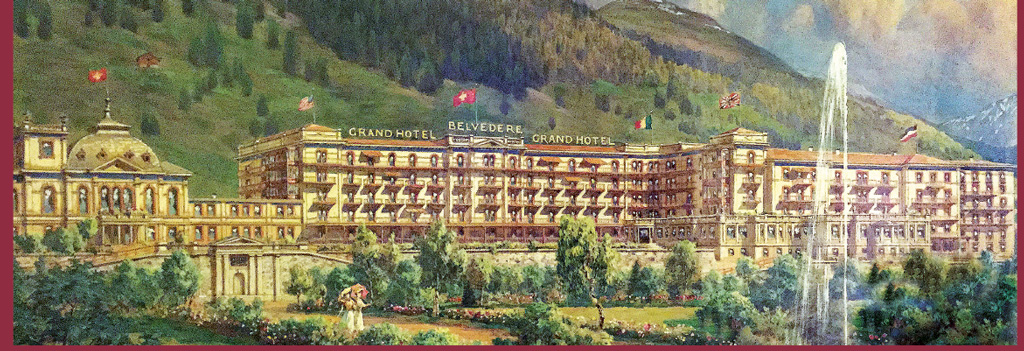
In the early 1870s, Davos seemingly transformed into one big globally renowned sanatorium. The Grandhotel Belvédère, established in 1875, diverged from this medical focus, evolving into a social hub of the residing society. They were used to permanent entertainment. Now they were here, sne ot be helad or to ... die.
By the 1880s, Davos' leading grand hotel Belvedere war hosting theatrical performances, had a casino, an American bar, tea salon, masquerade balls, tennis tournaments, and vibrant carnivals, it became a refuge from Bolsheviks, Nazis, and tax investigations.
 Renowned figures such as Sherlock Holmes author Conan Doyle, "Treasur Island" inventor Robert Louis Stevenson, and german author Erich Kästner frequented the hotel. Despite the current portrayal in the TV series "Davos 1917" the true epicenter of events was the Grandhotel Belvédère, not the rather secluded Sanatorium Schatzalp (today a charming 3-star resort). The hotel maintained its significance through the decades, hosting the World Economic Forum (WEF) and attracting notable guests like Gates and Clinton.
Renowned figures such as Sherlock Holmes author Conan Doyle, "Treasur Island" inventor Robert Louis Stevenson, and german author Erich Kästner frequented the hotel. Despite the current portrayal in the TV series "Davos 1917" the true epicenter of events was the Grandhotel Belvédère, not the rather secluded Sanatorium Schatzalp (today a charming 3-star resort). The hotel maintained its significance through the decades, hosting the World Economic Forum (WEF) and attracting notable guests like Gates and Clinton.
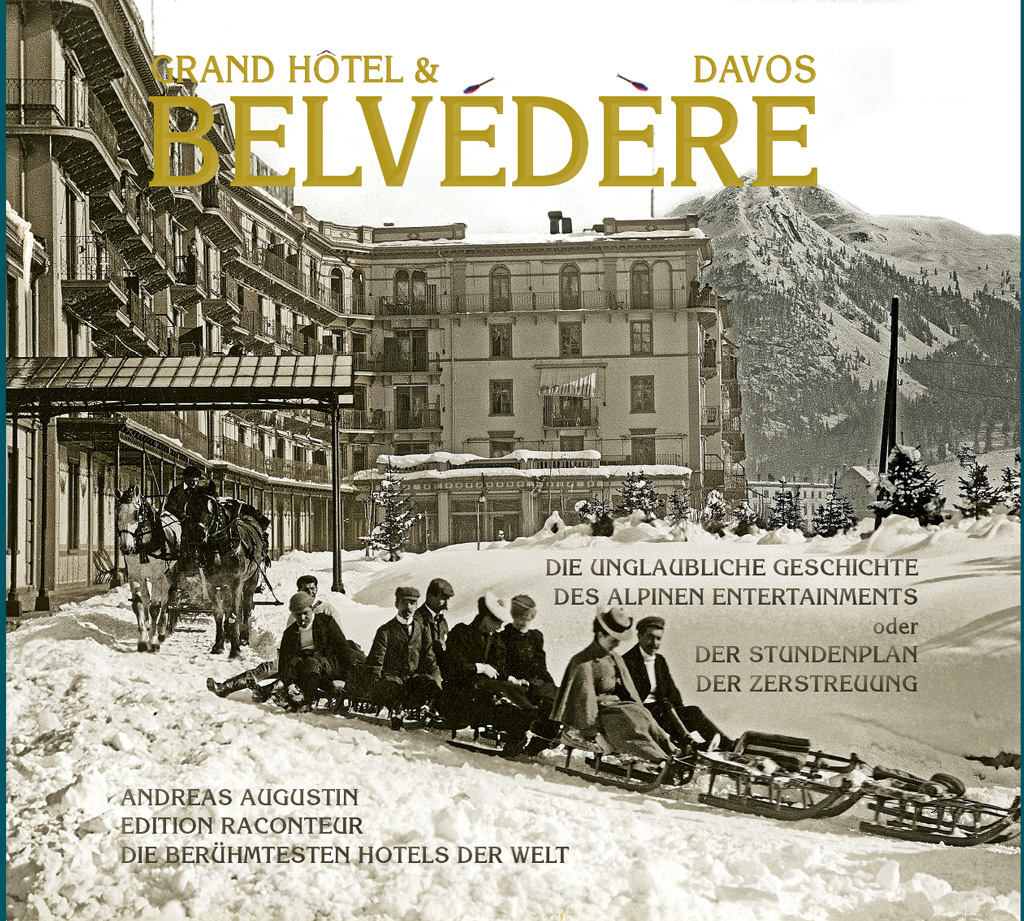 The hotel's history delves into the 1950s when Davos faced challenges due to medical advancements. Streptomycin's invention marked the decline of Davos as a sanatorium-destination. However, the Grandhotel Belvédère adapted, hosting events like the first Congress of the German Medical Association in 1971 and eventually becoming a key venue for the WEF.
The hotel's history delves into the 1950s when Davos faced challenges due to medical advancements. Streptomycin's invention marked the decline of Davos as a sanatorium-destination. However, the Grandhotel Belvédère adapted, hosting events like the first Congress of the German Medical Association in 1971 and eventually becoming a key venue for the WEF.
In-depth research, led by former General Manager Thomas Kleber, uncovered forgotten aspects of Davos' past. The Belvédère, distinct from the "Davos 1917" narrative, was a haven for intellectuals, artists, and politicians. The hotel's chronicle, "GRAND HÔTEL BELVÉDÈRE DAVOS — The Invention of Alpine Entertainment — The Schedule of Distraction," meticulously details its rich history and remains a valued asset for historical preservation. Here is the english edition.
The book's presentation became a significant social event, followed by annual readings. The establishment of a "Path of History" within the hotel, showcasing its historical journey, enhanced its appeal as a historical attraction.
In conclusion: the Grandhotel Belvédère's evolution from a tourist hotel to a key player in Davos' social and economic history is a testament to its resilience and adaptability. The meticulously researched book and ongoing efforts to unearth new historical material contribute to the hotel's enduring legacy.
The thorough exploration of guest registries revealed a diverse array of notable visitors, including Conan Doyle, Robert Louis Stevenson, and Tchaikovsky. The hotel's continuity and personal connections with guests, maintained by generations of hoteliers, contributed to its success.
Today the hotel is a key player for the Davos summit WEF The WEF's annual dominance transforms the hotel, reinforcing its role in the global economic landscape.
The meeting of the powerful from all over the world is a great challenge for the security forces. Rigourous measures require, for example, the visits of President Volodymyr Selenskyj from Ukraine, Emmanuel Macron from France and Isaac Herzog from Israel. Checkpoints, snipers on the roof of the hotel, no-fly zones and several dozen kilometres of temporary fence are just a few of the measures. Up to 5000 Swiss soldiers support the police during the five-day meeting.,
As per January 2024:
Owned by the Steigenberger family the future of the hotel is now uncertain. Deutsche Hospitality is not continuing its management contract.
A Christmas Carol
( words)
Top: a bird's view from the top of the Mandarin Oriental Savoy, Zurich inset: GM Mark Bradford
By Andreas Augustin
 A CHRISTMAS CAROL
A CHRISTMAS CAROL
Mark Bradford, born Swiss, the offspring of Scottish immigrants, stands poised upon the rooftop terrace of the Mandarin Oriental Savoy, Zurich — the hotel he is reopening at Christmas 2023. His gaze sweeps across the urban sprawl towards Lake Zurich, capturing the Alps draped in snow, glistening like crystalline marvels under the sunlight.
“Isn’t this vista simply breathtaking? On the hotel’s debut in 1838, perched atop were dainty orange trees. In the heart of winter! We shall adorn the space with Mandarin trees. Come spring, this rooftop terrace shall evolve into the epicenter of downtown.”
At the age of 22, Bradford (having completed his studies at Collège Saint Michel in Fribourg, Switzerland, under the tutelage of Economics Professor Joseph Deiss and at the legendary ehl ecole hôtelière de lausanne) stumbled into the realm of hospitality following his stint in the military in Graubünden. It was the legendary General Manager Kurt Wachtveitl who offered him an apprenticeship at The Oriental in Bangkok. That marked the indelible moment when he became ensnared by the infectious allure of the hospitality industry. Furthermore, he imbibed the tenets of the (later Mandarin) Oriental philosophy.
After decades spent abroad, he has now returned to his roots as the General Manager of the Mandarin Oriental Savoy, Zurich. In short: “the heart” of the town. "Six floors below us, Bahnhofstraße converges into Paradeplatz. If one were to place a cartographic pin here, it would precisely mark the most expensive real estate spot in the world. Every Swiss person has known since childhood that this Paradeplatz and Bahnhofstraße represent the most expensive properties on every Monopoly board."
We have met Mark at the Mandarin Oriental in Bangkok in the 1990s, during its recurrent accolades as the preeminent hotel globally, and as we delved into the history of this Thai hotel classic to produce the book The Oriental — The Amazing Tale of Bangkok's Legendary Hotel. He recently inquired of me, ‘What knowledge do you possess regarding the history of the Savoy in Zurich? Or Baur en Ville. Or Baur?’
“Quite a bit. Have you got a minute? After all, this stands as Zurich’s oldest Grand Hotel,” was my response.
Shall we embark? Join me while we travel backwards some 200 years. It was an individual from the Austrian province of Vorarlberg, a certain Johannes Baur, who inaugurated this hotel in 1838. He partnered with the then-unrecognized, yet subsequently esteemed architect Daniel Pfister, who would eventually carve a name for himself as a renowned hotel architect. Pfister later took on the construction of the ‘Neue Krone,’ presently the domicile of the Kronenhalle.
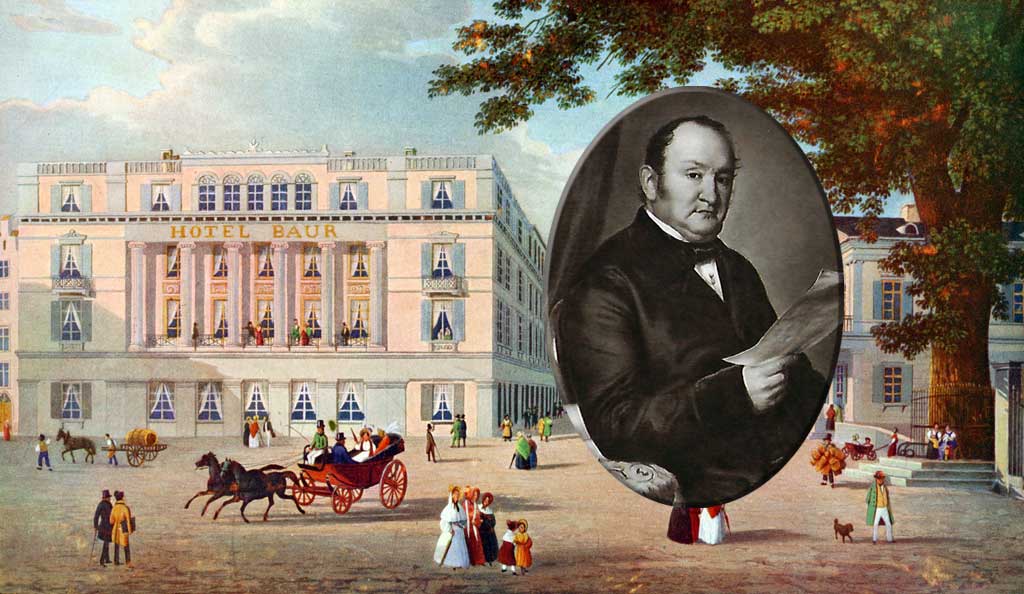
HOTEL BAUR — with Johannes Baur — a 1838 illustration showing the new hotel Baur, today Savoy.
By 1838, Baur was already a familiar figure in Zurich. He had been a denizen since 1825. Married a certain Anna Knechtli. Managed a café on Marktgasse. Subsequently, he procured a house and introduced the beer tavern ‘Zum Meierli.’ If I divulge that this establishment corresponds to the current Restaurant Orsini, you’ll grasp the reference. From that juncture, it was a somewhat convoluted yet not excessively protracted journey to acquire the contiguous property and erect a hotel.
Reflecting back on the year 1838: Zurich was a burgeoning commercial hub. Intellectual pursuits flourished at the universities. Liberal ideologies were gaining traction. Silk manufacturing constituted a pivotal aspect of Switzerland’s economy; the earliest mechanical weaving mills were being installed. The ‘Silk Yards’ in Zurich attained global renown, with the silk industry ranking amongst the foremost industrial sectors. Around 1830, Switzerland led European nations in per capita value of exported goods. Concurrently, the banking sector expanded. In 1815, there were merely ten banks in Switzerland; by 1830, the count had burgeoned to 74. Transportation underwent a transformation with the enhancement of crucial mountain passes. The maiden steamships navigated the lakes. The nascent hotels emerged, and the earliest tourists were ‘spotted.’
Zurich housed a mere 15,000 inhabitants. Bahnhofstrasse (Train Station Road) was non-existent (owing to the absence of a train station). No Paradeplatz. Ergo, seemingly, the locale where Johannes Baur unfurled his hotel lacked any discernible allure. Well, not precisely. Right opposite the hotel, in 1838, loomed the Posthof, now reincarnated as the ‘Zentralhof.’
 The ‘Post’ didn’t merely dispatch letters but primarily ferried people. This was essentially the ‘main station’ of Zurich. It was the point of arrival for all and the departure point for everyone. There existed no superior location in the entire city to inaugurate a hotel. Specifically, where there was hope that sooner or later the train station would be built nearby.
The ‘Post’ didn’t merely dispatch letters but primarily ferried people. This was essentially the ‘main station’ of Zurich. It was the point of arrival for all and the departure point for everyone. There existed no superior location in the entire city to inaugurate a hotel. Specifically, where there was hope that sooner or later the train station would be built nearby.
By the end of the 1830s, the market was hungry for a good hotel. The situation at the time is best described by Murray's first guidebook of Switzerland (1837): ZURICH-Inns: The inns at Zurich are notoriously dirty, high priced and ill attended: they have hitherto enjoyed a monopoly, and there has been no inducement to improve.
Baur embarked on this venture with unparalleled fervor. The sheer number of rooms surpassed anything hitherto classified as a grand inn. Beyond 142 ‘rooms,’ stabling for 40 horses and ten carriages were provided. It essentially heralded the advent of Zurich’s inaugural Grand Hotel. In Geneva, stood the ‘Hôtel des Bergues,’ extolled for its luxury and a few years senior. Even the venerable ‘Drei Könige’ in Basel lag far behind what it aspired to become.
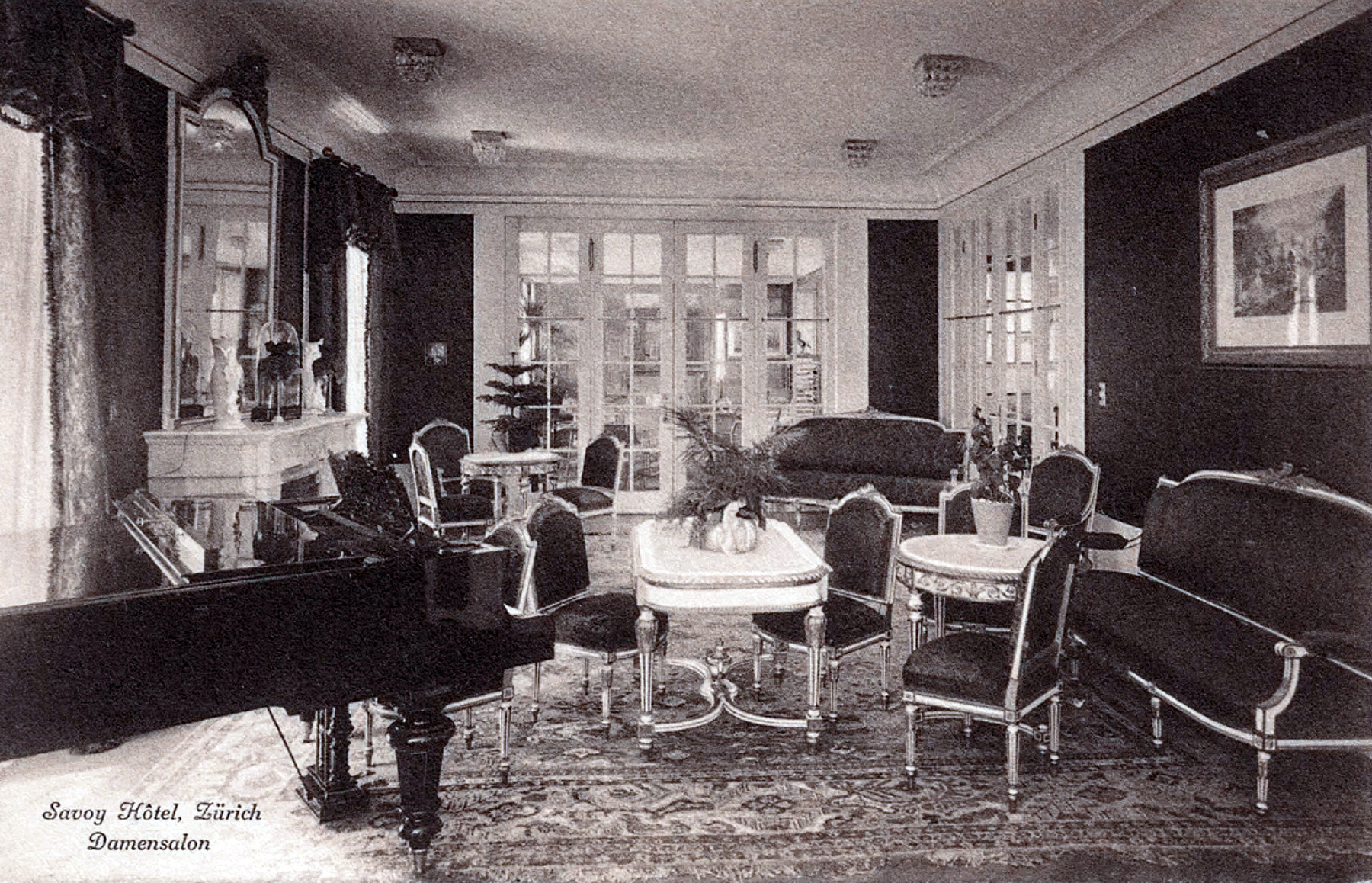
The salons were tailored to cater to the needs of voyagers. A dedicated Damensalon - ladies’ salon - was conceived to accommodate female travellers who found themselves uncomfortable amidst the cigar and pipe-laden ambiance of the gentlemen’s salons. In the library, where patrons whiled away time until the departure of the next stagecoach, the English guest pored over his ‘Murray’s,’ the diminutive red compendium, discovering that the journey from Zurich to Paris spanned three days. In the dining hall, illuminated and warmed since five in the morning, guests convened four times daily for the expeditiously served ‘table-d’hôtes’ meal, accompanied by wine or beer.

The white elegant building of the hotel and the frogs' ditch Froschengraben in front of it.
Lying ahead of the hotel was the Froschengraben, a trench eventually transmuted into Bahnhofstrasse. The ambiance was not always fragrant. Thus, the Belvedere towered above as the zenith of the hotel. This delightful rooftop garden, boasting a 100-metre long, three-metre wide walkway, was christened as such. Here, during sultry summer days, one strolled high above the thoroughfare amidst pristine air. Passing by miniature orange trees, one could gaze upon the city, the Fraumünster. Not far off, the lake gleamed. What a Biedermeier tableau unfolded here. Travellers relished the panoramic vista. ‘Oh look! Oh my God. Is that snow on the mountains?’
At the petite tables on the rooftop terrace, patrons frequently ordered a chilled beer and a bratwurst paired with sauerkraut. ‘Right away!’ echoed the attendant, the nomenclature reserved for the waiter. He turned towards a funnel and announced the order within. ‘Else, he remains stationary!’ bemoaned a disillusioned guest, before realising, ‘Three storeys below, every desire is instantaneously catered for in the kitchen and promptly dispatched via a food lift. It’s an innovation that’s unmatched. Ordering via speaking tube and a dumb waiter!’
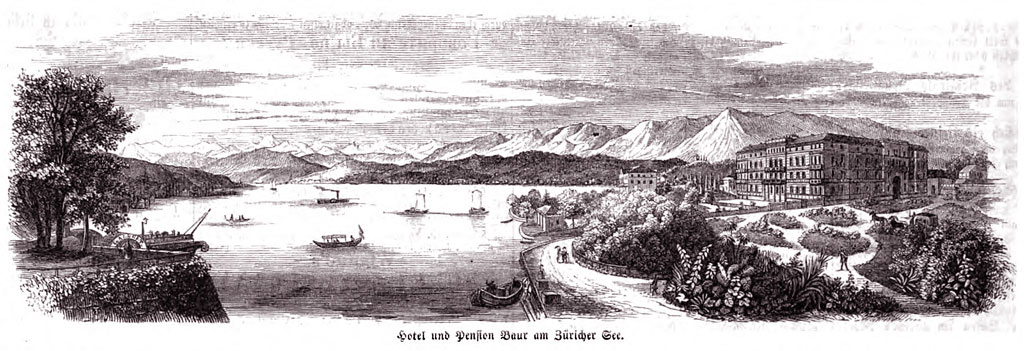
This illustration celebrated the new building and its new facade (1854) of the Hôtel Baur au Lac at the Lake Zurich
"Even a lakeside property piqued Baur's interest. He envisaged a grand hotel there, featuring its most exquisite rooms and balconies overlooking the lake. Utter nonsense, they told him in the city. Who would want to gaze over the lake? Well, times do change. What would Zurich be today without the Baur Au Lac?
Let's stay within the realm of Baur in the city, soon to be christened Baur en Ville to distinguish it from its younger sibling by the lakeshore. Around 1910, the name took a turn towards Savoy. And today, it stands as the Mandarin Oriental Savoy, Zurich.
I'll spare you the intricacies of various additions and renovations. However, it's noteworthy that the original Hotel Baur was expanded several times, extensively around 1908, and the entire hotel was simply demolished in 1975. The most distinctive elements of the facade were removed beforehand and meticulously reinserted after reconstruction.
Our research embarks on another intriguing phase
We've delved into the guest registers of the early decades. Tourism in Zurich was shaped by business travellers; addresses of hotel guests ranged from China and the Dutch East Indies to New York. Many Swiss merchants, famous names from old families. Let's not forget that over 250,000 Swiss Francs from investors in Switzerland were allocated for the hotel's construction.
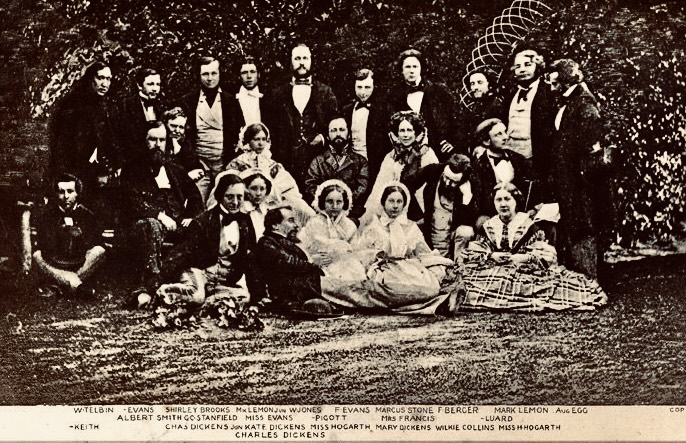
The Dickens family: when they travelled together they needed quite a number of rooms!
And then, of course, the legendary names. One day, from a carriage emerged a man with curly hair and a goatee, alongside his wife, five children, four servants, and likely a few more, as there are records of 13 individuals arriving with Charles Dickens. Two years after he published his famous 'A Christmas Carol' he arrives in Zurich in 1845.
Dickens had taken a break with his large family for almost a year in Italy, July 1844-June 1845, in a decade when Europe, including Italy itself was seething with revolution. London was a poluted city. On his way back from Italy he resides at the Hotel Baur. His literature, such as Oliver Twist or A Christmas Carol, was already known by every child in Switzerland at that time.
Speaking of Switzerland: it didn't exist yet. It was founded as a federal state three years later, in 1848. A democratic experiment that drew wary amazement from the royal houses and princely courts of Europe.
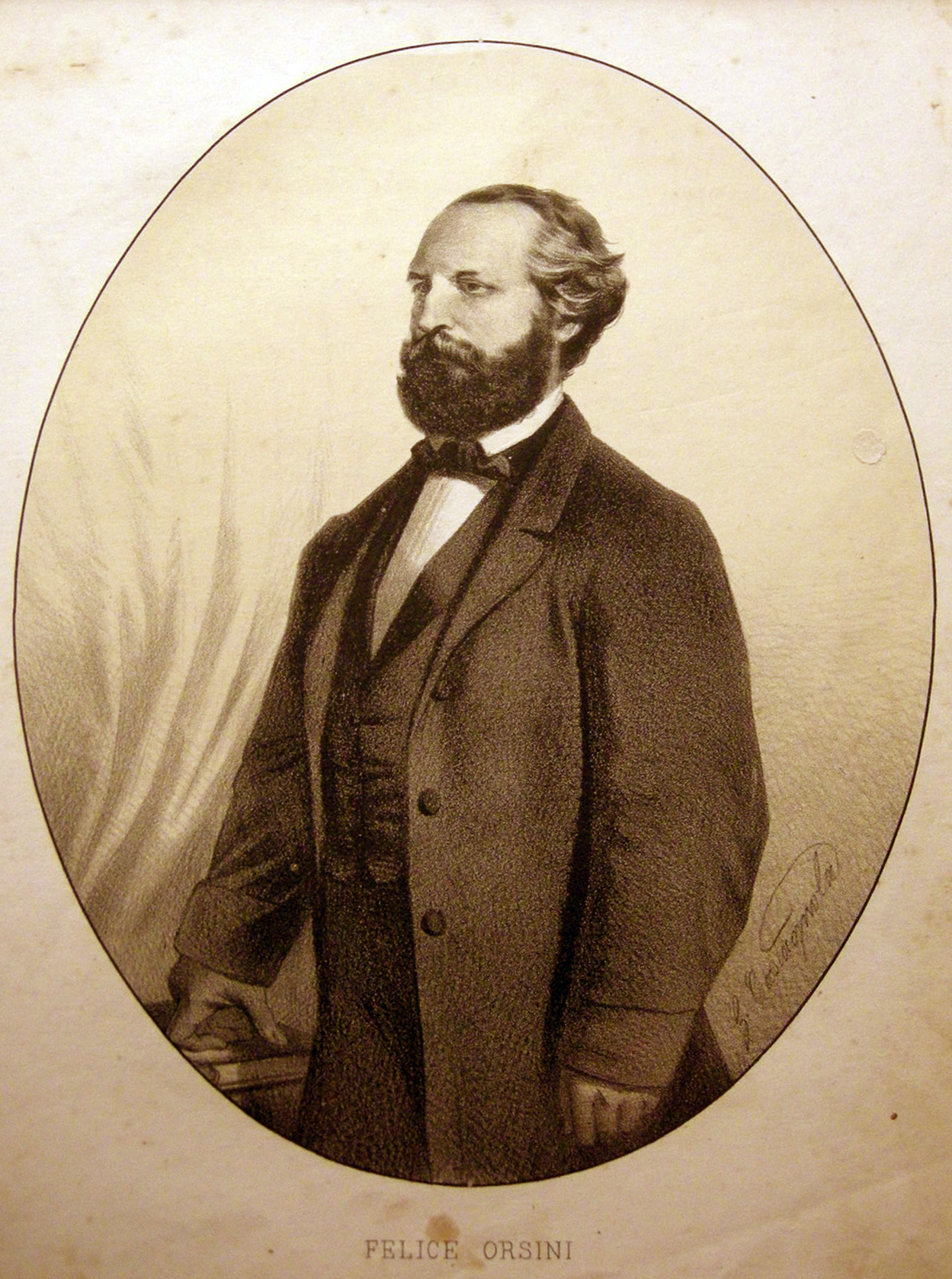 Felice Orsini
Felice Orsini
Looking at the list of guests who stayed here back then, I notice that some had participated in the Congress of Vienna in 1815. Some probably even knew Napoleon personally. At least from a battle. By the way, Napoleon was the uncle of Napoleon III, who narrowly survived an assassination attempt in Paris in 1858. That's intriguing for our story. The assassination was carried out by a certain Count Felice Orsini. Orsini was subsequently executed. His revolutionary friends in Zurich commemorated him. They hung a portrait of him in the 'Zum Meierli' inn at the rear of the Hotel Baur. Soon after, the inn was renamed 'Orsini,' presumably because locals used to say, 'Let's go to Orsini.' Now you know this tale too.
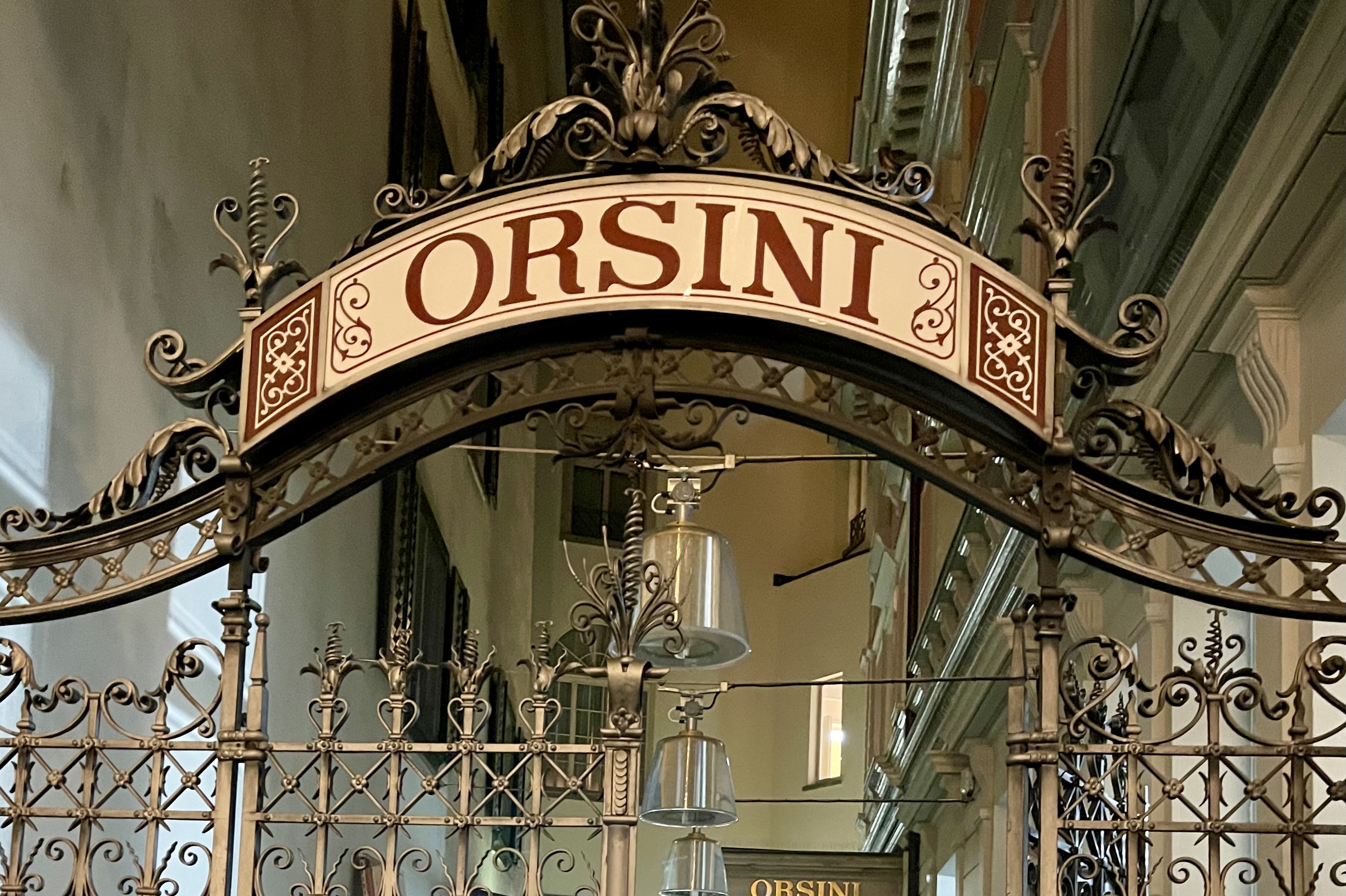
I could regale you endlessly with stories of guests like Franz Liszt and Richard Wagner, Clara Schumann who practiced for her piano concerts in the ladies' salon, or the King of Bavaria's lover who hid in the hotel, waiting for her love to arrive.
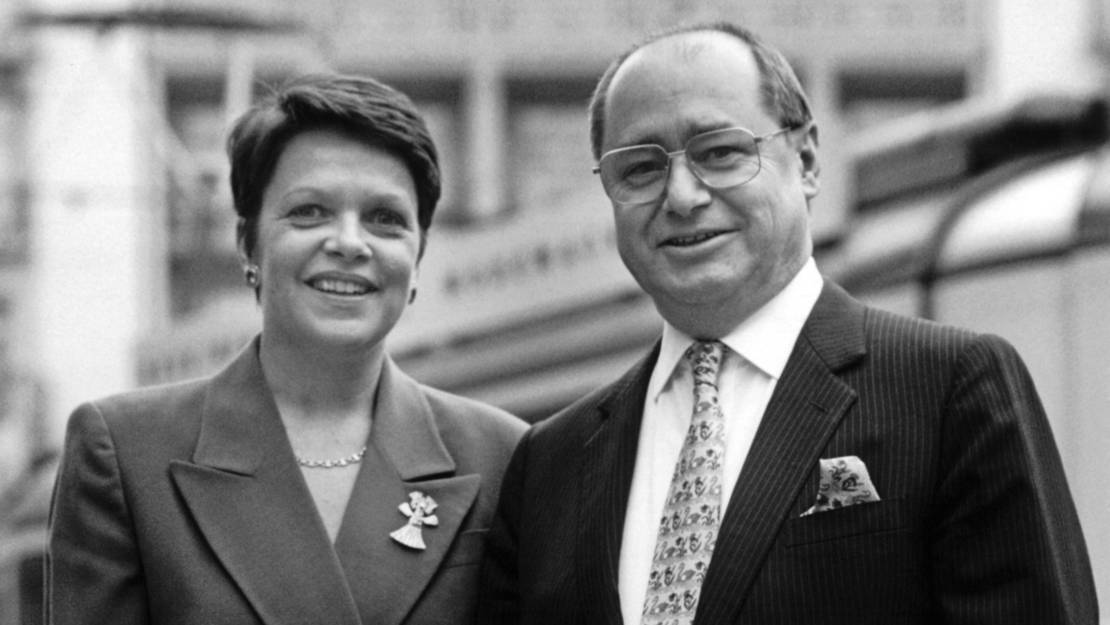
Dedicated hoteliers: Christina and Manfred Hörger managed the hotel for decades
Or of the fantastic hotel directors who, throughout these decades, successfully kept the hotel thriving. Naturally, the Baur family, then the Michls as independent leaseholders from 1930, followed by directors Hörger, Knechtli, Brönnimann, and all those diligent souls not mentioned here.
From December 21st, 2023, the hotel will reopen after a two-year renovation. This time, it's known as the Mandarin Oriental Savoy, Zurich.
General Manager Mark Bradford is delighted with 80 'room keys.' A jest! As they are, in fact, keycards for 36 quite spacious suites and 44 'standard' rooms - all designed by the Parisian star designer Tristan Auer.
The historic ballroom remains in the same location but has, of course, been renovated. There are ten meeting rooms, the guild room of the Tanners and Shoemakers (stalwart guests for a century!) with original parquet flooring, the Savoy Brasserie & Bar, and, naturally, the Orsini.
Oh yes, the rooftop terrace is reopening too. It's named '1838.' Instead of orange trees, this time, there are Mandarin trees, fitting for the hotel group's name.
--------------- fin --------------
Hotel manager Kai Jansen
Chief concierge Berkan Caglar
Staff: 150 for 80 rooms
Swiss Hospitality
( words)
A Journey through time, ending in 1927. A Travel Report takes us back to the roots of grand Swiss Hospitality. The country produced a remarkable set of "Grand Hotels", such as HOTEL BAUR (inset: Johannes Baur) above.
"Am now looking over the Lake of Geneva, at its lower end, where the Dent du Midi and the mountains of the Rhone Valley form such a splendid group above and beyond Villeneuve," Mrs. Kemble wrote from Territet Montreux, in 1878; "I think you must have stopped at Villeneuve, some time or other, going over the Simplon into Italy. There used to be a charming house there, the Hotel Byron, standing alone in its own grounds, quite at the end of the lake and just above the Chateau Chillon. "I always used to stay there on my way up and down the Rhone Valley. It was kept by two brothers of the name of Wolff, who were proprietors also of the good old-fashioned Hotel L'ecu de Geneve in Geneva. They having failed, and the person who took the Hotel Byron after them failed also, the pleasant house is now shut up, and I do not suppose it will ever be opened as an hotel again. "The railroad now runs all the way from Geneva to the foot of the Simplon, an easy journey of less than eight hours, and nobody wants to stop half way at Villeneuve.
"Then, too, there is really almost a continuous terrace all along the shore of the lake from Lausanne to Villeneuve of hotels like palaces, one more magnificent than another, with terraces and gardens, and fountains and bands of music, and such luxurious public apartments, and table d'hote, that it is absolutely impossible that some if not several proprietors of such costly establishments should fail to make them answer, especially as in travelling, as well as everything else, fashion directs the movements of the great majority of people, and for the last few years there has been a perfect insane rush of the whole tourist world to the valley of the Upper Engadine, to the almost utter forsaking of the formerly popular parts of Switzerland. "The house I am at, the Hotel des Alps, is a magnificent establishment, but there are very few people in it, and the manager seemed to me rather depressed in giving me an account of the failure of the proprietors of the Hotel Byron, and said there was not a corner of Switzerland now without a huge hotel, and that every year half a dozen hotel keepers become bankrupt." Mrs. Kemble was incorrect in her prophecy, for the Hotel Byron was reopened and is still in successful operation.
"The Hotel Byron at Villeneuve, near Montreux, is a rather old house, dating from some time before the year 1840. It was named in honor of the English poet, Lord Byron, who with the poet Shelly had visited Villeneuve, where Jean Jacques Rousseau had been long before them herborizing in the neighborhood, and where Napoleon had halted before he went to Marengo. Rudolphe Tôpffer, the author of "Genevese Tales," himself a native of Geneva, was a guest at the hotel about the time his Tales were published, in 1840.
Sainte-Beuve said of this now little known Swiss litterateur, that to read him is one of the sweetest, most winning, and healthiest of literary pleasures. About the same time the hotel had Franz Liszt as a sojourner, and with him was the Countess d'Agoult, whose pseudonym was "Daniel Stern," and who was the mother of Madame Cosima Wagner, wife of the composer. Victor Hugo with his family stopped at the Hotel Byron two years in succession. Edgar Quinet, the inspiring if not-too-well-informed French historian and poet; Elisée Reclus, the French popular scientist; and the French painter, Gustav Courbet, were more than once guests of the hotel, which also has entertained the Royal family of Greece; the Grand Duchess of Luxembourg; the Duke and Duchess of Braganca; the Count de Montgelas; Professor Nicolai; the novelist, Waldo Frank; Ossip Gabrilowitz, eminent pianist; Stefan Zweig, popular German novelist; Dr. Thomas Masaryk, first President of Czecho-Slovakia; the Indian poet, Dr. Rabindranath Tagore; and Lucas Mallet, the English novelist.
Hotel Baur au Lac, at Zurich, is not quite so old as the house just mentioned, but as it dates from the year 1844 , it is more or less coeval with the beginning of the great hotel enterprises in Switzerland, which were typical of the nineteenth century. It was founded by and received its name from Johannes Baur. Born a baker's boy, whose father kept the Lion Inn in the Austrian town of Götzis, of which municipality the elder Baur was mayor. The son was intensely interested in architecture, and as he had great skill in drawing he began to design buildings when not engaged in the bakery. Some of his plans were pretentious and ambitious, and he soon found himself advising the builders of Zurich. Among his visions was that of a large hotel.
At the same time an architect of the city, a Mr. Stadler, had been visioning a new thoroughfare, the present well-known Poststrasse. One of the property owners whose building was affected by the cutting of the new street was given a lot in exchange. He had to obligate himself to erect a building to harmonize with the architecture of the new post office opposite to his site. The result was the first Hotel Baur, which was opened simultaneously with the new post office in 1838, and on this auspicious occasion a banquet was given in the large hotel dining-room for the post office clerks and staff.
The Hotel Baur was then regarded as a monster. It contained 142 beds, a large number for a "Gasthof", as inns were called at the time. The hotel offered an airy "Belvedere", a rooftop garden, with waiters serving refreshments. They were ordered from the kitchen by means of a speaking tube. The orders were delivered to the rooftop by a dumb waiter (a food-lift). Revoltuionary and farsighted for these days.
In 1843 the first of a series of enlargements, which continued at intervals for twenty years, was begun. Some of the site adjoining which had been secured was on the lake and filling in had to be resorted to. The result and the daring method of achieving it caused Baur's fellow townsmen to regard him as having been bereft of his common sense. When the improvements were completed it was seen that the hotel faced the lake while tradition to that time had demanded it should face the town, and the good citizens felt certain Baur was not properly balanced. By degrees it dawned on them that a valuable architectural work had been bestowed on Zurich, and they began to feel a pride in the great hotel.
In 1853 Johannes Baur purchased a manor at present on Lavaterstrasse, and enlarged it by grounds near the lake. This annex to the hotel was designed for princely patrons, who desired to maintain their incognito while in residence in Zurich. Additions to the hotel did not cease after the founder's death, but were continued until the last wing was built in 1890. In acknowledgment of their merits with regard to intercourse with foreigners, the city of Zurich endowed both Johannes Baur and his son and successor, Theodor Baur, with the right of citizenship in the year 1859.
Theodor Baur, the son, together with Jacques Tschumi founded the first hotel school in the world. Tschumi became the president of the Ecole hôtelière. He was the managing director of the Lausanne Beau Rivage Palace and an influential member of the Society of Swiss Hoteliers. Of course he championed the creation of the school to train professional hotel staff, founded in in Ouchy-Lausanne as the first professional school for hotels. He also was the first to suggest the abolition of tips (but did not succeed in having his proposal accepted). He was the pioneer in the improvement of navigation of the lake, and in 1868 was instrumental in the introduction of concerts on the steamers.
The hotels of Johannes Baur were favored by the noble and princely families of Europe. The Royal family of the Netherlands, the King of Sweden, with his family and suite, resided there under the title of Count of Tulgarn. Four years later the Duchess of Orleans was a guest.
In 1859 the representatives of the leading European Powers resided at both hotels, exclusively reserved for the parties involved. We are talking about the Peace Congress of Zurich which brought the representatives of Austria, France and Italy to the city. On November 10th they signed the "Peace of Zurich" in the room, now known as drawing-room 26. This is considered the foundation of modern Italy.
The Duchess of Parma and her suite were at the Baur au Lac the same year, and in the summer of 1860 royalty was almost constantly represented, for in succession came the King of Bavaria, the Empress of Russia, with two princesses and suite. The Austrian reigning family were frequently guests at the hotel and Empress Elizabeth stopped there on her journey to southern countries.
There also have been entertained at Hotel Baur au Lac the Duke of Meiningen, the Khedive of Egypt, and the Princess of Wales, afterward Queen Alexandra.
When, in 1889, Karl Kracht, son-in-law of Theodor Baur, took possession of the hotel the house received modem improvements, for Swiss hotels in general had begun their development from the old-fashioned methods to the newer order. Among other innovations which followed the tea-concerts. This was a new idea in Swiss hoteldom. Karl Kracht engaged a troupe of lively Neapolitans to entertain. Mr. Kracht, who died in the year 1914, fell ill in 1910 and consequently he did not have the opportunity to manage the entertainment arranged at the Hotel Baur au Lac for Kaiser Wilhelm II, who visited there that year.
Read also: Breakfast with Michel Rey, General Manager of the Baur au Lac (2010).
From 1870 to 1880 Theodor Baur had managed the Quirinal Hotel in Rome in connection with the Baur au Lac, while Karl Kracht, himself the son of a hotelman, brought about the connection to the Hotel Ernst, in Cologne, since 1910 known as Excelsior Hotel.
The Hotel Interlaken, in the city of Interlaken, which lies in the lowlands between the lakes of Thun and Brienz, is one of those typically Swiss hostelries whose history seems connected with the distant past. It stands on a site of a hotel which is believed to have been erected about 1491, or the year before Columbus discovered the New World.
It was built in front of the old monastery, which still exists as a structure although the community was suppressed in the sixteenth century. Part of the original structure of the hostel, which was conducted by the monks, remains. The old chronicles of the neighborhood connect the gasthaus, or monastery tavern, with many interesting legends and traditions. In 1551, it is said, Master Austabl, the Scharfrichter, or executioner, and his assistants had much work to do for the monastery, for four malefactors were condemned, two to death by the weights. All of them are said to have been assembled in the Gasthaus for their last meal. The hostel was rebuilt in 1759, and frequently since then modern features have been added to it and the hotel kept up to date. For four hundred years the same hotel has been in existence, originally under the domination of the monastery.
Lord Byron was a guest in 1816, and, the great composer, Felix Mendelssohn-Bartholdy, was likewise a visitor in the years 1842, 1846 and 1847. In the seventies of the nineteenth century three crowned heads were guests at the same time at the Hotel Monnet, at Vevey, on the Lake of Geneva. The unusual honor of having the sovereigns of three great states of Europe meet and stay together in his hotel, which lies on the shore of the lake, caused the proprietor to change his sign and since then the house has been known as Grand Hotel des Trois-Couronnes. These three monarchs were Emperor William I, of Germany; Emperor Francis Joseph, of Austria; and King Umberto, of Italy-the triple alliance, in person, it might be said. Dukes, princes, counts and other nobles have frequently been guests at the house since its foundation in 1842.
There is still to be seen over the fireplace in the ladies' room of the hotel a pair of beautiful Sevres vases, the gift of the Tsarina of Alexander I, of Russia, who once hired the whole hotel for her court nobles and guests. The hotel stands on a historic spot, for as early as the year 1090, according to the archives in the Chapter House of Lausanne, the Bishop of the City bequeathed to his nephew, Vaucher of Blonay, a "stronghold" in Vevey. This castle had its moats, draw-bridges, towers and battlements, and also served as Court of justice to the High Tribunal of the fiefs. In 1345, when the estate passed to the lords of St. Paul at Evian, it became known as the Chateau des Belles-Truches. It belonged to Bishop Aimon of Montfaucon in 1516, and this churchman sold it to the lords Gingins, who did not long retain it for the property passed to the possession of the town of Vevey in 1571. After becoming the property of the town, a club was formed for the exercise of fencing and shooting. Its members belonged to the best families in Vevey. The estate then became known as the Abbaye des Echarpes Jaunes.
In 1842 the old "stronghold" was removed and a hotel, at first named for its proprietor, Hotel Monnet, was built on the site. This later, as has been related, became the Grand Hotel des Trois-Couronnes. Hotel Krone (Crown) in Solothurn, Switzerland, which is situated opposite the Cathedral of St. Ours, claims to be the oldest hotel in that country. In the year 1411 it was already a tavern, and since that time has been developed, extended, and modernized. There was a Guild of Land-lords in Solothurn as early as the fourteenth century, and as the Crown is mentioned as the first inn with the right to accommodate travellers, it is believed that the inn has been where it now is for at least five hundred years. It had a favorable position on the main road, and even in the early Middle Ages the passage over the Aare was animated with the great convoys of merchandise and the stately retinues of nobles and gentlemen, for the town was on the chief highway between the Rhine and Geneva.
The old inn stands on the public square and in it, in the days long past, many events, including the holding of open-air courts of criminal procedure, were held there. Fetes were held by the French ambassadors on anniversaries of their sovereigns and dauphins, and the distinguished guests of the municipality on these occasions were always lodged at the Crown. While the Prince of Conde was going through the military school at Solothurn, in 1863, his father, the Duc d'Aumale, resided at the Crown. The great names that have been connected with the hostelry during its five centuries have never been compiled, but some of the eminent ones of more recent times are interesting. On November 23, 1797, while on his way from Italy to the Congress, in Rastadt, General Bonaparte, afterwards the Emperor Napoleon, stopped at the door of the Crown.
The local Government had arranged to give him a grand reception. Bonaparte, in his carriage, stopped before the inn long enough to hear the invitation, but he declined, and drove on to Rastadt. The Empress Josephine, however, did rest in the Crown on one of her journeys; and the list of modern monarchs who followed her is a fairly long one. The King of Wurttemberg was there in 1808; Frederick William III, King of Prussia; the Queen of Naples, in 1837; the Queen of Holland, in the forties of the last century; the Archducal families of Mecklenburg—Schwerin and Mecklenburg—Strelitz, in 1841 and 1842 respectively; in the fifties and sixties of the same century there were the Queen of Holland, the King of Portugal, the King of Wurttemberg; archdukes, princes and princesses innumerable. The Dowager-Empress of Russia was a frequent guest; the Prince of Wales, afterward King Edward VII, the Count of Paris, Queen Amelia of Portugal; the Crown Prince and Crown Princess of Belgium; the present King Albert and his Queen consort; Crown Prince, later King Humbert, of Italy, were among royalty who broke their journeys across Switzerland by resting at the Crown.
In the hall of the Beau-Rivage-Palace Hotel, at Ouchy-Lausanne, is a Peace monument, the work of Edouard Sandoz. On the wall, and flanking the statue on either side, are these two inscriptions : Entre le Royaume d'Italieet l'Empire Ottomana ete signe a Beaurivagele Traite de Lausannele XVIII Octobre MDCCCCXII. Entre les Etats Unis d'Ameriquerepresentes par l'Honorable Joseph G. Grew et le Gouvernement de la Grande Assemblee Nationale de Turkierepresents par S. E. le General Ismet Pacha a ete signe a l'hotel BeaurivageLe Traite de Lausannele VI Aout MCMXXIII.
These inscriptions would establish the historic character of any hotel were they the record of all the history that had been made there; but the Beau-Rivage-Palace Hotel has even a longer story. The hotel is, in fact, two hotels. The Beau Rivage, which takes its name from the charming banks of the lake, was opened in the spring of 1861. The Palace wing was added in 1908, and the whole structure was improved in 1910 and again in 1924. Many public and private conferences which had a great deal to do both with the maps of Europe and the fortunes of great countries, have been held there. On October 18, 1912, there was signed there the Peace of Lausanne, which put an end to the fighting in Tripoli between Italy and Turkey. The conference which had this happy ending lasted from May until October. During the "Near East Conference," in 1922-23, the hotel was the headquarters for the British, American, Italian and Rumanian Delegations.
Lord Curzon, who headed the British Delegation, was quartered in what is known as "King Edward's Suite," because that monarch, as well as his mother, Queen Victoria, had stayed at the Beau-Rivage in its earlier days. In view of the distinguished company stopping at the hotel, an International Ball was given on New Year's Eve, 1922. There were many entertainments given by the Delegates, and for them. The "Fifth Treaty of Lausanne," between Turkey and the United States, was signed at the Beau-Rivage-Palace Hotel, on August 6, 1923, and, as told in the inscription in the hotel, the United States was represented by the Hon. Joseph G.' Grew.
There is another Beau-Rivage in Switzerland of almost equal age to the one mentioned above. This is the Grand Hotel Beau-Rivage, at Geneva, which in 1863, when it was originally built by a London banker, William Currie, had only seventy rooms for guests, and, as its historian notes, had only eleven windows on the front which overlooks the lake. Evidently the original managers, MM. Mayer and Kung, for whom the house was erected, were not superstitious, for the hotel opened its doors to guests for the first time on the thirteenth of April, 1865. Since then the hotel has been added to five times, and in 1925 almost completely remodelled, so that as a hostelry is really belongs to the present century, although its story belongs to the preceding one.
Its claim to historic mention rests upon several very important events of which it was the scene. The first of these, not only in significance but in chronological order, was the meeting there of the Alabama Commissioners to settle the claim of the Unite States against Great Britain for the depredations of the "Confederate privateer," Alabama, which had been fitted out in England and preyed upon the Commerce of the Federal Government during the Civil War. The commissioners met from April to June in the year 1872, in a salon in the Beau-Rivage. The opening of the sessions was thus commented upon by a correspondent of Harper's Weekly at the tine: "There could not have been a lovelier day than the 15th of April at Geneva-Mont-Blanc, forty miles away, looked in, figuratively speaking, at Mr. Bancroft Davis's windows at the Hotel Beau-Rivage; and when Mont-Blanc is here visible at all, it is a sort of Genevese Barometer of `set fair' weather." The meeting was held in Salon No. 28, which apartment always seems like "home" to American visitors to the house.
On August 18, 1873, the Duke Charles, of Brunswick, who had resided at the hotel for a year, died there, leaving to the city of Geneva all his fortune—25,000,000 francs, with which he charged the municipality to erect a mausoleum modelled on one that existed in Verona, and place his remains in it. This monument stands on the left side of the Quai du Mont-Blanc. In 1898 the Empress Elizabeth, of Austria was a guest at the Beau Rivage. As she was leaving to board the boat which was to take her to Territet, and while she was crossing the hotel grounds to the landing place, she was stabbed by an Italian anarchist. Carried tenderly back to the hotel she soon breathed her last.
Another important historic event which had great significance took place at the Beau-Rivage from October 28 to November 1, 1918. This was the Conference of the representatives of the Provisional Government of Czecho-Slovakia at Paris, and the envoys of the Czecho-Slovakia people of Prague which, after three days' deliberation, made the momentous decisions dethroning the Hapsburgs in Czecho-Slovakia, adopting a republican form of government for that country; and also a proposition to carry Doctor Masaryk, chief of the Revolution in Czecho-Slovakia, to the presidency of that state. The constitution adopted for the new European state was signed in the hotel, in the private room of Dr. K. Kramar, one of the Delegates. This apartment, which is No. 59, is directly over No. 28, which we have seen was another historic spot.
At Lucerne, the Grand Hotel National has been a land-mark since it was opened, in 1871, during the Franco-Prussian War. European royalties have been regular visitors and naturally its history has to do with their affairs. The list of kings and princes who have stopped there in the last half century is too long for inclusion here, but a few of their visits had a historic aspect. King Albert of Belgium and his bride and Queen stopped at the Grand Hotel on their honeymoon journey, and re-turned regularly to visit her parents, the late Count and Countess of Flanders, in their villa on Lake Lucerne. The year before the World War began the whole royal family sojourned there. During that conflict Cardinal Mercier, of Malines, stopped at the Grand Hotel on his way to Rome, whither he had been called to explain his now historic letters to the German governor of Brussels. On his return journey he again stopped there while awaiting the result of the Germans to prevent his return. They were unsuccessful in preventing him from going back to Belgium.
The late King Constantin of Greece, Queen Sophia and the Dowager Queen Olga, with their family and suite, spent two years during the World War, at the hotel. During their stay, they announced the betrothal of their daughter Princess Helen with Crown Prince Carol of Rumania. The betrothal dinner, which was served there, was attended by the Prince and Princess and the Royal families of Greece and Rumania. Queen Marie of Rumania; Grand Duke and Duchess Cyril, of Russia; Princess Marie (now Queen of Jugo-Slavia); Princess Christophore (formerly Mrs. Leeds), were also in the party. The Crown Prince, now King George of Greece, was also betrothed here with Princess Elisabeth of Rumania. It was while Prince Paul of Greece was stopping at the hotel, in 1919, that the Venizelist Minister of Greece at Berne came to offer him the Crown of Greece. The Prince refused, adding that his father was King and nobody could replace him while he lived.
The Grand Hotel National was also the home for many months of the late Emperor Charles, of Austria and family. He left in an aeroplane to Hungary, where, upon landing, he was arrested and expelled. In 1920 Lloyd George, then Prime Minister of Great Britain, with his suite were at the hotel holding a conference that lasted a week, with Signor Giolitti, then Prime Minister of Italy. In Lucerne also is to be found the Hotel Schlüssel, meaning "key," which seems to date from the middle sixteenth century, although about all of the contemporary architecture visible now is the ancient doorway with its carved stone lintel. The house was rebuilt in 1912, and the en-trance, as well as the main guest-room, was preserved. St. Charles Borromeo is said to have stopped there after the conclusion of the Council of Trent, 1570. It is also said that from 1574 to 1579 the Jesuit school was held there while the gymnasium or academy was being constructed in the town.
The Three Kings Hotel, at Basle, erected directly on the banks of the Rhine, although partly rebuilt, has claims to great antiquity made for it. We are told that the hotel stood here as early as the year 1026, and that within its walls in that year the Emperor Conrad II, his son Henry III, and Rodolphe, the last King of Burgundy, held a conference. Six years later Conrad won a battle over the Bergundians and annexed Western Switzerland to Germany. It was this historic meeting of three monarchs in the old inn that caused it to be named the Three Kings. This incident is so very remote that it is largely traditional, but in more recent times the hotel has entertained Kings, Grand Dukes and Princes, as well as Queens and Princesses and Grand Duchesses. Among the royal names on the register are those of King William of Wurttemberg; King Oscar of Norway and Sweden; King Christian IX, of Denmark; Carol, King of Rumania; King Peter I of Serbia; King Leopold, of Belgium; King Albert, of Belgium, and the Khedive Ishmei, of Egypt, to mention only a few.
Locarno, the quiet little town on beautiful Lake Maggiore, is perhaps of all places in Switzerland one in which almost all of its hotels may be said to have become historic, owing to the meeting there, during the two weeks from October 5 to 16, 1925, of the International Conference, from which so much good for world peace was expected. Delegations from many of the countries of Europe were present attending the sessions, and the correspondents of newspapers and news agencies of the world were sufficient in number to virtually fill one of the large hotels. All of these historic houses cannot be included here, but a few outstanding hostelries, whose part in the great event was vital, can be referred to. The Conference itself was much too large for any ordinary hotel, so the delegates were accommodated for their joint sessions in the Palais de Justice, a beautiful modern building. Some of the discussions were held on board a little lake steamboat, so the whole atmosphere of Locarno seems to exude historic memories.
At the Grand Hotel Palace were quartered the Delegations from Great Britain, France, Italy, Belgium, Poland and Czecho-Slovakia, headed by the world figures, Austin Chamberlain, Aristide Briand, Signior Scialoja, M. Vander' velde, M. Skrzynski and Doctor Benes. The Hotel Esplanade was the headquarters of the German Delegation, headed by the Chancellor, Doctor Luther. The Hotel du Part housed the journalists in attendance at the Conference, while the little Ascona Restaurant Helvitia was made historic by having become the scene of the first meeting between M. Briand and Doctor Luther. Many important conferences were held in the Grand Hotel Palace, and there was given the historic banquet which pleasantly marked the close of the sessions of the Conference that gave the world the Locarno Peace Pact.
In Geneva, on the right bank of the River Rhone, opposite to that beautiful little piece of land named Rousseau's Island, in honor of the great Genevan writer, stands the Hotel Les Bergues. In local history the site of the hostelry and its rise are still subjects of articles by the feuilletonistes in this ancient city on the lake. At this point, or very near to it, the noble Rhone enters Lake Geneva.
A writer in the Journal de Geneve, in 1919, gave a long and rather lucid account of the origin of the name Les Bergues, of which it seems even well-informed Genevans were in ignorance. As it has a connection with the hotel so named, it may be briefly recounted. Early in the seventeenth century a certain generous and well-liked citizen, Jean Kleberger, known affectionately as le Bon Allemande, owned and occupied a mansion and extensive gardens on the bank of the Rhone. He was constantly engaged in deeds of generosity, charity and benevolence, and in his honor, when the street along his property was widened and extended, the plan of 1726 alluded to it as "les Cle Bergue"; rather a play upon his name, or perhaps in ignorance of how the owner of the name spelled it.
Once a citizen who had a mill near-by got into some difficulties with his community. Kleberger was in a position to bring suit against the mill owner which, if carried to the court of Syndics, would have brought about the condemnation of the defendant. He refrained, however, and the mill owner not only was saved but the town was able to develop one of its industries—the production of wall-papers. The industry decayed later, and by the year 1827 had disappeared from Geneva. In that year a Societe des Bergues was formed to take over the buildings of the defunct wall-paper factory and erect a hotel on the site. This was brought about, and Les Bergues was the result.
A few years ago the façade of the hotel was entirely remodelled with care to preserve the Genevan character of its architecture. The house has been made even more historic by the character of many of its guests in its long career. These include the royalty and nobility of Europe and, of course, some of the foremost names in statecraft, literature and art. The Golden Book of the hotel goes back only to 1861, but since that time there have been entertained many German princes, dukes and counts, and their wives.
Ludwig, King of Bavaria, was a visitor in 1862, when there also registered Frederick Wilhelm, afterwards the German Emperor, and his consort, Victoria, Crown Princess and Princess Royal of Great Britain, etc. ; the Prince of Wales, afterwards King Edward VII. Others of royalty who came in later years were the Grand Duchess Marie, later Empress of Russia; Queen Louise, of Denmark, Marie of Savoy, Queen of Portugal; Queen Emma of Hawaii; Christian, King of Denmark; and King George of Hanover. More recently the hotel has entertained M. Thiers, of France; Prince Albassi Bey and Prince Mohammed Bey, sons of the Khedive of Egypt; King Alexander of Serbia; Sven Hedin; King Ferdinand and Queen Marie, of Rumania; the Crown Prince Yugala of Siam; General Joffre; Austin Chamberlain, and the ministers, Herriot, Briand, Theunis and Venizelos.
Hanoi: The Opening Riddle
( words)
1896! No Problem!
by Andreas Augustin
In 1996, I received a phone call from Richard Kaldor, one of the first general managers of the newly reopened Hotel Metropole in Hanoi, Vietnam: ‘Could you come and research the history of our hotel?‘
‘Of course,’ I replied like a shot, ‘give me an idea of when it opened?’
‘Well, that’s the problem, ‘replied Kaldor. ‘It was 1896.’
‘That’s no problem,’ I said.
He continued: ‘Let me finish my sentence! — Or maybe in 1906. We simply do not know!’
I have unearthed the original building plans of Raffles in Singapore, which had been lost and missing for over 100 years. It can not be so difficult!
Intrigued, I said yes, I would come to research the hotel’s history and try to pinpoint the exact opening date. I travelled to Hanoi to see the hotel’s archives. But, there was nothing but one old black and white photograph showing the hotel around the turn of the last century. I started to visit the city’s public archives, accompanied by my Vietnamese assistant, Mrs. Tuan Thi Le Diem, a local historian. In Europe, my wife Carola started to search for material. A global team of historians was at work.
Of course we were looking for documents about the building history. Imagine Hanoi 1996: dusty archives. Documents packed in brown wrapping paper. All numbered with reference numbers. But no catalogue, no index to check what is where. Where on earth did the libraries' index cards disappear to? How to find building records, annals and chronicles. I have unearthed the original building plans of Raffles in Singapore, which had been lost and missing for over 100 years. It can not be so difficult!
‘If you don’t have a reference number, we are unable to give you any documents. The numbers are in the reference catalogue. However, I am afraid, we don’t have a catalogue for the archives. Maybe they were all relocated to France in 1954,’ was the standard answer.
1954; that was the year when the French left Tonkin, as Vietnam had been called in colonial times.
I went to Aix-en-Provence, to visit the colonial archives 'Archives d’Outre-Mer'. Here, I accidentally discovered the catalogue. unbelievable. The French had taken the index files with them in 1954. A huge drawers cabinet. May be in fear that it would be destroyed, maybe because they wanted to make it extremely difficult for future researchers to work.
I proudly handed him a list of numbers. Equally excited as I had been, he dashed down various alleys of his archive, more a warehouse filled with papers than a well organised library at that time. He returned with stacks of files. More and more to follow. We opened them cautiously. A request for a building permission of arched lamps in front of the .... YES! Hôtel Metropole! And here a correspondence of the founder of the hotel, Andre Duchamp! What a feeling! Relief! I received and copied hundreds of pages.
Slowly the history of Hanoi and the story of the beautiful capital of Tonkin unfolded. One by one I virtually met the old colonialists. I concentrated on the 1880s. I made the acquaintance of a character called Gustave-Émile Dumoutier, the son of an industrialist, born in France on 3 June 1850. Dumoutier was made Tonkin’s Chief Education Officer on 5 June 1886. He also founded the Académie Tonkinoise. Alongside him, another key protagonist rose from the mists of history: André Ducamp, a business man in Hanoi in the 1890s.
Gustave-Émile Dumoutier and André Ducamp formed an alliance to build the Hotel Metropole. But when did they open it? After meticulous archival research, I was able to prove that in 1896 and 1897 the Hanoi Hotel was the only notable hotel in the city. The guidebooks of that time didn’t know anything of a Metropole Hotel either. Slowly I narrowed it down and continued to work myself through time.
We concentrated on 1902 and 1903. Suddenly the hotel appeared. It was mentioned in every guide book, in newspapers and travel articles. In the British Library we found a 1902 account of the hotel from a certain Alfred Cunningham, the founder of Kong Kong's South China Morning Post, who was among the Métropole’s first guests. He had been clearly impressed: ‘The most important hotel in Hanoi is the Hôtel Métropole. It is a splendid building, only very recently erected, and is situated on the boulevard Henri-Rivière, immediately opposite the Résidence Supérieure.’
Bingo!
From now on the search went backwards. To cut a long story short: we were able to pinpoint the opening date on the month. During the first weeks of August 1901, the Grand Hotel Metropole Hanoi had opened its doors. It had become the joint venture of André Ducamp and Gustave-Émile Dumoutier. Ducamp became its first general manager.

Now our search concentrated on related material like photographs, luggage stickers, postcards, the usual memorabilia. We stumbled upon a picture of an electric tramway carrying Hôtel Métropole advertisements on their roofs. From the United States we received a 1920s label of the 'Grand Hotel Metropole', designed by Dan Sweeney. We found out that he was a seasoned illustrator who drew posters for leading Asian hotels, among them The Oriental in Bangkok, The Peninsula in Hong Kong, the Majestic, the Astor House and the Palace in Shanghai, the Manila Hotel and the Continental Palace in Saigon). Read more about him here.
Slowly I was able to paint a picture with figures and facts. The book took on shape. The characters of the past started parading through the pages in the glimmering light of a new rising wealth, created by an unbelievable rubber boom.
We discovered a charming link to the Hotel Scribe in Paris. Both are managed by Sofitel, both hotels can today claim that they are 'historically listed' as the premiere venues for "moving pictures". The Scribe even housed the world premiere, while the Metropole was Indo-China's first venue to show movies. We found out that the restaurant cars between Hanoi and the cities of Vinh, Hue and Tourane in the south were operated by the Compagnie Française Immobilière, the parent company of the Hotel Métropole. Suddenly astonishing printed material appeared and we started getting an pictorial impression of the hotel in the past. We were able to prove that the Metropole was visited by Charlie Chaplin and his wife Paulette Goddard.
After about two years we were able to establish the first fine press kit with an extensive history section; the hotel's first PR manageress Sarah Grant helped building it.
Authors like Somerset Maugham and Graham Greene and many others had been spending time at the hotel. The father of Vietnam, Ho Chi Minh had wonderful stories connected with the hotel.
Touching the 1950s, 60s and 70s we entered a field of research were we could relate to people who had actuylly been working at the hotel during that time. They were still alive. Former staff turned out to visit me at the hotel for an interview. They brought their memoirs along with photographs and we had a great time reviving the good old past. Guest from the past appeared as helpful allies to complete the picture.
THE PATH OF HISTORY
During the Vietnam war Jane Fonda spent weeks in her suite at the hotel. She, like many others, was seeking refuge at the hotel's bunker which has been reopened. To discover that Joan Baez had cheered the spirits by singing in the hotel's bunker during US air raids led to a completely new and encouraging effort. Now we wanted to see if the hotel's air raid shelter can be reopened. Its restoration to an accessible museum led to the creation of the PATH OF HISTORY, today the hotel's living museum, where trained Ambassadors of History give tours twice a day. With all our efforts we have turned the hotel’s history into a powerful sales concept.
The book has been very well received. Over the next years – together with the hotel – famoushotels.org developed a history PR scheme, based on our research. Today the hotel has suites named after these outstanding personalities. We have supplied the photographic documents and the related stories.
The old photograph of the hotel which I had found in the hotel in the beginning has been carefully restored and coloured. It still graces the cover of our 160 pages hard-case book. The first edition appeared in 1998. Ever since we have updated every edition with new material. While we are speaking the next edition appears – and only last week we had the pleasure of acquiring another great photographic document – for the book's next edition. The family of the first owner has submitted photographs ... very exciting!
Ever since the Metropole in Hanoi is one of the truly elegant hotels of South East Asia — one of the 'Maidens of the East', situated in the busy capital of Hanoi. It was a long way from Indochina to indochic.
- 1896
- 1901
- augustin
- bangkok
- chaplin
- charlie chaplin
- continental
- dan sweeney
- graham greene
- grand hotel europe
- hanoi
- history
- ho chi minh
- hong kong
- hotel
- hotel metropole
- jane fonda
- joan baez
- maugham
- metropole
- oriental
- path of history
- paulette goddard
- sacher
- saigon
- sofitel
- somerset maugham
- south east asia
- the peninsula
- travel
- vietnam
Frankfurter Hof — A German Hotelstory
( words)
Since 1876 the Frankfurter Hof ranks among the most famous hotels in the world. Its façade is a reminiscence of glorious days, of splendid festivities and heydays of an empire. But it is also a symbol of downfall and resurrection – the economic miracle of the post war years – an allegory of modern Germany.
From the days of César Ritz, the most experienced hoteliers managed this hotel. This book offers an intimate view into the life of the past and present days of the Frankfurter Hof, presenting images and sources never published before.
The guests of the Frankfurter Hof come from all over the world and from all different backgrounds. This book introduces over 800 names from the hotel’s guest book, a fine selection of illustrious personalities.
Das Buch ist auch auf Deutsch erhältlich (the book is available in German, too).
Raffles - Singapore’s icon is demolished
( words)
Raffles - Singapore's icon is demolished
This news reached all editorial offices in the world. As a travel journalist, I was subscribed to such stories. So I got on the plane. The assignment was clear: one last report on the hotel legend of Southeast Asia. One last stroll through the Palm Court. Spend one more night in the Somerset Maugham Suite. Another gin sling at the Long Bar. A kiss goodbye, so to speak.
So when I arrived in Singapore that summer of 1986, the hotel was peppered with 100-year congratulations and birthday messages. Raffles looked like a Chinese fortune biscuit. Unbelievable, I thought to myself, now it's 100 years old and it's going to be demolished? When Somerset Maugham said, "Raffles stands for all the fables of the exotic East!"
"Well, to put it bluntly," the Italian hotel director Roberto Pregarz leaned closer to my ear, "we're not 100 years old until next year. I made up the 1986 thing because we desperately needed turnover. And the news that the hotel is being demolished is no coincidence. Look at the buildings in the area, none of them has less than ten floors. We are a dinosaur in a modern city. After all, the property is worth a fortune. Sooner or later they will put a skyscraper here. In Singapore, money rules. Our slogan "There is only one Raffles" doesn't interest anyone here à la Long."
It was love at first sight. I sat down on the spot and wrote my first book. RAFFLES. As if I had guessed, I gave the German book the supertitle "Die berühmtesten Hotels der Welt" - it would become The Most Famous Hotels in the World. It was not to be the last in this series.
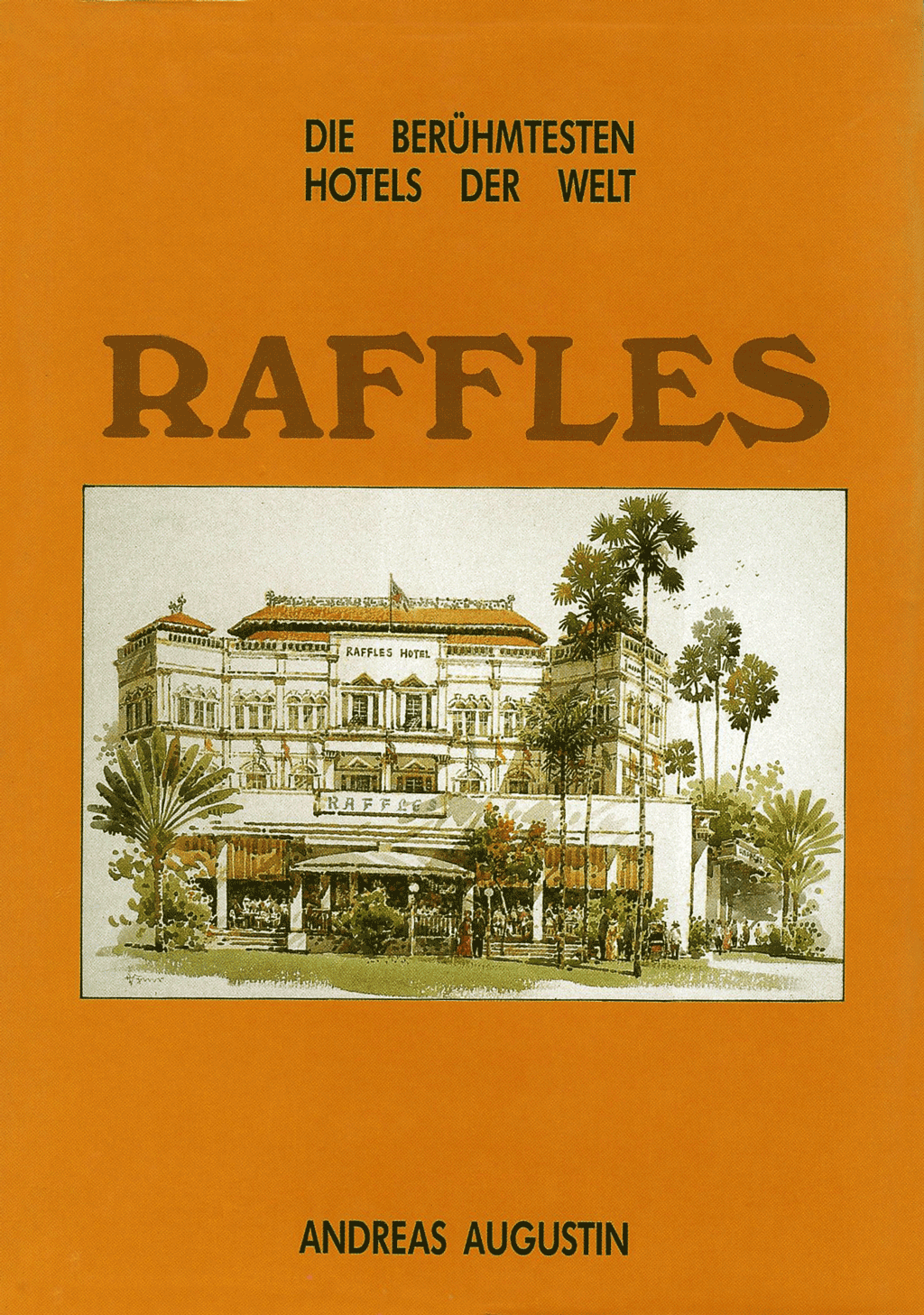
At this stage, I think I did a few things right. I quit my job as a correspondent. I asked my future wife, a historian, to join me in Singapore. And I focused on the history of historic hotels. From journalist to hotel historian. At the same time, we founded The Most Famous Hotels in the World. We brought all the historic hotels in the world under one umbrella. No one suspected that there would soon be over 400 of them.
I rented a room at Raffles and stayed. I had tasted blood. In the city's archives lay historical newspapers that wanted to be unearthed like a treasure. Documents, records that had not seen the light of day for over a century. In London, colonial archives were being dug into. Nota bene: Internet, email and mobile phones did not yet exist. SMS was a telegram, we sent documents by airmail.
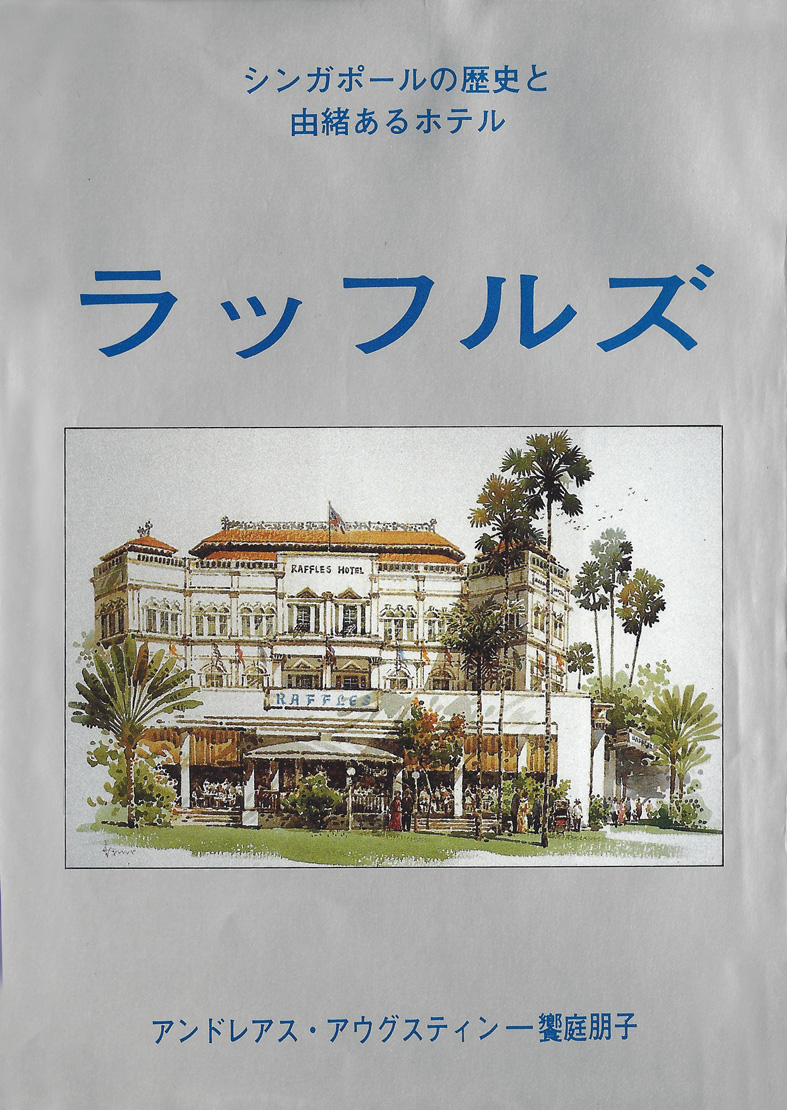
next step: the Japanese edition
The first way in the morning was to the reception. "We've got mail for you Mr. Augustin!" One day the first fax arrived. Wow, really? - Did someone really send it just seconds before on the other side of the world? The receptionist who handed me the envelope was called Leslie Danker. He is now, 38 years later, the resident historian of Raffles in Singapore.
When a researching journalist and an all-questioning historian (sometimes laborious - but always purposeful!) approach a hotel story, no stone is left unturned. That is, after all, the purpose and true motivation of The Most Famous Hotels in the World. To put an end to ridiculous legends. Let's have the truth. Because that's not bad either.
The legendary story "Tiger shot under the pool table!" was set straight, the Singapore Sling was put through its paces ("Honestly, Mr. Director - what kind of story did you tell us?"), but the exact building history of the hotel remained in the dark.
Then, one day, I achieved a feat. Coincidence, persistence, who knows? In an archive of the Singapore Building Authority, I discovered a dusty box. The contents: a set of microfilms. When I held them up to the light and looked at them with a magnifying glass, I couldn't believe my eyes. These were the lost, long thought to be lost, original building plans of Raffles Hotel.
Imagine the excitement. The hotel's manager almost snapped with joy. The Straits Times, Singapore's largest daily newspaper, devoted a major article to the find. A new book, the first in English, THE RAFFLES TREASURY, was immediately published with these blueprints.
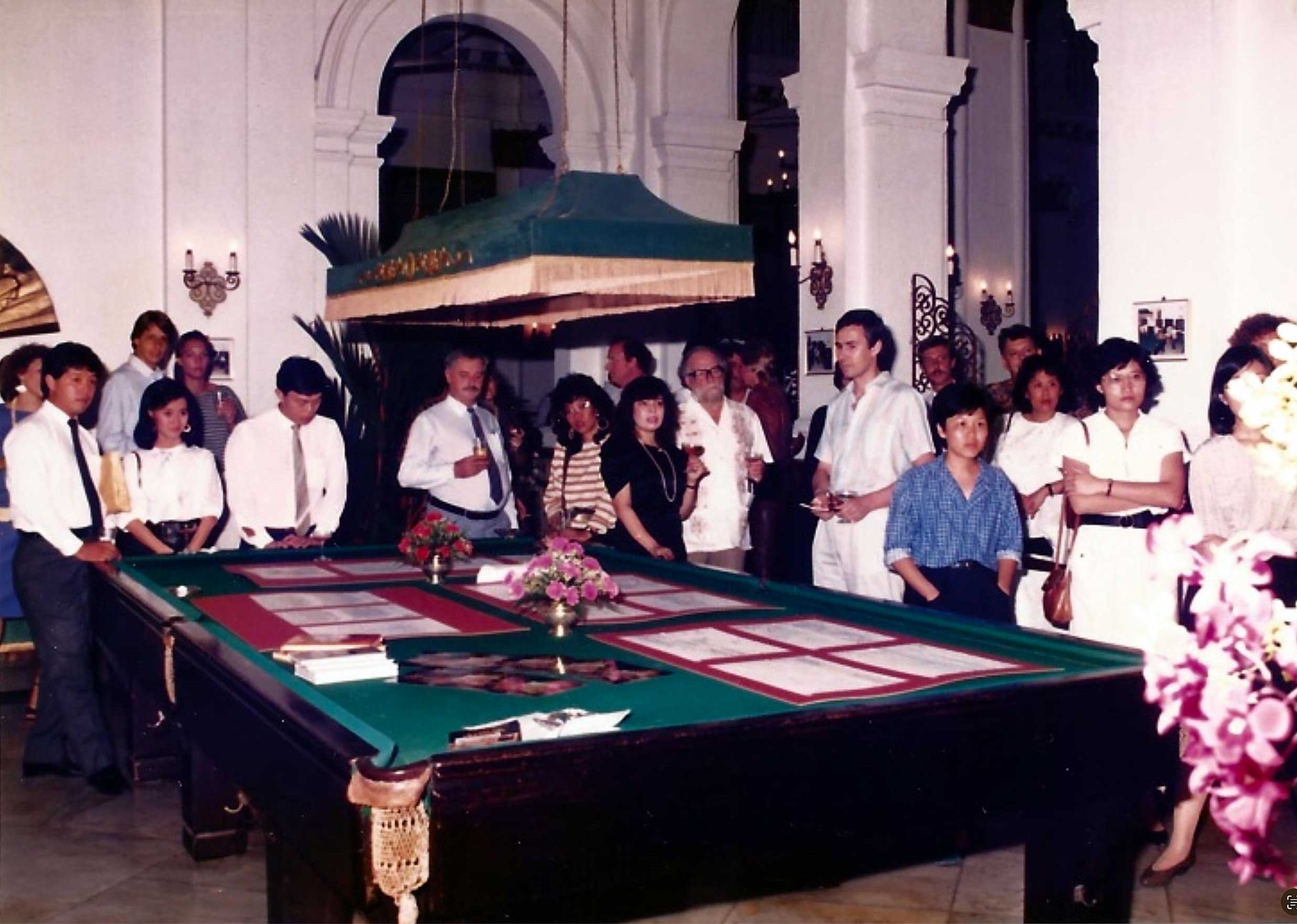 The book launch was a minor sensation. Half of Singapore crowded around the big billiard table where the hotel manager proudly presented the plans, affixed to red cardboard boxes. I had my first bestseller.
The book launch was a minor sensation. Half of Singapore crowded around the big billiard table where the hotel manager proudly presented the plans, affixed to red cardboard boxes. I had my first bestseller.
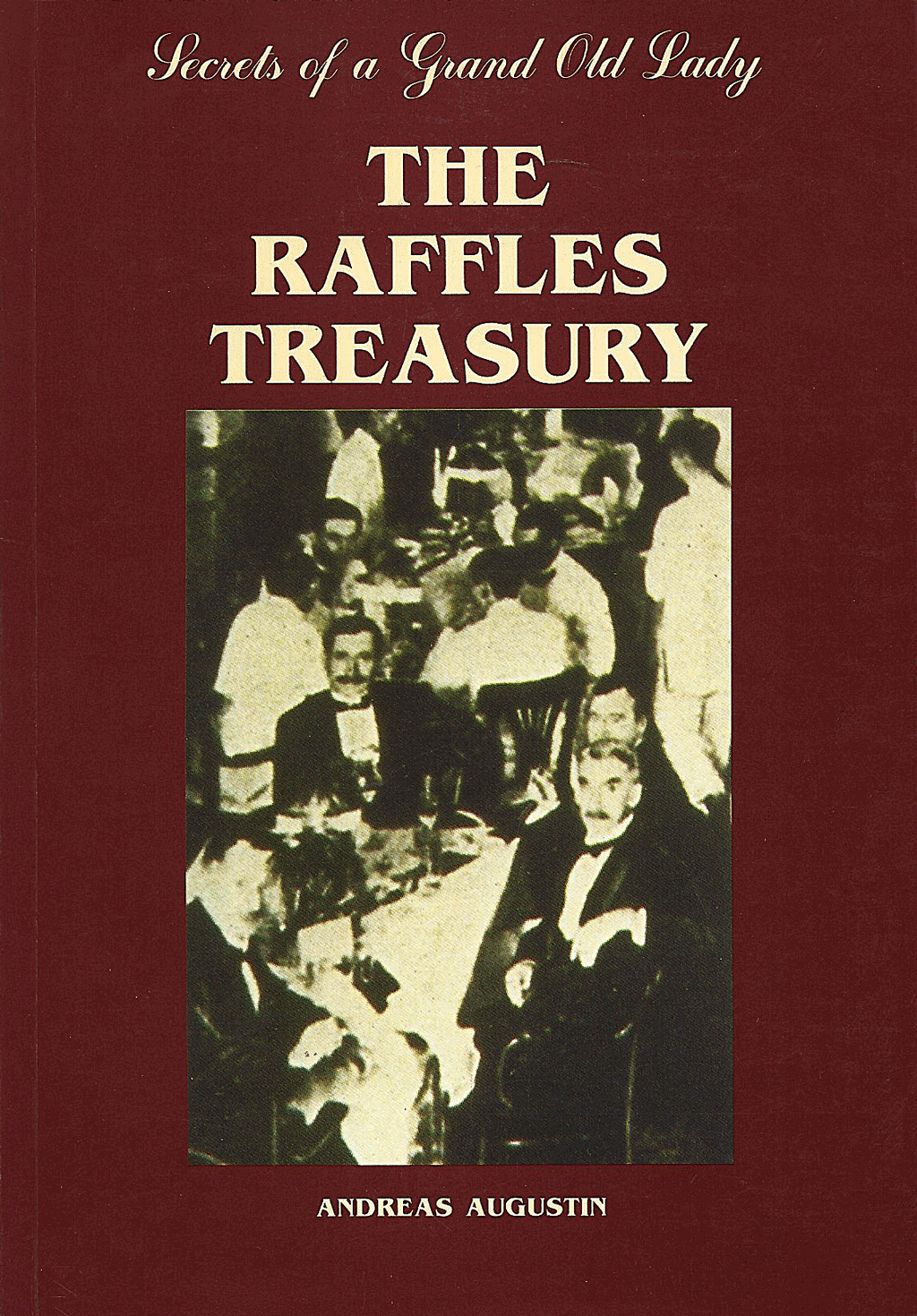
The most important thing, however, was that official Singapore also reacted. Now it was documented exactly how the hotel was built. It took only months and Raffles Hotel became a listed building. This is in line with our heritage protection.
Now there was no question whether the hotel would ever be demolished. If it was, then it could only be restored and renovated in detail. And that was what they were going to do. On 15 March 1989, at the stroke of midnight, the hotel closed its doors for over two years. Sentimentally, but definitely looking to the future with confidence, I left the next morning with my suitcase from my beloved little flat in the hotel, which in the meantime had expanded to include a study and a kitchen. My wife was pregnant and we were taking a "baby break".
Subsequently, the hotel was lovingly renovated in its historical substance and became a modern luxury hotel. The entire block around it was integrated, a shopping centre and completely new areas were added à la Raffles, true to style. Soon, Singapore could once again proudly trumpet the old slogan: There is only one Raffles.
But wait: "only one?" That's not quite true any more. Under the management of the American Richard Helfer, Raffles became a brand and hotel group. Today, several hotels bear the name of the founder of Singapore, Sir Thomas Stamford Bingley Raffels. Incidentally, he had never seen the hotel of his name. He died 60 years earlier. Since 2016, the Raffles Group has been part of the French, listed hotel group Accor.
________
The next time we discover a piece of Chesa Grischuna from Klosters in a British crown colony. Swiss Urs Aeby takes us to Hong Kong. The Peninsula welcomes us with open arms. We meet the "Boy" who 60 years earlier presented flowers at the opening. And two Armenian British lords of whom they say
"They arrived on camels and left by Rolls Royce".
The Charles Chaplin Journeys
( words)
Charles Chaplin was the most popular movie actor, producer, director and composer of the 20th century. He started his carreer in Hollywood and spent the last years of his life in Europe.
When he arrived at any given place on the planet, everybody recognised the little tramp, his most famous role. During the 1930s, he toured the world. Charles Chaplin had at that time already made some 80 movies. He always stayed at the most famous hotels. At the Imperial in Vienna, the Adlon in Berlin, at the Mena House in Cairo, at Raffles in Singapore, The Peninsula in Hong Kong, at Le Royal in Phnom Penh, at the Metropole in Hanoi, to name the. most obvious. For example his arrival on 17 March 1931 in Vienna, the recpetion at the Wiener Nordbahnhof (northern railway station) was overwhelming.
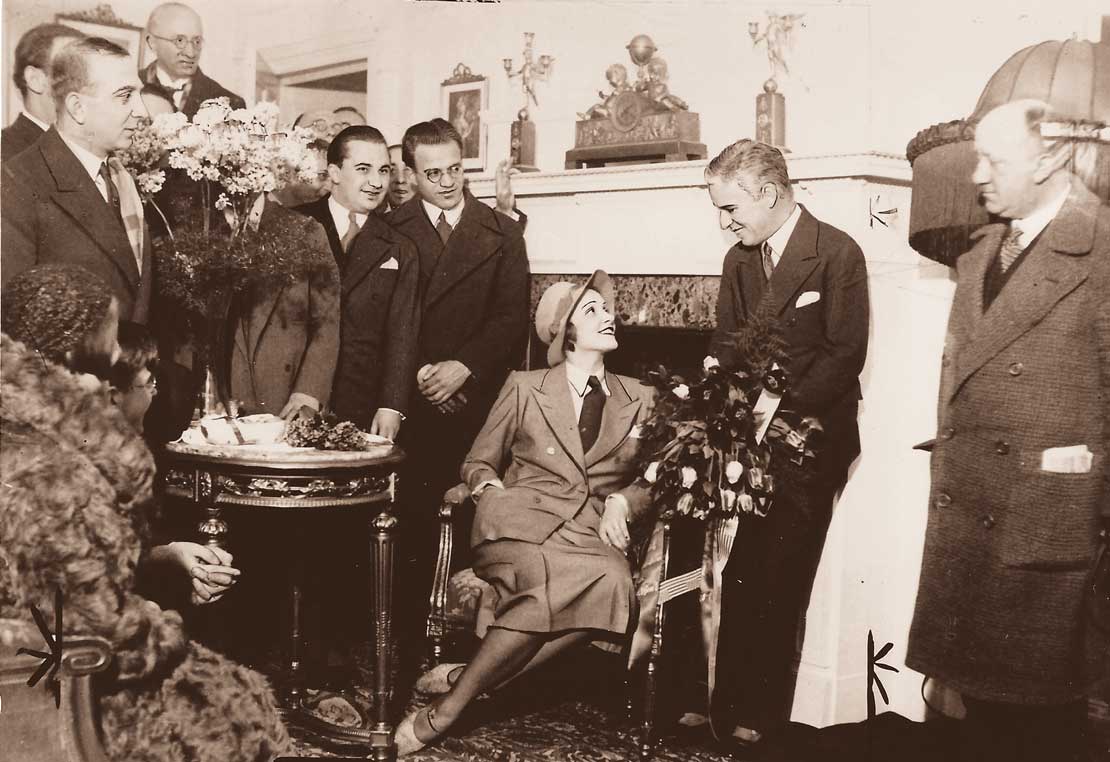
In 1931, this photograph was taken at the lobby of the Hotel Adlon in Berlin. The "tramp" Charlie Chalpin, the world wide know super star of the silver screen had come to Berlin to promote his latest movie "City Lights". He spent some days in Berlin. The lady in the chair was the German movie star Marlene Dietrich, who was just embarking on her Hollywood carreer. In 1929, Dietrich had landed the breakthrough role of Lola. Lola was a cabaret singer who causes the downfall of a hitherto respected schoolmaster in UFA's production, The Blue Angel (1930). The film was directed by Josef von Sternberg, who thereafter took credit for having "discovered" Dietrich. The film is also noteworthy for having introduced Dietrich's signature song "Falling in Love Again".*)
 *) On the strength of The Blue Angel's international success, and with encouragement and promotion from von Sternberg, who was already established in Hollywood, Dietrich then moved to the U.S. on contract to Paramount Pictures. The studio sought to market Dietrich as a German answer to MGM's Swedish sensation, Greta Garbo. Her first American film, Morocco, directed by von Sternberg, earned Dietrich her only Oscar nomination. However, at the time she knew very little English and so spoke her lines phonetically.
*) On the strength of The Blue Angel's international success, and with encouragement and promotion from von Sternberg, who was already established in Hollywood, Dietrich then moved to the U.S. on contract to Paramount Pictures. The studio sought to market Dietrich as a German answer to MGM's Swedish sensation, Greta Garbo. Her first American film, Morocco, directed by von Sternberg, earned Dietrich her only Oscar nomination. However, at the time she knew very little English and so spoke her lines phonetically.
Dietrich's most lasting contribution to film history was as the star of a series of six films directed by von Sternberg at Paramount between 1930 and 1935: Morocco, Dishonored, Shanghai Express, Blonde Venus, The Scarlet Empress, and The Devil is a Woman.
Hotel Bristol Vienna TV Documentary
( words)
The documentary about the history of the Hotel Bristol in Vienna has been broadcast several times over the past year. Now it is available on youtube.
https://www.youtube.com/watch?v=VWSJ9Y0xVLg
The Hotel Bristol in Vienna is at the crossroads of the most important thoroughfares of the Austrian capital as well as of events of today and history.
The TV documentary is narrated by Andreas Augustin (in German only), wonderfully supported by a group of Austrian celebrities as well as the hotel's staff, who joyfully talk about their jobs, their lives and their encounters with famous guests.
Women steal more often than men
( words)
It can be very entertaining . . .
Yes, I was startled when I stumbled over the secret Ritz files at The Savoy, London. And when, in 1987, I discovered the original building plans of Raffles in Singapore, saving the hotel from being destroyed, and of course it was a great feeling to pinpoint the exact opening date of the Hotel Metropole in Hanoi.
But, as you can guess, it is not all dead dry facts and serious history. The hotel world is full of good laughs. Here are a few of our amazing and often amusing findings, which lend our books about famous hotels a light-hearted flavour.
By Andreas Augustin
How to get a room at a Hilton
"I was sitting next to a businessman on a flight from New York to London arriving early in the morning. The guy wanted to stay at the London Hilton, but had no reservation. I said we can drive in together and see what the room situation is. As expected, there was no room available. The guy was not dissuaded. He said to the room clerk:
‘What if Conrad Hilton came in this morning without a reservation?’ The clerk became a little flustered and finally said: ‘Well, we would have to find something for him.’
‘So,’ says my seat companion: ‘I have news for you, young man. Mr. Hilton is not coming this morning and I want his room.’ He got it."
Curt Strand
Chairman of Hilton International, retired in 1986, told us this story in 2013
(from our book LONDON HILTON ON PARK LANE)
A Room with a Bar
Laws can in fact "encourage" hotel openings. When Theodore Roosevelt was police commissioner of New York, he enforced a highly unpopular measure called "Raines Law", designed to cut down on drinking by banning the sale of alcohol on the Day of the Lord - apparently the most popular day for drinking.
The one exception was for hotels which could serve alcohol with food or in rooms, and almost at once bars started opening at least ten rooms - the minimum number required - and turned into hotels. Of course, the bars weren't averse to the rooms being used, in any way, and very soon a huge boom in prostitution took place using them, totally subverting the moralistic intentions of the law.
In Chennai, Tamil Nadu, India, today, similarly stupid measures require bars to be attached to hotels, and some have created lodges for this purpose, though it isn't clear if this has facilitated prostitution.
"The Times of India"
Oscar Wilde, who gave us such delightful plays as The Importance of being Earnest and a good two pages in any reputable dictionary of quotations, stayed at The Savoy in London in March 1893. While everybody else was totally taken with the hotel’s modern techniques and features, Wilde scorned the idea of plumbed-in washstands with running cold and hot water: ‘What is it good for? If I want hot water, I call for it.’
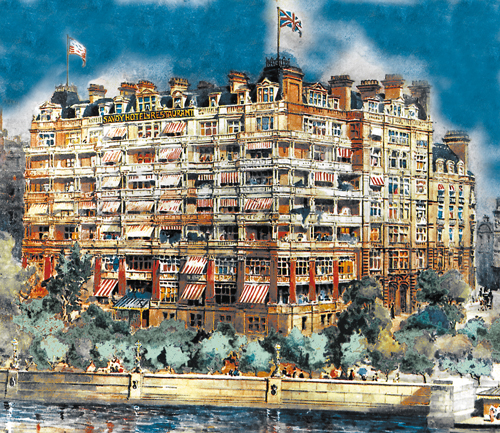 The Savoy
The SavoyTalking about the Savoy: "A Valet For Each Guest" titled the San Francisco Chronicle on 30 August 1891:
"There was quite an exciting discussion the other evening among a number of Californians at the Coleman, in which General John T. Cutting was a central figure. Some one (sic) of the Californians present had been reading in the Sunday CHRONICLE the views of General Cutting upon the superior service of the European hotels as compared with our American hostelries. Said the General, rather warming up to the situation: ‘I’ll tell you, gentlemen, that, although I only visited London and Paris, I maintain that for service there is no hotel in the United States to compare with that Hotel Savoy in London. There is no rush nor excitement when you arrive. You are courteously escorted by an attendant to your apartment, not by an officious bellboy who wants to wear his whisk-broom out on your clothes in the expectation of a tip. You open your trunk and lay out your crumpled clothes and go to your breakfast. Every wish seems to be almost anticipated, and you don’t feel like being obliged to lay down a fee for attendance. You return in the early evening to dress for dinner, and your dress suit is there freshly pressed and ironed for use. In the morning your day suit is similarly fit to wear. You couldn’t have your wants better attended to if you were at home. In fact, the hotel supplies special attendants for every want, and I never had to call for any special service—you don’t have to ring for ice water, it’s there. That’s the way to keep a hotel.’ And then there was silence, and more cigars were ordered."
Moral Standards Back in the 1980s strict rules applied at The Strand hotel in Yangon, Myanmar (formerly Rangoon, Burma). When, for instance, ‘Aunt Monica’ Mia Maung wanted to visit an old friend for tea, she unwittingly breached the moral protocol of the hotel. ‘As I went upstairs to see my friend, reception called him and remarked harshly: “No female visitors in your room, sir!” The most ridiculous thing was that my friend was in his eighties and confined to a wheelchair and I was in my seventies. In the end we left the door open.’
In 1942-43 the Atlantic Hotel in Hamburg had its own way of dealing with the threat of daily bombardments. The following sentence could be found on the menu: ‘The possibility of an air raid compels us to ask our honoured guests for immediate payment.’
The story reminds us of the research we carried out some years earlier in Singapore, where we discovered the 'Raffles Complex Bomb Warning System'. During the first months of Japanese air raids over Singapore, Raffles seemed unaffected by the growing peril. A special bomb warning system was devised to ensure the guests' "saftey". What the revellers did not realize was that this complex organization consisted only of the hotel´s chief engineer and one whistle. He blew this whistle four times if he spotted any droning Japanese planes about to release their deadly cargo. By then it would have been too late for the partygoers anyhow and so we could say that Raffles was lucky. No bomb touched the Grand Old Lady throughout the war. Probably because the Japanese wanted to save the hotel for themselves. After taking over Singapore they immediately converted the hotel into a home for senior officers.
Writer Simon Winchester told us a story for our history of the Mandarin Hotel in Hong Kong: ‘I was staying a while ago in room 1010 and having tea with a Chinese friend of mine, a young woman who had just had a baby boy and who had decided to call it, for some inexplicable reason, Egmont. ‘I assumed she had named it thus because Beethoven’s Egmont Overture but she professed no knowledge of either an overture named thus, or of the composer.
‘So I said, well, you must get it, play it for your child during its formative years. I’ll call down to the concierge and have him hop over to Universal Music in the Prince’s Building next door and have a tape delivered to my room, prontissimo. ‘Of course I knew that if head concierge Giovanni Valenti answered the phone it would happen. ‘But Giovanni did not answer the phone; one of his Chinese staff did. And good as they may be, I felt I had to be more careful. So the conversation went as follows.
‘SW: Hello, SW here, room 1010.
C: “Hello, Mr W, how are you today?”
SW: Fine, fine, thank you . . . Tell me, have you heard of Beethoven?
‘C: “Mr Beethoven? Let me see – what room is he in?”
‘SW: No, no – he is NOT a guest. He is a composer. And he is dead.
‘C: “Oh, my God,' the reply came, shocked: 'We’d better call security.”’
Peter French was general manager of The Mandarin Oriental Hong Kong between 1982–1986. ‘A West African Head of State was staying with us, of course in the Mandarin Suite, with his entourage occupying the entire 24th floor. During his visit to Hong Kong he developed a partiality for the local gourmet frogs and purchased several crates which he kept alive in the bath until their fate was imminent. Unfortunately the smell of the frogs permeated the entire top floors of the hotel, so we had to explain to him our house rule: “no pets allowed”.
 At the Oriental in Bangkok a moviestar handed his shoes in for cleaning. When he got them back the laces were missing. He called housekeeping. ‘You are supposed to be the best hotel in the world and you return my polished shoes without laces.’ The girl at the other end of the wire was clever enough to answer: ‘We were expecting your call, sir. The laces have just been washed and we wonder if you would like to have them pressed round or flat.’
At the Oriental in Bangkok a moviestar handed his shoes in for cleaning. When he got them back the laces were missing. He called housekeeping. ‘You are supposed to be the best hotel in the world and you return my polished shoes without laces.’ The girl at the other end of the wire was clever enough to answer: ‘We were expecting your call, sir. The laces have just been washed and we wonder if you would like to have them pressed round or flat.’
At the Hotel Sacher in Vienna, we found some 'Naked Facts'. Jack Lemmon once welcomed journalists at a press conference wearing only his night shirt. It would appear to be another Hotel Sacher peculiarity that some guests prefer to receive the press in their night attire. Or even without it. Like John Lennon and Yoko Ono, who caused an uproar when they invited the press to a sleep-in. They gave their interview at the Sacher – totally naked – from under the sheets, much to the frustration of hundreds of photographers who had come especially to take pictures.
When Hong Kong's Peninsula opened in 1928, rigorous morals ruled the colony (officially). The London Daily Express reported: ‘Chinese subscribers who flirt over the wires with the telephone girl more than three times will have their numbers cancelled.’
Here's a guest comment entry we all understand: 'I have noticed that the comment "24 hour room service" on your in-room menu seems to refer to the length of time that it takes for the club sandwich to arrive.' We won’t disclose the hotel in question.
Mauro Lotti was one of the great barmen at the Grand Hotel in Rome. He invented drinks and made them fashionable. During the research of our book Grand Hotel Rome, he confined to the author: "I had to invent drinks that told a story, such as the "Oyster Martini". I put a "naked" oyster on a skewer and lay it on a bed of crushed ice in a martini glass. You had to explain this in every detail and you saw the ladies shivering. As the poor oyster was "freezing", I poured the Martini over it. Then you ate the oyster and sipped the Martini – a wonderful taste of the oyster, and of course the drink.' His greatest coup was certainly the 'Feng Shui Stone Martini'. 'You soak (!?!) flat black lava stones with a smooth surface picked from a special spot on the coast of Japan in vermouth and then put them into the gin to mix the martini, thus ensuring a minimum of the taste of vermouth. The stones give you positive energy,’ Mauro explained, smiling.
After Austrian Airlines started flying from Vienna to Shanghai, the concierge at the Hotel Bristol in Vienna assisted an American traveller who flew to China. Asked if he had a visa, the man answered: 'I don't, I've been to China many times and never had to have one of those.' The concierge double checked and came back to his guest with the fact that his stay required a visa. Again, the traveller replied: 'Look, I've been to China four times and every time they have accepted my American Express.'
Did you take anything from your room? In the past, the items usually taken away from hotel rooms were soaps, shower caps, shampoos, stationary and the occasional cloth hanger. Today, towels (the most commonly stolen item), laundry bags, pillows, ashtrays, as well as reclining chairs, safe deposit boxes, television and video players are packed into the suitcase. Modern flat TV screens often turn out to be linked to a special system only available within the hotel. So forget it — they don't work at home!
A study made by the British Hotel Association found that women steal more often than men. The American Hotel and Lodging Association estimates that theft in hotels amounts to US$100 million a year. Holiday Inn reports a loss of 560,000 towels a year. One out of five Americans has taken a hotel towel, while just as many confess to have taken a cloth hanger or an ashtray. The occasional TV goes missing from a room. Today, hoteliers look at the transportability of modern flat screens with understandable horror.But a proper hotel TV works only within its CC system, turned on at home the scree would simply go blank.
What else to sell Besides rooms and F&B, hotels successfully sell mini-bar items, books about their history and the occasional bathrobe. The Savoy in London sells its 12-inch diameter shower heads, while via its online shop the Peabody in Memphis sells mattresses, down pillows and duck shaped golf club covers, bath gel, lotions and shampoos.
Guest comment entry: 'The manager had promised that I wouldn't find a single flee in my bed. He was right: they were all married with families'. Again, we won’t disclose the hotel.
You can have the cake and sell it - at least you can at the Hotel Sacher. The Viennese hotel has proved that it comes top in this practice. The Original Sacher Torte (cake) is the official Hospitality Industry Bestseller. The Hotel Sacher in Vienna, Austria, has a splendid online shop, boasting its famous ‘Torte’ (a chocolate cake) as the greatest seller in the hotel industry. On a typical day 300-600 cakes are produced, and during the festive season the number reaches 3,000! The cakes are shipped all over the globe in little wooden boxes.
The Peninsula, Hong Kong, around 1970: It was already after midnight when a pair of regular customers entered Gaddi's, 'The Pen's' finest restaurant (with a stiff dress code) for a night-cap. Headwaiter Chan Pak spotted them and, to his dismay, had to inform them that they were inappropriately dressed since neither of them was wearing a jacket. 'Sorry, gentlemen,' he said, 'but you cannot enter this restaurant with just a shirt and tie.' He had hardly finished speaking when the two men immediately agreed. Within seconds they took off their ties and shirts and stood half naked, whilst being applauded by the entire restaurant. Then they laughed, got dressed and beat a hasty retreat.
Guest comment entry: 'I had been promised a room with a bath. Pity that they were in separate buildings' – at a hotel we won’t disclose. Same applies for the manager who honestly answered the question of 'Does the room have its own bath?' to the point: 'If no one else comes, it does.'
Charles Chaplin arrived at The Peninsula with only his wife in toe , very much to the surprise of former Manager Felix Max Bieger, who expected a larger entourage. The reservation had been made for a 'two-bedroom suite'. When asked about this, the great comedian performed one of his famous pirouettes, stopped in front of Bieger and whispered: 'I snore and my wife hates it!'
On another occasion Felix Bieger accompanied US movie star Danny Kaye in the lift to his floor. A lady looked at the actor very strangely: 'You look like Danny Kaye!' she remarked. 'Oh,' Kaye replied, 'many people tell me that!'
In 1902, at the Raffles in Singapore a poor tiger, shot next to the billiards table, created a legend and with it a successful sales formula that has worked just fine for the hotel for the past 100 years (including ensuing Tiger Tavern, Tiger Draft Beer, etc.). But that’s in my eyes nothing compared to the live performance you see at the Peabody Hotel in Memphis, Tennessee every day. First of all the hotel is advertised as ‘Memphis only 5-ducks meeting hotel’. Every day, the famous duck march was played. The music was ‘choreographed’ by the original duck master, Edward D. Pembroke, a retired animal trainer who created the March of The Peabody Ducks. Pembroke trained the ducks to march on the red carpet to the music of John Philip Sousa's King Cotton March. Every afternoon the VIPs (very important poultry) take the elevator from their quarters on the roof of the hotel to the lobby, walk over a red carpet, and take a dip in the lobby fountain before heading back to where they came from. Whether the elder members of the ensemble retire to the hotel's kitchen at the end of their career has not been confirmed.
VIP - very important poultry. At the Hotel Majapahit in Surabaya, Indonesia, former General Manager Bradford Zack was inspired by the Hotel Peabody in Memphis and had his own ducks trained for their daily performance.
Duck Tales
At the Hotel Kamp in Helsinki, Ducks were part of the bathroom set-up.
And a letter to us: 'When traveling in Asia last year, I grew a little blasé with the opulence. One of my favorite moments was checking into my room at the Sofitel Royal Lagoon Dongguan, with a magnificent and huge marble bathroom, and finding a little yellow rubber ducky on the bathtub rim. That tiny gesture sent a better message to me than the multiple amenities that there was someone in the establishment who really cared to make my stay special. I knew instantly that the hotel had a Germanic GM because of the great sense of humor, and, indeed, it turned out to be Peter Erler who, if I recall correctly, is Austrian.' (Constance Genet Konold)
"There are two classes of travel: first class and with children" Robert Benchley
The Spanish surrealist Salvador Dali, (1904-1989), a man noted for his personal flamboyance, graced the lobbies of hotels like the St Regis in New York or the Meurice in Paris. Several hundred contracts would be proposed to the artist in any one particular year and of these about 50 would come to fruition. They included, in 1970, a 15-second commercial on French television during which Dali rolled his eyes roguishly and said, 'I am mad, I am completely mad - over Lanvin chocolates.' He was paid $10,000." Dali enjoyed various long-term stays in Paris, at the famous Hotel Meurice, on the rue Rivoli. On one occasion, he reserved an entire floor, where he enjoyed cruising the corridors on his bicycle. In search of inspiration, Dali would demand a herd of goats be delivered to the hotel. He would then shoot them with plastic bullets. He would also pay staff to go the Tuileries Gardens next door and collect flies in a jam jar. In his later days he used to earn some extra cash by answering personal requests for an autograph in the lobby of the Meurice with the simple reply: 'That's ten dollars.' He would pocket the money and sign an autograph for the collector.
'It's easier to find a travel companion than to get rid of one.'
At the Savoy in London, Rudi Schreiner, reception manager in the 1970s and later general manager in Vienna, remembers a particularly attractive singer who was on stage during the days of supper cabaret at the Thames Foyer. When she began a particular number from Cabaret, all the guests would stare at the stage. When she came to the bit which requires a fair degree of upper torso movement while singing ‘Money money money . . . money money money . . .’ followed by a sound on the cymbal denoting an imaginary silver coin falling into her juggling cleavage, everyone was spellbound… Absolutely everybody, including the young waiter who was serving a large table of fourteen right next to the stage. Unfortunately, although he hadn’t put out any plates, he calmly started to serve the main course straight onto the tablecloth. Apparently no one noticed until the gravy was poured.
'But why oh why do the wrong people travel when the right people stay at home?' Noel Coward
At the Excelsior in Rome, Italy, the wife of a Sultan had her secretary presenting a list of extras she wanted: 'she needs three Mercedes, wants everything decorated with red roses, brings her own dancing instructor, asks for a Judy & Punch theatre with a simultaneous translation in her suite for her children, requests a disco in one of her rooms and subsequently requests a troop of 12 Flamenco dancers as well as an English speaking magician.'
A rather unusual room request for three days, fulfilled to the full satisfaction of the guests, had been personally presented by an ambassador of a foreign country. The visiting head of state required La Coupola Suite, in addition the Imperial Suite, 25 more suites and 50 rooms. In La Coupola additional ten monitors should be installed receiving 26 preasigned satellite programmes, their design matching the existing wood panel and to decorate everything in style a 500 kg bronce sculpture had to be lifted into the living room (by crane).
This request reached a Mountain Resort, St Moritz, Switzerland: 'I would very much like to bring my dog with me. He is well-groomed and very well behaved. Would you be willing to permit me to keep him in my room with me at night?' An immediate reply came from the hotel owner, who said, 'I've been operating this hotel for many years. In all that time, I've never had a dog steal towels, bedclothes, silverware or pictures off the walls. I've never had to evict a dog in the middle of the night for being drunk and disorderly. And I've never had a dog run out on a hotel bill. Yes, indeed, your dog is welcome at my hotel. And, if your dog will vouch for you, you're welcome to stay here, too.'
The slogan of our industry: Who said it? 'Le client n'a jamais tort.' (The customer is never wrong) It was Cesar Ritz (1850–1918)
Please be aware of all guests staying at Redding Travelodge. Doing so is greatly appreciated.
All inside furniture must stay inside rooms at all times.
No running, jumping, or horseplay on stairs or walkways.
NO Alcoholic beverages can be consumed outside of rooms. Includes walkways, stairs, parking lot, and pool and spa area.
(Redding Municipal Code 10.25.010 and RTL policy)
For your protection, we have a *closed door policy. This means doors must be closed at all times except for entering and exiting.
(*security concern, insurance regulations, energy savings & aesthetic appeal to all guest.)
The pool and spa room close at 10:00 PM. This begins our QUIET TIME. To respect those in your group and other guests desiring to rest, relax, and rejuvenate. By 11:00pm walkways, parking lot, and breezeways should be clear and quiet.
# FREE sit down Hot Breakfast 6:00am - 11:00am OR "Breakfast-to-Go" pre-packaged to go breakfast available at check-in.
Pictures and Moods we like
( words)
Staged reenactments, snapshot, details, patterns, ornaments and all this over and over again
With the largest archives of historic images in hospitality industry we illustrate our books with legendary images. But contemporary photography is equally important as it presents the hotel in an other period - in our days and times.
Our associated experts in hospitality photography support our publications with their exquisite work.
We are fond of staged reenactments, the occasional snapshot, details, patterns and ornaments.
The top row on this page gives you a gallery of images we like.
The Rise of the Swiss Grand Hotel (1)
( words)
By Adrian Mourby
HOTEL DES BERGUES, GENEVA
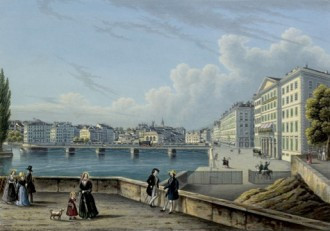
Geneva’s Hotel des Bergues (A Select Member of The Most Famous Hotels in the World) is a restrained and elegant building and full of idiosyncrasies. It is the oldest purpose-built hotel in Switzerland and it is one of the few hotels in the Four Seasons portfolio to have retained its original name.
But the name “des Bergues” has the kind of pedigree that no one would willingly give up. Its originates with a German merchant and financier called Johannes Kleberger (1486-1546). Though frequently on his travels, Herr Kleberger owned several properties in Geneva, including one on this section of quayside where Lake Geneva funnels into the Rhone river as it passes the old hilltop city. A friend of Erasmus, Hans Kleberger, had his portrait painted by Albrecht Dürer. You can see it today at Vienna’s Kunsthistorisches Museum.
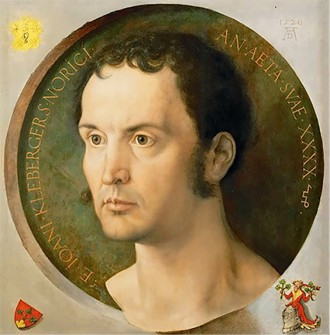
Kleberger (portrait) was renowned for his generosity which may be why in 1565, twenty years after is death, his son had to sell the ground where the hotel stands today to cover family debts. The site was bought by the City of Geneva and its buildings demolished, but already locals has begun calling this section of quay on the north bank of the Rhone “En Clébergue”, a name which was eventually shortened to “Bergues”.
By the beginning of the nineteenth century “Bergues” was a manufacturing suburb of Geneva, specialising in watch-making and textile-printing. It was also an industrial slum of such meanness that in 1816 Lord Byron, Percy Bysshe Shelley, and Mary Wolstencroft Shelley chose to live outside Geneva at Villa Diodati rather than anywhere near the foul-smelling quayside. Here they told each other ghost stories while much of Switzerland rioted because of the shortage of food following Europe’s worst summer on record. That year Mary's novel Frankenstein was born.
A few years later, in 1823 the first tourist steamboat arrived on the lake and changed Geneva’s attitude to its quayside. Business men and burghers alike recognised that the Rhone waterfront needed to become more welcoming to visitors.
In 1829, the Société des Bergues was formed by businessmen who wanted to build a hotel which would be “simple, of pure style and free of superfluous ornamentation”. Inevitably the chosen style was neo-classical.
Geneva (recently admitted to the Swiss Confederation) was keen to promote associations with the republics of Ancient Greece and therefore very partial to columns and pediments supported by pilasters.
The new hotel would be linked to the south bank of the Rhone – and thereby to the mediaeval city – by a bridge. This was designed by Colonel Guillaume-Henri Dufour, an engineer who would go on to lead the Swiss Federal Army to victory in 1847 against the troops of the Catholic cantons. His Pont des Bergues crossed the Rhone in two stages a few metres downriver from the entrance to the hotel. The bridge also linked to an artillery platform in the middle of the river (now known as Isle Rousseau) and is still the most direct way of crossing between the Hotel des Bergues and the city of Geneva.
Opened on 1 May 1834, the largest hotel in Switzerland had a piano nobile, three floors of bedrooms and an attic to accommodate staff.
According to Pedro Deakin, former Manager of Hotel de Bergues who has been working here since Four Seasons took over in 2004, this new hotel served a double function in Geneva. It was not only there to provide an attractive welcome to tourists, but to also a residence for visiting VIPS. The fortified Calvinist city on the south side of the Rhone had no palaces where royalty or aristocracy could bed down, so Hotel des Bergues was always intended as a five-star coaching inn.
When I asked Pedro about the spiral staircase hidden behind reception, he explained to me that in 1834 the hotel’s ground floor was open-sided with five arches that faced on to the quay. Guests would get down from their carriage, pass through the arches and take the stone spiral staircase to the first floor, where they would be welcomed. Of course the staircase was not broad and open because if it had been the wind from Lake Geneva would have blown straight up into the hotel proper.
As I say you can learn a lot from a hotel staircase.
P.S.: Followers of my quest for the perfect hotel martini might also be interested to know that I also learned something important about martinis during my three day stay. The Director of Sales & Marketing, Fabrice Thomé, learning of my research offered me dinner preceded by one of the hotel’s renowned gin martinis. I accepted this very happily and when the waiter asked if I would like a second martini I’m afraid I accepted that too. So what I have now learned is that the old martini maxim still holds very true indeed. “One is not enough and two is too many”.
* (Italian, "noble floor" or "noble level", also sometimes referred to by the corresponding French term, bel étage).
Bond of Brothers — the First Asian Hotel Chain
( words)
Martin Sarkies (seated) is surrounded by the young generation of successful hotelkeepers. Joe Constantine (left), his brother Arshak and Martyrose Arathoon, a Sarkies partner..
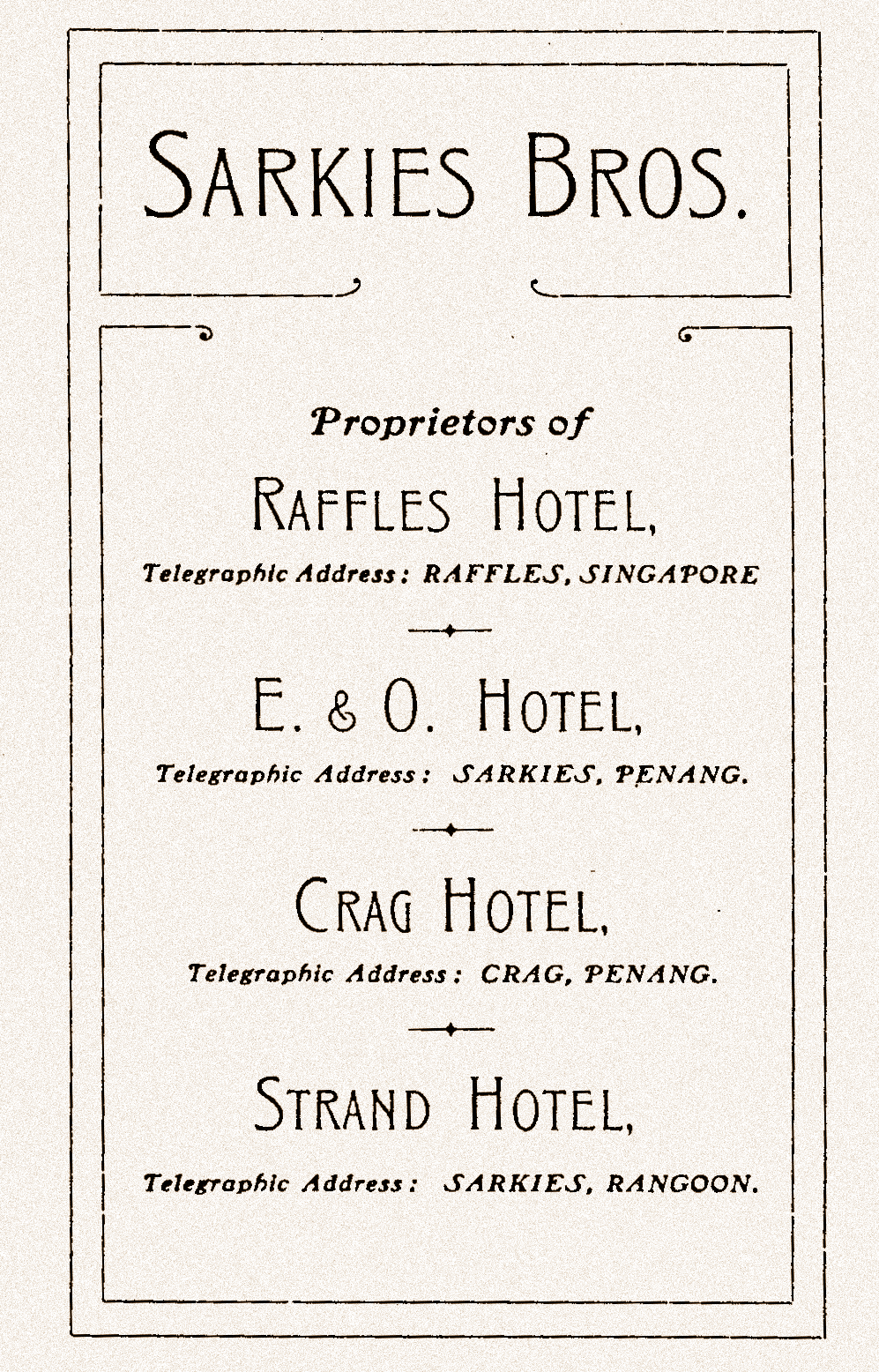
The Sarkies brothers - Martin, Tigran, Aviet and Arshak who came from Isfahan in Persia, became the foremost hoteliers of the East, their enterprises in Penang and Singapore dominating the hospitality trade in the Straits Settlements for nearly fifty years. With Raffles Hotel in Singapore, they had a remarkable flagship. Today, Raffles Hotel has been transformed into a global chain of luxurious caravanserais.
In the 1880s the Sarkies developed a new mixture of Asian-European hospitality hitherto unknown in Southeast Asia. Their background as traders and merchants, coupled with their lack of experience in international hospitality, helped them to develop a new view of the actual needs of potential guests, unhampered by prevailing notions. With Persian connections, they brought caviar from the Caspian Sea to Penang, Singapore and Rangoon. For almost five decades, they built, opened and ran hotels which have become legends in their own right.
The Sarkies had learned that the seashore was the best location. Inland – they instinctively felt – was dead land. Long ago, their ancestors had been traders in Isfahan in the highlands of ancient Persia, far away from the sea. For centuries they had benefited from the prosperous trade between Europe and the new colonies of India, the Malayan peninsula and the archipelago of Indonesia, on the main trade and transport route. Around 1820, they experienced the decline of this ancient trading route, known to us as the Silk Road. At some point there was no longer any need for caravans and their goods to cross the deserts, to climb the mountains and to follow the routes that Marco Polo had described. By 1869, with the opening of the Suez Canal, there was no longer any need to go through Isfahan. One day, the godowns surrounding the marketplace of Isfahan were empty. Once, they had been filled with tea from the highlands of Ceylon, sugar from Java, and opium, silk and porcelain from China and India. But now, even the local merchants who wanted to export their Shiraz wine had to take it to Ormus, at the shores of the Persian Gulf.
On the waterway between the shores of Asia and Europe, they met the swift sailing ships of the various East India companies. ‘Modern times’, they realized, and it became irrevocably clear that the day had come when the flourishing trade they had once plied in Isfahan was about to dry up like a pond in the desert. At that point, the clever Armenians of the desert cities of Persia, permanently pressed between the political interests of the Osman and the Russian Empires, packed their bags. As trade follows the flag they moved to the new and prospering ports of India and Asia.
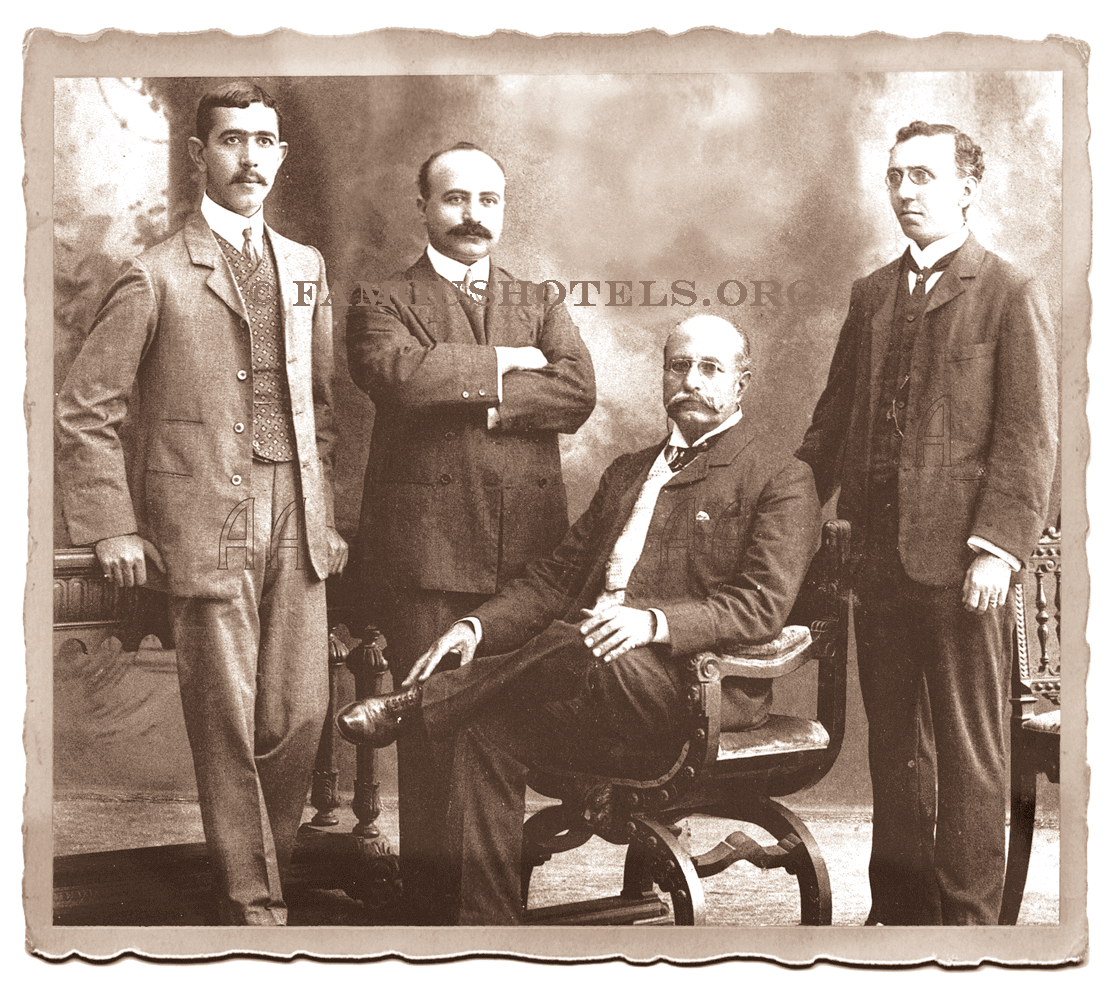
Martin Sarkies (seated) is surrounded by the young generation of successful hotelkeepers. Joe Constantine (left), his brother Arshak and Martyrose Arathoon, a Sarkies partner.
The Sarkies family belonged to the first wave of Armenian economical refugees, paving the way for many to follow in this historically significant Diaspora. There is a saying about the famous Kadoorie family in Hong Kong; "they arrived on camels and left in Royce Royce".
However, the Sarkies had arrived to stay.
A certain Johannes Sarkies became an eminent merchant in Calcutta in the early 19th century. When Stamford Raffles founded – and soon after developed – Singapore in the 1820s, other members of the Sarkies family boarded one of the first sailing ships bound for the new trading place at the tip of the Malayan peninsula. Soon, two thirds of all Armenian trading houses in Singapore were owned by Aristarchus and Aratoon Sarkies. Another Sarkies, C Johannes Shahnazar, moved to Batavia (known to us as Jakarta) and founded Sarkies, Edgar & Co. of Batavia, Sourabaya and Singapore (1855-85). Another Sarkies branch settled in Dacca, while in 1869 a certain Martin Sarkies, an engineer, put down roots in Penang. He and his brothers Arshak, Aviet and Tigran, who arrived years later, were to become ‘our’ Sarkies, the farsighted hotel entrepreneurs.
Penang was an important port of call. Together with the city state of Malacca and Singapore, it formed the Straits Settlements. The island (with its capital, Georgetown) was the first English settlement east of Calcutta, founded by Sir Francis Light in 1786. Light had cannons of silver coins fired into the jungles to motivate his Indian coolies to clear the wood to build a capital: Georgetown. Its city hall, the high court, a respectable collection of public buildings and private villas appeared very European (with the notable exception that the city was planned on the drawing board, following a simple grid system, in comparison to the old, organically grown medieval European cities).
The Chinese who arrived from Mainland China became ‘Straits Chinese’ and built rows of narrow family houses-cum- shops creating one of the famous ‘Chinatowns’ of Southeast Asia.
In 1869, when Martin Sarkies arrived in Penang, the Suez Canal was about to be opened. This was the most important event since Vasco da Gama first discovered the sea route from Europe to India in 1498. Suddenly, a city like Bombay in India was only 6,274 miles from London instead of 11,200 round the Cape. Soon, the journey from Europe to these Asian ports could be completed in half the time. With steam ships, the journey was even faster. Eighty percent of sea-going traffic was British. Taken together, these factors produced a matrix for more efficient Southeast Asia trade, and went on to become the grandmother of Asian tourism. Everybody in the region understood that, sooner or later, all ports East of Suez would be buzzing like beehives.
However, there was a distinct lack of good accommodation for travellers arriving after an exhausting voyage. After days and weeks in narrow, uncomfortable cabins (moving on the deck during the night to avoid the unbearable heat of the tropics), they often had to rent an equally uncomfortable and overpriced room, if indeed, there were any to be had.
Hoteliers felt that their duty was done if they offered a room away from the dirt and dust of the street, away from rats and straying dogs, beggars and thieves. But that was it. Asia had little to offer compared to the luxurious, dreamlike palaces created in Europe by the first apostles of hospitality such as Cesar Ritz. In Europe, monograms were embroidered onto bed linen, pillows and towels, and delicate porcelain figurines were placed on mantelpieces. Asian guesthouses rarely offered sheets at all, and a mosquito net was often the only luxury. In 1889, for example The Savoy in London already offered 70 bathrooms with tubs and running hot and cold water. At this time, Asian hoteliers were proud of their ‘showers’, which consisted of a wooden ladle which was used to pour water onto the bather from a large clay receptacle (a ‘Tong’). Doors were rarely lockable and servants would enter through back doors at their convenience. Requests were understood once in a blue moon and items wrongly delivered, organized and served for that funny traveller who requested ‘my own knees’ to put on his salad.
Penang - The Eastern and Oriental (E&O):

Penang was no exception in terms of accomodation, and therefore the perfect location for a high(er) quality hotel.It started in Penang: it was 23-year-old Tigran who took the first step into the hotel industry, seeing it as more profitable than his fledgling auctioneering business. Taking over the lease of a large compound house at 1a Light Street, he named it the Eastern Hotel, announcing on 15 April 1884 that the hotel was open to receive boarders. Tigran was joined by his older brother Martin, and calling themselves Sarkies Brothers, the pair acquired Hotel de l’Europe which was situated on the seafront in Farquar Street, and renamed it the Oriental Hotel. Tigran managed the Oriental while Martin was responsible for the Eastern. Younger brother Aviet was persuaded to join them and was soon made manager of the Eastern Hotel. By August 1889, the extended and entirely renovated Oriental Hotel was ready for the public. The brothers gave up the Eastern, but not wanting to lose the goodwill and familiarity of its name, decided to rename the Oriental, the Eastern and Oriental Hotel - which soon became shortened to the E. & O.
The E&O hotel was a success. Perhaps a bit too much of a success. The landlord realised how much the value of his properties had risen, and he increased the rent considerably. The Sarkies began to look around for more reasonable opportunities.
In 1887, the Sarkies went scouting for a good location to establish a hotel in Singapore. They found Beach House, a former boys’ boarding house, at ‘20 House Street’. The Chinese name of the street dated back to Singapore’s early years, when Sir Stamford Raffles had drawn up the layout for this new city. Now this street, facing the shoreline of Singapore, has been renamed Beach Road.
The Sarkies’ keen sense for location led them to come to an agreement with the owner, an Arab merchant, called Syed Mohamed Bin Ahmed Al Sagoff, and they rented the house. Here, on 1 December 1887, they opened Raffles Hotel, a small hostelry with ten bedrooms.
In the meantime, the landlord at Penang possessed enough good sense not to let the Sarkies leave. Their talent as hoteliers was too obvious. An acceptable agreement was made and suddenly the Sarkies were in possession of two hotels. One in Singapore and one in Penang. When Martin retired to Isfahan in late 1890, youngest brother Arshak joined the E. & O., having gained valuable work experience at Raffles under Tigran’s watchful eye. Soon each brother took responsibility for a different hotel. Tigran remained in charge of Raffles, while Aviet opened the Sarkies Hotel in Rangoon, leaving Arshak in control of the E. & O. Apart from short breaks in Singapore or abroad, Arshak ran the hotel until his death in 1931. Within a decade of opening the Eastern Hotel, the brothers’ reputation had been made.
Orang Sarkies
Speaking at a celebratory lunch at the E. & O. in 1893, Sir Frank Swettenham first told the joke which was to pass into history: ‘A little boy was asked by his teacher in Perak who the "Orang" Sakais were, and replied that they were people who kept hotels.’ (The "Sakais" are one of the indigenous races of Malaysia, and now the Oragn Sarkies were the race of hotelkeepers!)
It was time to expand, again. Now they turned to the North. To Rangoon, the prospering city on the Irrawaddy River. A city with so many opportunities. A city with no proper hotel. After 1886, when Upper Burma was annexed by the British desire for extended safe trading facilities and united with the lower part of the country, Burma was declared part of British India and Rangoon was its capital. After the visit, also in 1886, of the Viceroy, Marquis of Dufferein, the city was on its way to becoming one of the cornerstones of the British Empire. In 1892, Aviet (the youngest of the brothers) and Tigran Sarkies boarded a steamer bound for Rangoon. Tigran had been instrumental in setting up Raffles Hotel in Singapore. He had built the billiard room and he had introduced fine cuisine to Singapore. He had brought the first caviar to the colony.
The story of The Strand Hotel, Yanon:
Singapore - Raffles:
With experience gained from running their hotels in Penang, Tigran and Martin Sarkies investigated the possibility of opening a new hotel in Singapore. They found a large bungalow on the corner of Beach and Bras Basah Roads, fronting the seashore, yet quite close to the commercial centre of town. Previously the boarding house for boys at the nearby Raffles Institution, the bungalow needed only a few alterations and repairs before Tigran announced the opening of his new hotel which he called Raffles, in December 1887. His initial advertisement highlighted the factors that would make Raffles such a success: the promise of ‘great care and attention to the comfort of boarders and visitors’. Hotel extensions in 1889 soon proved insufficient, so the brothers opened a new two-storey Palm Court Wing in December 1894, offering thirty well-furnished suites, bringing the hotel’s total to seventy-five.
Sarkies Brothers were rewarded for their efforts as members of royal and aristocratic families and other dignitaries began to patronise Raffles. But the Straits Times remained scathing of Singapore’s hotels, declaring that Singapore lacked a well-designed, convenient hotel offering quality accommodation. Presumably Tigran heeded this criticism for he announced extensive, grandiose renovations in 1897. These plans finally won over the Straits Times which concluded that the ‘palatial building with excellent ventilation, and the vast airy dining room’ would make Raffles ‘one of the largest and handsomest hotels in the East’.
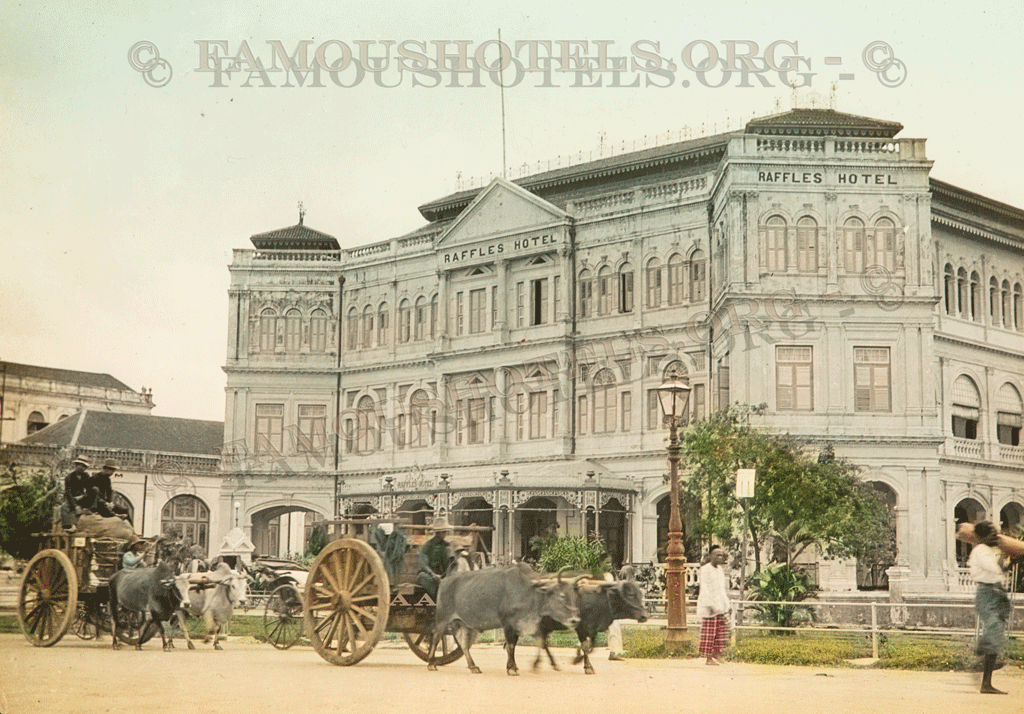 The new wing was opened on 18 November 1899. The old central block had been replaced by a magnificent Renaissance style three-storey block featuring a huge T-shaped dining room as the centrepiece. Boasting a Carrara marble floor, it seated 500 and occupied the whole of the ground floor, while its roof, crowned by a skylight gave the room an awesome air space. The two upper floors each contained fifteen suites, plus a large reading room and two drawing rooms. Two suites were set aside for Tigran and his family. A wide, richly decorated verandah surrounded the building, protecting the rooms from sunlight and rain while the new billiard room and bar were sensibly housed in a separate block. The hotel now offered 100 suites, all with furniture suited to the climate, as well as electric lighting - making Raffles the only hotel in the Straits lit by electricity. Not only did the hotel have its own steam engine to generate electricity, but a 10,000-gallon tank ensured a steady water supply. A special inauguration dinner for 200 guests was held in the dining room where electric light was used for the first time. The Straits Times representative who went along after the grand opening to see what things were like on an ordinary night, was most impressed, especially by the blazing lights as he approached the hotel from the sea front. Indeed, his only complaint was that the drawing rooms were unsuitable for flirting - due to a lack of screens, anyone who walked along the passageways could look in. Tigran should have sought the advice of a lady, he admonished. Tigran was quick to respond, assuring the writer that when the drawing rooms were finished, they would give every facility for flirtation. Ecstatic reviews of dinners dotted the press for the next three decades. Among early successes was the 1900 New Year’s Eve dinner. Lauded as the best banquet yet offered by a hotel in Singapore, it was claimed that half the town turned up for the dinner and the rest came in later to dance. However, travellers were once more complaining of the dearth of quality accommodation, strongly feeling that a first rate hotel under European management was urgently needed. Perhaps such comments en¬couraged Arathoon Sarkies and Eleazar Johannes to acquire the Adelphi Hotel in 1903, and the new owners of the Hotel de l’Europe to construct a modern hotel in 1904 (poaching Charlie Chaytor from Raffles to manage it). These entrepreneurial Armenians in charge of Singapore’s three leading hotels kept one another on their toes. An intense advertising war ensued as each tried to outdo the other vying for patronage for their special dinners, race dinners, coronation dinners and musical dinners. They wooed the diverse expatriate communities with lavish menus accompanied by musical delights to celebrate the birthdays of Kaiser Wilhelm, Queen Wilhelmina, King Edward and Queen Alexandra. In November 1910, having guided Raffles for twenty-three years, a sick Tigran sailed for England. Of some consolation would have been the Pinang Gazette’s glowing praise of his achievement - 'Raffles is more than a hostelry, it is an institution – the hotel has made Singapore famous to the tourist and an abode of pleasure to the resident.'
The new wing was opened on 18 November 1899. The old central block had been replaced by a magnificent Renaissance style three-storey block featuring a huge T-shaped dining room as the centrepiece. Boasting a Carrara marble floor, it seated 500 and occupied the whole of the ground floor, while its roof, crowned by a skylight gave the room an awesome air space. The two upper floors each contained fifteen suites, plus a large reading room and two drawing rooms. Two suites were set aside for Tigran and his family. A wide, richly decorated verandah surrounded the building, protecting the rooms from sunlight and rain while the new billiard room and bar were sensibly housed in a separate block. The hotel now offered 100 suites, all with furniture suited to the climate, as well as electric lighting - making Raffles the only hotel in the Straits lit by electricity. Not only did the hotel have its own steam engine to generate electricity, but a 10,000-gallon tank ensured a steady water supply. A special inauguration dinner for 200 guests was held in the dining room where electric light was used for the first time. The Straits Times representative who went along after the grand opening to see what things were like on an ordinary night, was most impressed, especially by the blazing lights as he approached the hotel from the sea front. Indeed, his only complaint was that the drawing rooms were unsuitable for flirting - due to a lack of screens, anyone who walked along the passageways could look in. Tigran should have sought the advice of a lady, he admonished. Tigran was quick to respond, assuring the writer that when the drawing rooms were finished, they would give every facility for flirtation. Ecstatic reviews of dinners dotted the press for the next three decades. Among early successes was the 1900 New Year’s Eve dinner. Lauded as the best banquet yet offered by a hotel in Singapore, it was claimed that half the town turned up for the dinner and the rest came in later to dance. However, travellers were once more complaining of the dearth of quality accommodation, strongly feeling that a first rate hotel under European management was urgently needed. Perhaps such comments en¬couraged Arathoon Sarkies and Eleazar Johannes to acquire the Adelphi Hotel in 1903, and the new owners of the Hotel de l’Europe to construct a modern hotel in 1904 (poaching Charlie Chaytor from Raffles to manage it). These entrepreneurial Armenians in charge of Singapore’s three leading hotels kept one another on their toes. An intense advertising war ensued as each tried to outdo the other vying for patronage for their special dinners, race dinners, coronation dinners and musical dinners. They wooed the diverse expatriate communities with lavish menus accompanied by musical delights to celebrate the birthdays of Kaiser Wilhelm, Queen Wilhelmina, King Edward and Queen Alexandra. In November 1910, having guided Raffles for twenty-three years, a sick Tigran sailed for England. Of some consolation would have been the Pinang Gazette’s glowing praise of his achievement - 'Raffles is more than a hostelry, it is an institution – the hotel has made Singapore famous to the tourist and an abode of pleasure to the resident.'
Arshak managed Sarkies Hotels until his end. Tigran and Martin had died in 1912, Aviet in 1923. On 9 January 1931 Arshak died at his beloved E&O Hotel. On 10 June 1931, the same year, Singapore businessman Tang Men Jim filed a bankruptcy case against Raffles Hotel for Straits Dollars 35,236.87 worth of food supplies. The case grew into the largest bankruptcy affair of the Straits Settlements. The firm of Sarkies Brothers, hotel proprietors, had total liabilities of 3.5 million owing to 195 creditors. Arshaks family had to leave their suite at the E&O hotel, a Raffles Hotel Ltd was put in charge, and the story of Messrs Sarkies Brothers, pioneers in their line of business, had come to an end. The story of the hotels involved, gladly, not. Raffles Singapore, the E&O in Penang and the Strand have all survived under different owners. The Crag on Penang Hill does not exist any longer.
Explanations:
The Sarkies
Martin Sarkies (1852-1912)
Tigran Sarkies (1861-1912)
Aviet Sarkies (1862-1923)
Arshak Sarkies (1868-1931)
: The Armenian genocide of the people living in Eastern Turkish provinces was the first genocide of the 20th century, perpetrated by the Ottoman Turkish government against its defenceless and law-abiding citizens, the Armenians, a Christian minority in a Muslim state. For more than a quarter of a century, the Armenians in the Ottoman Empire under the leadership of Sultan Abdul Hamid II and later under the rule of the Young Turk regime suffered unspeakable abuse, torture, massacres and persecution. This resulted in the rape, murder and deportation of more than 1.5 million Armenians from their historic homeland, and the destruction of a 3000-year-old heritage and rich culture.
: Martin Sarkies had five children. His son Lucas Martin, born in 1876 in Penang, later founded the famous hotel Oranje. He moved to Malang and later to Surabaya, where he opened a grocery store. When a large piece of land became available he bought it and in 1910, his little son Eugene Lucas Sarkies had the honour of laying the groundstone for the Oranje Hotel, named for the Dutch royal family. Today the hotel is called Hotel Majapahit of Surabaya in East Java.
: The Sarkies also run and operated the Crag Hotel on Penang Hill, the cool retreat from the heat of the plains. And the Seaview Hotel in Singapore.
Sources:
Ilsa Sharp: 'There is only one Raffles';
Nadia H Wright: 'Respected Citizens: the History of Armenians in Singapore and Malaysia'
Andreas Augustin: 'The Strand, Yangon', 'The Raffles Treasury', 'Raffles Singapore';
Andreas Augustin: set of original architecture drawings Raffles Hotel (1897-1899), unearthed in 1987.
REVIEW: Worth the Detour, A History of the Guidebook
( words)
A History of the Guidebook, by Nicholas T. Parsons
‘But why, oh why, do the wrong people travel, when the right people stay at home?’ asked Noël Coward, and Nicholas Parsons seems to have the answer: 'Because they have guide books!’
Here comes the history of that species! Where would we be without guidebooks? Or better: where wouldn't we have been?
Since its appearance in 2007, this book has become a faithful companion for research, reading and pleasure. All over the world travellers check out the sights of their chosen destination with their noses glued to a guidebook, and rely on them for every aspect of their visit - ordering meals, understanding the locals or avoiding wandering into the red-light district.
Few realise the guidebook has a long and distinguished history, going back to Biblical times and encompassing major cultural and social changes that have witnessed the transformation of travel. In 1480, an 'official' guidebook to the Holy Land warned 'For the sake of good relations with foreign hosts, a grave and courteous manner must be maintained ...'. This is very similar to the advice given in one of the most recent guidebooks to Iraq: 'Be especially courteous when dealing with officials ...if you upset them, they can be your worst enemies'.
In this delightful book Nicholas Parsons takes us on a fascinating journey through centuries of travel writing. He tackles his subject with enormous knowledge, assembled in the archives of the world, notably at the Getty Centre in Los Angeles, where you find a remarkable collection of early guidebooks. We learn about John Murray and Carl Baedeker; from the fathers of all travel guides to the aspects of modern guidebooks.
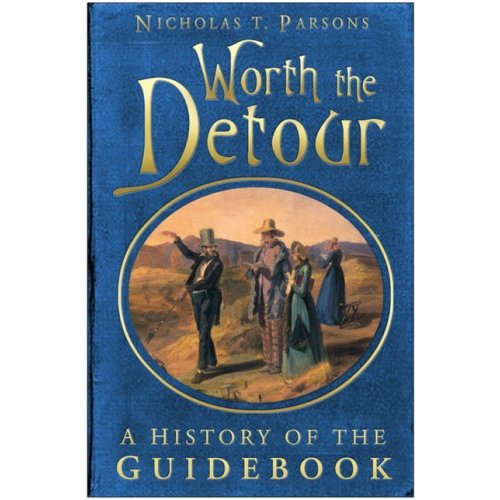
Hardcover: 320 pages, 16 pages of illustrations
Publisher: The History Press Ltd; 07 edition (24 May 2007)
Language English
ISBN-10: 0750943939
ISBN-13: 978-0750943932
Product Dimensions: 23.6 x 16 x 4.3 cm
The book is available at Amazon
Around the World in 80 Hotels (1)
( words)
In our journey we travel around the world to 80 hotels. The first part takes us from England to Scotland.
Andreas Augustin
PART 1: From England to Scotland
Strolling through Mayfair, Knightsbridge, and rambling into the West End, chances are that you pass by at least one of The Most Famous Hotels in the World. In London we list various hotels, among them The Dorchester, Claridges, Berkely, Connaught, Hyde Park, Ritz, the privately owned The Goring, the city’s oldest The Browns Hotel (1837), and more recently, the London Hilton on Park Lane, which turned 50 in 2013 (50 = one of the benchmarks for being considered by the jury of The Most Famous Hotels in the World).
London with its archives, public libraries and private collections provided all the rich material one needs to create inspiring books. In the late 1990s, we put up at The Savoy, researching the history of the city and digging into the archives of the hotel.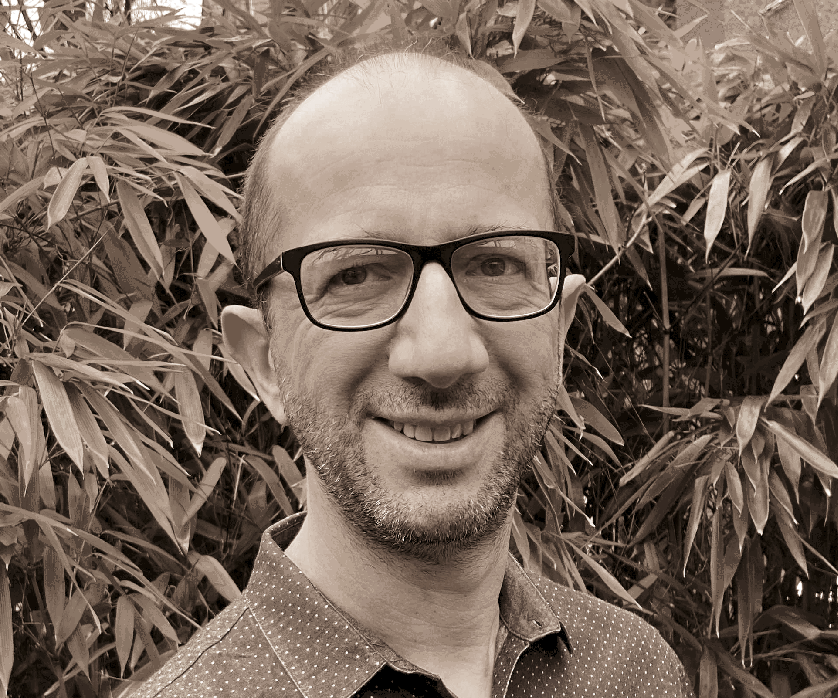 Together with my friend Andy Williamson (picture), the English historian – I wrote the book The Savoy London. Susan Scott, the hotel's archivist, opened the archives (at that time still at the hotel– gladly we scanned it all). We spent days and nights in it, before we — after weeks of research — returned the keys.
Together with my friend Andy Williamson (picture), the English historian – I wrote the book The Savoy London. Susan Scott, the hotel's archivist, opened the archives (at that time still at the hotel– gladly we scanned it all). We spent days and nights in it, before we — after weeks of research — returned the keys.
The hotel was opened in 1889 by theatre impresario Richard D'Oyly Carte, the man behind the Gilbert&Sullivan operettas. D'Oyly Carte, a man with extensive experience of staging operettas, knew that he needed a star for the leading part in this hotel. So he engaged a young hotelier on the rise, somebody who had shown his talents in various hotels on the continent. His name was César Ritz. He became the Savoy’s first general manager, who understood that a grand hotel is a perfect opportunity to stage this play called “Grand Hotel”.
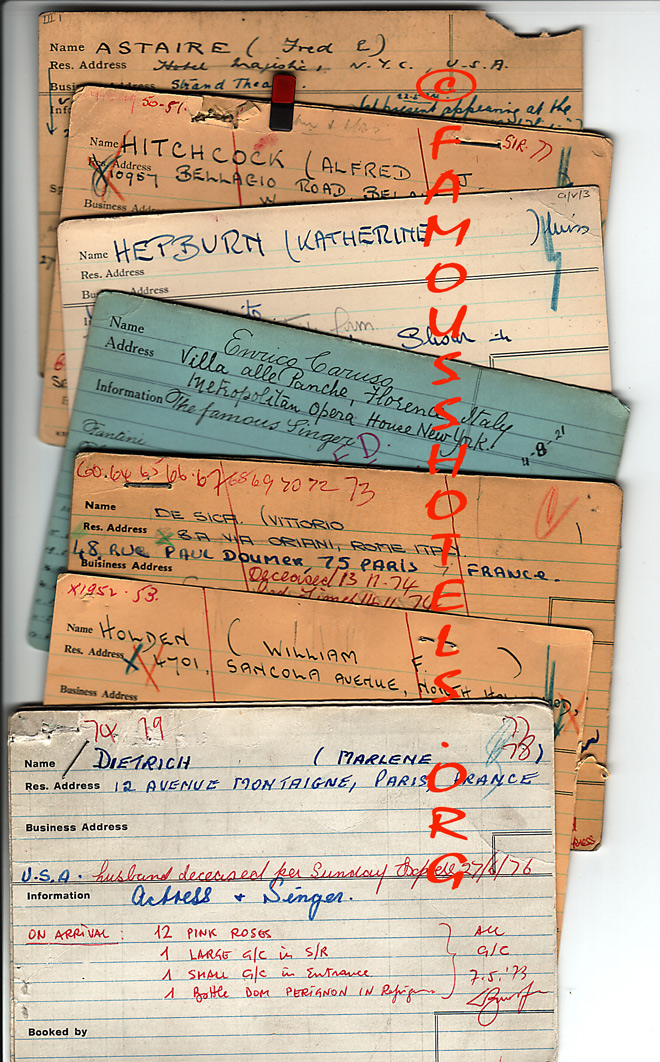
The Savoy London's archives reveal some of the guest history cards of its famous patrons. Actress Marlene Dietrich, for example, expected 12 pink roses and a bottle of Dom Perignon upon arrival.
The other thing he was aware of was that fine food is the second most important thing. At that time London wasn’t the cradle of fine food. Hundreds of Britons left the island every year starving for the cuisine of France and the rest of the continent (well, it wasn't only for the food. Let’s call it ‘cultural diversion’). Lead by the Prince of Wales, Albert Edward, who had little to do as his mother, Queen Victoria, had no intention to give up her post until she died after 63 years of reign, the landed gentry cum entourage spent more time on vacation in spas abroad than on their own island.
They preferrably went to locations that had the three characters B, A and D as part of their name. Tagline: "taking the waters". There was Wiesbaden, Bad Homburg, Baden Baden. Here the Prince of Wales had met again the (eager for success) young Swiss César Ritz.
‘Your Royal Highness remembers? I had the honour of lighting your cigar at the Troi Frères Provençaux at the World Exhibition in Vienna?” The prince nodded friendly. No, he had no recollections about this Swiss chap who spoke English remarkably well. But from now on he would remember him.
Ritz lured Auguste Escoffier to London; the chef who would establish modern restaurant kitchen as we know it today. Escoffier came, cooked and conquered Britain. But he refused to learn English: ‘If I learn to speak as they do, I will start cooking as they do,” he said.
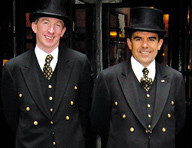 THE SAVOY — by Andreas Augustin and Andrew Williamson: I
THE SAVOY — by Andreas Augustin and Andrew Williamson: I
In the summer of 1889 – the days of Gilbert and Sullivan, the heroes of English operetta – The Savoy opened its doors. It was the creation of theatre impresario Richard D’Oyly Carte. He engaged the young César Ritz to run the hotel who in turn brought in Auguste Escoffier – the ‘Emperor of all chefs’. The Prince of Wales said 'Where Ritz goes, I go.' In 1898, Ritz and Escoffier had to go. After a century of confusion behind the fall from grace of this celebrated hotelier and his faithful chef this book discloses the sober facts.
Enrico Caruso sang at The Savoy, ‘The Pavlova' danced there (see large picture at top of this page) Sarah Bernhardt, Oscar Wilde and Dame Nellie Melba of Pêche Melba fame (created at The Savoy) – made it their London residence. Hollywood arrived. The 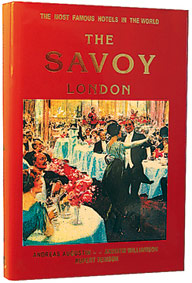 American Bar became the watering hole of prohibition refugees. Every Prime Minister chose The Savoy as a refuge of privacy (Sir Winston Churchill founded ‘The Other Club’ at The Savoy, which still meets here). This book talks about the people who created this legend. The personalities who make The Savoy one of the most successful and famous hotels in the world. The stars of yesteryear parade through these pages and meet the names of today. From Chaplin to Pavarotti, Joplin Sinclair to Oskar Kokoschka, from James Bond to Harry Potter – this is the place to be seen, to party, or to hide. The choice is yours.
American Bar became the watering hole of prohibition refugees. Every Prime Minister chose The Savoy as a refuge of privacy (Sir Winston Churchill founded ‘The Other Club’ at The Savoy, which still meets here). This book talks about the people who created this legend. The personalities who make The Savoy one of the most successful and famous hotels in the world. The stars of yesteryear parade through these pages and meet the names of today. From Chaplin to Pavarotti, Joplin Sinclair to Oskar Kokoschka, from James Bond to Harry Potter – this is the place to be seen, to party, or to hide. The choice is yours.
Wherever you go, try to stay at the most famous hotel, even if you can only afford the smallest room!'
Aristotle Onassis, a Greek who rose to become one of the world's most wealthiest men
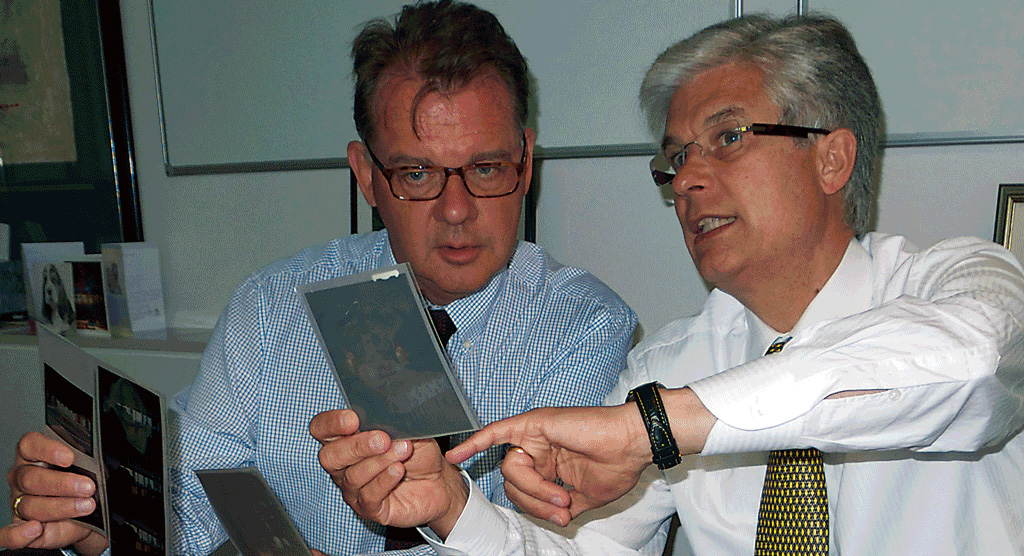 Overlooking Hyde Park, London Hilton on Park Lane "stands tall but never still" (courtesy general manager Michael Shepherd in the photo to the right; selecting pictures with the author of LONDON HILTON ON PARK LANE). In 1963, when it opened its doors, the London Hilton was a novelty, a sensation, a scandal perhaps, but certainly a temptation.
Overlooking Hyde Park, London Hilton on Park Lane "stands tall but never still" (courtesy general manager Michael Shepherd in the photo to the right; selecting pictures with the author of LONDON HILTON ON PARK LANE). In 1963, when it opened its doors, the London Hilton was a novelty, a sensation, a scandal perhaps, but certainly a temptation.
The hotel revolutionised British hospitality. A suite on its upper floors became the most sought-after accommodation in the city on the River Thames. Today snapshots from its rooftop restaurant are shared on social networks round the clock, and no visit to London is complete without having been to Trader Vic’s. Moreover, for generations of young hoteliers the world over, London Hilton on Park Lane served as a training ground.
1963: the opening year of the London Hilton in a colourful cloude. Open and enlarge it in a new window with a mouse-right-click.
This book takes you from the first idea for the hotel to the first visit of Her Majesty, The late Queen (who was NOT amused to see that giant tower rising from her windows of Buckingham Palace). It spans from the Hilton’s early days as the centre of 1960s Swinging London to its recent role as the headquarters of the Olympic Games. Three hundred photographs illustrate the progress of the hotel on Park Lane, from a luxurious skyscraper, filled with modern novelties, to one of the most famous hotels in the world.
Before we board our train north, we arrive at Paddington station. There stands the GREAT WESTERN ROYAL HOTEL, today the Hilton London Paddington. It's history started in 1854, it was the wrold's first palatial terminus hotel. We owe the fact that it still stands Gulshan Bhatia and her son Asif, who were Indian political refugees from Tanzania, East Africa. They arrived in the UK on 24 September 1976- From then on it was hard work all the way up, starting with a small hotel: "I always knew that one day I want to buy the Great Western!" In 1986, when the grand old lady went into receivership, the Bhatias mobilised £10m, and bought it. In 2002 we researched its history (from Isambard Kingdom Brunel, England's famous railway engineer, to Paddington, England's famous bear) and produced a book about it.
You must try the Royal Scotsman, a superb little luxury train with overnight compartments and a restaurant car. It took me into the capital of Scotland. Edinburgh boasts two railway hotels; one, The Caledonian, which became my home for some while when I wrote its history. In fact, it was the Scottish author Roddey Martine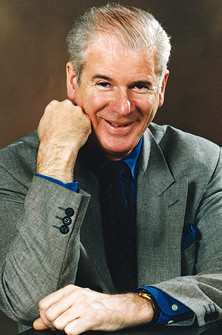 (photo) who wrote most of it, while I enjoyed Edinburgh. I went out to explore the hidden layers of the ancient city, strolled through the streets and parks and finally fell in love with a Reverend, a certain Robert Walker, Skating on Duddingston Loch. He is better known as The Skating Minister, and it is an oil painting by Sir Henry Raeburn in the National Gallery of Scotland in Edinburgh. The gallery is in a park ideally situated between
(photo) who wrote most of it, while I enjoyed Edinburgh. I went out to explore the hidden layers of the ancient city, strolled through the streets and parks and finally fell in love with a Reverend, a certain Robert Walker, Skating on Duddingston Loch. He is better known as The Skating Minister, and it is an oil painting by Sir Henry Raeburn in the National Gallery of Scotland in Edinburgh. The gallery is in a park ideally situated between 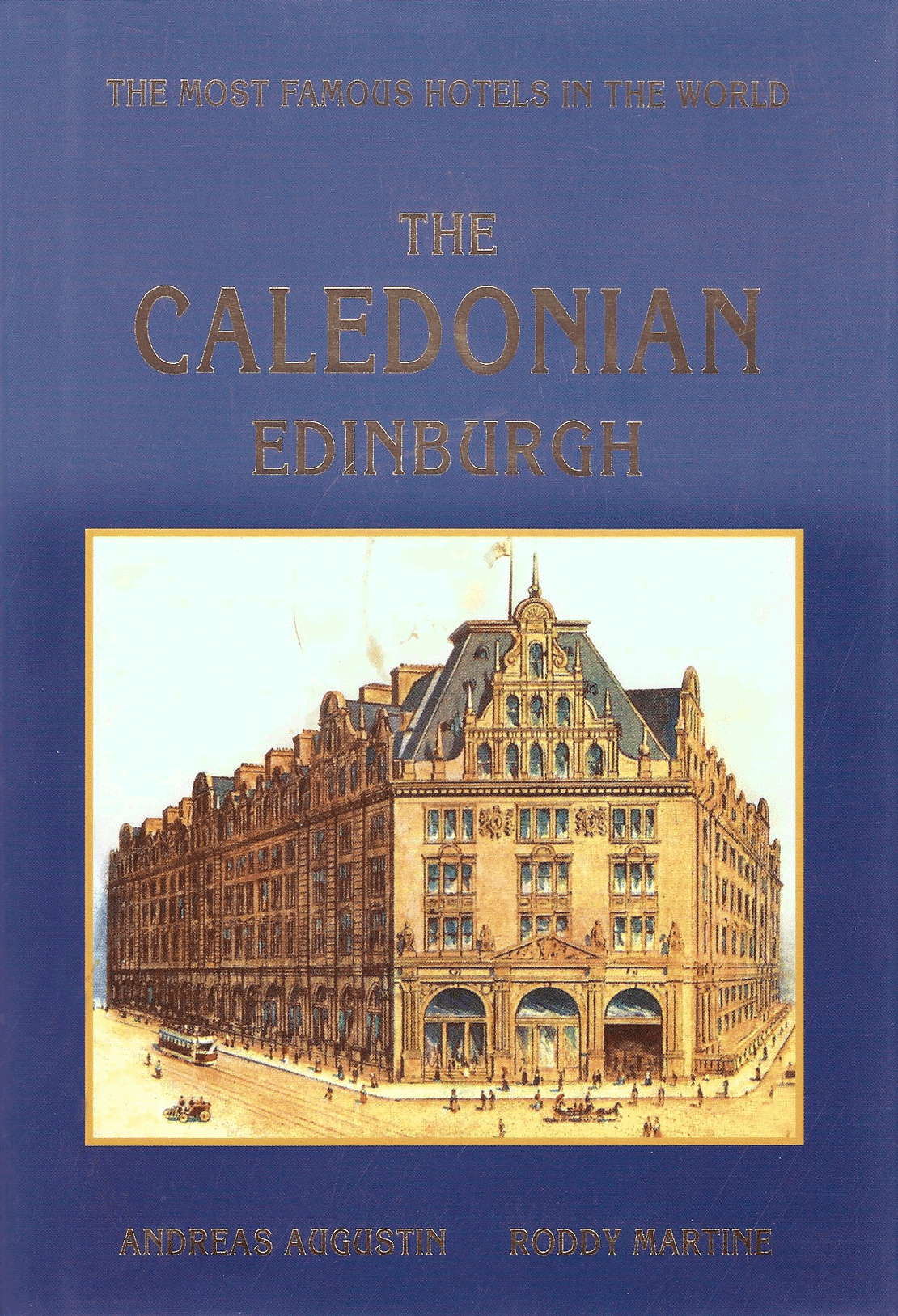 The Caledonian and the other grand hotel of the Scottish capital, The Balmoral. We also list, of course, all the legendary golf hotels of the rest of Scotland.
The Caledonian and the other grand hotel of the Scottish capital, The Balmoral. We also list, of course, all the legendary golf hotels of the rest of Scotland.
The Caledonian — the book:
By the end of the 19th century, Scotland had become the land of artists and poets, engineers and inventors. The Caledonian Railway had brought a new pace of life to the capital South of the Firth of Forth. In 1903 Princes Street Station was to become the base for a grand hotel. The Caledonian Hotel helped to consolidate Scotland’s position on the international stage by heralding a new era of luxury and travel in Scotland.
‘Of course this is a book about the Caledonian Hotel, but it is also a social study and a well cut synopsis of the history of Edinburgh.’
The Herald
Its most famous patrons, its managers, the staff of yesterday and today: in this book they all parade proudly through the pages and tell their stories, which, like many raindrops swelling to a stream, come together to form the story of The Caley, as this wonderful old hotel is affectionately known.
Read more Around the World in 80 hotels —
* Andreas Augustin is a writer and traveler, and the president of The Most Famous Hotels in the World, an organisation founded to safeguard the history and cultural heritage of all legendary hotels around the world.
Hotels are listed independently, following the statutes of The Most Famous Hotels in the World.
All hotels were chosen by the honorable jury, regardless of their geographical location, their brand, their political environment and their commercial success.
- 80 hotels
- around the world in 80 hotels
- balmoral
- caledonian
- chaplin
- churchill
- dorchester
- edinburgh
- england
- enrico caruso
- escoffier
- gilbert and sullivan
- great western paddington
- great western royal hotel
- hilton
- joplin sinclair
- london
- london hilton on park lane
- michael shepherd
- oscar wilde
- prince of wales
- queen victoria
- railway
- ritz
- sarah bernhardt
- savoy
- scotland
- shepherd
SCHLOSS SCHÖNBRUNN
( words)
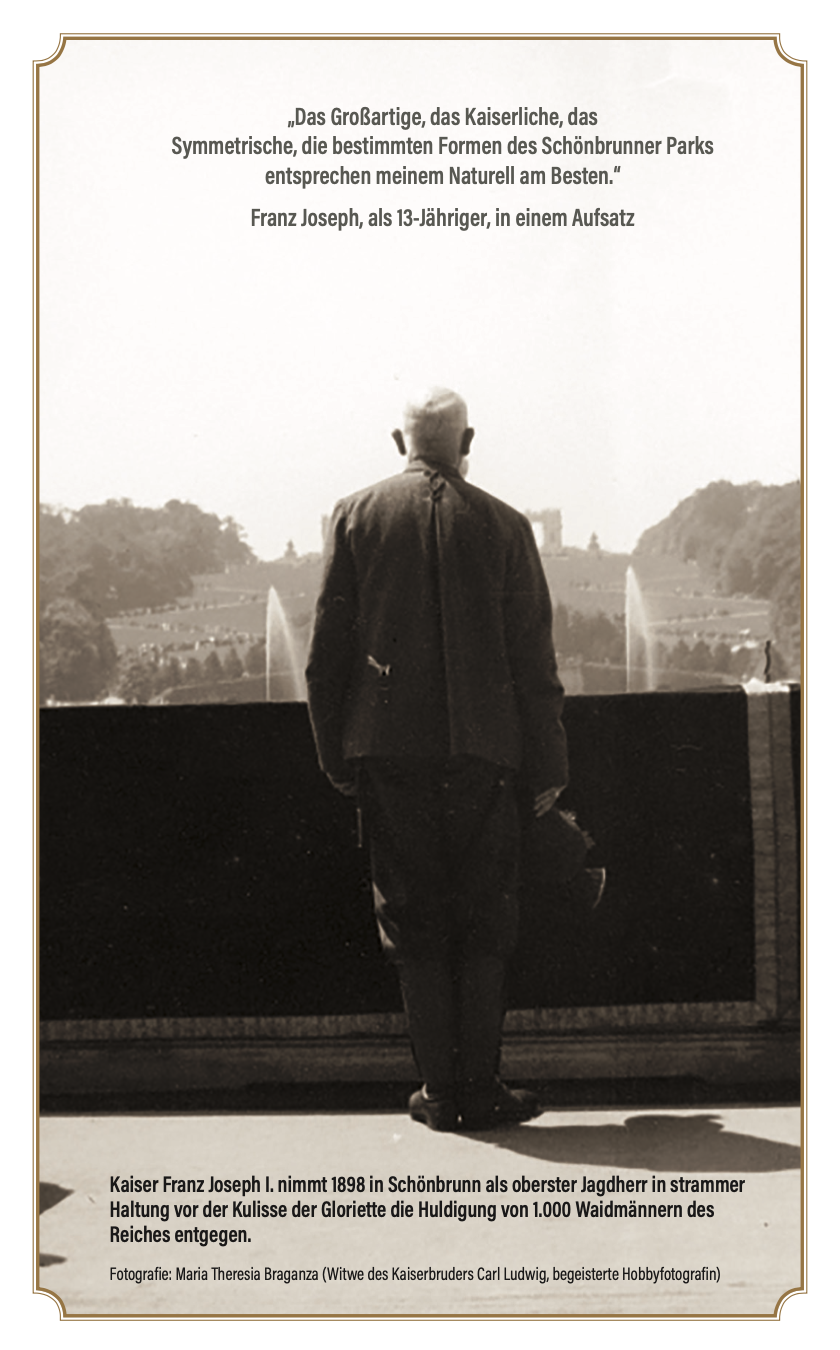
Wieder einmal haben sich Andreas und Carola Augustin auf ein Thema konzentriert, dass sie seit Jahrzehnten begleitet. Generationen-übergreifend - sozusagen!
Begleitet wurden sie von der Fotografin Karin Gasser.
"SCHÖNBRUNN — DER PARK" - 2023 Genius Edition
Bis 1918 war Schloss Schönbrunn der Sitz der Habsburger Kaiser, Wohnort einer der mächtigsten imperialen Familien der Weltgeschichte und Ort strengen höfischen Zeremoniells. Seitdem ist es im Besitz der Republik Österreich und versprüht imperiale Atmosphäre.
Das Areal wurde im Jahre 1996 in die UNESCO Liste als Weltkulturerbe aufgenommen. Schloss und die Gärten von Schönbrunn gelten als „besonders gut erhaltenes Beispiel einer barocken Herrscherresidenz; gemeinsam bilden sie ein außergewöhnliches Beispiel eines Gesamtkunst- werks, einer meisterhaften Verbindung zahlreicher Kunstgattungen.“
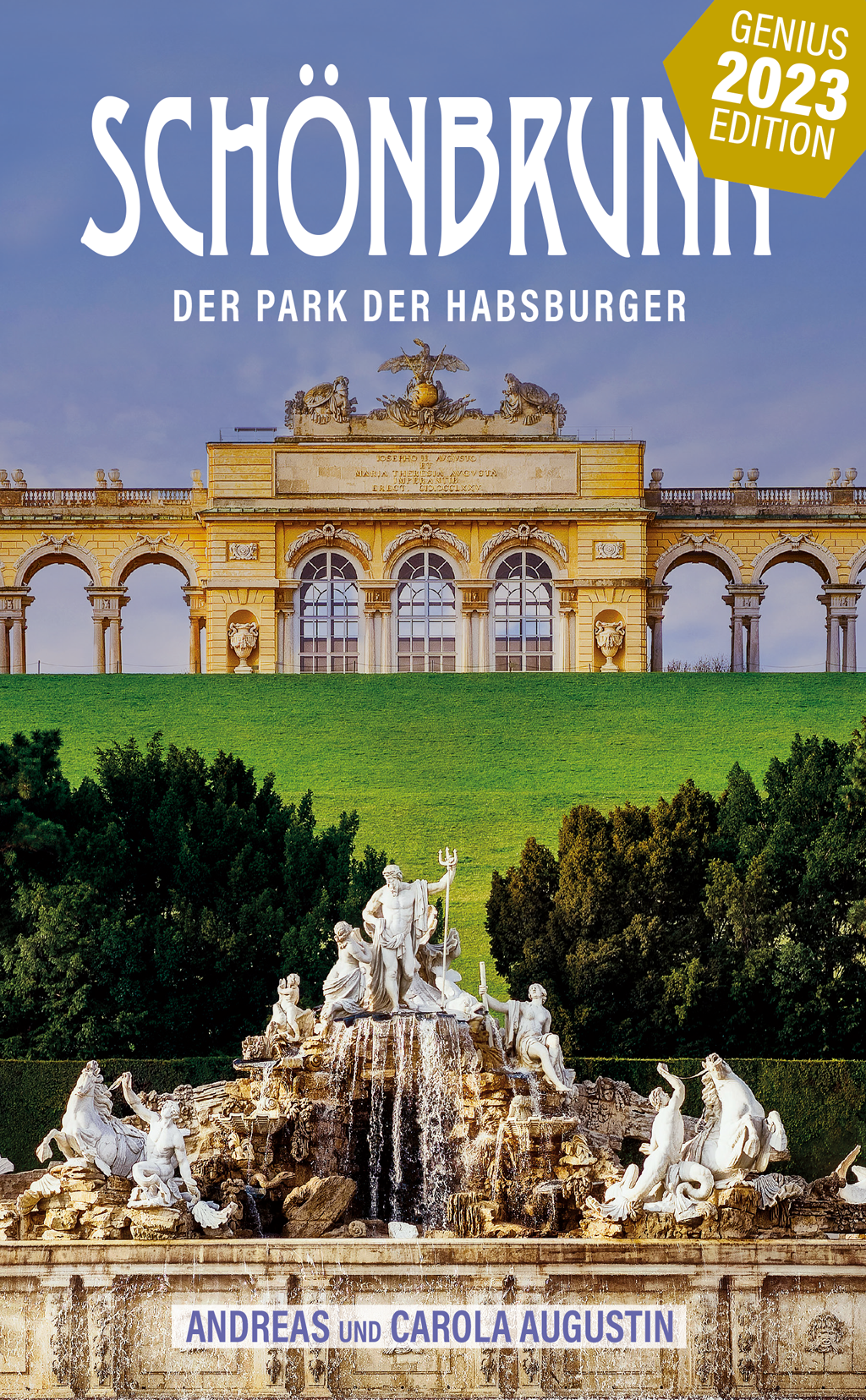 Hier lebten unter anderem zwei der berühmtesten Habsburger Kaiserpaare: im 18. Jahrhundert Maria Theresia und Franz Stephan von Lothringen, im 19. Jahrhundert Franz Joseph I. und Elisabeth (Sisi).
Hier lebten unter anderem zwei der berühmtesten Habsburger Kaiserpaare: im 18. Jahrhundert Maria Theresia und Franz Stephan von Lothringen, im 19. Jahrhundert Franz Joseph I. und Elisabeth (Sisi).
Schönbrunn war im 18. Jahrhundert das Zentrum der botanischen Forschung.
Eine Rückbesinnung auf die Helden der klassischen Antike finden wir in den Statuen und Denkmälern, die Legenden aus längst vergangener Zeit erzählen.
Der Tiergarten, früher „Menagerie“ genannt, ist der älteste der Welt.
Seit 1779 ist der Park von Schönbrunn öffentlich zugängig; ein Garten des Volkes!
Um 1820 wurde aus dem aristokratischen Lustwandeln das bürgerliche Spazierengehen, das Promenieren. Der Sonntagsspaziergang, ein Gemälde von Carl Spitzweg, wurde zum Symbol einer in die Natur aufbrechenden Gesellschaft.
Schönbrunn wurde zum Paradies für Spaziergänger, Heim des feinsten Zoos der Welt, botanische Fundgrube, Sehnsuchtsort über alle Generationen. Wir sind alten Spuren gefolgt und haben neue Wege entdeckt. Kommen Sie mit uns! Gehen Sie los.
Andreas & Carola
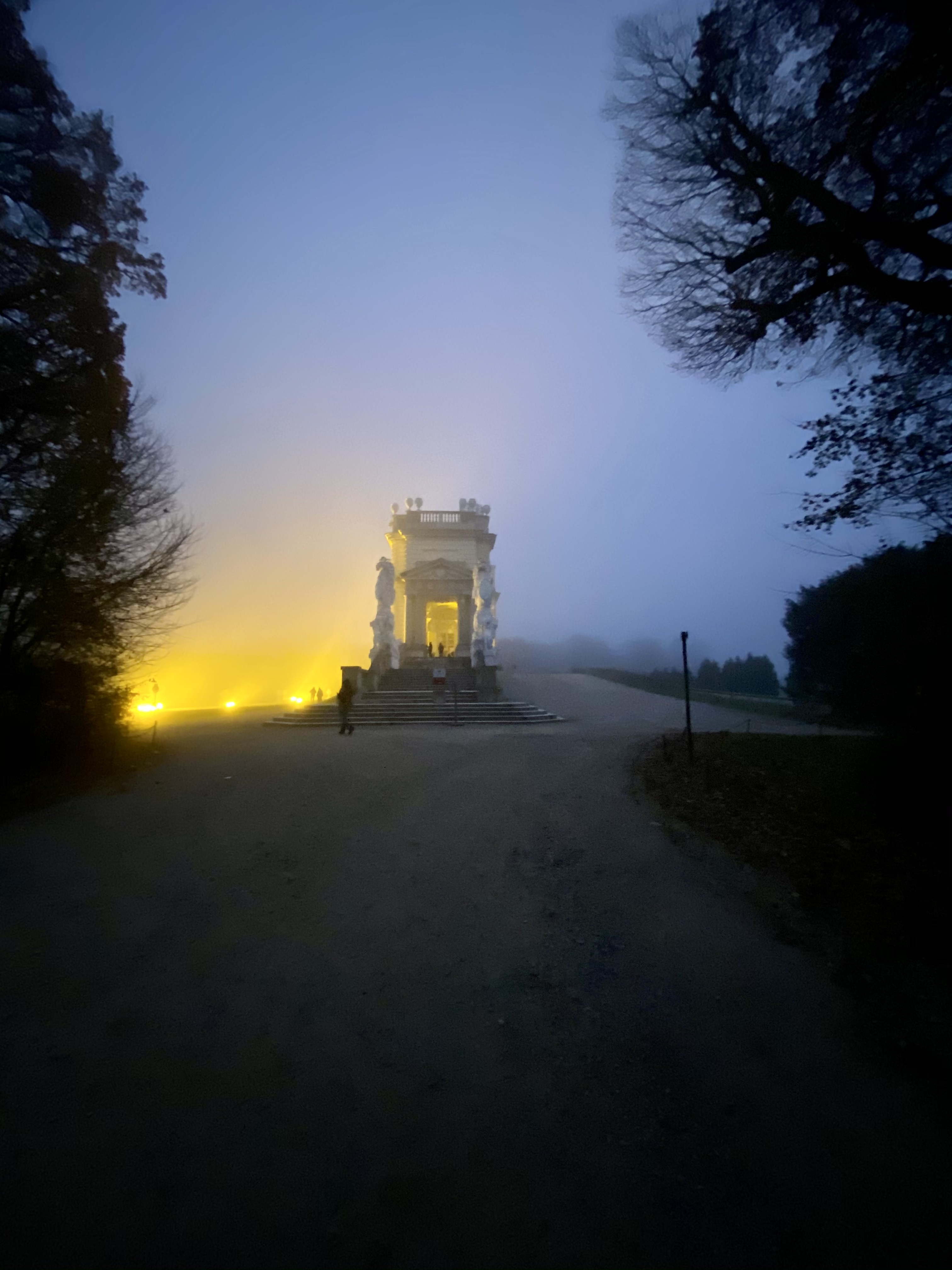 Über 300 Abbildungen, Pläne, Statuen, Monumente, Gartendetails und viele Geschichten rund um die Habsbruger, die diesen Park schufen und uns hinterließen.
Über 300 Abbildungen, Pläne, Statuen, Monumente, Gartendetails und viele Geschichten rund um die Habsbruger, die diesen Park schufen und uns hinterließen.
VENICE 1822: Dal Niel opens Danieli
( words)
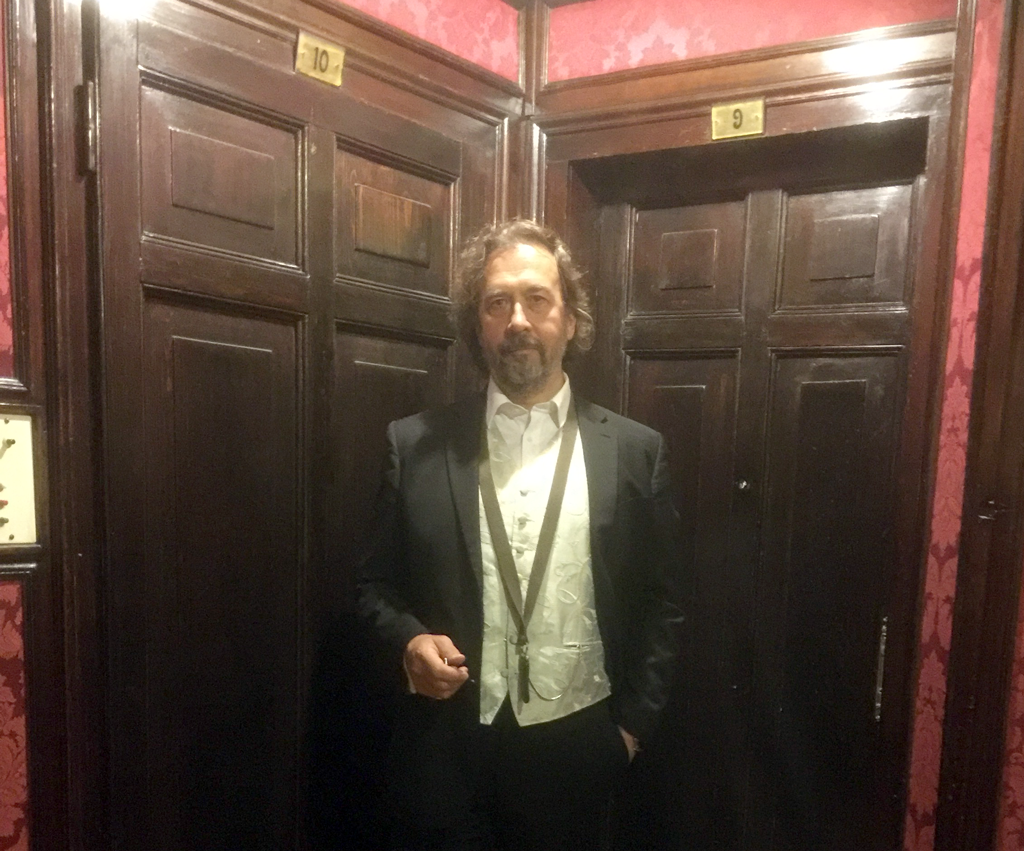 Adrian Mourby in front of the George Sand room.
Adrian Mourby in front of the George Sand room.
BY ADRIAN MOURBY
On 24 October 1822 an entrepreneur from Friuli in the Veneto opened up the piano nobile of Palazzo Dandalo to the public. Giuseppe Dal Niel had had a novel idea. The mediaeval palazzo stood only a few doors down from the ever-popular Doge’s palace so here on Dandolo's imposing first floor he would accommodate paying guests.
By 1824, business was good enough to convince Dal Niel that there was a permanent market for such a hotel in Venice. He bought the entire palazzo, lavishly restoring it as he converted it into a hotel. As Venetians had already nicknamed this busy little man Danieli, that was the name that Dal Niel gave to his new venture.
Dal Niel threw himself into refurbishment and made many changes to the building. As a palazzo for the nobility, the building’s main entrance had to be to the side, on Rio del Vin for gondola access. But as a hotel it needed a door directly on to the quayside of Riva degli Schiavoni for general access.
Dal Niel remodelled the Schiavoni facade to create a Gothic doorway with a superb views across to the island of San Giorgio di Maggiore. In the 1820s and 30s shops with doors on to the quay took up the rest of the ground floor (these were later incorporated into the hotel's spacious drawing room and Bar Dandolo). Moreover in the 1820s guests would have mounted an open staircase to their rooms on the piano nobile. This courtyard was subsequently roofed over in glass for greater comfort.
As Venice’s first commercial hotel, the Danieli received many famous guests. Richard Wagner who visited Venice six times often put himself up at the hotel until he had found a suitable apartment. He subsequently claimed that the lonely song of a gondolier inspired the opening of his Tristan und Isolde. Charles Dickens also stayed the Danieli describing the Venetian gondola that ferried him to its doors as "a black boat with a black cabin that floated up a phantom street of water".
But the very first celebrity of note to arrive was the cross-dressing French writer George Sand. Sand was later the mistress of Frederic Chopin but when she arrived in January 1834 it was in the company of her latest lover, the poet Alfred de Musset. Venice was a relatively cheap place to elope to in those days. Sadly, although the couple arrived during the period preceding Lent known as “Carnevale” [which had been celebrated for centuries], the festival had been banned by the Hapsburgs.
Dancing and the wearing of masks were outlawed at this time on moral grounds. Venice in the 1830s had little to divert its celebrity guests. Musset did manage to quickly lose a lot of Sand's money at the Casino however - and then fall ill from a combination of nervous exhaustion and alcohol. The couple stayed in what is now the Danieli’s Room 10. George Sand nursed her highly-strung lover for a few weeks here, before losing patience with him and running off with his doctor. Nevertheless the hotel has gallantly stencilled “Alfredo de Musset e George Sand MDCCCXXXIII-XXXIV” on one of the interior walls.
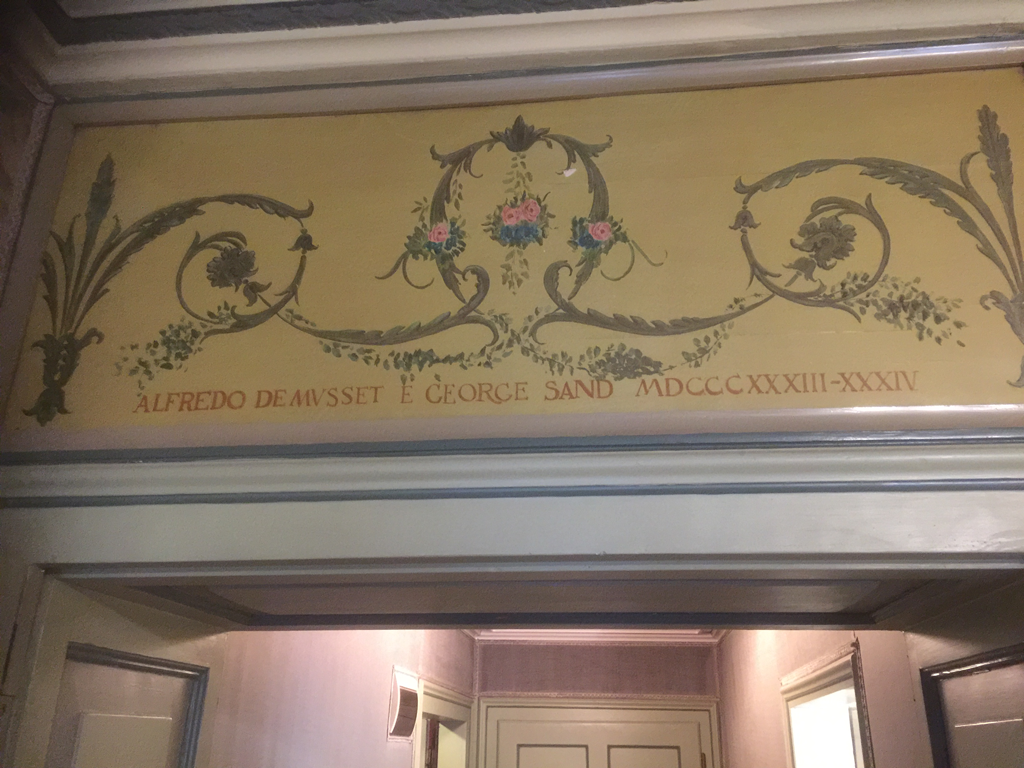
“Alfredo de Musset e George Sand MDCCCXXXIII-XXXIV”
Many great names have stayed at the Danieli ever since, including Honoré de Balzac and Marcel Proust, Greta Garbo and Charlie Chaplin, Sean Connery, Salvador Dali and the Burton-Taylors. Photos of many of these are displayed in the top-floor Bar Terrazza Danieli.
In the twentieth century the (now) Royal Hotel Danieli became the model for many palazzi that were turned into commercial hotels in Venice. In 1906 the Royal Danieli was purchased by Count Giuseppe Volpi to become a part of his CIGA hotel chain - "Compagnia Italiana Grandi Alberghi".
Then in 1948 the buildings that separated Palazzo Dandolo from the Doge’s prison (Palazzo delle Prigioni) were demolished and a modern extension, known as the Danielino was erected with a ballroom on the ground floor and bedrooms above.
In 2005 the hotel passed into the ownership of the Italian Statuto Group who brought in the renowned hotel architect Jacques Garcia to create the possibly most glamorous restaurant in Venice. Its nineteenth century decor and views over Bacino San Marco are unparalleled. Since 2016 it has been managed by Marriott International, under the brand name of The Luxury Collection.
The Danieli has been enjoying a year of celebrations leading up to 24 October 2024.
I wish it well on its two-hundredth birthday with every confidence that it will be around for two hundred more years.
Hotel Danieli
Address: RIVA DEGLI SCHIAVONI, CASTELLO 4196,
VENICE, ITALY, 30122
General Manager Claudio Staderini
Imperial World
( words)
Imperial Hotels around the world
Hotel name = Imperial Hotel unless specified differently.
"Imperial" is a very popular hotel name. It still features prominently in the post-colonial world – a reminiscence of a bygone era.
AFRICA
Ethopia
Adis Abeba (Ghion Imperial Palace Hotel)
South Africa
Pietermartitzburg
Bloemfontein
Uganda
Grand Imperial Hotel
AMERICAS
Argentina
Buenos Aires (Imperial Park Hotel)
Bermuda
Hamilton
Canada
Galt (Ontario)
Ecuador
Quito (Best Western Plaza Caicedo)
Mexico
Cancun (Hotel Imperial Las Perlas)
Cancun (Imperial Laguna)
Saltillo (Best Western Hotel Imperial del Norte)
Mexico City (Tampico Hotel Imperial)
Guadalajara
Panama
St Colon
USA
Las Vegas (Imperial Palace Hotel & Casino)
Amador City, California
Richmond, Indiana (Best Western Imperial Motor Lodge)
Ocean City, New Jersey
Petoskey, Michigan
Hot Springs, Arkansas
Rhode Island
Niagara Falls (Vintage Imperial Hotels)
Netcong, New Jersey
Miami
Miami Beach
Cripple Creek (Colorado)
Silverton (Colorado)
Bay City (Michigan)
Steubenville (Ohio)
NYC
Pontiac, Illinois
(Court Imperial Hotel)
Kiamesha Lake, NY (Concord Imperial Hotel)
New Braunfels, Texas (Imperial Motor Hotel)
Dallas (Texas)
Honolulu (Imperial Hawaii Hotel)
Waikiki (Imperial Hawaii Hotel)
Landrum, South Carolina
Portland
Orlando (Marriots Imperial Palm Villas)
Reynoldsville
El Centro, California (Best Western John Jay Inn)
Calexico, California (Best Western John Jay Inn)
Knoxville, Tennessee
Sumter, South Carolina
ASIA
China
Hong Kong
Shenyang (Gloria Plaza Hotel)
Imperial Hotel TIENTSIN China
India
New Delhi
Indonesia
Tangarang (Imperial Century Hotel & Resort)
Japan
Tokyo (Designed & built by Frank Lloyd Wright in 1915-1922 but the original building was moved to the Meiji Village museum for preservation & display)
Singapore
Oberoi Imperial Hotel
Thailand
Amphur Muang (Imperial Tara Mae Hotel)
Chiangmai
Koh Samui
Chiangrai
Petchaboon
Taiwan
Taipei (Imperial Inter-Continental)
EUROPE
Austria
Vienna
Belgium
Oostende (Best Western Imperial Hotel)
Bulgaria
Sofia (Grand Hotel Imperial)
Croatia
Dubrovnik (Grand Hotel Imperial)
Czech Republic
Reichenberg
Denmark
Copenhagen
Eire
Cork
Galway
France
Nice (Hotel Ruhl Imperial)
Ajaccio
Germany
Frankfurt (Best Western Imperial Hotel am Palmangarten)
Berlin
Marienbad
Karlsbad
Italy
Tramontano
Naples
Ragusa
Rome
Sorrento (Imperial Hotel Tramontano)
Malta
Sliema Imperial Hotel
Portugal
Aveiro (Best Western Imperial Hotel)
Luso
Spain
Seville (Hotel Casa Imperial)
UK
Exmouth
Ilfracombe
Cheltenham
Torquay
Tenby
Fort William (Best Western Imperial Hotel)
Hereford
Blackpool
London (Imperial Hotel Russell Square)
Great Malvern
Hythe
South West Scotland (The Golf Hotel)
Nairn (Imperial Golf Hotel)
Gwynedd (Best Western Imperial Hotel)
Barnstaple
Newcastle
Stafford
Bournemouth
Liverpool
MIDDLE EAST
Lebanon
Beirut (Imperial Suites Hotel)
OCEANIA
Australia
Hobart (no longer exists)
Sydney (Hotel Imperial Kings Cross)
Ritz-Carlton: The Beginning
( words)
The first Ritz-Carlton Hotel(s)
Ritz-Carlton's name is based on The Carlton in London and the Ritz in Paris and London, all of them conceived and opened by César Ritz, the Swiss hotelier.
The Ritz-Carlton Investing Company was established by Albert Keller in 1911, paying a stately sum to the Ritz Hotel Development Syndicate in London for franchising the name in the United States.
In 1911, in their opening announcement of the first Ritz-Carlton Hotel, located on Madison Avenue and Forty-Sixth Street, New York, general manager Theo Kroell and manager Albert Keller boast a breathtaking collection of asscociated hotels.
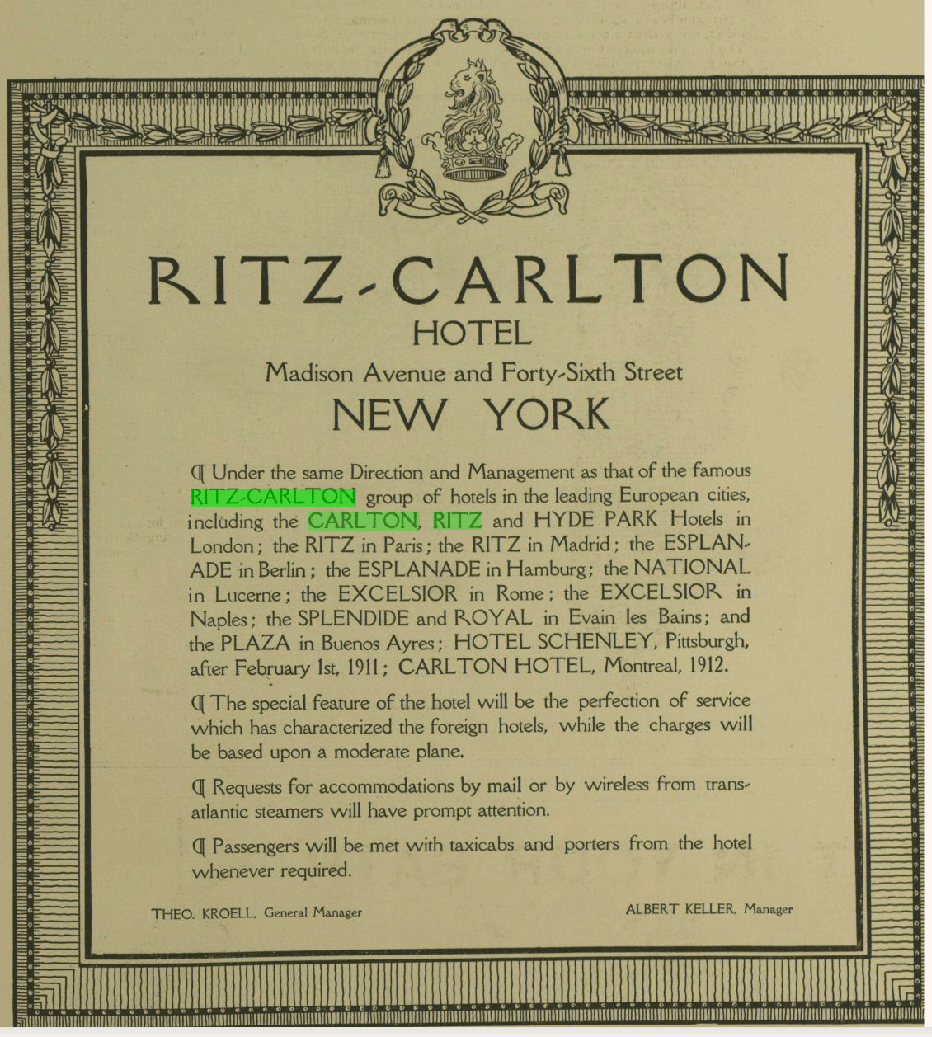 The first Ritz-Carlton Hotel(s) — 1911, The Illustrated London News
The first Ritz-Carlton Hotel(s) — 1911, The Illustrated London News
The Ritz-Carlton is "Under the same management and direction as that of the famous RITZ-CARLTON group of hotels in the leading European cities, including the CARLTON, RITZ and HYDE PARK Hotels in London; the RITZ in Paris, the RITZ in Madrid, the ESPALANDE in Berlin, the ESPLANADE in Hamburg, the NATIONAL in Lucerne, the EXCELSIOR in Rome, the EXCELSIOR in Naples, the SPLENDIDE and ROYAL in Evain les Bains, and the PLAZA in Buenos Ayres, HOTEL SCHENLEY, Pittsburgh, after February 1st 1911; CARLTON HOTEL, Montreal, 1912.
The special features of the hotel will be the perfection of service which has characterized the foreign hotels, while the charges will be based upon a moderate plane.
Request for accommodations by mail or by wireless from transatlantic steamers will have prompt attention.
Passengers will be met with taxicabs and porters from the hotel whenever required."
Louis Diat ran the kitchens and is believed to have invented the modern vichyssoise there. The hotel was expanded in 1911, adding 100 rooms, a 300-seat banquet hall, ballroom, and private dining rooms. Demolished in 1951.
The Ritz-Carlton hotels revolutionized hospitality in America by creating luxury in a hotel setting. They also introduced an European attitude to personal service:
Private bath in each guest room.
Lighter fabrics in the guest room to allow for more thorough washing.
White tie and apron uniforms for waiters, black tie for the Maitre d’ and morning suits for the management.
Extensive fresh flowers throughout the public areas.
A la carte dining and gourmet cuisine, utilizing the genius and cooking methods of Auguste Escoffier.
Intimate, smaller lobbies for a more personalized guest experience.
Other hotels followed in Philadelphia, Boston, Pittsburgh, Atlantic City and Boca Raton. New York's Ritz Carlton continued to operate until World War 2. By 1940, only The Ritz-Carlton, Boston was operating. The former building of the New York Ritz-Carlton was razed in 1951 to provide a site for an office building.
Today, the most historic of the US American Ritz Carlton hotels is the Ritz Carlton in Boston "embodying the vision of Cesar Ritz, Yankee ingenuity and Boston social sensibilities".
In 1983, The Ritz-Carlton Hotel Company, LLC was formed. Led by president and founding father, Colgate Holmes, alongside Horst Schulze, Joe Freni, Ed Staros and Herve Humler, the company began to expand, adding new properties across the United States. Within two years, the brand had opened five hotels, including The Ritz-Carlton, Buckhead, The Ritz-Carlton, Atlanta, The Ritz-Carlton, Laguna Niguel and The Ritz-Carlton, Naples. This rapid expansion continued, and by the close of 1992, The Ritz-Carlton had expanded to 23 exceptional luxury hotels, earning its first Malcolm Baldrige National Quality Award. The following year, they opened their first hotel in Asia, The Ritz-Carlton, Hong Kong.
In 1998, The Ritz-Carlton Hotel Company brand was purchased by Marriott International. Since this purchase, The Ritz-Carlton has continued to grow, providing exceptional service and genuine care to their guests across the globe. In 2000, The Ritz-Carlton Residences opened their first property in Washington, D.C., followed by their first Destination Club property, Aspen Highlands, Colorado in 2001. In addition to dozens of new hotels around the globe, in 2008 the company opened the first Ritz-Carlton Reserve property, offering a private sanctuary experience in Phulay Bay, Krabi, Thailand.
The Randolph — A Perspective of Oxford
( words)
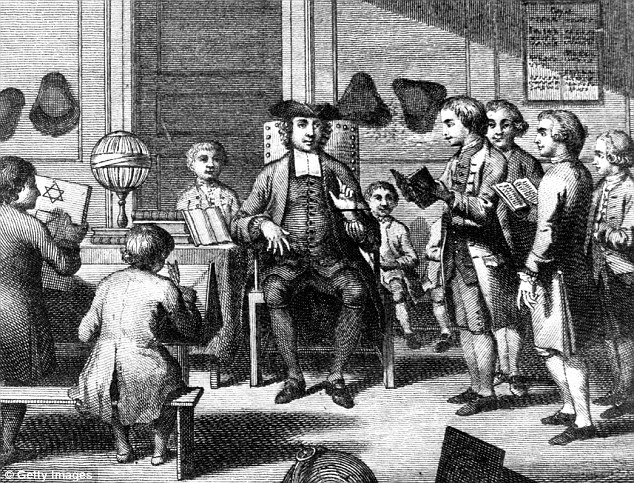
Teaching exists at Oxford since 1096 and developed accordingly from 1167, when King Henry II banned English students from attending the University in Paris. As the oldest university in the English-speaking world, Oxford is a unique and historic institution. Its most famous hotel is comparatively young. The Randolph opened in 1866. It very quickly established itself as what it was always intended to be: a suitable place for both visiting dignitaries and parents to stay when in Oxford.
The Randolph — A Perspective of Oxford
By Adrian Mourby
As someone who spent the first night of his honeymoon at The Randolph in 2004 I soon decided that if Thomas Mann had chosen instead to write Death in Oxford, this hotel would be where Gustav von Aschenbach met his beautiful young man among the aspidistras, string quartets and potted palms. The hotel, known in the early 21st century as the Macdonald Randolph always had an air of being slightly underfunded but history abounded in every nook and cranny.
In 2015 The Randolph made headline news across Britain. Disaster had struck when a fire began in the kitchens as beef stroganoff was being prepared. Flames leapt up within the chimney stack and set alight the hotel's vertiginous mansard roofing. The city centre ground to a halt as every available fire engine tackled the blaze. Town and Gown alike were shocked when The Randolph closed for the first time in its 129 year-old history. The hotel, such an architecturally controversial structure when it opened in 1886 had become so much a part of Oxford that its loss was almost as unthinkable as the destruction of the Ashmolean Museum or the Sheldonian Theatre.
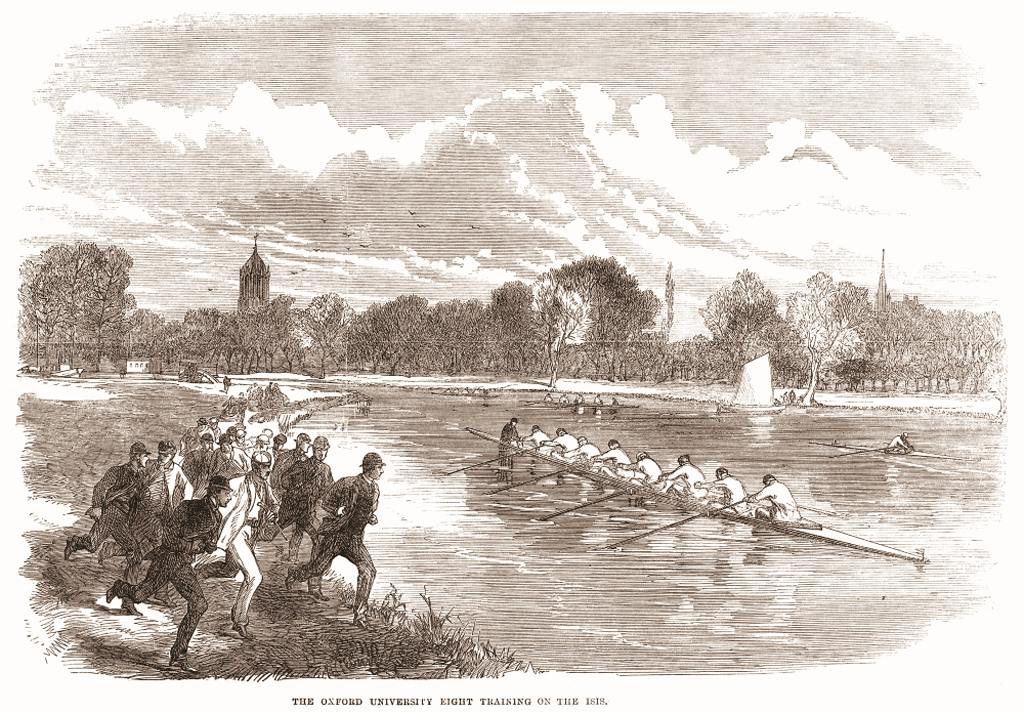
Boat Race 1866 — the Oxford University Eight Team
Big changes were coming to the Randolph however. Sadly, in 2017, Michael Grange died at the relatively young age of 61. A number of aspiring but short-lived general managers took over from him until Philip King arrived in July 2019. Soon afterwards the Macdonald Group relinquished its showcase hotel and sold it to A.J.Capital & Partners whose CEO, Ben Weprin runs Graduate Hotels, a collection of “handcrafted” hotels in university communities across the U.S. and U.K. For an entrepreneur Weprin has very distinct vision about décor. On his first tour of the hotel with Macdonald's new GM, Philip Lewis he was clearly struck by its potential. “I had no idea who he was,” said Philip Lewis. “He was wearing a baseball cap and he seemed to like everything he saw and at the end of our walk round he said “Yes I think I’ll buy it”.

Around 1910: Group of four women at a tea party within the grounds of Somerville College Oxford. Photograph by Henry W Taunt. Copyright © Oxford University Images /
Weprin has been very hands-on in the refurbishment of the Randolph. “He came and looked at the new Alice restaurant,” says Philip Lewis. “And he said he liked the wallpaper but he wanted it on the ceiling as well. Which was a shame because we’d just taken down the scaffolding!”
Graduate Hotels, who already owned a UK property in Cambridge endeared itself greatly to the townspeople of Oxford by flying its black and white Graduate flag over hotel’s entrance while reverting to the original name. The Randolph – pure and simple – is the only one of Graduate’s 32 hotels worldwide to be known by its local name rather than being The Graduate, Oxford.
The hotel’s multi-million pound refurbishment coincided with England’s many Covid lockdowns following March 2020 and the official reopening only occurred in January 2022.
“You might say we got lucky,” says Phil Lewis who has now been GM under both Macdonald and Graduate Hotels. “We only ever had enough rooms available as the market demanded. Next month (February 2022) I get my last 40 bedrooms back just as demand is increasing. Wedding bookings in 2022 are twice what they were pre-pandemic.”
The official reopening of the hotel – long delayed from a covidious November 2021in Britain - took place on Friday 21 January at the best party that Oxford has seen for almost two years – if not several decades
“It was amazing,” says Philip. “At these events it’s usual for 40% of people to cancel at the last minute. But we had 100% attendance from those who had said yes.”
As one who attended, I can attest that this was a party that brought glamour back to Oxford after 22 desolate months of successive government lockdowns. Maybe this was what it was like to step out of the austerity of the First World War (when the Randolph served as a hospital for recovering British soldiers) directly into the Roaring Twenties.
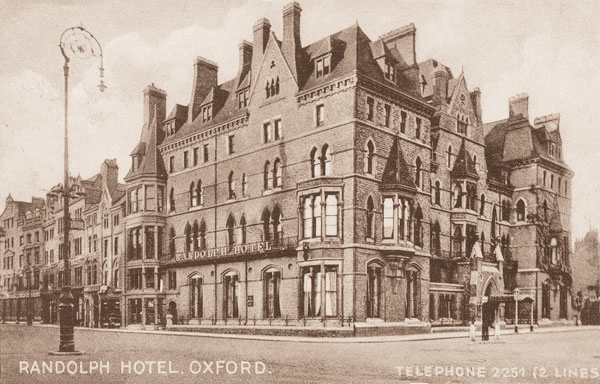
For all that the Randolph is now an Oxford institution it originally sat very uneasily in this city. There was always something audacious about its tall, mansard roofline whose very height dominated the surrounding colleges.
The Randolph has had a dramatic history over the past 136 years, turning from Oxford’s most unpopular building to one of its most beloved.
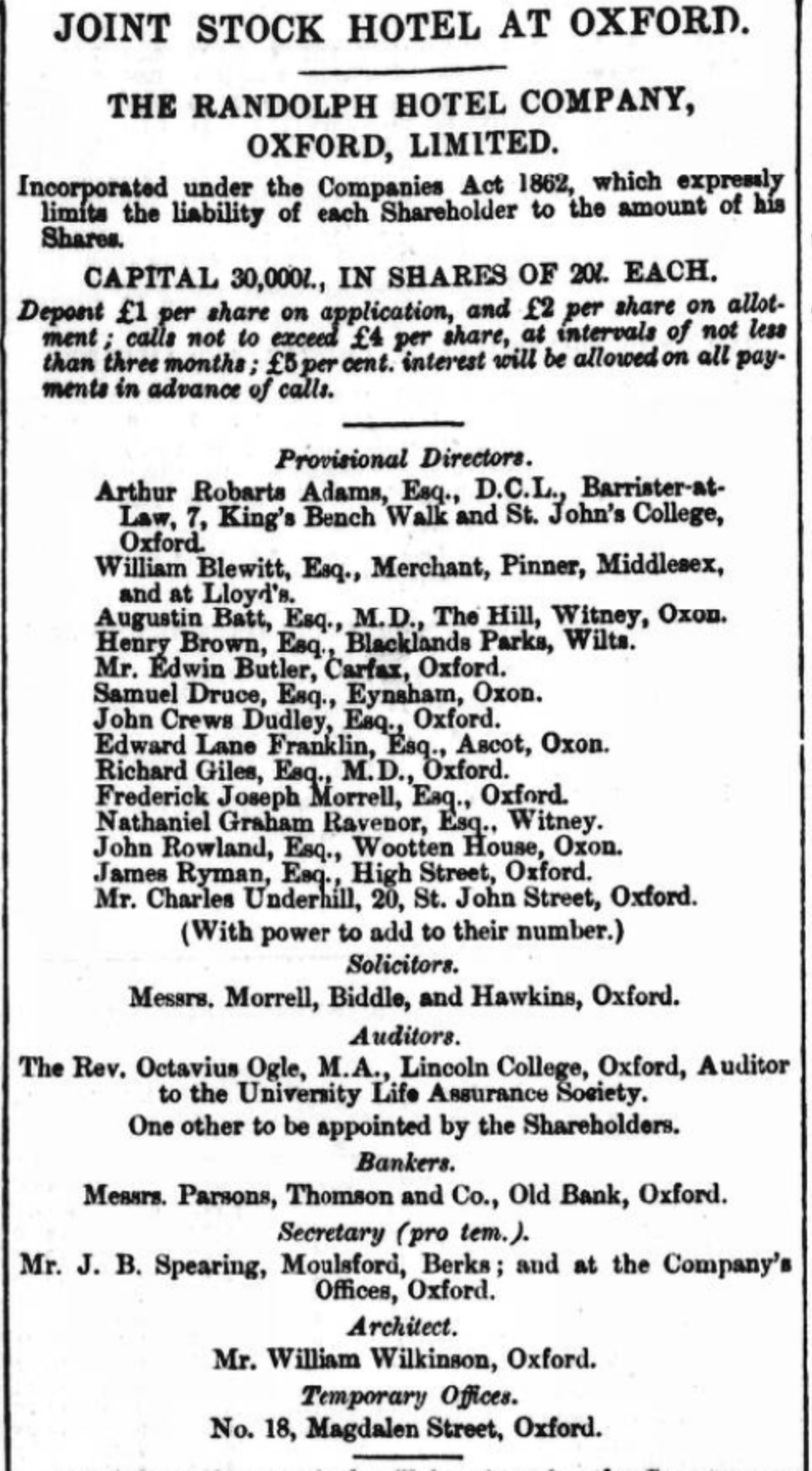 The first list of directors of the Joint Stock Randolph Hotel Company in 1863 (click image to enlarge).
The first list of directors of the Joint Stock Randolph Hotel Company in 1863 (click image to enlarge).
Many visitors believe it was named after Randolph Churchill, the father of Prime Minister Winston Churchill. Lord Randolph, second son of the Duke of Marlborough, obtained a decent degree at Merton College Oxford. His own second son Winston was born at nearby Blenheim Palace during a ball. But it was not Lord Randolph who lent his name to the neo-Gothic hotel on the corner of Beaumont Street. In fact Randolph Churchill was said to have smashed the windows of the hotel while an uproarious, over-entitled undergraduate.
Actually the hotel takes its name from Dr Francis Randolph, a University benefactor who had been Principal of St Alban Hall (now part of Lord Randolph’s Merton College), and who died in 1796 leaving a lot of money to the University. The art gallery he funded became part of the Ashmolean Museum’s collection. Why exactly Oxford’s premiere hotel was named after the (currently) obscure Dr Randolph needs further investigation.
The reason for the initial unpopularity of the hotel that bears Dr Randolph’s name was down to its design at a controversial time in Britain’s architectural history. The Gothic Revival was taking root in academic cities like Oxford where University men were rejecting neo-classicism and wanted something more visceral - and North European. In 1863 everyone agreed that Oxford needed a superior commercial hotel, especially because the newly married Prince and Princess of Wales would surely be visiting soon and the city lacked accommodation for a royal entourage. Absolutely no-one wanted Prince Albert and Princess Alexandra to be boarding at Blenheim Palace.
So plans were drawn up by local architect William Wilkinson to erect a Gothic structure on a corner of land opposite the neo-Classical Ashmolean. (Lovers of England’s blue plaques will notice that Wilkinson’s own house is situated directly opposite the Ashmolean and right next to the Randolph in Beaumont Street).

The opening report takes up two columns of the Oxford Journal
While the architect received support from men like the great art critic John Ruskin who was keen promote Protestant Neo-Gothic architecture in Britain, his designs were condemned by many who saw this hotel as despoiling the classical lines of Beaumont Street, the “finest ensemble of gentlemen’s houses” in the city. Wilkinson’s new hotel was considered too big and too tall in the way that it towered over its surroundings. And its style was in complete contrast to the rest of the nearby buildings, a semi crescent of neoclassical townhouses that wouldn’t have looked out of place in the city of Bath.
Moreover for some people the Randolph was an insult to the museum that stood immediately opposite it: the Ashmolean was and is, perhaps the most perfect neo-classical building in Oxford. It had been completed in 1845 but in the intervening 20 years English architecture had gone off in all sorts of directions.
The Italianate perfection of the "Ashmo" was now confronted by something that resembled a French chateau, redesigned in yellow brick with a proliferation of spires, bay windows and Draculean pinnacles. While the Ashmolean hid its roof behind a parapet, the Randolph was pretty much entirely slate roof. There were many protests about the design but eventually business considerations won out and a toned down neo-Gothic Randolph (minus its central spire) was built and duly opened for business in 1866.
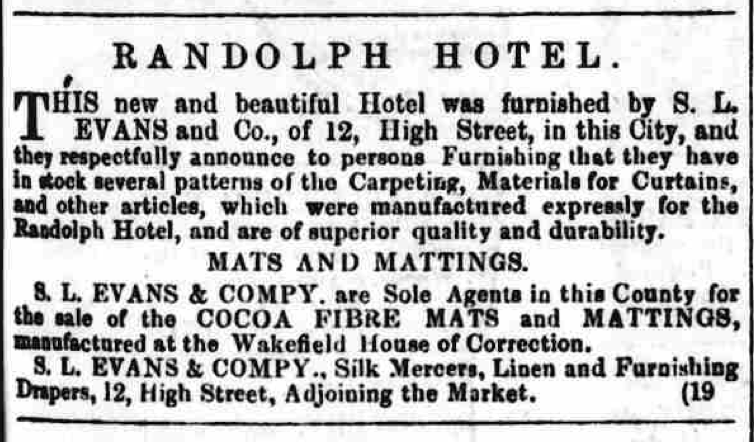
Testimonial "Randolph"
Post royal visit, this hotel very quickly established itself as what it was always intended to be, suitable place for both visiting dignitaries and wealthy parents to stay when in Oxford.
John Betjeman, an Oxford student and future 20th Century Poet Laureate summed up the contrasting sides of Beaumont Street very well: “This tall, vertical Victorian hotel was a Gothic answer to the Classic composition of the Ashmolean and Taylorian buildings on the other side of the road. Both buildings, despite their difference in style, were satisfactory upright terminations to the long low Georgian curve of Beaumont Street”
In 1894 the hotel proudly added an “American Elevator” and a ballroom in 1899 and, finally an extension down Beaumont Street in 1923 which the city fathers had hoped would be a little more Georgian in style but in the end the Randolph Hotel Company once again got its own way and the neo-Gothic line was extended with lots of medieval windows – and absolutely no apology.
By the beginning of the twentieth century guests could enjoy a Billiard Room, a Ladies’ Coffee Room and "a conservatory for smoking”. The hotel also advertised that it stocked “Fine Wines Imported From Abroad”. And it had good stabling (behind William Wilkinson’s house) which in due course became its garage.
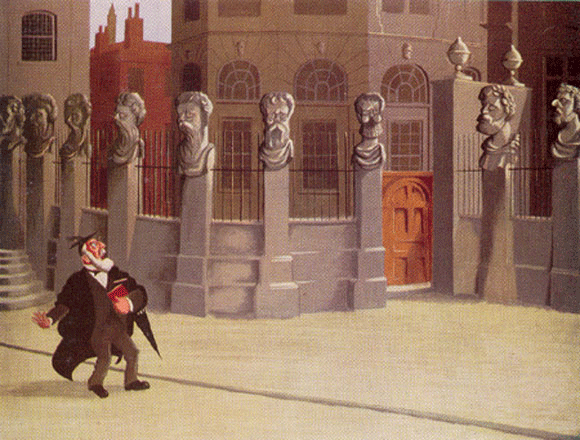 From one of twelve paintings in the Randolph Hotel, Oxford by Osbert Lancaster, illustrating Sir Max Beerbohm’s novel Zuleika Dobson (reproduced with kind permission of the Randolph Hotel). The official name for such heads is “herms”; the original accounts describe these heads as “termains”; and some people call them philosophers. But Max Beerbohm in Zuleika Dobson called them “Emperors”, and that is the name that has stuck. Each head shows a different type of beard. In that novel, Beerbohm wrote: ”Here in Oxford, exposed eternally and inexorably to wind and frost, to the four winds that lash them and the rains that wear them away, they are expiating, in effigy, the abominations of their pride and cruelty and lust. Who were lechers, they are without bodies; who were tyrants, they are crowned never but with crowns of snow; who made themselves even with the gods, they are by American visitors frequently mistaken for the Twelve Apostles.”
From one of twelve paintings in the Randolph Hotel, Oxford by Osbert Lancaster, illustrating Sir Max Beerbohm’s novel Zuleika Dobson (reproduced with kind permission of the Randolph Hotel). The official name for such heads is “herms”; the original accounts describe these heads as “termains”; and some people call them philosophers. But Max Beerbohm in Zuleika Dobson called them “Emperors”, and that is the name that has stuck. Each head shows a different type of beard. In that novel, Beerbohm wrote: ”Here in Oxford, exposed eternally and inexorably to wind and frost, to the four winds that lash them and the rains that wear them away, they are expiating, in effigy, the abominations of their pride and cruelty and lust. Who were lechers, they are without bodies; who were tyrants, they are crowned never but with crowns of snow; who made themselves even with the gods, they are by American visitors frequently mistaken for the Twelve Apostles.”
(Source: http://www.oxfordhistory.org.uk/broad/history/emperors.html)
Lancaster
Perhaps the guest to leave the greatest mark on the hotel was cartoonist, art critic and stage designer Sir Osbert Lancaster. His twelve illustrations to the novel Zuleika Dobson, An Oxford Romance were – and still are - hung in its drawing room (without a doubt the finest place for afternoon tea in Oxford). They were initially displayed in the new Art Deco ballroom in 1937. According to hotel legend the wealthy Sir Osbert paid for his stay at the Randolph with these witty depictions of Oxford life in the years before World War I. But that’s probably apocryphal. Lancaster was never short of money and he probably knew how much these original oil paintings would fetch if he sold them. Famous artists who have paid for their accommodation with works of art are a common myth in the hotel world, along with the ghost of a grey lady and the belief that the real Ernest Hemingway used to prop up the hotel bar. (Not a claim made in Oxford).
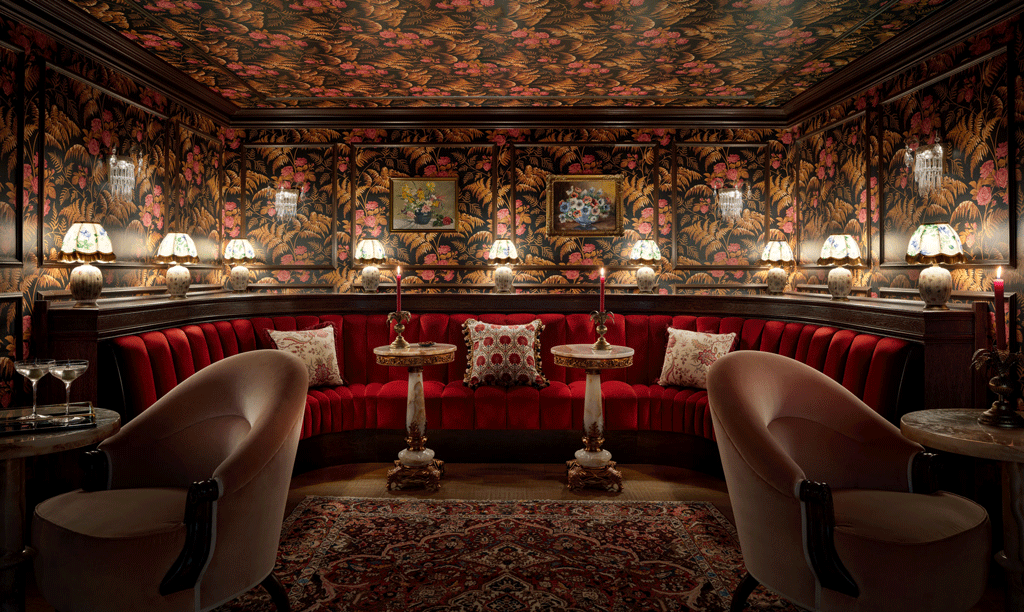
"The Snug"
When World War I broke out in 1914 the hotel was one of many across Britain that gave up its ballroom and drawing room for convalescent soldiers returning from fighting in France and Belgium. In the 1920s Evelyn Waugh, who mentioned the hotel in his novel Brideshead Revisited, once shocked diners at the Randolph by intervening in a discussion on bisexuality and declaring loudly “Buggers have babies”. Kingsley Amis’s future wife Hilly earned the novelist’s admiration by sneaking into the hotel to wash her hair and underwear while staying with him illicitly across the road at St John’s College (undergraduates were not officially allowed women guests in their rooms in the 1940s). Later Amis’ friend the poet Philip Larkin and the novelist Barbara Pym – who carried out a 14-year wholly epistolary relationship – finally met for lunch at the Randolph in 1975.
Morse
But for many people, in the last decades of the twentieth century the Randolph was most closely associated with two fictional characters, Inspector Morse and Sgt Lewis who featured in novels and dramatisations by local author Colin Dexter. In both books and in the TV series Inspector Morse the taciturn detective and Sgt Lewis regularly discuss their cases in the Randolph bar where Morse claimed, “They serve a decent pint”. In several stories, crime suspects dine or stay at the Randolph. And in the novel The Jewel that was Ours (dramatised as The Wolvercote Tongue) Morse investigates the suspicious death of an American hotel guest in her Randolph room.
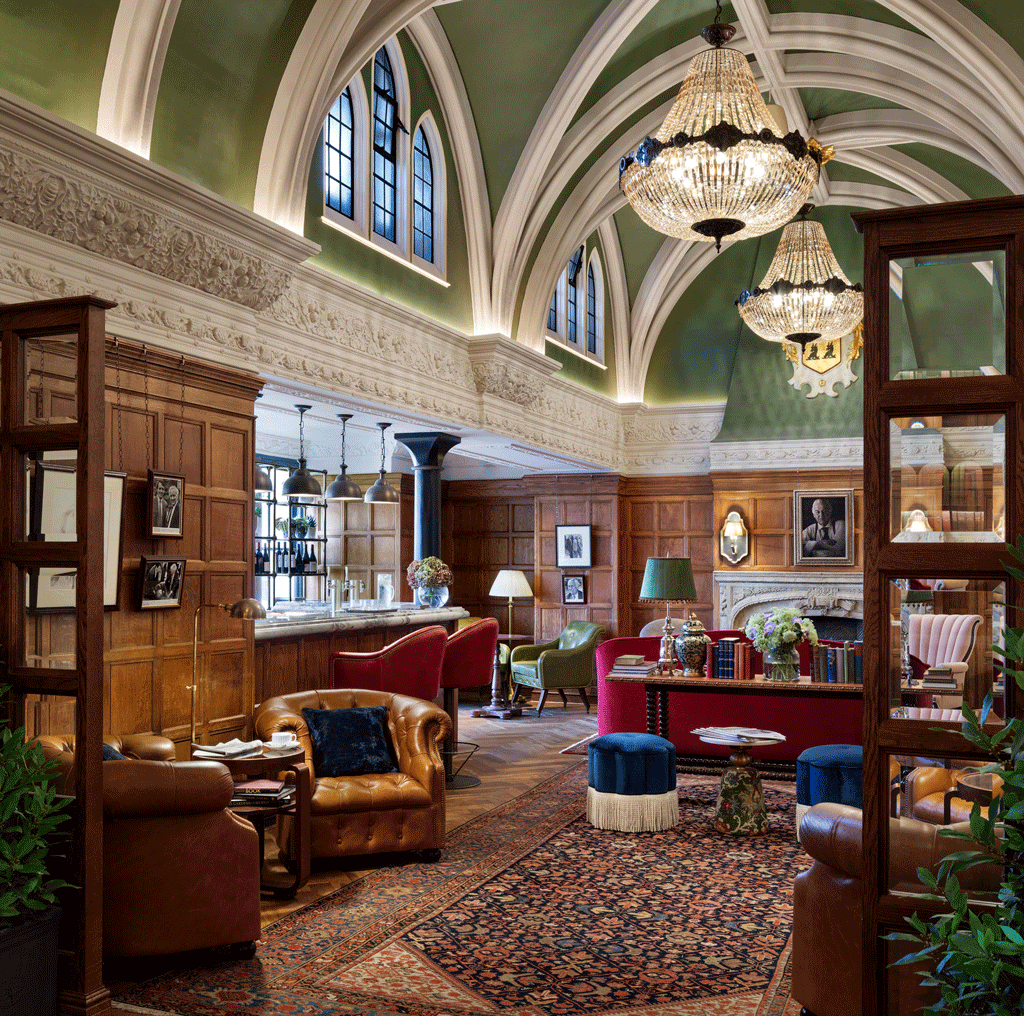 In 2001 the bar where Colin Dexter had often sat as an extra in the TV series Inspector Morse was officially renamed The Morse Bar. This is the part of the hotel that has changed least during the recent refurbishment though it has been repainted a darker hue of green and given more atmospheric lighting. Sardonic photos of John Thaw (Morse) are everywhere on its oak-panelled walls.
In 2001 the bar where Colin Dexter had often sat as an extra in the TV series Inspector Morse was officially renamed The Morse Bar. This is the part of the hotel that has changed least during the recent refurbishment though it has been repainted a darker hue of green and given more atmospheric lighting. Sardonic photos of John Thaw (Morse) are everywhere on its oak-panelled walls.
The purchase of The Randolph by A.J.Capital/Graduate Hotels has brought a much needed injection of money into a great Oxford institution. A lot of work needed doing including getting rid of an ill-judged formica canopy over reception which spoiled the dramatic four-storey rise above to the hotel’s main staircase.
The new hotel – it is fair to call it a new hotel because it has been so thoroughly redesigned –has been dramatically rethought. Above reception 30 heraldic tabards hang down Wilkinson’s cantilevered stairwell. They are based on Oxford colleges – but with an element of artistic licence.
Blue-striped wallpaper is everywhere on the ground-floor. It is a light blue stripe, more reminiscent of Cambridge’s famous blue than Oxford’s but English Heritage has been quite firm with the hotel that a Victorian colour scheme has to be followed. More contemporary touches include a photograph of Oscar Wilde in every bedrooom. The former Oxford student who fell so dramatically from grace in 1895 is now warmly re-embraced for his wit and humanity.
Two dapper gentlemen at The Randolph: general manager Philip Lewis and famoushotels author Adrian Mourby
The Alice Dining Room is decorated with new faux-naif paintings of the Oxford Wonderland heroine by the artist, illustrator and printmaker, Amy Wiggin. Long gone are the heraldic shields of Oxford colleges, introduced at ceiling height by Macdonald hotels. These days guests sit on pink banquettes on a floor of white mosaic tiles. The Alice Bar, which leads off from the dining room has a low-ceilinged, dark snug where one could imagine whiling away an entire winter drinking whisky. And beyond it lies a lofty chef’s table where the breakfast buffet is laid out.
I recently met the general manager, Philip Lewis for breakfast and hotel tour. Philip joined in 2019 the Randolph while it was still part of Macdonald Hotels. He has since stayed on to oversee this multi-million pound refurbishment.
However much it has cost – and it’s a lot - he has never been told. “Never?” I repeat. And he remains diplomatically silent on the subject.
As ever, I put to him the famoushotels General Managers’ Breakfast questionnaire, lean back and listen.
Read: "Breakfast with Philip Lewis" by Adrian Mourby
******************
The Randolph
Address
Number of rooms / Suites /
Restaurants / Bars
General Manager (2022) Philip Lewis
The Randolph: A Select member of The Most Famous Hotels in the World
The Greenbrier and its dress-code
( words)
Above - the hotel in 1913
By Stan Turkel
The original hotel, the Grand Central Hotel, was built on this site in 1858. It was known as “The White” and later “The Old White”.
Beginning in 1778, people came to follow the local Native American tradition to “take the waters” to restore their health. In the 19th century, visitors drank and bathed in the sulphur water to cure almost everything, from rheumatism to an upset stomach
The present structure opened in 1913. 26 presidents have stayed at The Greenbrier. Not surprising: the hotel has a whole website on dress code and - call us old-fashioned- we at The Most Famous Hotels in the World like that very much!
In 1910, the Chesapeake and Ohio Railway purchased the historic resort property and embarked upon a major expansion. By 1913, the railroad had added The Greenbrier Hotel (the central section of today’s hotel), a new mineral bath department ( the building that includes the grand indoor pool) and an 18-hole golf course (now called The Old White Course) designed by the most prominent contemporary golf architect, Charles Blair Macdonald. In 1914, for the first time, the resort, now renamed The Greenbrier, was open year-round. That year, President and Mrs. Woodrow Wilson spent their Easter holiday at The Greenbrier.
Business boomed in the 1920s and The Greenbrier took its place within high society’s traveling network that stretched from Palm Beach, Florida to Newport, Rhode Island. The obsolete Old White Hotel was demolished in 1922, which led to a substantial rebuilding of The Greenbrier Hotel in 1930. This refurbishment doubled the number of guestrooms to five hundred. Cleveland architect Philip Small redesigned the hotel’s main entrance and added both the Mount Vernon-inspired Virginia Wing to the south and the signature North Entrance facade. Mr. Small’s design mixed elements from the resort’s Southern historical roots with motifs from the Old White Hotel.
During the Second World War, the United States government appropriated The Greenbrier for two very different uses. First, the State Department leased the hotel for seven months immediately after the U.S. entry into the war. It was used to relocate hundreds of German, Japanese, and Italian diplomats and their families from Washington, D.C. until their exchange for American diplomats, similarly stranded overseas, was completed. In September 1942, the U.S. Army purchased The Greenbrier and converted it into a two thousand-bed hospital named Ashford General Hospital. In four years, 24,148 soldiers were admitted and treated, while the resort served the war effort as a surgical and rehabilitation center. Soldiers were encouraged to use the resort’s range of sports and recreation facilities as part of their recuperation process. At the war’s conclusion, the Army closed the hospital.
The Chesapeake and Ohio Railway reacquired the property from the government in 1946. The company immediately commissioned a comprehensive interior renovation by the noted designer Dorothy Draper. As Architectural Digest described her, Draper was “a true artiest of the design world [who] became a celebrity in the modern sense of the word, virtually creating the image of the decorator in the popular mind.” She remained the resort’s decorator into the 1960s. Upon her retirement, her protégé Carleton Varney purchased the firm and became The Greenbrier’s decorating consultant.
When The Greenbrier reopened in 1948, Sam Snead returned as golf pro to the resort where his career had begun in the late 1930s. For two decades in the post war years, he traveled the globe at the pinnacle of his lengthy career. More than any other individual, Sam Snead established The Greenbrier’s reputation as one of the world’s foremost golf destinations. In later years, he was named Golf Pro Emeritus, a position he held until his death on May 23, 2002.
In the late 1950s, the U.S. government once again approached The Greenbrier for assistance, this time in the construction of an Emergency Relocation Center ̶ a bunker or bomb shelter ̶ to be occupied by the U.S. Congress in case of war. Built during the cold war and operated in secrecy for 30 years, it is a huge 112,000 square foot underground fallout shelter, intended for use by the entire United States Congress in the event of nuclear war.
Excavations began in 1958 and construction was completed in 1962. By top-secret agreement, the Chesapeake and Ohio Railway built a new addition to the resort, the West Virginia Wing and the bunker was surreptitiously constructed under it. With concrete walls up to five feet thick, it is the size of two football fields stacked underground. It was built to shelter 1100 people: 535 senators and representatives and their aides. For the next 30 years, government technicians, posing as employees of a dummy company, Forsythe Associates, maintained the place regularly checking its communications and scientific equipment as well as updating the magazines and paperbacks in the lounge areas. At any point during those years, one telephone call from officials in Washington, D.C., fearing an imminent attack on the capital, would have turned the lavish resort into an active participant in the national defense system. At the end of the Cold War and prompted by exposure in the press in 1992, the project was terminated and the bunker decommissioned. According to a May 6, 2013 article in the Wall Street Journal, the U.S. Supreme Court planned to relocate to the Grove Park Inn, Asheville, N.C. in the event of a nuclear attack.
In the overt world above the bunker, resort life proceeded normally as Jack Nicklaus arrived to redesign the fifty-year old Greenbrier Course, bringing it up to championship standards for the 1979 Ryder Cup Matches. That course was also the site of three PGA Seniors tournaments in the 1980s and the 1994 Solheim Cup competition. In 1999, the Meadows Course evolved when Bob Cupp redesigned, rerouted and upgraded the older Lakeside Course, a project that included the creation of new Golf Academy. Sam Snead’s career was enshrined when the Golf Club was virtually rebuilt featuring the restaurant bearing his name with museum quality displays of memorabilia from his personal collection.
In a surprise announcement on May 7, 2009, Jim Justice, a West Virginia entrepreneur with a long-standing appreciation for The Greenbrier, became the owner of America’s most fabled resort. He purchased it from the CSX Corporation which, through its predecessor companies the Chessie System and the C&O Railway, had owned the resort for ninety-nine years. Mr. Justice turned his considerable energies into plans to revitalize America’s Resort. He immediately presented his vision of a casino designed by Carleton Varney that included shops, restaurants and entertainment in a smoke-free environment. The Casino Club at The Greenbrier opened in grand fashion on July 2, 2010. Simultaneously, Mr. Justice arranged to relocate a PGA Tour event named The Greenbrier Classic under the direction of The Greenbrier’s new Golf Pro Emeritus, Tom Watson. The first tournament was held July 26 through August 1, 2010.
26 presidents have stayed at The Greenbrier. The President’s Cottage Museum is a two-story building with exhibits about these visits and the history of The Greenbrier. The Greenbrier is listed on the National Register of Historic Places and is a member of Historic Hotels of America. It is a Forbes Four-Star and AAA Five-Diamond Award winner.
The Greenbrier’s complete history is chronicled in great detail supplemented by photographs from the resort’s archives in The History of The Greenbrier: America’s Resort by Dr. Robert S. Conte, the resort’s Resident Historian since 1978.
"Please accept our appreciation for your adherence to and support of our dress codes. At The Greenbrier, we are proud of our time-honored traditions and impeccable standards. We are thankful that you – our valued guests – are helping us to maintain these traditions that have been such an important part of The Greenbrier’s heritage for generations of guests." And it's dress code in all details can found here.
The Greenbrier
101 Main Street West
White Sulphur Springs,
West Virginia 24986
A Select Member of The Most Famous Hotels in the World since 1986
The Willard Washington
( words)
By Stanley Turkel, CMHS
Willard Hotel (394 rooms)
The Willard InterContinental Washington, commonly known as the Willard Hotel, is a historic luxury Beaux-Arts hotel located at 1401 Pennsylvania Avenue NW in downtown Washington, D.C. Among its facilities are numerous luxurious guest rooms, several restaurants, the famed Round Robin Bar, the Peacock Alley series of luxury shops, and voluminous function rooms. Owned by InterContinental Hotels & Resorts, it is two blocks east of the White House, and two blocks west of the Metro Center station of the Washington Metro.
The National Park Service and the U.S. Department of the Interior describe the history of the Willard Hotel as follows:
American author Nathaniel Hawthorne observed in the 1860s that “the Willard Hotel more justly could be called the center of Washington than either the Capitol or the White House or the State Department.” From 1847 when the enterprising Willard brothers, Henry and Edwin, first set up as innkeepers on the corner of 14th Street and Pennsylvania Avenue, the Willard has occupied a unique niche in the history of Washington and the nation.
The Willard Hotel was formally founded by Henry Willard when he leased the six buildings in 1847, combined them into a single structure, and enlarged it into a four-story hotel he renamed the Willard Hotel. Willard purchased the hotel property from Ogle Tayloe in 1864.
In the 1860s, author Nathaniel Hawthorne wrote that “the Willard Hotel more justly could be called the center of Washington than either the Capitol or the White House or the State Department.”
From February 4 to February 27, 1861, the Peace Congress, featuring delegates from 21 of the 34 states, met at the Willard in a last-ditch attempt to avert the Civil War. A plaque from the Virginia Civil War Commission, located on Pennsylvania Ave. side of the hotel, commemorates this courageous effort. Later that year, upon hearing a Union regiment singing “John Brown’s Body” as they marched beneath her window, Julia Ward Howe wrote the lyrics to “The Battle Hymn of the Republic” while staying at the hotel in November 1861.
On February 23, 1861, amid several assassination threats, detective Allan Pinkerton smuggled Abraham Lincoln into the Willard; there Lincoln lived until his inauguration on March 4, holding meetings in the lobby and carrying on business from his room.
Many United States presidents have frequented the Willard, and every president since Franklin Pierce has either slept in or attended an event at the hotel at least once; the hotel hence is also known as “the residence of presidents.” It was the habit of Ulysses S. Grant to drink whiskey and smoke a cigar while relaxing in the lobby. Folklore (promoted by the hotel) holds that this is the origin of the term “lobbying,” as Grant was often approached by those seeking favors. However, this is probably false, as Webster’s Ninth New Collegiate Dictionary dates the verb “to lobby” to 1837. Grover Cleveland lived there at the beginning of his second term in 1893, because of concern for his infant daughter’s health following a recent outbreak of scarlet fever in the White House. Plans for Woodrow Wilson’s League of Nations took shape when he held meetings of the League to Enforce Peace in the hotel’s lobby in 1916. Six sitting Vice-Presidents have lived in the Willard. Millard Fillmore and Thomas A. Hendricks, during his brief time in office, lived in the old Willard; and then Vice-Presidents, James S. Sherman, Calvin Coolidge and finally Charles Dawes all lived in the current building for at least part of their vice-presidency. Fillmore and Coolidge continued in the Willard, even after becoming president, to allow the first family time to move out of the White House.
Several hundred officers, many of them combat veterans of World War I, first gathered with the General of the Armies, John J. “Blackjack” Pershing, at the Willard Hotel on October 2, 1922, and formally established the Reserve Officers Association (ROA) as an organization.
The present 12-story structure, designed by famed hotel architect Henry Janeway Hardenbergh, opened in 1901. It suffered a major fire in 1922 which caused $250,000 (equivalent to $3,865,300 as of 2020), in damages. Among those who had to be evacuated from the hotel were Vice President Calvin Coolidge, several U.S. senators, composer John Philip Sousa, motion picture producer Adolph Zukor, newspaper publisher Harry Chandler, and numerous other media, corporate, and political leaders who were present for the annual Gridiron Dinner. For many years the Willard was the only hotel from which one could easily visit all of downtown Washington, and consequently it has housed many dignitaries during its history.
The Willard family sold its share of the hotel in 1946, and due to mismanagement and the severe decline of the area, the hotel closed without a prior announcement on July 16, 1968. The building sat vacant for years, and numerous plans were floated for its demolition. It eventually fell into a semi-public receivership and was sold to the Pennsylvania Avenue Development Corporation. They held a competition to rehabilitate the property and ultimately awarded it to the Oliver Carr Company and Golding Associates. The two partners then brought in the InterContinental Hotels Group to be a part-owner and operator of the hotel. The Willard was subsequently restored to its turn-of-the-century elegance and an office-building contingent was added. The hotel was thus re-opened amid great celebration on August 20, 1986, which was attended by several U.S. Supreme Court justices and U.S. senators. In the late 1990s, the hotel once again underwent significant restoration.
Martin Luther King Jr., wrote his famous “I Have a Dream” speech in his hotel room at the Willard in the days leading up to his August 28, 1963 March on Washington for Jobs and Freedom.
On September 23, 1987, it was reported that Bob Fosse collapsed in his room at the Willard and later died. It was subsequently learned that he actually died at George Washington University Hospital.
Among the Willard’s many other famous guests were P.T. Barnum, Walt Whitman, General Tom Thumb, Samuel Morse, the Duke of Windsor, Harry Houdini, Gypsy Rose Lee, Gloria Swanson, Emily Dickinson, Jenny Lind, Charles Dickens, Bert Bell, Joe Paterno, and Jim Sweeney.
Steven Spielberg shot the finale of his film Minority Report at the hotel in the summer of 2001. He filmed with Tom Cruise and Max von Sydow in the Willard Room, Peacock Alley and the kitchen.
Situated just two blocks from the White House, the hotel is replete with the ghosts of the famous and powerful. Over the years, it has been the gathering place for presidents, politicians, governors, literary and cultural figures. It was at the Willard that Julia Ward Howe composed “The Battle Hymn of the Republic.” Gen. Ulysses S. Grant held court in the lobby and Abraham Lincoln borrowed house slippers from its proprietor.
Presidents Taylor, Fillmore, Pierce, Buchanan, Taft, Wilson, Coolidge and Harding stayed at the Willard. Other notable guests have included Charles Dickens, Buffalo Bill, David Lloyd George, P.T. Barnum, and countless others. Walt Whitman included the Willard in his verses and Mark Twain wrote two books there in the early 1900s. It was Vice President Thomas R. Marshall, annoyed at the Willard’s high prices, who coined the phrase “What this country needs is a good 5-cent cigar.”
The Willard sat vacant from 1968 and in danger of demolition until 1986 when it was restored to its former glory. A $73 million restoration project was carefully planned by the National Park Service to recreate the hotel as historically accurate as possible. Sixteen layers of paint were scraped from the woodwork to ascertain the hotel’s original 1901 colors.
New York Times architecture critic Paul Goldberger wrote on September 2, 1986: Most restorations of venerable buildings fall into one of two categories they are either attempts to recreate as faithfully as possible what once was, or they are inventive interpretations that use the original architecture as a jumping-off point.
The newly rehabilitated Willard Hotel is both. Half of this project involves the respectful restoration of Washington’s greatest hotel building, a distinguished Beaux-Arts structure by Henry Hardenbergh that had been derelict since 1968, a victim of the decline of its neighborhood, a few blocks east of the White House. The other half is an exuberantly conceived, brand new addition containing offices, shops, public plaza and a new ballroom for the hotel.
Stanley Turkel: My Recent Book “Great American Hotel Architects Volume 2” was published in 2020.
All of my following books can be ordered from AuthorHouse by visiting [url=http://www.stanleyturkel.com]http://www.stanleyturkel.com[/url] and clicking on the book’s title:
Great American Hoteliers: Pioneers of the Hotel Industry (2009) Built To Last: 100+ Year-Old Hotels in New York (2011) Built To Last: 100+ Year-Old Hotels East of the Mississippi (2013) Hotel Mavens: Lucius M. Boomer, George C. Boldt, Oscar of the Waldorf (2014) Great American Hoteliers Volume 2: Pioneers of the Hotel Industry (2016) Built To Last: 100+ Year-Old Hotels West of the Mississippi (2017) Hotel Mavens Volume 2: Henry Morrison Flagler, Henry Bradley Plant, Carl Graham Fisher (2018) Great American Hotel Architects Volume I (2019) Hotel Mavens: Volume 3: Bob and Larry Tisch, Curt Strand, Ralph Hitz, Cesar Ritz, Raymond Orteig (2020)
If You Need an Expert Witness:
Stanley Turkel has served as an expert witness in more than 42 hotel-related cases. His extensive hotel operating experience is beneficial in cases involving:
slip and fall accidents wrongful deaths fire and carbon monoxide injuries hotel security issues dram shop requirements hurricane damage and/or business interruption cases Feel free to call him at no charge on 917-628-8549 to discuss any hotel-related expert witness assignment.
A HOTEL — LOST IN ATHENS
( words)
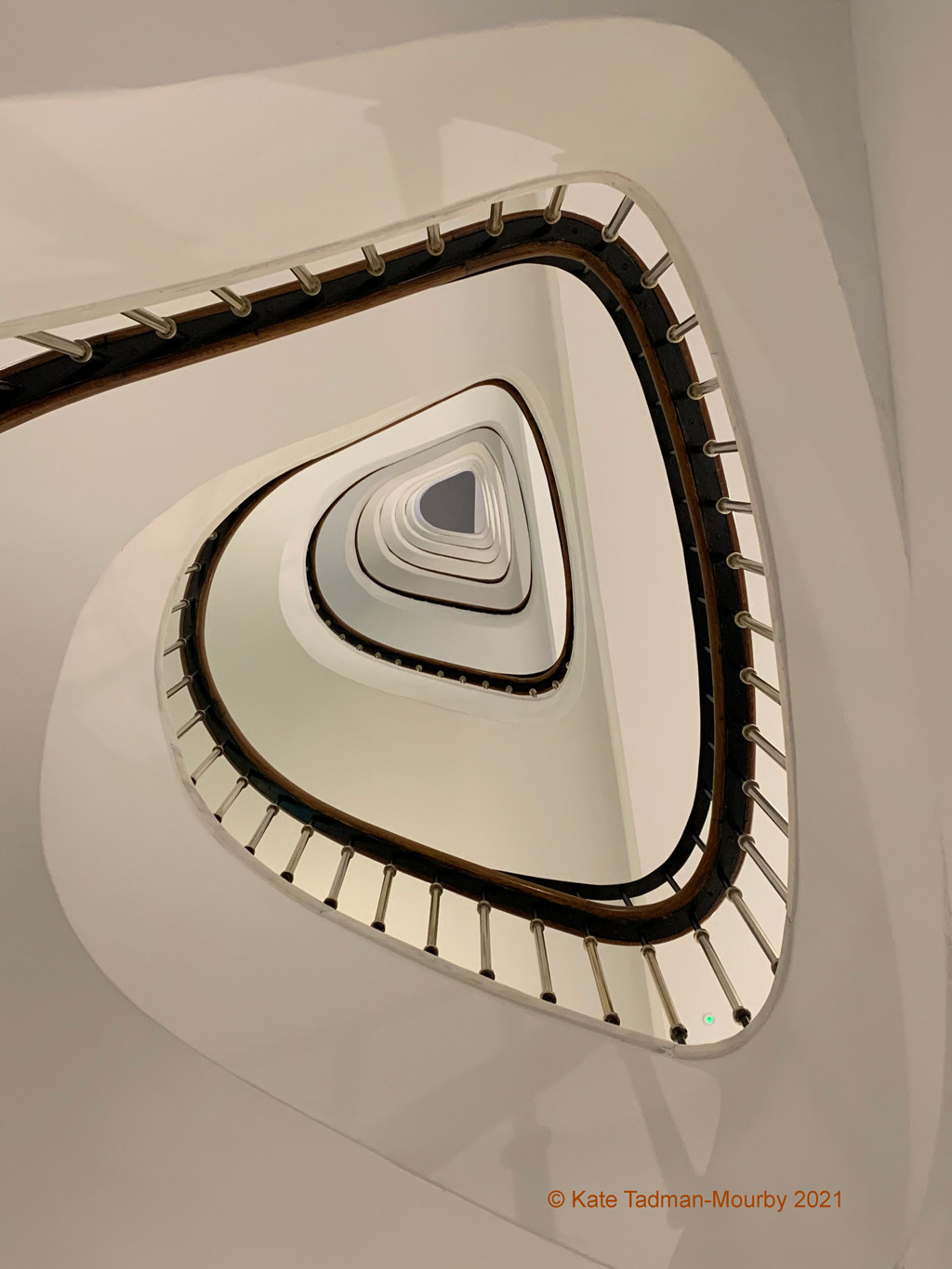 Photograph: (c) Kate Tadman-Mourby 2021
Photograph: (c) Kate Tadman-Mourby 2021
PATRICIA HIGHSMITH AND THE STRANGE CASE OF
THE DISAPPEARING KINGS PALACE HOTEL OF ATHENS
Patricia Highsmith was one of the best crime writers of the twentieth century. Her tales of Thomas Ripley have been made into several films including – most notably - The Talented Mr Ripley (1999) with Matt Damon as Ripley, and Ripley’s Game (2002) with John Malkovich in the same role). One of the most recent adaptations was an excellent Athenian tragedy called The Two Faces of January (2014) which starred Viggo Mortenson and Kirsten Dunst.
Highsmith’s 1964 book and Hossein Amini’s film both follow Chester and Colette McFarland (Mortenson and Dunst) as two Americans on the run after Chester absconds with his investors’ money. Arriving on a liner in Athens’ Piraeus port in the 1960s ,Chester hires a taxi driver who assumes that as wealthy Americans they will be staying at the Hotel Grande Bretagne in Syntagma Square.
Patricia Highsmith continues: “’Well … I’m not quite sure,’ Chester said. The Grande Bretagne was unquestionably the biggest and best hotel in Athens, but for that very reason, Chester felt wary about stopping there.” In the end the couple settle on The King’s Palace Hotel, which Highsmith described as “across a street at one side of the Grand Bretagne”.
As a regular hotel visitor, I had heard that this was indeed a real hotel in Athens during in the 1960s, with a beautiful spiral staircase, but as far as I could see no such building existed opposite the Grand Bretagne today in an avenue of shops and offices.
The King’s Palace plays a pivotal role in both film and book. It is here that Chester gets into a fight with the private detective tailing the couple and ends up accidentally killing him. Chester and Colette’s flight across Greece from the repercussions of this killing goes from bad to worse and proves fatal for them both in the end.
A little research on my part revealed that the King’s Palace Hotel was built in 1954 and would have taken its name from the palace of the King of Greece (now the Greek Parliament Building) which is only one block away.
“The lobby looked first-rate to Chester,” wrote Highsmith after having visited Athens, for the first time in December 1959. “Maybe not luxury class, but first-rate. The carpet was thick underfoot, and, judging from the warmth the central heating really worked… A few minutes later they were comfortably installed in a large, warm room with a view of the white-geranium-garnished balconies of the Grande Bretagne and a busy avenue six storeys down, which Chester identified on his map of Athens as Venizelos Street.”
But things go badly wrong at the King’s Palace Hotel and, having failed to adequately hide the dead detective’s body Chester and Colette have to flee Athens overnight.
The opening of the film Two Faces of January was shot in Athens at the Acropolis and in Monastiraki in September 2012, but the production relocated sooner than intended to Turkey. Rioting in the Athens kept interfering with the sound recordist’s work. So the interior of Highsmith’s King’s Palace Hotel was created in an old Istanbul hospital which was decorated to resemble Chester’s “first rate lobby”. Ironically the production designer, Carol Spier ended up making it look like the Grand Bretagne opposite.
In 2020 however I heard news of an M Gallery Hotel that had opened on the site of the old King’s Palace. This venture was the latest by the Lampsa SA group who own the Grand Bretagne. The new hotel had opened in September 2020 but unfortunately had to close again almost immediately, in November 2020, because of a rise in Greek Covid cases. (The last 18 months have not been kind to hotels worldwide.) In May 2021 however the Athens Capital Hotel - M Gallery Collection opened again and recently I was back in Greece and able to arrange to visit.
The façade is new, dating from Lampsa’s major refurb of 2018 and there is no longer a thick carpet or visible central heating in the lobby. Once inside I was shown the old staircase which has been preserved. It is indeed spiral but elliptically so. Looking up as it swirls to the top of the hotel’s original eight floors is like is like gazing at a work of abstract art.
I was shown round by Demi Roussou, the PA to general manager, Euripedes Tzikas. Demi was very proud of the new M Gallery’s commitment both to original art and to being a hotel at which single female travellers in particular can feel at home. She explained something of the history of the building since its building in 1954. In 1974 when the Greek king, Constantine II was deposed following a decisive referendum the Panhellenic Socialist Movement (PASOK) was formed here under eventual Prime Minister Andreas Papandreou. Today there is a plaque near the elliptical staircase commemorating that event on 3 September 1974. Later PASOK converted the hotel into the headquarters of the country’s Bank of Agriculture. The connection with PASOK is also commemorated by the fact that today, if the hotel’s three meeting rooms are combined, they create one big meeting room that bears the name 3 September 1974.
Elsewhere the new hotel honours four Greek artists in its four executive suites. Two on the seventh floor are named after singer Maria Callas and Manos Hatzidakis, the composer of (amongst many other works) the song “Never on a Sunday”. The suites on the eighth floor are named after the Nobel prize-winning poet Odysseus Elytis and Melina Mercouri, the actor and Greek Culture Minister who in 1960 won a Cannes Film Festival Best Actress Award for her role in the film Never on a Sunday.
All 159 bedrooms and 18 suites are white and modern, but comfortably so. The whole design is by hotel architect, Maria Viafadis whose other projects have included the Kempinski Budapest and Hotel Schweizerhof, Bern. Each bedroom is decorated with an original oil painting by the abstract artist Sofia Petropoulou. In total the hotel commissioned 177 canvasses from her, one for each room. According to Demi they were designed so that they could also be pieced together to create one giant work of art.
The hotel has a glorious new rooftop restaurant called Mappemonde with great views over Athens with Mount Lycabettus to the north and the Acropolis to the west --and of course of the Grand Bretagne just in front (no longer with the white geranium window boxes that Chester viewed that fateful night). You can even see the Greek island of Aegina out in the Saronic Sea.
The Athens Capital Hotel – MGallery Collection may occupy the same building as the King’s Palace Hotel but it is a world away from the under the radar bolt-hole at which Chester and Colette McFarland hid away in 1964 with such tragic consequences.
Adrian Mourby
Feuilleton 391: THE WALDORF CAMPAIGN, Hotels lost in History
( words)
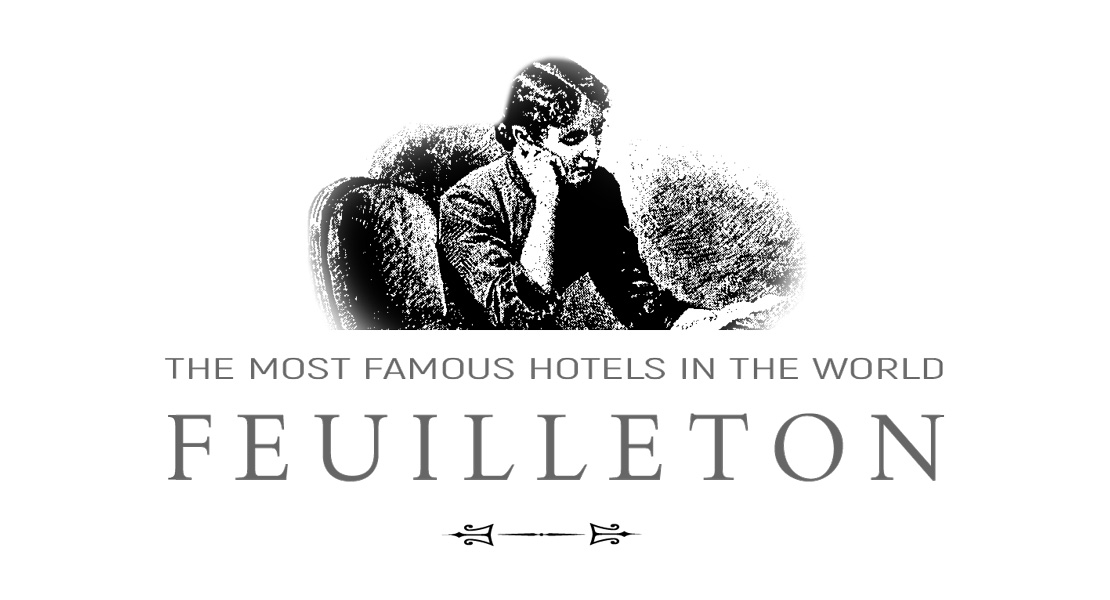 Dear Friends of The Most Famous Hotels in the World,
Dear Friends of The Most Famous Hotels in the World,
2 things this time:
1. the November jury meeting will again present several new candidates from all over the world to be included into the list of The Most Famous Hotels in the World®. Here's the complete list of all Select Member Hotels
Should you know a historic hotel missing from our list, please submit your candidate in a personal mail to me here.
 We run this column out of a sense of duty, but like, no, we don't like it!
We run this column out of a sense of duty, but like, no, we don't like it!
Equally fascinating is the listing of famous grand HOTELS LOST IN HISTORY:
/ and now 2.
The Waldorf Astoria New York is a member of The Most Famous Hotels in the World since the very first hour of our organisation (1986). This fall, facing its 90th anniversary in its new location on Park Avenue, the Waldorfers ask us to submit our very personal Waldorf story.
Please share your story with them for a chance to win a two-night stay at the newly restored Waldorf Astoria New York hotel upon its reopening in 2023. To upload your story, recount your fondest Waldorf memories below and submit photos, videos, scanned documents, and/or recordings.
Well -- here is our part:
.png)
New York — The first Waldorf Astoria in 1899:
SHARE YOUR OWN WALDORF STORY
Waldorf Astoria New York is currently undergoing an unprecedented restoration from sidewalk to spire. 375 opulent guest rooms and suites will be joined by condominium residences for the first time." #WaldorfStories --- here is the link https://www.waldorfstories.com/submit
More about the Waldorf Astoria on famoushotels.org
Yours - as always
Andreas Augustin
The Modest Mr Ritz or: Taking over the Frankfurter Hof
( words)
An excerpt from our book
FRANKFURTER HOF
THIS HERR RITZ
‘Please forgive me for telling you my honest opinion, gentlemen.’
‘Of course!’
César Ritz looked into the eyes of the directors who sat opposite him. He saw the men whose hotel he was going to rent, saw the interest. He recognised that kind of look. It was curiosity. Ritz was considered an expert. He was attuned to difficult situations. What people usually expected from him at that point was to pull a rabbit out of the hat.
‘You certainly have the most delightful restaurant,’ he paused; ‘... north of the Alps. This hall, the 32 columns – congratulations, indeed! And this winter garden is just wonderful.’
Sonnemann nodded his head. Oh, so this was a honey-dripper. That much he knew himself.
‘Unfortunately it looks like a morgue.’
‘I beg your pardon, Sir?’
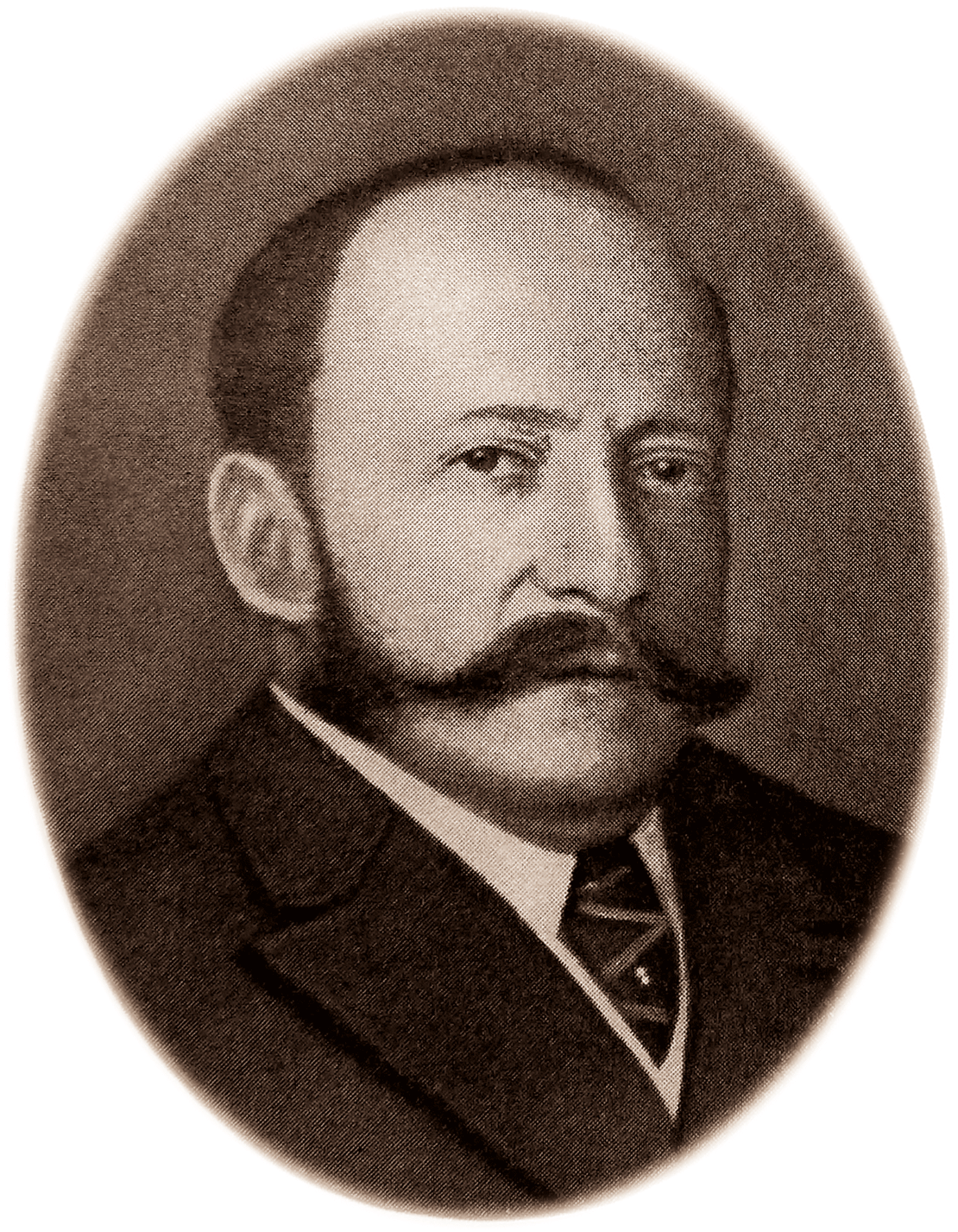 César Ritz
César Ritz
Sonnemann and Ladenburg must have judged him wrongly. The small man didn’t speak too clearly with his heavy Swiss accent. He didn’t speak German very well either.
‘I can see that in London now. La même chose, the same story, you understand? The ladies love to go out; they love to show off their dresses. They want to be seen. It’s a new era. The restaurant needs to be near the street. With large windows!’
‘Ladies?’
‘In the restaurant?’
‘In public?’
Sonnemann thought that the man was joking.
‘And these rooms! Only a handful of bathtubs! This needs to be changed. Everything is very elegant here, but we are not living in 1870 any longer,’ continued Ritz, shaking his head.
César Ritz was not overly friendly with the directors of the Frankfurter Hof. But he was right. In 1892 the hotel was more than 15 years old. It required investment. Electric power and speaking tubes were not enough. Guests wanted luxury.
‘At the Savoy each suite is equipped with a bathroom. One year ago I opened up the Grand Hotel in Rome. There is electric lighting everywhere. And each room, EACH ROOM has its own bath.’
‘But isn’t this a bit excessive?’
‘No, not at all! The next Grand Hotel that might open up around the corner (he casually pointed his right hand into that direction) will have it. And then, you will be only the number two – if at all!’
‘Well then…’
‘And, by the way – your electric light.’
‘Yesss?’
‘Absolutely impossible.’
--------
On March 1, 1895 the Frankfurter Hof was leased to a consortium consisting of César Ritz, Otto Kah from Baden-Baden and the brothers Otto and Ferdinand Hillengass. The Hotel Aktiengesellschaft corporation demanded an adequate rent and hoped to at least make a good return on it. The big-mouthed Swiss must now show what he was able to do.
Ritz did not disappoint them.
-----
From our book Frankfurter Hof - available here
Trafalgar - beating heart of England
( words)
By Adrian Mourby
When World War II ended, thousands of people crammed into this world-famous piazza below the National Gallery and danced round its fountains. During the 1980s the square was the focus for Britain’s anti-apartheid rallies, in November 2015 it was here that young people gathered to sing La Marseillaise to support the victims of the Paris terrorist attacks and every New Year Londoners jump into Trafalgar's fountains at the strike of midnight.
It has always seemed odd to me that, despite its pole position in the national psyche, Trafalgar Square is almost entirely devoid of hotels. Maybe I assign too much importance to hotels but I believe they are the crowning glory of any city piazza.
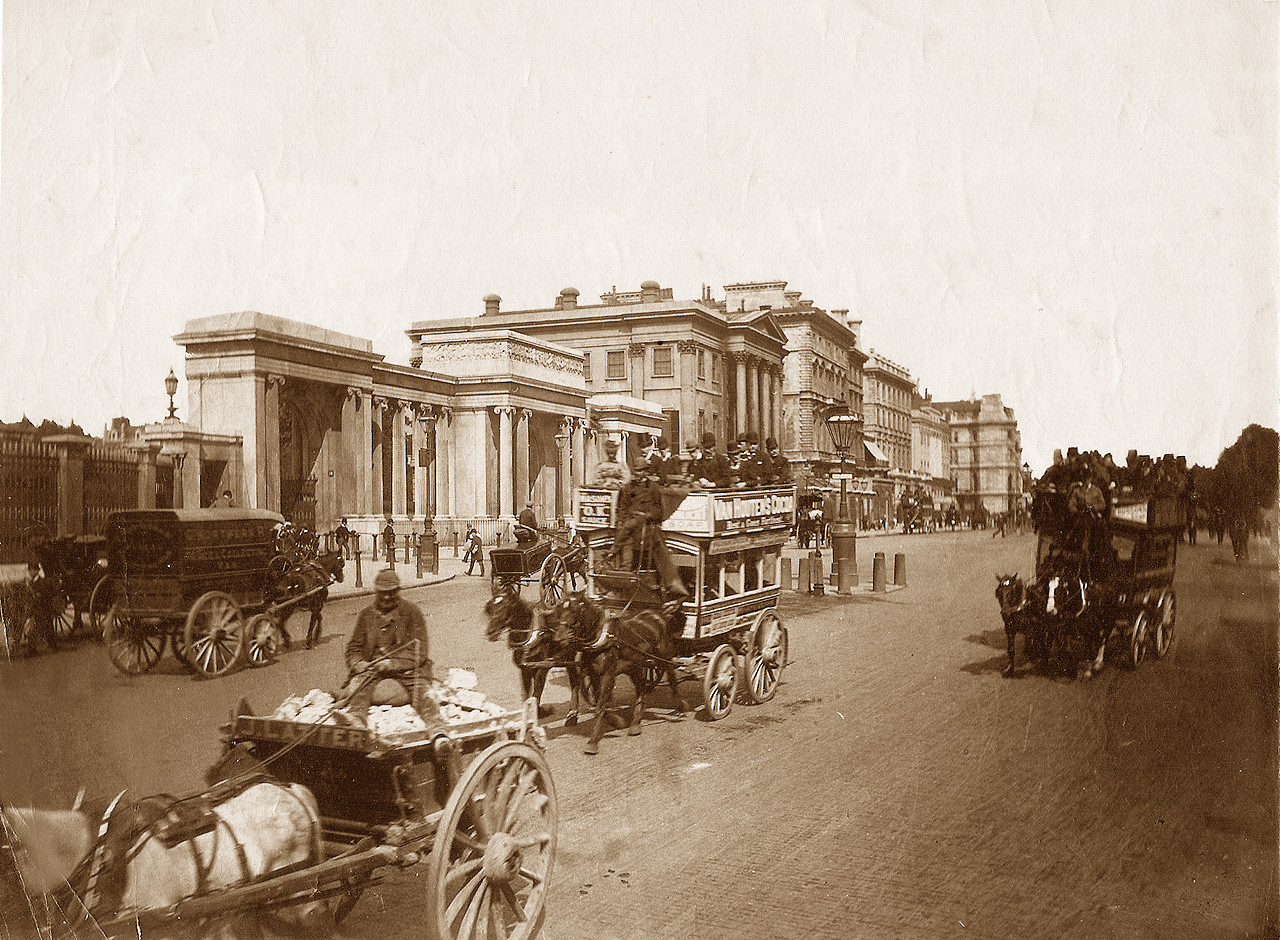
London’s most famous square (actually it's more of a rectangle with rounded corners) was built in the 1820s, laid out to plans by King George IV’s favourite architect, John Nash. The site chosen was a small hilly slope north of the Palace of Whitehall. The first buildings constructed to Nash’s masterplan here were the Royal College of Physicians and the Union Club (now combined into the diplomatic mission known as Canada House). They were built between 1824 and 1827. Next was the long, low National Gallery, which was begun in 1832 between what is now Canada House and the famous church of St Martin in the Fields. This gracious Georgian parish church featured in Dickens’ novel David Copperfield and in E.M.Forster’s A Room with a View. It is the only building on Nash’s square to predate his nineteenth-century redevelopment.
Morley’s was the first hotel on Trafalgar Square. It opened in 1832
Moving clockwise round the square from St Martin’s there lies South Africa House which was built in 1936 to mirror Canada House opposite. It actually occupies the site of Morley’s Hotel which was demolished to make room for South Africa House. Morley’s was the first hotel on Trafalgar Square. It opened in 1832 and was a Regency style structure designed by the architect George Ledwell Taylor for the developer Atkinson Morley. Mr Taylor has a remarkable footnote in London’s history. When a grand square on this site was nearing completion in the 1830s the intention was to name it after King William IV (reigned 1830-37) who had succeeded his brother George. However Taylor interceded with the king to name it after Lord Nelson’s famous victory against the French Navy in 1805. Taylor had been Surveyor of Buildings to the Naval Department and well knew William IV who had held the position of Vice Admiral before becoming king. William agreed and accepted having one of the eight feeder roads leading into the square named after him instead.
Morley’s was not originally built as a hotel. Initially Taylor designed the block as series of apartments of the kind occupied by Sherlock Holmes and Dr Watson in fictional Baker Street. This apartment block opened in 1831 but within a year later Morley had reopened it more profitably as a hotel. Sir Arthur Conan Doyle, creator of Sherlock Holmes stayed there in 1900 while he was writing The Hound of the Baskervilles, and it is thought that the fictional Northumberland Hotel in that novel may well have been based on Morley's. Certainly Northumberland Avenue – another feeder road - is just round the corner. However Conan Doyle was not a fan, writing to his mother that he was "somewhat sick" of Morley's hotel and intended to move on.
Northumberland Avenue takes its name from where the powerful Dukes of Northumberland once lived in their Jacobean palace on the Strand.
Northumberland House was demolished in 1874 to make space for a wide avenue of mixed-use Victorian development that today showcases two massive hotels built by Frederick Gordon, the self-proclaimed “Napoleon of the Hotel World”. Gordon had started off as a London restaurateur then opened a number of hotels across England, many of them called The Metropole, a fashionable hotel name in the late nineteenth century. Gordon’s London Metropole on Northumberland Avenue opened in 1885 and since 2011 has been known as the Corinthia London. Next to it across Great Scotland Yard stands Gordon’s even larger Grand Hotel (1890) which contains 300 rooms and is now divided up into the Club Quarters (for business travellers) and a more boutique operation for tourists, but neither hotel actually faces on to Trafalgar Square as Morley’s once did.
However after crossing Whitehall - the main route of government – crossing Pall Mall, which leads to Buckingham Palace one comes to the Trafalgar Hotel St James (51.50755957740019, -0.12912150859534846) which is the only hotel actually on the square itself.
The Trafalgar Hotel stands opposite Canada House where Cockspur Street that feeds into the square. This is one of the few sections of Trafalgar Square to have kept its original Tudor street layout that preceded Nash’s comprehensive nineteenth-century redevelopment.
In the fifteenth century a tenement leased by King Henry VIII (reigned 1509 – 1547) to one Thomas Swallow stood here. The royal stables were located nearby so any housing in this part of Westminster was hardly salubrious. By 1605, in the reign of King James I, there were eight messuages (humble dwellings each with a small patch of arable land) on the site of what would one day become the Trafalgar Hotel. In 1709 they were demolished to make way for the Red Lion Inn which in turn was also demolished to make space for the British Hotel. This was a second Trafalgar Square venture by Atkinson Morley. It was built in the 1860s and stood on Trafalgar Square until demolished to make way in 1886 for shops and offices.
So from 1936 with the demolition of Morley’s Hotel there was no hotel on Trafalgar Square.
By the beginning of the twentieth century a lot of important travel companies had opened offices on the Cockspur Street side of Trafalgar Square. There was Stanfords, the premiere mapmakers to the British Empire. There was the Great Northern Railway of America Company, which stood at 21 Cockspur Street, the Hamburg-America Line at No. 22, Canadian Pacific Railways at No. 30 and North German Lloyd Ocean Mail Steamers at 32 Cockspur Street. Why were so many travel companies located on this side of Trafalgar Square? I can only speculate that it was to do with the presence, nearby of Charing Cross Station which was where European passengers arriving from Calais via the Dover ferry dismebarked in London.
So from 1936 with the demolition of Morley’s Hotel there was no hotel on Trafalgar Square. However in 1998 planning permission was applied for by the L&R Company who wished to retain the facades of Nos 25 to 34 Cockspur Street but to demolish their interiors to build a new hotel, the first in decades that would look directly on to Trafalgar Square.
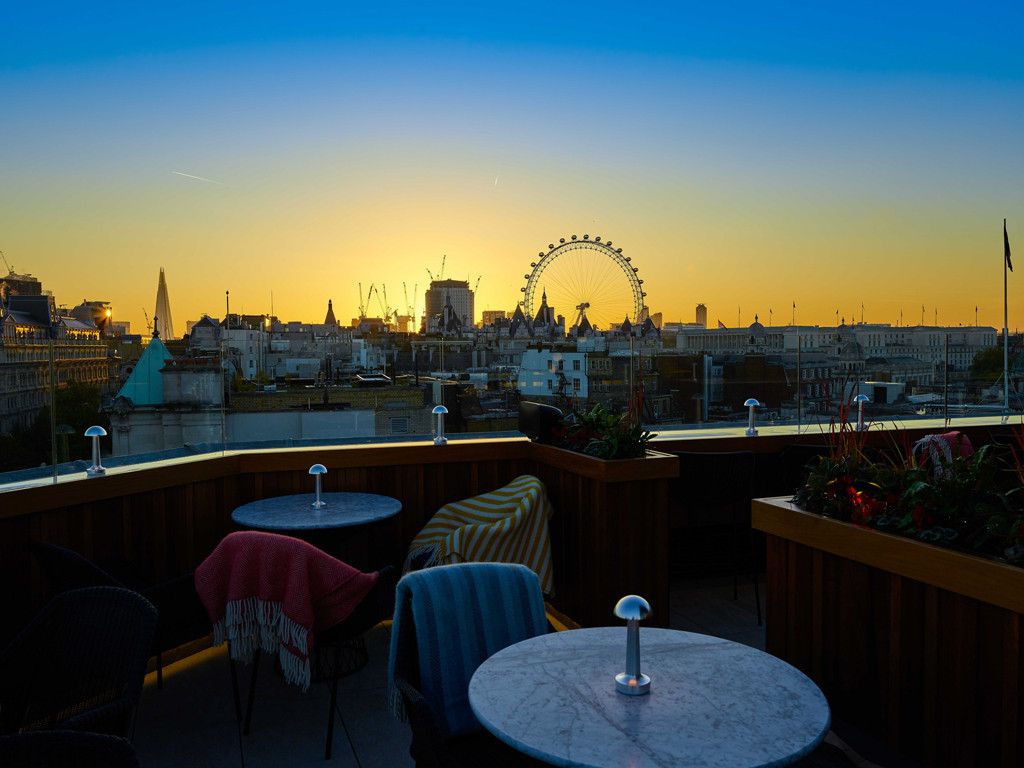 Vista from Vista
Vista from Vista
This new building opened in 2006 with 130 modern rooms cleverly tucked behind the Edwardian façades of all those offices. It was also designed to have a rooftop bar, known as the Vista and a ground floor dining room known as Rockwells. In 2017 L&R completely refurbished their hotel, creating a new lobby and enclosing most of the rooftop Vista Bar. Although hugely popular since its opening because of its panoramic views, the Vista was wholly at the mercy of London rainfall, even in summer.
Today known as The Trafalgar St James and managed by Matthew Beard, the hotel retains its unique selling point of being the only place to stay on the square itself. Victoria and David Beckham came to stay when she was opening the Harrod's Christmas Sale. The Rolling Stones visited and spent time on the rooftop Vista Bar and photos of them are in many of the hotel’s bedrooms today. In 2014 the film Edge of Tomorrow featured Tom Cruise’s character landing a helicopter in Trafalgar Square - the first and only time such a stunt has happened in a movie – and this was shot from the Vista Bar.
Trafalgar Square’s one hotel makes the most of its unique position. On a warm summer evening when the Vista is crowded it’s unlikely that many drinkers are aware they’re standing above where King Henry VIII once stabled his horses. But Londoners take history in their stride. The past is down there somewhere but tonight most people just want to party.
TRAILER - GRAND HOTEL METROPOLE - 2021
( words)
CALENDAR HOTELS
( words)
Above: Britannia Grand Hotel in Scarborough,
HAVEN’T HEARD THAT EXPRESSION BEFORE? A calendar building always plays with calendar related numbers: 2 for day and night, 4 for the seasons, 7 for days, 12 for months, 52 rooms e.g. per floor for weeks and – you guessed it right – 365 rooms, or windows.
A living example is the Britannia Grand Hotel in Scarborough, a very popular seaside resort at the north-eastern coast of England. It is situated in the city centre overlooking the town's harbour and South Bay.
Built in 1863 it joins the league of Europe’s first purpose-built hotels. Its superb architecture holds a few surprises: the four towers represent the seasons, the 12 floors stand for the months, the 52 chimneys symbolize the weeks and the originally 365 bedrooms exemplify the days of the year.
Today the hotel has reduced its number of rooms to 280, but not lost its popularity among the Britons who enjoy the romance. In 2006 Britannia made a £7 million refurbishment to the existing Hotel. In 2017 the listed hotel was awarded and named by Historic Britain as one of the top ten places, buildings and historical sites that tell the remarkable story of England and its impact on the world.
The Gentleman in the Parlour
( words)
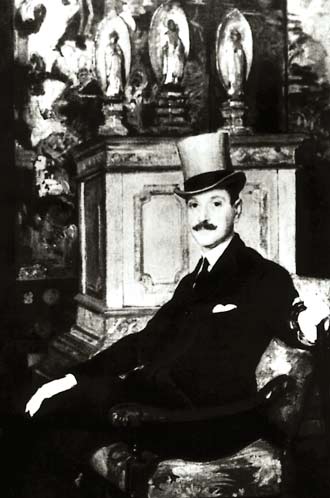
For the French in Tonkin, Hanoi was the most attractive town of Indochina. For British playwright and author Somerset Maugham it was obviously less exciting.
In 1923, he stayed at the Grand Hotel Metropole (today Sofitel Legend Metropole) while working on "The Gentleman in the Parlour": 'Here I had the intention of finishing this book, for at Hanoi I found nothing much to interest me. It is the capital of Tonkin and the French tell you it is the most attractive town in the East, but when you ask them why, answer that it is exactly like a town, Montpellier or Grenoble, in France.'
Today, the Hotel Metropole has dedicated one of its suites to the British author (and there is also a Graham Greene Suite, and a Charlie Chaplin Suite, ... but these are different stories.).
From our book METROPOLE HANOI by Andreas Augustin
The nit-picker, a bean counter
( words)
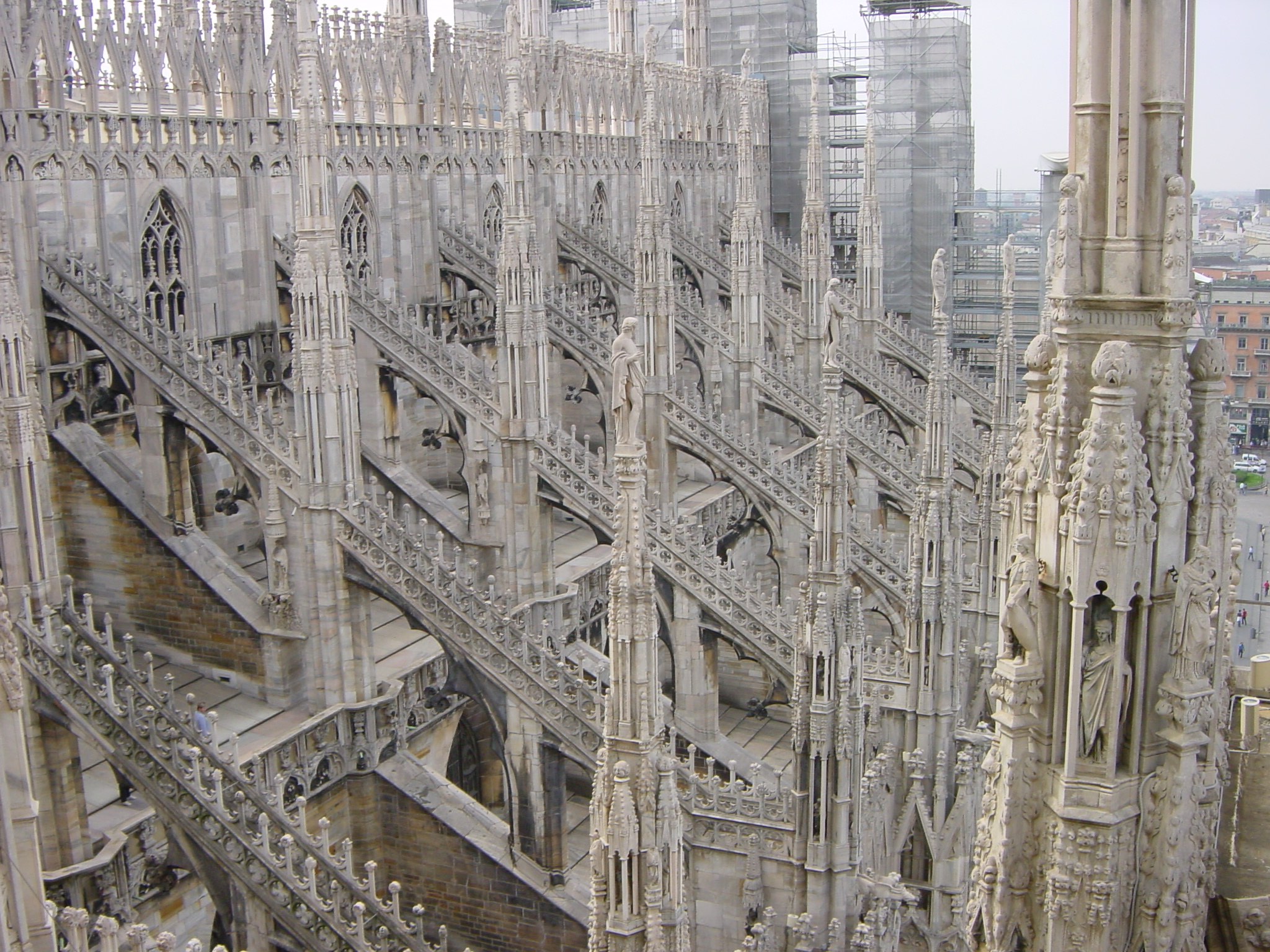
The roof of the Dome in Milan -- a fascinating world of arches, pillars and statues. You can climb it easily via the staircase.
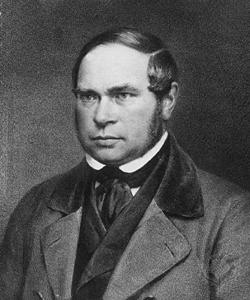
Carl Baedeker, the „Erbsenzähler“, was the first professional German travel guide author. His descriptions were so accurate that he earned himself the nickname „Erbsenzähler“ (nit-picker / bean counter)
Observed by a contemporary while climbing the Milan Cathedral in 1847, he observed Baedeker putting a dry beans from his waistcoat into his trouser pocket every 20 steps. Multiplied by 20, the number of beans plus the remaining steps resulted in the precise steps specification for the later travel guide. During the descent, he then did the cross-check.
The result was, by the way, 158.
Say Good Bye to starred Hotel Restaurants
( words)
Hotels (again) are saying goodbye to posh restaurants
Is this ringing in the era of fun and entertainment, and finally nobody cares about stars?
50 years ago a hotel restaurant in Europe was basically there to be avoided. Even the hotel's concierge had a list as long as his arm of restaurants outside he would recommend (and get commission from!)
In Asia hotel restaurants were the only place to get decent western food. The Indian Restaurant at the Mena House in Cairo was for long the best of its kind outside of India. The Pump Room at Chicago's Ambassador East Hotel was so famous that you could hardly get a table if you weren't Frank Sinatra.
Now, the tide shifts. Again.
Alain Ducasse leaves the Hotel Plaza Athénée in Paris after 21 years of a lately less successful performance. It is a question of time how long Alain Ducasse will continue to work for the other two hotels belonging to the hotel group, Meurice in Paris and Dorchester in London. Or rather: how long will an owner maintain their vanity of employing a 3-star chef when the zeitgeist points in a completely different direction?
Spurred by the recent crisis the cost-intensive luxury 2-3-starred hotel restaurants will become a thing of the past.
The hotels are saying goodbye to the great gastronomy, a trend that began a decade ago. The completely renovated Parisian Hotel Lutetia opened only one brasserie for its guests. In Vienna the restaurant Korso at the famous Hotel Bristol has renounced the services of the ingenious kitchen of Reinhard Gerer. The restaurant Majesty at the Hotel Imperial has made way for conference rooms.
In Paris, top chef Stephanie Le Quellec from Hotel Prince de Galles was released after receiving her second star.
Chef Christopher Hache from Crillon was also put in front of the door.
In 2020, the Shangri La Paris closed its two-star restaurant L’Abeille.
The Peninsula of Hong Kong and Gaddie's tradition refused to participate in the race for the stars in Paris from its very beginning. The luxury restaurant Le V of the Hotel Georges V has been closed and the Italian chef of the house, now cooks on the terrace. The Raffles Royal Monceau opened with an Italian and the internationally active Asian Nobu.
May be Alain Ducasse and consorts are well advised to consider themselves trendsetters again, leave hotel environments and start a new thing. We are watching and waiting. No risk, no fun. Chef/restaurateur Jose Andres is offering a US$50 gift certificate to anyone showing proof of vaccination in his Washington, D.C., restaurants. What about this incentive for a start?
The Driskill - Austin’s oldest operating hotel
( words)
Driskill Hotel
The Driskill, a Romanesque-style building completed in 1886, is the oldest operating hotel in Austin, Texas, and one of the best-known hotels in Texas. The Driskill was conceived and built by Col. Jesse Driskill, a cattleman who spent his fortune constructing “the finest hotel south of St. Louis”. After all he was flush with cash from his service to the Confederate Army to which he supplied beef throughout the Civil War.
In 1884, Jesse Driskill purchased land in downtown Austin for $7500 and announced plans for a new hotel. Today, the Driskill remains one of the premier hotels in Austin, featuring lavish bridal suites, two restaurants, and a grand ballroom.
Cattle baron Jesse Driskill opened the hotel in 1886 in what was then a frontier town. He lost it two years later when his fortune went kaput after his herd died during a severe drought and a freeze.
The Driskill is composed of two interconnected buildings; the original four-story Romanesque Revival building constructed in 1886, and a 13-story annex constructed in 1930.
The original building, designed by local Austin architect Jasper N. Preston, was constructed with over six million pressed bricks and white limestone accents. The building contains two porticos on the southern and eastern facades, which contain large Richardsonian-style arches that were reputed to be the largest in Texas. The façade contains three limestone busts of Driskill and his sons; J.W. “Bud” Driskill facing Brazos Street, A. W. “Tobe” Driskill facing an alley on the west side, and Jesse Driskill facing Sixth Street, whose bust is surrounded by decorative carvings including longhorns on the gable ends.
The hotel opened with 60 rooms including 12 corner rooms with attached baths, a rare feature in hotels of the region at the time. At the center of the hotel was a four-story open rotunda capped by a domed skylight, which functioned as a flue to suck up the hot air and cool the building; the skylight was removed when air conditioning was installed on the roof in 1950. The building was designed for separate entrances for men and women. Two entrances, one on Sixth Street and another facing the alleyway on the west side the building, were reserved for men and were flanked by a saloon, billiard room cigar shop, a newsstand and a barbershop featuring baths. The women’s entrance on Brazos Street allowed female guests to proceed directly to their rooms, thereby avoiding the cigar smoke and rough talk of the cattlemen in the lobby. The second floor contained the main dining room and ballroom, separate parlors for men and women, a children’s dining room, and bridal suites. Other embellishments included an electric bell system, marble bureaus, steam heating, and gas lighting.
The 13-story annex, designed by the El Paso architecture firm Trost & Trost, opened in 1930. The 180-room annex contains a bungalow penthouse that is only accessible from the building’s roof. The bungalow contains two bedrooms with private baths, a living room, and a full kitchen. The bungalow was originally used as a private residence by superintendents of the Southern Pacific Railroad, but was later rented to high-profile guests including Jack Dempsey, Bob Hope, and President Lyndon Johnson. In 1979, the hotel manager restored the bungalow to use as his private residence.
The hotel held a grand opening on December 20, 1886, and was featured in a special edition of the Austin Daily Statesman. On January 1, 1887, Governor Sul Ross held his inaugural ball in its ballroom, beginning a tradition for every Texas governor since. In May 1887, less than a year after it opened, Driskill was forced to close the hotel, as he could no longer afford to operate the hotel following a harsh winter and drought that killed his cattle inventory. In addition, S.E. McIlhenny, the hotel’s general manager, and half of the staff were hired by the Beach Hotel in Galveston, which expedited the closure. Driskill sold the hotel in 1888 to his brother-in-law, Jim “Doc” Day, who reopened the hotel late in 1888.
Austin magnate George Littlefield, responsible for other Austin landmark’s opened the Austin National Bank on the southeast corner of the building; the old bank vault still remains. Littlefield later purchased the hotel for $106,000 in 1895 and vowed that it would never close again. Littlefield invested over $60,000 in renovations, including ceiling frescoes, electric lighting, steam heating, and 28 additional lavatories, but still sold the hotel at a loss of $25,000 in 1903 to banking competitor, Wilmot. Wilmot added a barbershop and women’s spa featuring Turkish baths, oversaw the construction of the annex, and adorned the former smoking room with eight antique Austrian gold leaf-framed mirrors previously owned by Maximilian and Carlota of Mexico.
In 1950, the hotel embarked on a renovation, which closed off the Sixth Street entrance and removed the rotunda’s skylight to make way for air conditioning units on the roof. In 1952, the former Austin National Bank was transformed into a television studio for KTBC, the very first television station in Central Texas.
In 1969, the Driskill closed its guest rooms in anticipation of a renovation and new tower containing a modern glass façade, which never materialized. Most of its furnishings were sold, and an American-Statesman article declared, “Driskill Hotel’s Fate ‘Sealed’.” The hotel was saved from the wrecking ball at almost the last minute, however, when a nonprofit organization called the Driskill Hotel Corporation raised $900,000.
In 1908, the Daughters of the Republic of Texas met at the Driskill hotel to discuss the fate of the Alamo Mission in San Antonio. At the meeting, a divide between two factions of the group erupted over whether to demolish or preserve the structure.
Braniff International Hotels, Inc., a division of Braniff Airways, Inc., of Dallas, Texas, bought the hotel in 1972 and began a $350,000 restoration of the grand lobby of the historic facility. Braniff reopened the hotel to customers on January 15, 1973, to very strong bookings and conference business. Braniff threw an official grand reopening celebration on February 10, 1973. Over 1000 guests attended the gala event that included a parade of every Texas Governor and/or their descendants, since 1886. All proceeds from the event went to the Austin Heritage Society, who was strategically instrumental in the resurrection of the Hotel Driskill.
In 1995, The Driskill was purchased by Great American Life Insurance, who embarked on a $30 million renovation to restore the hotel to its original appearance, which had been heavily modified over the years. The hotel closed for four years for renovation work and was re-opened in a Millennium celebration on December 31, 1999.
In 2013, The Driskill was purchased by Hyatt Hotels Corporation for $85 million, who embarked on an $8 million renovation of the hotel which was listed in the National Register of Historic Places on November 25, 1969.
Theresa - the Waldorf Astoria of Harlem
( words)
The Hotel Theresa opened in 1913 on 125th Street and Seventh Avenue in Harlem and closed its doors as a hotel in 1970.
Hotel Theresa, “The Waldorf of Harlem”
By Stan Turkel
On September 18, 1960, four months before the United States severed diplomatic relations with Cuba, Fidel Castro arrived in New York City for the 15th session of the United Nations General Assembly. He and his staff first checked into the Shelburne Hotel at Lexington Avenue and 37th Street. When the Shelburne demanded $10,000 for alleged damage that included cooking chickens in their rooms, the Castro entourage moved to the Hotel Theresa in Harlem. Castro’s group rented eighty rooms for a total of $800 per day. The Theresa was the beneficiary of worldwide publicity when Nikita Khrushchev, the premier of the Soviet Union, General Abdul Nasser, president of Egypt, Jawaharlal Nehru, the prime minister of India, and Malcom X, all visited Castro there.
In the longest speech ever delivered at the United Nations, Castro transitioned seamlessly from his hotel experience to the discrimination faced by North American blacks to the broader evils of “imperialist financial capital” and the “colonial yoke”.
At the end of 1960, presidential candidate John F. Kennedy made a campaign stop at the Hotel Theresa with Jacqueline Kennedy, Congressman Adam Clayton Powell Jr., Senator Herbert Lehman, Governor Averill Harriman, Mayor Robert Wagner and Eleanor Roosevelt. “I am delighted to come and visit,” said Kennedy. “Behind the fact of Castro coming to this hotel, Khrushchev coming to visit Castro, there is another great traveler in the world, and that is the travel of a world revolution, a world in turmoil. I am delighted to come to Harlem and I think the whole world should come here and the whole world should recognize that we all live right next to each other, whether here in Harlem or on the other side of globe.”
The Hotel Theresa opened in 1913 on 125th Street and Seventh Avenue in Harlem and closed its doors as a hotel in 1970. It was built by German-born stockbroker Gustavus Sidenberg and named for his recently- deceased wife. Coincidentally, Sidenberg’s second wife was also named Theresa. Architects George and Edward Blum were trained at the famous Ecole des Beaux-Arts in Paris and they designed a full- blockfront all-white apartment hotel, 13 stories high with 300 guestrooms. Like its façade, the newly- opened Hotel Theresa had an all-white clientele and staff for its first twenty-eight years. In 1940, reflecting the changing population of Harlem, the hotel was acquired by Love B. Woods, an African American businessman who accepted all races, hired a black staff and management. The Hotel Theresa was integrated when most mid-Manhattan hotels wouldn’t accept Blacks. They could perform at the clubs, hotels and theaters in mid-Manhattan but couldn’t sleep in the hotel rooms or eat in their restaurants. Black America’s most famous stars: Josephine Baker, Ray Charles, Jimi Hendrix, Louis Armstrong, Dorothy Dandridge, Duke Ellington, Nat King Cole, Lena Horne and Count Basie had to go to Harlem for a night’s sleep. For many blacks the existence of the Hotel Theresa’s luxurious rooms, bars and swank shops was regarded as a sign that they had finally arrived, at least in Harlem. The hotel became known as the “Waldorf of Harlem.”
Seventh Avenue and 125th Street was called the Great Black Way. The neighborhood contained the Salem Methodist Church; the studio of James Van Der Zee, Harlem’s most famous photographer; the African Memorial National Bookstore; the mafia-owned Diamond Jewelry Store; the M. Smith Photo Studio; the Apollo Theater; Blumstein’s Department Store; Frank’s Restaurant; Harlem Opera House; Oscar Hammerstein’s Play House; Hartz and Seamon’s Music Hall; the Cotton Club; Mike’s Place; Savoy Ballroom; Nest Club; Smalls Paradise and The Club Baron.
In 1940, the following announcement appeared in the New York Age:
Harlem Hotel Seeks Negro Trade; Picks Manager: The Hotel Theresa at Seventh Avenue and 125th Street, which catered to white patronage for several years, has changed its policy as of March 20 and will cater to both races, under Negro management with a Negro staff, according to an announcement by Richard Thomas, publicity manager of the hotel. In carrying out its new policy for the accommodation of Negroes and whites, the Gresham Management Company, operators of the Theresa, appointed Walter Scott as the hotel’s manager. Extensive renovations and improvements of the service and facilities of the hotel have been undertaken. A staff of 80 persons has been employed.
The African American General Manager Walter Scott had been the business manager at the Harlem YMCA on 135th Street. A graduate of New York University and a World War I veteran, Scott had worked as a bellhop and waiter on the Hudson River Dayline boats. Early in April 1940, Scott and his wife Gertrude and their sixteen year-old daughter, Gladys moved into a six-room suite on the tenth floor.
In 1941, heavyweight champion Joe Louis attracted 10,000 fans when he stayed at the Hotel Theresa after a victory at the Polo Grounds. Soon thereafter, entrepreneur John H. Johnson was a guest at the Theresa when he started a new pocket-size magazine called Negro Digest and, in 1945, Ebony which was followed by Jet in 1951. After splitting with the Nation of Islam, Malcolm X rented offices at the hotel for his Organization of Afro-American Unity.
In 1948, when GM Walter Scott resigned because of illness, Gresham Management hired William Harmon Brown as resident manager. Brown graduated from Howard University where he had earned a National Youth Administration scholarship, funded by a New Deal program. President Bill Clinton’s commerce secretary Ron Brown, the manager’s son, grew up in the hotel. U.S. Congressman Charles Rangel (D. New York) once worked there as a desk clerk. Earlier in 2016 Congressman Rangel retired after serving in the U.S. Congress from 1971-2016.
In 1971, the hotel was converted to an office building with the name Theresa Towers and was declared a landmark in 1993 by New York’s Landmark Preservation Commission.

